Frequent persons on Italy's street signs
countries
1734 names / 45485 streets
Giuseppe Garibaldi
 1098
Giuseppe Maria Garibaldi was an Italian general, patriot, revolutionary and republican. He contributed to Italian unification (Risorgimento) and the creation of the Kingdom of Italy. He is considered...
1098
Giuseppe Maria Garibaldi was an Italian general, patriot, revolutionary and republican. He contributed to Italian unification (Risorgimento) and the creation of the Kingdom of Italy. He is considered...
Guglielmo Marconi
 1070
Guglielmo Giovanni Maria Marconi, 1st Marquis of Marconi was an Italian inventor and electrical engineer, known for his creation of a practical radio wave–based wireless telegraph system. This led to...
1070
Guglielmo Giovanni Maria Marconi, 1st Marquis of Marconi was an Italian inventor and electrical engineer, known for his creation of a practical radio wave–based wireless telegraph system. This led to...
Giacomo Matteotti
 867
Giacomo Matteotti was an Italian socialist politician. On 30 May 1924, he openly spoke in the Italian Parliament alleging the Italian fascists committed fraud in the 1924 Italian general election,...
867
Giacomo Matteotti was an Italian socialist politician. On 30 May 1924, he openly spoke in the Italian Parliament alleging the Italian fascists committed fraud in the 1924 Italian general election,...
Giuseppe Mazzini
 796
Giuseppe Mazzini was an Italian politician, journalist, and activist for the unification of Italy (Risorgimento) and spearhead of the Italian revolutionary movement. His efforts helped bring about...
796
Giuseppe Mazzini was an Italian politician, journalist, and activist for the unification of Italy (Risorgimento) and spearhead of the Italian revolutionary movement. His efforts helped bring about...
Dante Alighieri
 778
Dante Alighieri, most likely baptized Durante di Alighiero degli Alighieri and often referred to as Dante, was an Italian poet, writer, and philosopher. His Divine Comedy, originally called Comedìa...
778
Dante Alighieri, most likely baptized Durante di Alighiero degli Alighieri and often referred to as Dante, was an Italian poet, writer, and philosopher. His Divine Comedy, originally called Comedìa...
Camillo Benso, Count of Cavour
 616
Camillo Paolo Filippo Giulio Benso, Count of Cavour, Isolabella and Leri, generally known as the Count of Cavour or simply Cavour, was an Italian politician, businessman, economist and noble, and a...
616
Camillo Paolo Filippo Giulio Benso, Count of Cavour, Isolabella and Leri, generally known as the Count of Cavour or simply Cavour, was an Italian politician, businessman, economist and noble, and a...
Giuseppe Verdi
 583
Giuseppe Fortunino Francesco Verdi was an Italian composer best known for his operas. He was born near Busseto to a provincial family of moderate means, receiving a musical education with the help of...
583
Giuseppe Fortunino Francesco Verdi was an Italian composer best known for his operas. He was born near Busseto to a provincial family of moderate means, receiving a musical education with the help of...
Antonio Gramsci
 578
Antonio Francesco Gramsci was an Italian Marxist philosopher, linguist, journalist, writer, and politician. He wrote on philosophy, political theory, sociology, history, and linguistics. He was a...
578
Antonio Francesco Gramsci was an Italian Marxist philosopher, linguist, journalist, writer, and politician. He wrote on philosophy, political theory, sociology, history, and linguistics. He was a...
Aldo Moro
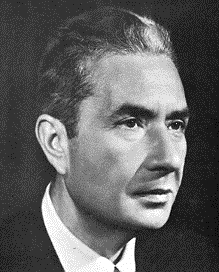 530
Aldo Romeo Luigi Moro was an Italian statesman and prominent member of Christian Democracy (DC) and its centre-left wing. He served as prime minister of Italy in five terms from December 1963 to June...
530
Aldo Romeo Luigi Moro was an Italian statesman and prominent member of Christian Democracy (DC) and its centre-left wing. He served as prime minister of Italy in five terms from December 1963 to June...
Cesare Battisti (politician)
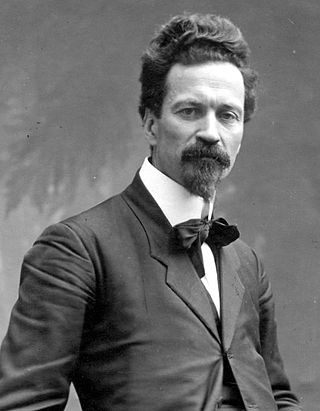 525
Cesare Battisti was an Italian patriot, geographer, socialist politician and journalist of Austrian citizenship, who became a prominent Irredentist at the start of World War I.
525
Cesare Battisti was an Italian patriot, geographer, socialist politician and journalist of Austrian citizenship, who became a prominent Irredentist at the start of World War I.
Pope John XXIII
 504
Pope John XXIII was head of the Catholic Church and sovereign of the Vatican City State from 28 October 1958 until his death in June 1963.
504
Pope John XXIII was head of the Catholic Church and sovereign of the Vatican City State from 28 October 1958 until his death in June 1963.
Alcide De Gasperi
 468
Alcide Amedeo Francesco De Gasperi was an Italian politician who founded the Christian Democracy party and served as prime minister of Italy in eight successive coalition governments from 1945 to...
468
Alcide Amedeo Francesco De Gasperi was an Italian politician who founded the Christian Democracy party and served as prime minister of Italy in eight successive coalition governments from 1945 to...
Alessandro Manzoni
 465
Alessandro Francesco Tommaso Antonio Manzoni was an Italian poet, novelist and philosopher. He is famous for the novel The Betrothed (1827), generally ranked among the masterpieces of world...
465
Alessandro Francesco Tommaso Antonio Manzoni was an Italian poet, novelist and philosopher. He is famous for the novel The Betrothed (1827), generally ranked among the masterpieces of world...
Victor Emmanuel II
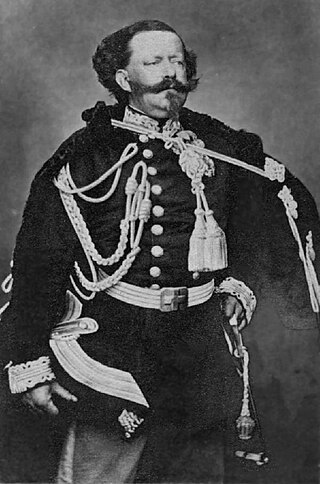 447
Victor Emmanuel II was King of Sardinia from 23 March 1849 until 17 March 1861, when he assumed the title of King of Italy and became the first king of an independent, united Italy since the 6th...
447
Victor Emmanuel II was King of Sardinia from 23 March 1849 until 17 March 1861, when he assumed the title of King of Italy and became the first king of an independent, united Italy since the 6th...
Umberto I of Italy
 426
Umberto I was King of Italy from 9 January 1878 until his assassination in 1900. His reign saw Italy's expansion into the Horn of Africa, as well as the creation of the Triple Alliance among Italy,...
426
Umberto I was King of Italy from 9 January 1878 until his assassination in 1900. His reign saw Italy's expansion into the Horn of Africa, as well as the creation of the Triple Alliance among Italy,...
Damiano Chiesa
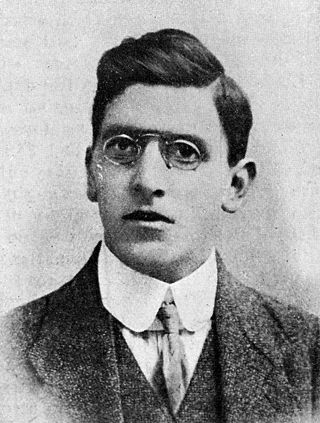 399
Damiano Chiesa è stato un militare e patriota italiano.
399
Damiano Chiesa è stato un militare e patriota italiano.
John Bosco
 391
John Melchior Bosco, SDB, popularly known as Don Bosco, was an Italian Catholic priest, educator and writer of the 19th century. While working in Turin, where the population suffered many of the ill...
391
John Melchior Bosco, SDB, popularly known as Don Bosco, was an Italian Catholic priest, educator and writer of the 19th century. While working in Turin, where the population suffered many of the ill...
Leonardo da Vinci
 377
Leonardo di ser Piero da Vinci was an Italian polymath of the High Renaissance who was active as a painter, draughtsman, engineer, scientist, theorist, sculptor, and architect. While his fame...
377
Leonardo di ser Piero da Vinci was an Italian polymath of the High Renaissance who was active as a painter, draughtsman, engineer, scientist, theorist, sculptor, and architect. While his fame...
Giosuè Carducci
 376
Giosuè Alessandro Giuseppe Carducci was an Italian poet, writer, literary critic and teacher. He was noticeably influential, and was regarded as the official national poet of modern Italy. In 1906,...
376
Giosuè Alessandro Giuseppe Carducci was an Italian poet, writer, literary critic and teacher. He was noticeably influential, and was regarded as the official national poet of modern Italy. In 1906,...
Alessandro Volta
 376
Alessandro Giuseppe Antonio Anastasio Volta was an Italian physicist and chemist who was a pioneer of electricity and power and is credited as the inventor of the electric battery and the discoverer...
376
Alessandro Giuseppe Antonio Anastasio Volta was an Italian physicist and chemist who was a pioneer of electricity and power and is credited as the inventor of the electric battery and the discoverer...
Mary, mother of Jesus
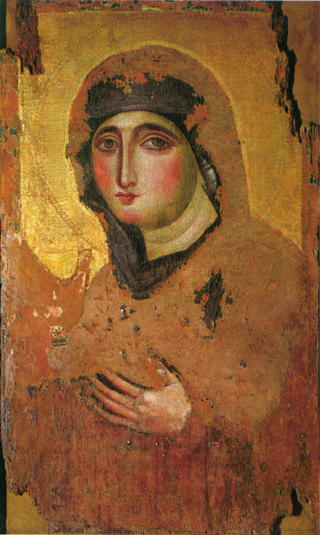 354
Mary was a first-century Jewish woman of Nazareth, the wife of Joseph and the mother of Jesus. She is a central figure of Christianity, venerated under various titles such as virgin or queen, many of...
354
Mary was a first-century Jewish woman of Nazareth, the wife of Joseph and the mother of Jesus. She is a central figure of Christianity, venerated under various titles such as virgin or queen, many of...
Christopher Columbus
 324
Christopher Columbus was an Italian explorer and navigator from the Republic of Genoa who completed four Spanish-based voyages across the Atlantic Ocean sponsored by the Catholic Monarchs, opening...
324
Christopher Columbus was an Italian explorer and navigator from the Republic of Genoa who completed four Spanish-based voyages across the Atlantic Ocean sponsored by the Catholic Monarchs, opening...
Giacomo Leopardi
 313
Count Giacomo Taldegardo Francesco di Sales Saverio Pietro Leopardi was an Italian philosopher, poet, essayist, and philologist. He is considered the greatest Italian poet of the nineteenth century...
313
Count Giacomo Taldegardo Francesco di Sales Saverio Pietro Leopardi was an Italian philosopher, poet, essayist, and philologist. He is considered the greatest Italian poet of the nineteenth century...
Francis of Assisi
 312
Giovanni di Pietro di Bernardone, known as Francis of Assisi, was an Italian mystic, poet and Catholic friar who founded the religious order of the Franciscans. He was inspired to lead a Christian...
312
Giovanni di Pietro di Bernardone, known as Francis of Assisi, was an Italian mystic, poet and Catholic friar who founded the religious order of the Franciscans. He was inspired to lead a Christian...
Enrico Fermi
 311
Enrico Fermi was an Italian and later naturalized American physicist, renowned for being the creator of the world's first nuclear reactor, the Chicago Pile-1, and a member of the Manhattan Project....
311
Enrico Fermi was an Italian and later naturalized American physicist, renowned for being the creator of the world's first nuclear reactor, the Chicago Pile-1, and a member of the Manhattan Project....
Giacomo Puccini
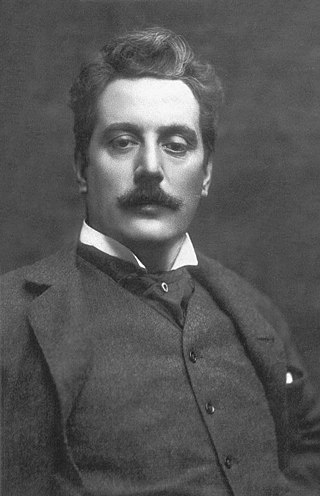 307
Giacomo Puccini was an Italian composer known primarily for his operas. Regarded as the greatest and most successful proponent of Italian opera after Verdi, he was descended from a long line of...
307
Giacomo Puccini was an Italian composer known primarily for his operas. Regarded as the greatest and most successful proponent of Italian opera after Verdi, he was descended from a long line of...
Galileo Galilei
 301
Galileo di Vincenzo Bonaiuti de' Galilei, commonly referred to as Galileo Galilei or simply Galileo, was an Italian astronomer, physicist and engineer, sometimes described as a polymath. He was born...
301
Galileo di Vincenzo Bonaiuti de' Galilei, commonly referred to as Galileo Galilei or simply Galileo, was an Italian astronomer, physicist and engineer, sometimes described as a polymath. He was born...
Giovanni Minzoni
 283
Giovanni Minzoni was an Italian anti-fascist Catholic priest who was killed by a fascist squad in 1923.
283
Giovanni Minzoni was an Italian anti-fascist Catholic priest who was killed by a fascist squad in 1923.
Saint Roch
 278
Roch, also called Rock in English, was a Majorcan Catholic confessor whose death is commemorated on 16 August and 9 September in Italy; he was especially invoked against the plague. He has the...
278
Roch, also called Rock in English, was a Majorcan Catholic confessor whose death is commemorated on 16 August and 9 September in Italy; he was especially invoked against the plague. He has the...
John F. Kennedy
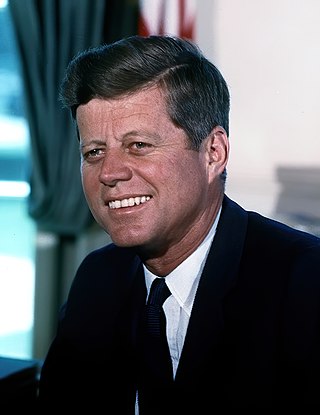 273
John Fitzgerald Kennedy, often referred to as JFK, was an American politician who served as the 35th president of the United States from 1961 until his assassination in 1963. He was the youngest...
273
John Fitzgerald Kennedy, often referred to as JFK, was an American politician who served as the 35th president of the United States from 1961 until his assassination in 1963. He was the youngest...
Gioachino Rossini
 270
Gioachino Antonio Rossini was an Italian composer who gained fame for his 39 operas, although he also wrote many songs, some chamber music and piano pieces and some sacred music. He set new standards...
270
Gioachino Antonio Rossini was an Italian composer who gained fame for his 39 operas, although he also wrote many songs, some chamber music and piano pieces and some sacred music. He set new standards...
Giovanni Pascoli
 270
Giovanni Placido Agostino Pascoli was an Italian poet, classical scholar and an emblematic figure of Italian literature in the late nineteenth century. Alongside Gabriele D'Annunzio, he was one of...
270
Giovanni Placido Agostino Pascoli was an Italian poet, classical scholar and an emblematic figure of Italian literature in the late nineteenth century. Alongside Gabriele D'Annunzio, he was one of...
Sandro Pertini
 243
Alessandro "Sandro" Pertini was an Italian socialist politician and statesman who served as the president of Italy from 1978 to 1985.
243
Alessandro "Sandro" Pertini was an Italian socialist politician and statesman who served as the president of Italy from 1978 to 1985.
Giuseppe Di Vittorio
 238
Giuseppe Di Vittorio, also known as Mario Nicoletti, was an Italian trade union leader and communist politician. He was one of the most influential trade union leaders of the labour movement after...
238
Giuseppe Di Vittorio, also known as Mario Nicoletti, was an Italian trade union leader and communist politician. He was one of the most influential trade union leaders of the labour movement after...
Martin of Tours
 237
Martin of Tours, also known as Martin the Merciful, was the third bishop of Tours. He has become one of the most familiar and recognizable Christian saints in France, heralded as the patron saint of...
237
Martin of Tours, also known as Martin the Merciful, was the third bishop of Tours. He has become one of the most familiar and recognizable Christian saints in France, heralded as the patron saint of...
Anthony of Padua
 236
Anthony of Padua, OFM or Anthony of Lisbon was a Portuguese Catholic priest and friar of the Franciscan Order.
236
Anthony of Padua, OFM or Anthony of Lisbon was a Portuguese Catholic priest and friar of the Franciscan Order.
Ugo Foscolo
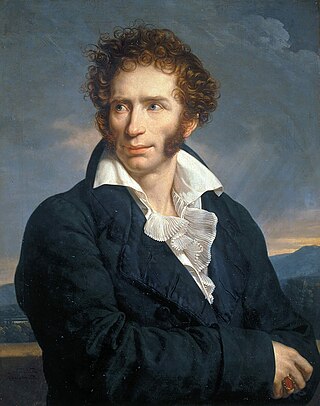 231
Ugo Foscolo, born Niccolò Foscolo, was a Greek-Italian writer, revolutionary and poet.
231
Ugo Foscolo, born Niccolò Foscolo, was a Greek-Italian writer, revolutionary and poet.
Nazario Sauro
 230
Nazario Sauro was an Austrian-born Italian irredentist and sailor.
230
Nazario Sauro was an Austrian-born Italian irredentist and sailor.
Armando Diaz
 224
Armando Diaz, 1st Duke della Vittoria, was an Italian general and a Marshal of Italy. He is mostly known for his role as Chief of Staff of the Regio Esercito during World War I from November 1917. He...
224
Armando Diaz, 1st Duke della Vittoria, was an Italian general and a Marshal of Italy. He is mostly known for his role as Chief of Staff of the Regio Esercito during World War I from November 1917. He...
Michelangelo
 217
Michelangelo di Lodovico Buonarroti Simoni, known mononymously as Michelangelo, was an Italian sculptor, painter, architect, and poet of the High Renaissance. Born in the Republic of Florence, his...
217
Michelangelo di Lodovico Buonarroti Simoni, known mononymously as Michelangelo, was an Italian sculptor, painter, architect, and poet of the High Renaissance. Born in the Republic of Florence, his...
Petrarch
 216
Francis Petrarch, born Francesco di Petracco, was a scholar and poet of the early Italian Renaissance and one of the earliest humanists.
216
Francis Petrarch, born Francesco di Petracco, was a scholar and poet of the early Italian Renaissance and one of the earliest humanists.
Vincenzo Bellini
 197
Vincenzo Salvatore Carmelo Francesco Bellini was an Italian opera composer, who was known for his long-flowing melodic lines for which he was named "the Swan of Catania".
Many years later, in 1898,...
197
Vincenzo Salvatore Carmelo Francesco Bellini was an Italian opera composer, who was known for his long-flowing melodic lines for which he was named "the Swan of Catania".
Many years later, in 1898,...
Silvio Pellico
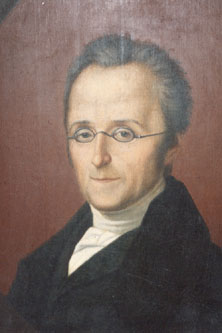 194
Silvio Pellico was an Italian writer, poet, dramatist and patriot active in the Italian unification.
194
Silvio Pellico was an Italian writer, poet, dramatist and patriot active in the Italian unification.
Cervi Brothers
 190
The Cervi Brothers were the seven sons of Alcide Cervi (1875–1970) and Genoeffa Cocconi (1876–1944), born in Campegine, Emilia-Romagna. The brothers and their father became renowned for their...
190
The Cervi Brothers were the seven sons of Alcide Cervi (1875–1970) and Genoeffa Cocconi (1876–1944), born in Campegine, Emilia-Romagna. The brothers and their father became renowned for their...
Palmiro Togliatti
 186
Palmiro Michele Nicola Togliatti was an Italian politician and leader of Italy's Communist party for nearly forty years, from 1927 until his death. Born into a middle-class family, Togliatti received...
186
Palmiro Michele Nicola Togliatti was an Italian politician and leader of Italy's Communist party for nearly forty years, from 1927 until his death. Born into a middle-class family, Togliatti received...
Grazia Deledda
 182
Grazia Maria Cosima Damiana Deledda was an Italian writer who received the Nobel Prize for Literature in 1926 "for her idealistically inspired writings which with plastic clarity picture the life on...
182
Grazia Maria Cosima Damiana Deledda was an Italian writer who received the Nobel Prize for Literature in 1926 "for her idealistically inspired writings which with plastic clarity picture the life on...
Filippo Turati
 181
Filippo Turati was an Italian sociologist, criminologist, poet and socialist politician.
181
Filippo Turati was an Italian sociologist, criminologist, poet and socialist politician.
Nello Rosselli
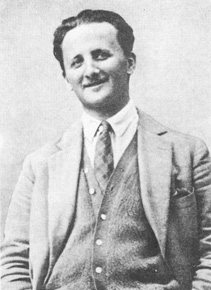 175
Sabatino Enrico 'Nello' Rosselli was an Italian Socialist leader and historian.
175
Sabatino Enrico 'Nello' Rosselli was an Italian Socialist leader and historian.
Salvo D'Acquisto
 172
Salvo D'Acquisto was a member of the Italian Carabinieri during the Second World War.
172
Salvo D'Acquisto was a member of the Italian Carabinieri during the Second World War.
Pietro Nenni
 172
Pietro Sandro Nenni was an Italian socialist politician, the national secretary of the Italian Socialist Party (PSI) and senator for life since 1970. He was a recipient of the Lenin Peace Prize in...
172
Pietro Sandro Nenni was an Italian socialist politician, the national secretary of the Italian Socialist Party (PSI) and senator for life since 1970. He was a recipient of the Lenin Peace Prize in...
Gaetano Donizetti
 167
Domenico Gaetano Maria Donizetti was an Italian composer, best known for his almost 70 operas. Along with Gioachino Rossini and Vincenzo Bellini, he was a leading composer of the bel canto opera...
167
Domenico Gaetano Maria Donizetti was an Italian composer, best known for his almost 70 operas. Along with Gioachino Rossini and Vincenzo Bellini, he was a leading composer of the bel canto opera...
Goffredo Mameli
 166
Goffredo Mameli was an Italian patriot, poet, writer and a notable figure in the Risorgimento. He is also the author of the lyrics of "Il Canto degli Italiani", the national anthem of Italy.
166
Goffredo Mameli was an Italian patriot, poet, writer and a notable figure in the Risorgimento. He is also the author of the lyrics of "Il Canto degli Italiani", the national anthem of Italy.
Raphael
 164
Raffaello Sanzio da Urbino, now generally known in English as Raphael, was an Italian painter and architect of the High Renaissance. His work is admired for its clarity of form, ease of composition,...
164
Raffaello Sanzio da Urbino, now generally known in English as Raphael, was an Italian painter and architect of the High Renaissance. His work is admired for its clarity of form, ease of composition,...
Bruno Buozzi
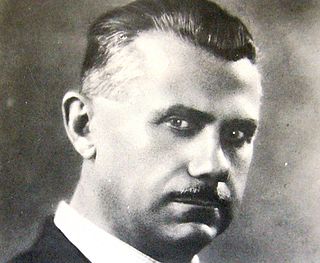 163
Bruno Buozzi è stato un sindacalista, politico, operaio e antifascista italiano.
163
Bruno Buozzi è stato un sindacalista, politico, operaio e antifascista italiano.
Saint Peter
 163
Saint Peter, also known as Peter the Apostle, Simon Peter, Simeon, Simon, or Cephas, was one of the Twelve Apostles of Jesus Christ and one of the first leaders of the early Christian Church. He...
163
Saint Peter, also known as Peter the Apostle, Simon Peter, Simeon, Simon, or Cephas, was one of the Twelve Apostles of Jesus Christ and one of the first leaders of the early Christian Church. He...
Amerigo Vespucci
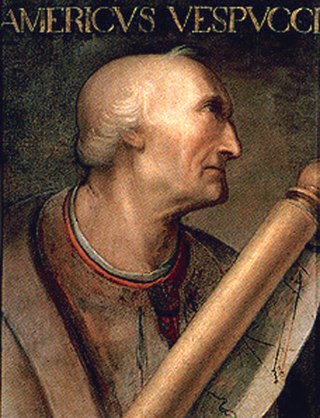 155
Amerigo Vespucci was an Italian explorer and navigator from the Republic of Florence, from whose name the term "America" is derived.
155
Amerigo Vespucci was an Italian explorer and navigator from the Republic of Florence, from whose name the term "America" is derived.
Luigi Sturzo
 152
Luigi Sturzo was an Italian Catholic priest and prominent politician. He was known in his lifetime as a Christian socialist and is considered one of the fathers of the Christian democratic platform....
152
Luigi Sturzo was an Italian Catholic priest and prominent politician. He was known in his lifetime as a Christian socialist and is considered one of the fathers of the Christian democratic platform....
Edmondo De Amicis
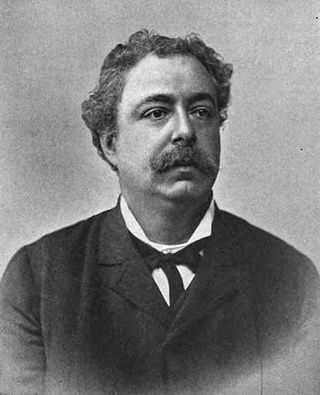 150
Edmondo De Amicis was an Italian novelist, journalist, poet, and short-story writer. His best-known book is Cuore, a children's novel translated into English as Heart.
150
Edmondo De Amicis was an Italian novelist, journalist, poet, and short-story writer. His best-known book is Cuore, a children's novel translated into English as Heart.
Pietro Mascagni
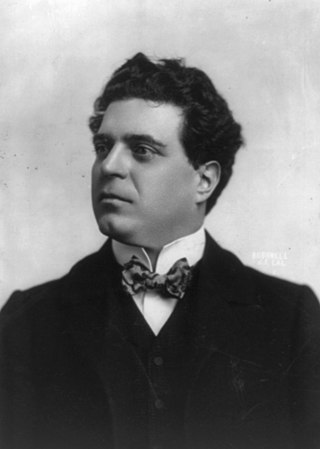 150
Pietro Mascagni was an Italian composer primarily known for his operas. His 1890 masterpiece Cavalleria rusticana caused one of the greatest sensations in opera history and single-handedly ushered in...
150
Pietro Mascagni was an Italian composer primarily known for his operas. His 1890 masterpiece Cavalleria rusticana caused one of the greatest sensations in opera history and single-handedly ushered in...
Guglielmo Oberdan
 145
Guglielmo Oberdan was an Italian irredentist. He was executed after a failed attempt to assassinate Austrian Emperor Franz Joseph, becoming a martyr of the Italian unification movement.
145
Guglielmo Oberdan was an Italian irredentist. He was executed after a failed attempt to assassinate Austrian Emperor Franz Joseph, becoming a martyr of the Italian unification movement.
Giotto
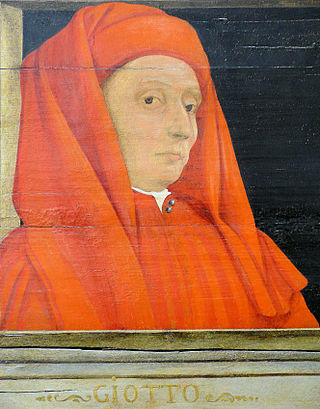 143
Giotto di Bondone, known mononymously as Giotto and Latinised as Giottus, was an Italian painter and architect from Florence during the Late Middle Ages. He worked during the Gothic and...
143
Giotto di Bondone, known mononymously as Giotto and Latinised as Giottus, was an Italian painter and architect from Florence during the Late Middle Ages. He worked during the Gothic and...
Michael (archangel)
 140
Michael, also called Saint Michael the Archangel, Archangel Michael and Saint Michael the Taxiarch is an archangel in Judaism, Christianity, Islam, and the Baha'i faith. The earliest surviving...
140
Michael, also called Saint Michael the Archangel, Archangel Michael and Saint Michael the Taxiarch is an archangel in Judaism, Christianity, Islam, and the Baha'i faith. The earliest surviving...
Achille Grandi
 140
Achille Grandi was an Italian politician and catholic syndicalist.
140
Achille Grandi was an Italian politician and catholic syndicalist.
Vittorio Alfieri
 139
Count Vittorio Alfieri was an Italian dramatist and poet, considered the "founder of Italian tragedy." He wrote nineteen tragedies, sonnets, satires, and a notable autobiography.
139
Count Vittorio Alfieri was an Italian dramatist and poet, considered the "founder of Italian tragedy." He wrote nineteen tragedies, sonnets, satires, and a notable autobiography.
Ludovico Ariosto
 137
Ludovico Ariosto was an Italian poet. He is best known as the author of the romance epic Orlando Furioso (1516). The poem, a continuation of Matteo Maria Boiardo's Orlando Innamorato, describes the...
137
Ludovico Ariosto was an Italian poet. He is best known as the author of the romance epic Orlando Furioso (1516). The poem, a continuation of Matteo Maria Boiardo's Orlando Innamorato, describes the...
Gabriele D'Annunzio
 132
General Gabriele D'Annunzio, Prince of Montenevoso, sometimes written d'Annunzio as he used to sign himself, was an Italian poet, playwright, orator, journalist, aristocrat, and Royal Italian Army...
132
General Gabriele D'Annunzio, Prince of Montenevoso, sometimes written d'Annunzio as he used to sign himself, was an Italian poet, playwright, orator, journalist, aristocrat, and Royal Italian Army...
Giovanni Amendola
 130
Giovanni Amendola was an Italian journalist, professor, and politician. He is noted as an opponent of Italian fascism.
130
Giovanni Amendola was an Italian journalist, professor, and politician. He is noted as an opponent of Italian fascism.
Marco Polo
 130
Marco Polo was a Venetian merchant, explorer and writer who travelled through Asia along the Silk Road between 1271 and 1295. His travels are recorded in The Travels of Marco Polo, a book that...
130
Marco Polo was a Venetian merchant, explorer and writer who travelled through Asia along the Silk Road between 1271 and 1295. His travels are recorded in The Travels of Marco Polo, a book that...
Bandiera brothers
 129
The brothers Attilio (1811–1844) and Emilio Bandiera (1819–1844) were Italian nationalists during the Risorgimento.
129
The brothers Attilio (1811–1844) and Emilio Bandiera (1819–1844) were Italian nationalists during the Risorgimento.
Nino Bixio
 126
Gerolamo "Nino" Bixio was an Italian general, patriot and politician, one of the most prominent figures in the Italian unification.
126
Gerolamo "Nino" Bixio was an Italian general, patriot and politician, one of the most prominent figures in the Italian unification.
Luigi Einaudi
 125
Luigi Numa Lorenzo Einaudi was an Italian politician and economist. He served as the president of Italy from 1948 to 1955 and one of the founding fathers of the Italian Republic.
125
Luigi Numa Lorenzo Einaudi was an Italian politician and economist. He served as the president of Italy from 1948 to 1955 and one of the founding fathers of the Italian Republic.
Mark the Evangelist
 124
Mark the Evangelist also known as John Mark or Saint Mark, is the person who is traditionally ascribed to be the author of the Gospel of Mark. Modern Bible scholars have concluded that the Gospel of...
124
Mark the Evangelist also known as John Mark or Saint Mark, is the person who is traditionally ascribed to be the author of the Gospel of Mark. Modern Bible scholars have concluded that the Gospel of...
Enrico Toti
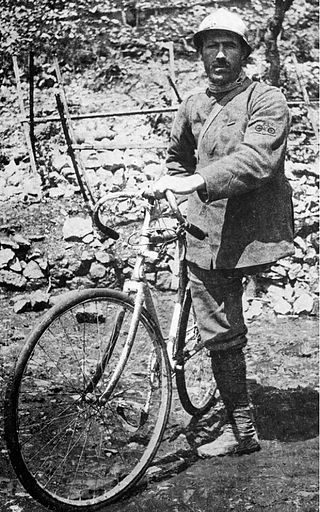 123
Enrico Toti was an Italian cyclist, patriot and hero of World War I.
123
Enrico Toti was an Italian cyclist, patriot and hero of World War I.
Luigi Galvani
 122
Luigi Galvani was an Italian physician, physicist, biologist and philosopher, who studied animal electricity. In 1780, he discovered that the muscles of dead frogs' legs twitched when struck by an...
122
Luigi Galvani was an Italian physician, physicist, biologist and philosopher, who studied animal electricity. In 1780, he discovered that the muscles of dead frogs' legs twitched when struck by an...
Carlo Alberto dalla Chiesa
 122
Carlo Alberto dalla Chiesa was an Italian Carabinieri general, notable for campaigning against terrorism during the Years of Lead. He was assassinated in the Via Carini massacre by the Sicilian...
122
Carlo Alberto dalla Chiesa was an Italian Carabinieri general, notable for campaigning against terrorism during the Years of Lead. He was assassinated in the Via Carini massacre by the Sicilian...
Saint George
 122
Saint George, also George of Lydda, was an early Christian martyr who is venerated as a saint in Christianity. According to tradition, he was a soldier in the Roman army. Of Cappadocian Greek origin,...
122
Saint George, also George of Lydda, was an early Christian martyr who is venerated as a saint in Christianity. According to tradition, he was a soldier in the Roman army. Of Cappadocian Greek origin,...
Ippolito Nievo
 121
Ippolito Nievo was an Italian writer, journalist and patriot. His Confessions of an Italian is widely considered the most important novel about the Italian Risorgimento.
121
Ippolito Nievo was an Italian writer, journalist and patriot. His Confessions of an Italian is widely considered the most important novel about the Italian Risorgimento.
Saint Lawrence
 121
Saint Lawrence or Laurence was one of the seven deacons of the city of Rome under Pope Sixtus II who were martyred in the persecution of the Christians that the Roman Emperor Valerian ordered in 258.
121
Saint Lawrence or Laurence was one of the seven deacons of the city of Rome under Pope Sixtus II who were martyred in the persecution of the Christians that the Roman Emperor Valerian ordered in 258.
Fabio Filzi
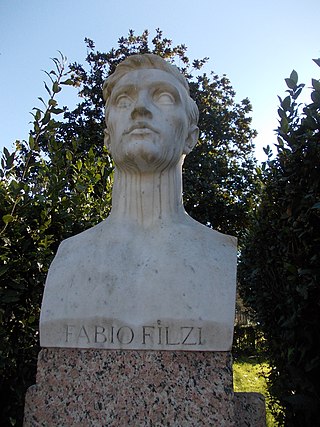 120
Fabio Filzi was an ethnic-Italian who was born in the Austria-Hungarian Empire but was a irredentist patriot whose firm belief was that the Italian portions of Austria-Hungarian Empire should be...
120
Fabio Filzi was an ethnic-Italian who was born in the Austria-Hungarian Empire but was a irredentist patriot whose firm belief was that the Italian portions of Austria-Hungarian Empire should be...
Saint Joseph
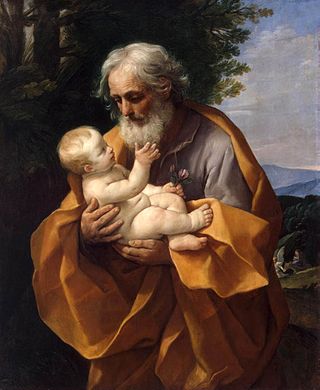 120
Joseph was a 1st-century Jewish man of Nazareth who, according to the canonical Gospels, was married to Mary, the mother of Jesus, and was the legal father of Jesus.
120
Joseph was a 1st-century Jewish man of Nazareth who, according to the canonical Gospels, was married to Mary, the mother of Jesus, and was the legal father of Jesus.
Torquato Tasso
 119
Torquato Tasso was an Italian poet of the 16th century, known for his 1591 poem Gerusalemme liberata, in which he depicts a highly imaginative version of the combats between Christians and Muslims at...
119
Torquato Tasso was an Italian poet of the 16th century, known for his 1591 poem Gerusalemme liberata, in which he depicts a highly imaginative version of the combats between Christians and Muslims at...
Antonio Vivaldi
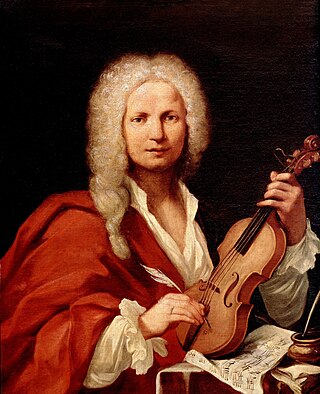 115
Antonio Lucio Vivaldi was an Italian composer, virtuoso violinist and impresario of Baroque music. Along with Johann Sebastian Bach and George Frideric Handel, Vivaldi ranks amongst the greatest...
115
Antonio Lucio Vivaldi was an Italian composer, virtuoso violinist and impresario of Baroque music. Along with Johann Sebastian Bach and George Frideric Handel, Vivaldi ranks amongst the greatest...
Giovanni Boccaccio
 113
Giovanni Boccaccio was an Italian writer, poet, correspondent of Petrarch, and an important Renaissance humanist. Born in the town of Certaldo, he became so well known as a writer that he was...
113
Giovanni Boccaccio was an Italian writer, poet, correspondent of Petrarch, and an important Renaissance humanist. Born in the town of Certaldo, he became so well known as a writer that he was...
Margherita of Savoy
 113
Margherita of Savoy was Queen of Italy by marriage to her first cousin King Umberto I of Italy. She was the daughter of Prince Ferdinand of Savoy, Duke of Genoa and Princess Elisabeth of Saxony, and...
113
Margherita of Savoy was Queen of Italy by marriage to her first cousin King Umberto I of Italy. She was the daughter of Prince Ferdinand of Savoy, Duke of Genoa and Princess Elisabeth of Saxony, and...
Catherine of Siena
 112
Caterina di Jacopo di Benincasa, known as Catherine of Siena, was an Italian mystic and pious laywoman who engaged in papal and Italian politics through extensive letter-writing and advocacy....
112
Caterina di Jacopo di Benincasa, known as Catherine of Siena, was an Italian mystic and pious laywoman who engaged in papal and Italian politics through extensive letter-writing and advocacy....
Arturo Toscanini
 111
Arturo Toscanini was an Italian conductor. He was one of the most acclaimed and influential musicians of the late 19th and early 20th century, renowned for his intensity, his perfectionism, his ear...
111
Arturo Toscanini was an Italian conductor. He was one of the most acclaimed and influential musicians of the late 19th and early 20th century, renowned for his intensity, his perfectionism, his ear...
Enrico Berlinguer
 110
Enrico Berlinguer was an Italian politician. Considered the most popular leader of the Italian Communist Party (PCI), he led the PCI as the national secretary from 1972 until his death during a tense...
110
Enrico Berlinguer was an Italian politician. Considered the most popular leader of the Italian Communist Party (PCI), he led the PCI as the national secretary from 1972 until his death during a tense...
Felice Cavallotti
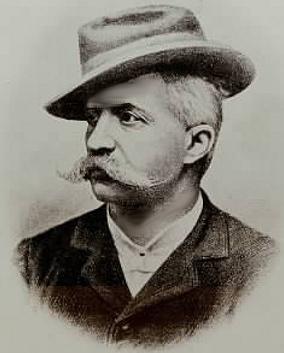 110
Felice Cavallotti was an Italian politician, poet and dramatic author.
110
Felice Cavallotti was an Italian politician, poet and dramatic author.
Giuseppe Parini
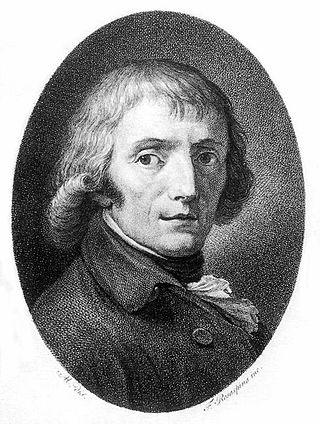 109
Giuseppe Parini was an Italian enlightenment satirist and poet of the neoclassic period.
109
Giuseppe Parini was an Italian enlightenment satirist and poet of the neoclassic period.
Saint Anne
 109
According to apocrypha, as well as Christian and Islamic tradition, Saint Anne was the mother of Mary, the wife of Joachim and the maternal grandmother of Jesus. Mary's mother is not named in the...
109
According to apocrypha, as well as Christian and Islamic tradition, Saint Anne was the mother of Mary, the wife of Joachim and the maternal grandmother of Jesus. Mary's mother is not named in the...
Giuseppe Giusti
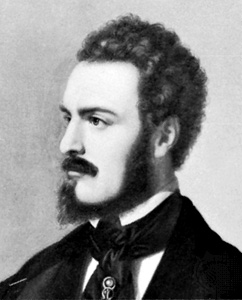 105
Giuseppe Giusti was an Italian poet and satirist.
105
Giuseppe Giusti was an Italian poet and satirist.
Charles Borromeo
 105
Charles Borromeo was the Archbishop of Milan from 1564 to 1584 and a cardinal of the Catholic Church. He was a leading figure of the Counter-Reformation combat against the Protestant Reformation...
105
Charles Borromeo was the Archbishop of Milan from 1564 to 1584 and a cardinal of the Catholic Church. He was a leading figure of the Counter-Reformation combat against the Protestant Reformation...
Antonio Meucci
 105
Antonio Santi Giuseppe Meucci was an Italian inventor and an associate of Giuseppe Garibaldi, a major political figure in the history of Italy. Meucci is best known for developing a...
105
Antonio Santi Giuseppe Meucci was an Italian inventor and an associate of Giuseppe Garibaldi, a major political figure in the history of Italy. Meucci is best known for developing a...
Luigi Cadorna
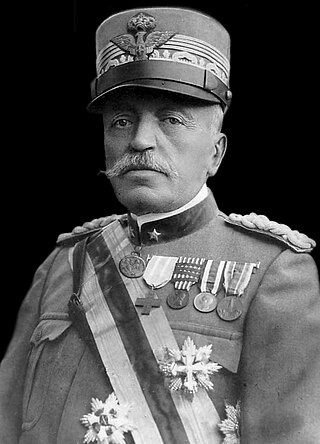 104
Marshal of Italy Luigi Cadorna, was an Italian general, Marshal of Italy and Count, most famous for being the Chief of Staff of the Italian Army from 1914 until 1917 during World War I. During this...
104
Marshal of Italy Luigi Cadorna, was an Italian general, Marshal of Italy and Count, most famous for being the Chief of Staff of the Italian Army from 1914 until 1917 during World War I. During this...
Titian
 102
Tiziano Vecelli or Vecellio, Latinized as Titianus, hence known in English as Titian, was an Italian (Venetian) Renaissance painter of Lombard origin, considered the most important member of the...
102
Tiziano Vecelli or Vecellio, Latinized as Titianus, hence known in English as Titian, was an Italian (Venetian) Renaissance painter of Lombard origin, considered the most important member of the...
Piero Gobetti
Giovanni Falcone
 101
Giovanni Falcone was an Italian judge and prosecuting magistrate. From his office in the Palace of Justice in Palermo, Sicily, he spent most of his professional life trying to overthrow the power of...
101
Giovanni Falcone was an Italian judge and prosecuting magistrate. From his office in the Palace of Justice in Palermo, Sicily, he spent most of his professional life trying to overthrow the power of...
Francesco Baracca
 100
Count Francesco Baracca was Italy's top fighter ace of World War I. He was credited with 34 aerial victories. The emblem he wore side by side on his plane of a black horse prancing on its two rear...
100
Count Francesco Baracca was Italy's top fighter ace of World War I. He was credited with 34 aerial victories. The emblem he wore side by side on his plane of a black horse prancing on its two rear...
Benedetto Croce
 99
Benedetto Croce, OCI, COSML
was an Italian idealist philosopher, historian, and politician who wrote on numerous topics, including philosophy, history, historiography, and aesthetics. A political...
99
Benedetto Croce, OCI, COSML
was an Italian idealist philosopher, historian, and politician who wrote on numerous topics, including philosophy, history, historiography, and aesthetics. A political...
Saint Lucy
 99
Lucia of Syracuse (283–304), also called Saint Lucia was a Roman Christian martyr who died during the Diocletianic Persecution. She is venerated as a saint in Catholic, Anglican, Lutheran, and...
99
Lucia of Syracuse (283–304), also called Saint Lucia was a Roman Christian martyr who died during the Diocletianic Persecution. She is venerated as a saint in Catholic, Anglican, Lutheran, and...
James the Great
 97
James the Great was one of the Twelve Apostles of Jesus. According to the New Testament, he was the second of the apostles to die, and the first to be martyred. Saint James is the patron saint of...
97
James the Great was one of the Twelve Apostles of Jesus. According to the New Testament, he was the second of the apostles to die, and the first to be martyred. Saint James is the patron saint of...
Enrico Mattei
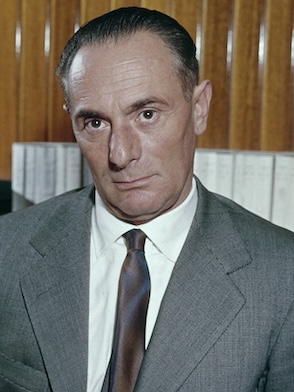 96
Enrico Mattei was an Italian public administrator. After World War II, he was given the task of dismantling the Italian petroleum agency Agip, a state enterprise established by Fascist Italy....
96
Enrico Mattei was an Italian public administrator. After World War II, he was given the task of dismantling the Italian petroleum agency Agip, a state enterprise established by Fascist Italy....
Evangelista Torricelli
 94
Evangelista Torricelli was an Italian physicist and mathematician, and a student of Galileo. He is best known for his invention of the barometer, but is also known for his advances in optics and work...
94
Evangelista Torricelli was an Italian physicist and mathematician, and a student of Galileo. He is best known for his invention of the barometer, but is also known for his advances in optics and work...
Alfonso Ferrero La Marmora
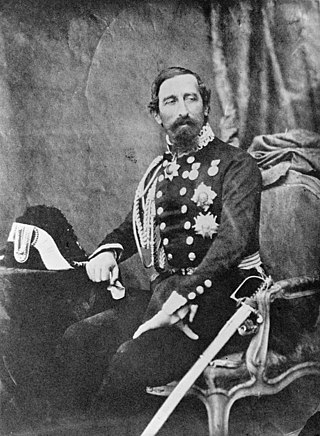 90
Alfonso Ferrero La Marmora was an Italian general and statesman. His older brothers include soldier and naturalist Alberto della Marmora and Alessandro Ferrero La Marmora, founder of the branch of...
90
Alfonso Ferrero La Marmora was an Italian general and statesman. His older brothers include soldier and naturalist Alberto della Marmora and Alessandro Ferrero La Marmora, founder of the branch of...
Andrew the Apostle
 90
Andrew the Apostle, also called Saint Andrew, was an apostle of Jesus. According to the New Testament, he was a fisherman and one of the Twelve Apostles chosen by Jesus. The title First-Called stems...
90
Andrew the Apostle, also called Saint Andrew, was an apostle of Jesus. According to the New Testament, he was a fisherman and one of the Twelve Apostles chosen by Jesus. The title First-Called stems...
Niccolò Paganini
 90
Niccolò Paganini was an Italian violinist and composer. He was the most celebrated violin virtuoso of his time, and left his mark as one of the pillars of modern violin technique. His 24 Caprices for...
90
Niccolò Paganini was an Italian violinist and composer. He was the most celebrated violin virtuoso of his time, and left his mark as one of the pillars of modern violin technique. His 24 Caprices for...
Francesco Crispi
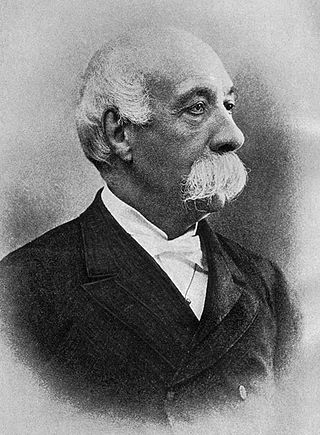 89
Francesco Crispi was an Italian patriot and statesman. He was among the main protagonists of the Risorgimento, a close friend and supporter of Giuseppe Mazzini and Giuseppe Garibaldi, and one of the...
89
Francesco Crispi was an Italian patriot and statesman. He was among the main protagonists of the Risorgimento, a close friend and supporter of Giuseppe Mazzini and Giuseppe Garibaldi, and one of the...
Daniele Manin
 89
Daniele Manin was an Italian patriot, statesman and leader of the Risorgimento in Venice.
89
Daniele Manin was an Italian patriot, statesman and leader of the Risorgimento in Venice.
Massimo d'Azeglio
 88
Massimo Taparelli, Marquess of Azeglio, commonly called Massimo d'Azeglio, was a Piedmontese-Italian statesman, novelist, and painter. He was Prime Minister of Sardinia for almost three years until...
88
Massimo Taparelli, Marquess of Azeglio, commonly called Massimo d'Azeglio, was a Piedmontese-Italian statesman, novelist, and painter. He was Prime Minister of Sardinia for almost three years until...
Paolo Borsellino
 87
Paolo Emanuele Borsellino was an Italian judge and prosecuting magistrate. From his office in the Palace of Justice in Palermo, Sicily, he spent most of his professional life trying to overthrow the...
87
Paolo Emanuele Borsellino was an Italian judge and prosecuting magistrate. From his office in the Palace of Justice in Palermo, Sicily, he spent most of his professional life trying to overthrow the...
Giovanni Verga
 86
Giovanni Carmelo Verga di Fontanabianca was an Italian realist (verista) writer, best known for his depictions of life in his native Sicily, especially the short story and later play Cavalleria...
86
Giovanni Carmelo Verga di Fontanabianca was an Italian realist (verista) writer, best known for his depictions of life in his native Sicily, especially the short story and later play Cavalleria...
Guido Rossa
 86
Guido Rossa was an Italian worker and syndicalist who was born in Cesiomaggiore, Veneto, and lived for several years in Turin. His first job was at the age of 14 as a worker in a ball bearing...
86
Guido Rossa was an Italian worker and syndicalist who was born in Cesiomaggiore, Veneto, and lived for several years in Turin. His first job was at the age of 14 as a worker in a ball bearing...
Antonio Pacinotti
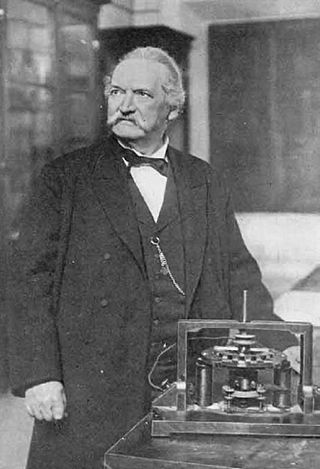 85
Antonio Pacinotti was an Italian physicist, who was Professor of Physics at the University of Pisa.
85
Antonio Pacinotti was an Italian physicist, who was Professor of Physics at the University of Pisa.
Giovanni Prati
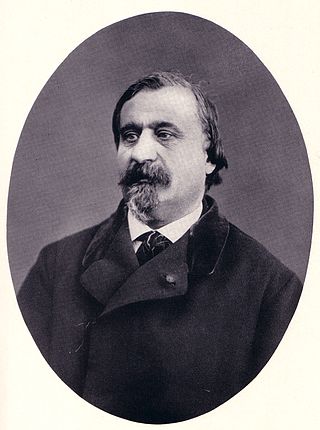 84
Giovanni Prati was an Italian poet and politician.
84
Giovanni Prati was an Italian poet and politician.
Andrea Costa
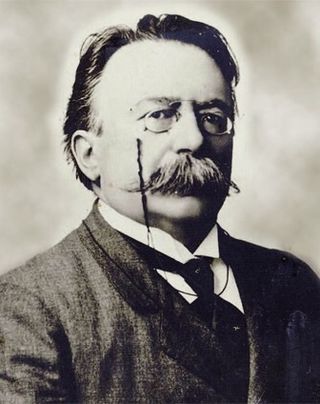 84
Andrea Costa was an Italian politician who was initiated on September 25, 1883 to the Masonic Lodge "Rienzi" in Rome and progressively become 32nd-degree Mason and adjunctive Great Master of the...
84
Andrea Costa was an Italian politician who was initiated on September 25, 1883 to the Masonic Lodge "Rienzi" in Rome and progressively become 32nd-degree Mason and adjunctive Great Master of the...
Giordano Bruno
 83
Giordano Bruno was an Italian philosopher, poet, cosmological theorist and esotericist. He is known for his cosmological theories, which conceptually extended to include the then-novel Copernican...
83
Giordano Bruno was an Italian philosopher, poet, cosmological theorist and esotericist. He is known for his cosmological theories, which conceptually extended to include the then-novel Copernican...
Salvador Allende
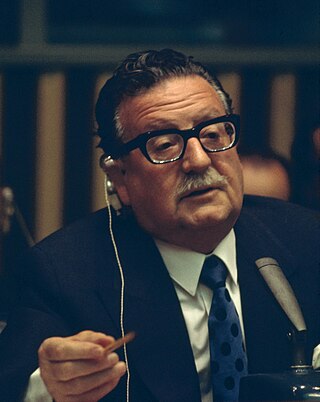 83
Salvador Guillermo Allende Gossens was a Chilean socialist politician who served as the 28th president of Chile from 1970 until his death in 1973. As a democratic socialist committed to democracy, he...
83
Salvador Guillermo Allende Gossens was a Chilean socialist politician who served as the 28th president of Chile from 1970 until his death in 1973. As a democratic socialist committed to democracy, he...
Luigi Pirandello
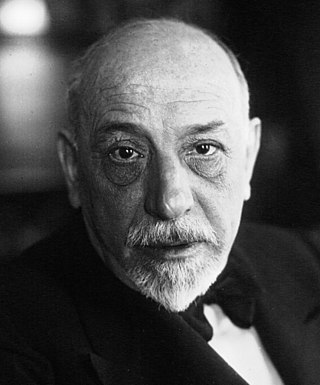 82
Luigi Pirandello was an Italian dramatist, novelist, poet, and short story writer whose greatest contributions were his plays. He was awarded the 1934 Nobel Prize in Literature "for his bold and...
82
Luigi Pirandello was an Italian dramatist, novelist, poet, and short story writer whose greatest contributions were his plays. He was awarded the 1934 Nobel Prize in Literature "for his bold and...
Antonio Canova
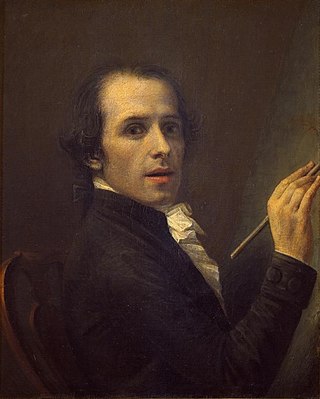 81
Antonio Canova was an Italian Neoclassical sculptor, famous for his marble sculptures. Often regarded as the greatest of the Neoclassical artists, his sculpture was inspired by the Baroque and the...
81
Antonio Canova was an Italian Neoclassical sculptor, famous for his marble sculptures. Often regarded as the greatest of the Neoclassical artists, his sculpture was inspired by the Baroque and the...
Lorenzo Milani
 80
Lorenzo Carlo Domenico Milani Comparetti was an Italian Catholic priest. He was an educator of poor children and an advocate of conscientious objection.
80
Lorenzo Carlo Domenico Milani Comparetti was an Italian Catholic priest. He was an educator of poor children and an advocate of conscientious objection.
Helen of Greece and Denmark
 79
Helen of Greece and Denmark was the queen mother of Romania during the reign of her son King Michael I (1940–1947). She was noted for her humanitarian efforts to save Romanian Jews during World War...
79
Helen of Greece and Denmark was the queen mother of Romania during the reign of her son King Michael I (1940–1947). She was noted for her humanitarian efforts to save Romanian Jews during World War...
Vincenzo Monti
 79
Vincenzo Monti was an Italian poet, playwright, translator, and scholar, the greatest interpreter of Italian neoclassicism in all of its various phases. His verse translation of the Iliad is...
79
Vincenzo Monti was an Italian poet, playwright, translator, and scholar, the greatest interpreter of Italian neoclassicism in all of its various phases. His verse translation of the Iliad is...
Saint Sebastian
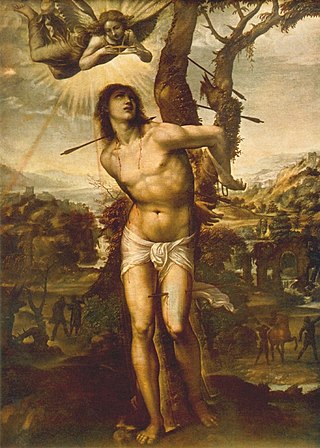 79
Sebastian was an early Christian saint and martyr. According to traditional belief, he was killed during the Diocletianic Persecution of Christians. He was initially tied to a post or tree and shot...
79
Sebastian was an early Christian saint and martyr. According to traditional belief, he was killed during the Diocletianic Persecution of Christians. He was initially tied to a post or tree and shot...
Carlo Pisacane
 78
Carlo Pisacane, Duke of San Giovanni was an Italian patriot and one of the first Italian socialist thinkers. He argued that violence was necessary not only to draw attention to, or generate publicity...
78
Carlo Pisacane, Duke of San Giovanni was an Italian patriot and one of the first Italian socialist thinkers. He argued that violence was necessary not only to draw attention to, or generate publicity...
Eugenio Curiel
 78
Eugenio Curiel was an Italian-Jewish physicist, a prominent figure of the Italian resistance movement. He was awarded a gold medal (posthumously) for military valour.
78
Eugenio Curiel was an Italian-Jewish physicist, a prominent figure of the Italian resistance movement. He was awarded a gold medal (posthumously) for military valour.
Martin Luther King Jr.
 75
Martin Luther King Jr. was an American Christian minister, activist, and political philosopher who was one of the most prominent leaders in the civil rights movement from 1955 until his assassination...
75
Martin Luther King Jr. was an American Christian minister, activist, and political philosopher who was one of the most prominent leaders in the civil rights movement from 1955 until his assassination...
Carlo Cattaneo
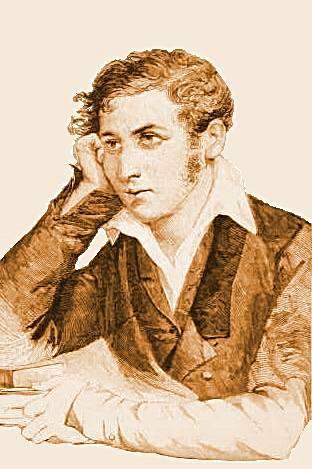 75
Carlo Cattaneo was an Italian philosopher, writer, and activist, famous for his role in the Five Days of Milan in March 1848, when he led the city council during the rebellion.
75
Carlo Cattaneo was an Italian philosopher, writer, and activist, famous for his role in the Five Days of Milan in March 1848, when he led the city council during the rebellion.
Eugenio Montale
 75
Eugenio Montale was an Italian poet, prose writer, editor and translator, and recipient of the 1975 Nobel Prize in Literature.
75
Eugenio Montale was an Italian poet, prose writer, editor and translator, and recipient of the 1975 Nobel Prize in Literature.
Aurelia gens
 74
The gens Aurelia was a plebeian family at ancient Rome, which flourished from the third century BC to the latest period of the Empire. The first of the Aurelian gens to obtain the consulship was...
74
The gens Aurelia was a plebeian family at ancient Rome, which flourished from the third century BC to the latest period of the Empire. The first of the Aurelian gens to obtain the consulship was...
Arrigo Boito
 73
Arrigo Boito was an Italian librettist, composer, poet and critic whose only completed opera was Mefistofele. Among the operas for which he wrote the libretti are Giuseppe Verdi's monumental last two...
73
Arrigo Boito was an Italian librettist, composer, poet and critic whose only completed opera was Mefistofele. Among the operas for which he wrote the libretti are Giuseppe Verdi's monumental last two...
Sebastiano Satta
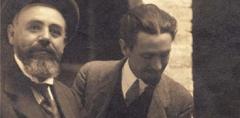 73
Sebastiano Satta was an Italian poet, writer, lawyer, and journalist.
73
Sebastiano Satta was an Italian poet, writer, lawyer, and journalist.
Saint Stephen
 72
Stephen is traditionally venerated as the protomartyr or first martyr of Christianity. According to the Acts of the Apostles, he was a deacon in the early church at Jerusalem who angered members of...
72
Stephen is traditionally venerated as the protomartyr or first martyr of Christianity. According to the Acts of the Apostles, he was a deacon in the early church at Jerusalem who angered members of...
Niccolò Machiavelli
 72
Niccolò di Bernardo dei Machiavelli was a Florentine diplomat, author, philosopher and historian who lived during the Renaissance. He is best known for his political treatise The Prince, written...
72
Niccolò di Bernardo dei Machiavelli was a Florentine diplomat, author, philosopher and historian who lived during the Renaissance. He is best known for his political treatise The Prince, written...
Eleanor of Arborea
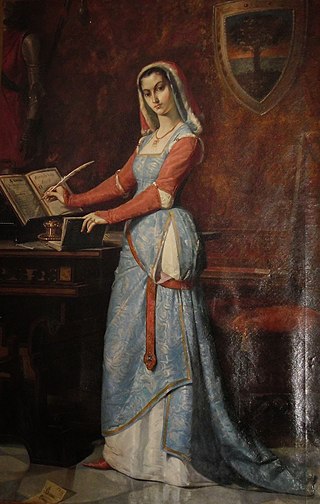 72
Eleanor of Arborea or Eleanor De Serra Bas was one of the most powerful and important, and one of the last, judges of the Judicate of Arborea in Sardinia, and Sardinia's most famous heroine. She is...
72
Eleanor of Arborea or Eleanor De Serra Bas was one of the most powerful and important, and one of the last, judges of the Judicate of Arborea in Sardinia, and Sardinia's most famous heroine. She is...
Filippo Corridoni
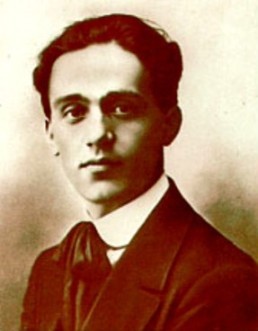 71
Filippo Corridoni was an Italian trade unionist and syndicalist. Born in Pausula, today Corridonia, he was a friend of future Italian fascist dictator Benito Mussolini. Between 24 and 25 January...
71
Filippo Corridoni was an Italian trade unionist and syndicalist. Born in Pausula, today Corridonia, he was a friend of future Italian fascist dictator Benito Mussolini. Between 24 and 25 January...
Paul the Apostle
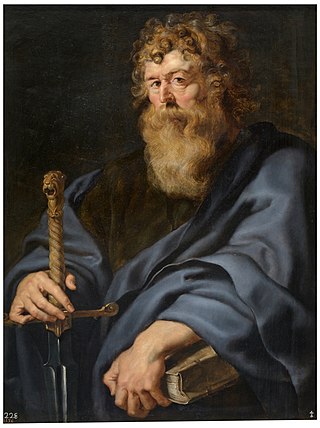 70
Paul, commonly known as Paul the Apostle and Saint Paul, was a Christian apostle who spread the teachings of Jesus in the first-century world. For his contributions towards the New Testament, he is...
70
Paul, commonly known as Paul the Apostle and Saint Paul, was a Christian apostle who spread the teachings of Jesus in the first-century world. For his contributions towards the New Testament, he is...
Pietro Zorutti
 69
Pietro Zorutti was an Italian poet. His fame is mainly due to the publication each year from 1821 to 1867 of Friulian language poetry. Much of his Friulian poetry was based around the middle class...
69
Pietro Zorutti was an Italian poet. His fame is mainly due to the publication each year from 1821 to 1867 of Friulian language poetry. Much of his Friulian poetry was based around the middle class...
Ciro Menotti
 69
Ciro Menotti was an Italian patriot.
69
Ciro Menotti was an Italian patriot.
Enrico De Nicola
 68
Enrico De Nicola, was an Italian jurist, journalist, politician, and provisional head of state of republican Italy from 1946 to 1948. Afterwards, he became the first president of Italy on 1 January...
68
Enrico De Nicola, was an Italian jurist, journalist, politician, and provisional head of state of republican Italy from 1946 to 1948. Afterwards, he became the first president of Italy on 1 January...
Giacomo Brodolini
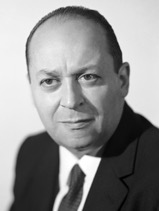 68
Giacomo Brodolini was an Italian socialist politician and trade unionist. He served as the minister of labour and social security between December 1968 and 1969.
68
Giacomo Brodolini was an Italian socialist politician and trade unionist. He served as the minister of labour and social security between December 1968 and 1969.
Giuseppe Ungaretti
 67
Giuseppe Ungaretti was an Italian modernist poet, journalist, essayist, critic, academic, and recipient of the inaugural 1970 Neustadt International Prize for Literature. A leading representative of...
67
Giuseppe Ungaretti was an Italian modernist poet, journalist, essayist, critic, academic, and recipient of the inaugural 1970 Neustadt International Prize for Literature. A leading representative of...
Nicolaus Copernicus
 67
Nicolaus Copernicus was a Renaissance polymath, active as a mathematician, astronomer, and Catholic canon, who formulated a model of the universe that placed the Sun rather than Earth at its center....
67
Nicolaus Copernicus was a Renaissance polymath, active as a mathematician, astronomer, and Catholic canon, who formulated a model of the universe that placed the Sun rather than Earth at its center....
Ugo La Malfa
 67
Ugo La Malfa was an Italian politician and an important leader of the Italian Republican Party.
67
Ugo La Malfa was an Italian politician and an important leader of the Italian Republican Party.
Charles Albert of Sardinia
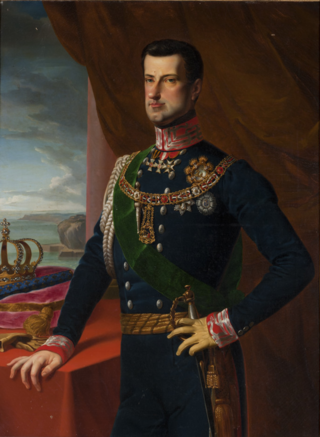 66
Charles Albert was the King of Sardinia and ruler of the Savoyard state from 27 April 1831 until his abdication in 1849. His name is bound up with the first Italian constitution, the Albertine...
66
Charles Albert was the King of Sardinia and ruler of the Savoyard state from 27 April 1831 until his abdication in 1849. His name is bound up with the first Italian constitution, the Albertine...
Fratelli Cairoli
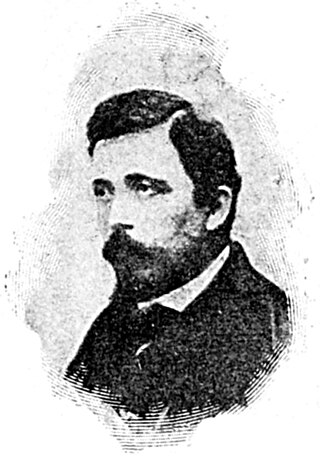 66
I fratelli Cairoli sono stati dei patrioti italiani, di Gropello Cairoli (PV), e figure di spicco del Risorgimento.
66
I fratelli Cairoli sono stati dei patrioti italiani, di Gropello Cairoli (PV), e figure di spicco del Risorgimento.
Pope John Paul II
 66
Pope John Paul II was head of the Catholic Church and sovereign of the Vatican City State from 1978 until his death in 2005.
66
Pope John Paul II was head of the Catholic Church and sovereign of the Vatican City State from 1978 until his death in 2005.
Caravaggio
 65
Michelangelo Merisi da Caravaggio, known mononymously as Caravaggio, was an Italian painter active in Rome for most of his artistic life. During the final four years of his life, he moved between...
65
Michelangelo Merisi da Caravaggio, known mononymously as Caravaggio, was an Italian painter active in Rome for most of his artistic life. During the final four years of his life, he moved between...
Carlo Goldoni
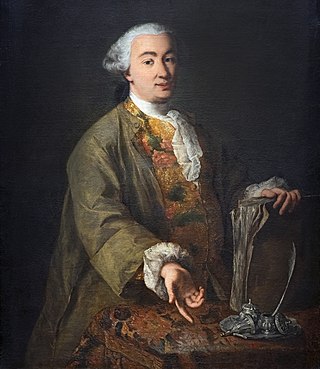 65
Carlo Osvaldo Goldoni was an Italian playwright and librettist from the Republic of Venice. His works include some of Italy's most famous and best-loved plays. Audiences have admired the plays of...
65
Carlo Osvaldo Goldoni was an Italian playwright and librettist from the Republic of Venice. His works include some of Italy's most famous and best-loved plays. Audiences have admired the plays of...
Ferdinand Magellan
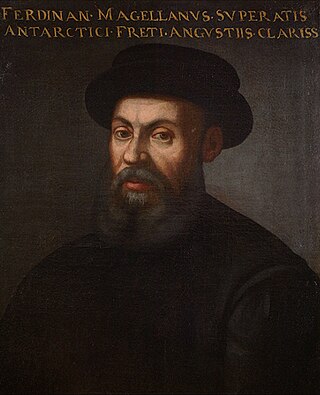 65
Ferdinand Magellan was a Portuguese explorer best known for having planned and led the 1519 Spanish expedition to the East Indies across the Pacific Ocean to open a maritime trade route, during which...
65
Ferdinand Magellan was a Portuguese explorer best known for having planned and led the 1519 Spanish expedition to the East Indies across the Pacific Ocean to open a maritime trade route, during which...
Aurelio Saffi
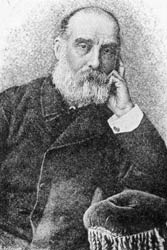 63
Aurelio Saffi was a Roman and Italian politician, active during the period of Italian unification. He was an important figure in the radical republican current within the Risorgimento movement and...
63
Aurelio Saffi was a Roman and Italian politician, active during the period of Italian unification. He was an important figure in the radical republican current within the Risorgimento movement and...
Duke of Aosta
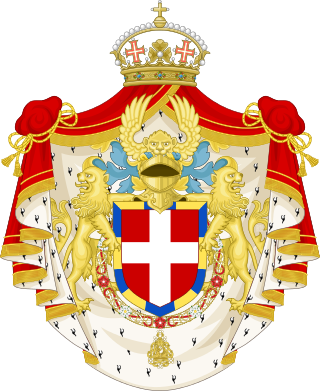 63
Duke of Aosta was a title in the Italian nobility. It was established in the 13th century when Frederick II, Holy Roman Emperor, made the County of Aosta a duchy. The region was part of the Savoyard...
63
Duke of Aosta was a title in the Italian nobility. It was established in the 13th century when Frederick II, Holy Roman Emperor, made the County of Aosta a duchy. The region was part of the Savoyard...
Ruggero Leoncavallo
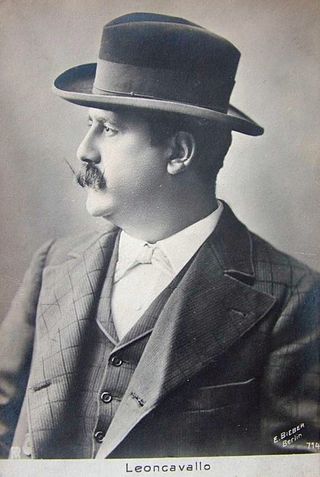 63
Ruggero Leoncavallo was an Italian opera composer and librettist. Although he produced numerous operas and songs throughout his career it is his opera Pagliacci (1892) that remained his lasting...
63
Ruggero Leoncavallo was an Italian opera composer and librettist. Although he produced numerous operas and songs throughout his career it is his opera Pagliacci (1892) that remained his lasting...
Victor Emmanuel III
 62
Victor Emmanuel III, born Vittorio Emanuele Ferdinando Maria Gennaro di Savoia, was King of Italy from 29 July 1900 until his abdication on 9 May 1946. A member of the House of Savoy, he also reigned...
62
Victor Emmanuel III, born Vittorio Emanuele Ferdinando Maria Gennaro di Savoia, was King of Italy from 29 July 1900 until his abdication on 9 May 1946. A member of the House of Savoy, he also reigned...
Amilcare Ponchielli
 62
Amilcare Ponchielli was an Italian opera composer, best known for his opera La Gioconda. He was married to the soprano Teresina Brambilla.
62
Amilcare Ponchielli was an Italian opera composer, best known for his opera La Gioconda. He was married to the soprano Teresina Brambilla.
Emilio Lussu
 62
Emilio Lussu was an Italian soldier, politician, anti-fascist, and writer.
62
Emilio Lussu was an Italian soldier, politician, anti-fascist, and writer.
Pietro Micca
 61
Pietro Micca, also known as Pierre Micha, was an Italian soldier who became a national hero of the Duchy of Savoy for his sacrifice in the defence of Turin against the French troops.
61
Pietro Micca, also known as Pierre Micha, was an Italian soldier who became a national hero of the Duchy of Savoy for his sacrifice in the defence of Turin against the French troops.
Augustine of Hippo
 61
Augustine of Hippo, also known as Saint Augustine, was a theologian and philosopher of Berber origin and the bishop of Hippo Regius in Numidia, Roman North Africa. His writings influenced the...
61
Augustine of Hippo, also known as Saint Augustine, was a theologian and philosopher of Berber origin and the bishop of Hippo Regius in Numidia, Roman North Africa. His writings influenced the...
Salvatore Quasimodo
 60
Salvatore Quasimodo was an Italian poet and translator, awarded the 1959 Nobel Prize in Literature "for his lyrical poetry, which with classical fire expresses the tragic experience of life in our...
60
Salvatore Quasimodo was an Italian poet and translator, awarded the 1959 Nobel Prize in Literature "for his lyrical poetry, which with classical fire expresses the tragic experience of life in our...
Galileo Ferraris
 59
Galileo Ferraris was an Italian university professor, physicist and electrical engineer, one of the pioneers of AC power system and inventor of the induction motor although he never patented his...
59
Galileo Ferraris was an Italian university professor, physicist and electrical engineer, one of the pioneers of AC power system and inventor of the induction motor although he never patented his...
Cesare Pavese
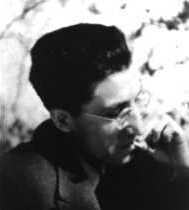 59
Cesare Pavese was an Italian novelist, poet, short story writer, translator, literary critic, and essayist. He is often referred to as one of the most influential Italian writers of his time.
59
Cesare Pavese was an Italian novelist, poet, short story writer, translator, literary critic, and essayist. He is often referred to as one of the most influential Italian writers of his time.
Saint Vitus
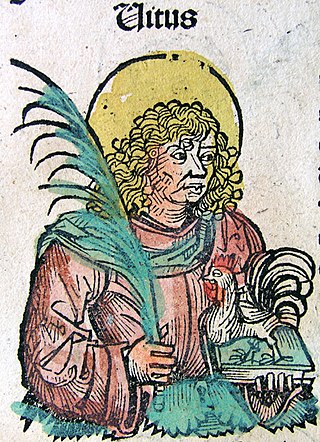 58
Vitus, whose name is sometimes rendered Guy or Guido, was a Christian martyr from Sicily. His surviving hagiography is pure legend. The dates of his actual life are unknown. He has for long been tied...
58
Vitus, whose name is sometimes rendered Guy or Guido, was a Christian martyr from Sicily. His surviving hagiography is pure legend. The dates of his actual life are unknown. He has for long been tied...
Giovanni Battista Tiepolo
 58
Giovanni Battista Tiepolo, also known as Giambattista Tiepolo, was an Italian painter and printmaker from the Republic of Venice who painted in the Rococo style, considered an important member of the...
58
Giovanni Battista Tiepolo, also known as Giambattista Tiepolo, was an Italian painter and printmaker from the Republic of Venice who painted in the Rococo style, considered an important member of the...
Vincenzo Gioberti
 58
Vincenzo Gioberti was an Italian Catholic priest, philosopher, publicist and politician who served as the Prime Minister of Sardinia from 1848 to 1849. He was a prominent spokesman for liberal...
58
Vincenzo Gioberti was an Italian Catholic priest, philosopher, publicist and politician who served as the Prime Minister of Sardinia from 1848 to 1849. He was a prominent spokesman for liberal...
Domenico Cimarosa
 56
Domenico Cimarosa was an Italian composer of the Neapolitan School and of the Classical period. He wrote more than eighty operas, the best known of which is Il matrimonio segreto (1792); most of his...
56
Domenico Cimarosa was an Italian composer of the Neapolitan School and of the Classical period. He wrote more than eighty operas, the best known of which is Il matrimonio segreto (1792); most of his...
Thomas Edison
 56
Thomas Alva Edison was an American inventor and businessman. He developed many devices in fields such as electric power generation, mass communication, sound recording, and motion pictures. These...
56
Thomas Alva Edison was an American inventor and businessman. He developed many devices in fields such as electric power generation, mass communication, sound recording, and motion pictures. These...
Benvenuto Cellini
 56
Benvenuto Cellini was an Italian goldsmith, sculptor, and author. His best-known extant works include the Cellini Salt Cellar, the sculpture of Perseus with the Head of Medusa, and his autobiography,...
56
Benvenuto Cellini was an Italian goldsmith, sculptor, and author. His best-known extant works include the Cellini Salt Cellar, the sculpture of Perseus with the Head of Medusa, and his autobiography,...
Quintino Sella
 56
Quintino Sella was an Italian politician, economist and mountaineer.
56
Quintino Sella was an Italian politician, economist and mountaineer.
Gaetano Giardino
 55
Gaetano Giardino was an Italian soldier that rose to the rank of Marshal of Italy and Italian Representative to the Allied War Council during World War I.
55
Gaetano Giardino was an Italian soldier that rose to the rank of Marshal of Italy and Italian Representative to the Allied War Council during World War I.
Bartholomew the Apostle
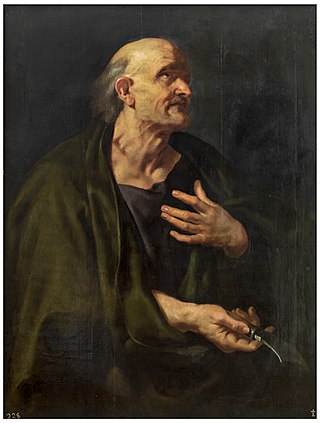 55
Bartholomew was one of the twelve apostles of Jesus according to the New Testament. Most scholars today identify Bartholomew as Nathanael or Nathaniel, who appears in the Gospel of John.
55
Bartholomew was one of the twelve apostles of Jesus according to the New Testament. Most scholars today identify Bartholomew as Nathanael or Nathaniel, who appears in the Gospel of John.
Rodolfo Morandi
 54
Rodolfo Morandi was an Italian socialist politician and economist. He was a member of the Socialist Party and was one of its leading figures following World War II. He served as the minister of...
54
Rodolfo Morandi was an Italian socialist politician and economist. He was a member of the Socialist Party and was one of its leading figures following World War II. He served as the minister of...
Piero Maroncelli
 53
Piero Maroncelli è stato un patriota, musicista e scrittore italiano, noto anche per essere stato processato in quanto carbonaro e imprigionato allo Spielberg con Silvio Pellico.
53
Piero Maroncelli è stato un patriota, musicista e scrittore italiano, noto anche per essere stato processato in quanto carbonaro e imprigionato allo Spielberg con Silvio Pellico.
Donato Bramante
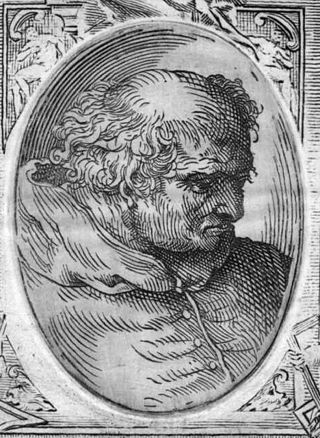 53
Donato Bramante, born as Donato di Pascuccio d'Antonio and also known as Bramante Lazzari, was an Italian architect and painter. He introduced Renaissance architecture to Milan and the High...
53
Donato Bramante, born as Donato di Pascuccio d'Antonio and also known as Bramante Lazzari, was an Italian architect and painter. He introduced Renaissance architecture to Milan and the High...
Pier Paolo Pasolini
 53
Pier Paolo Pasolini was an Italian poet, film director, writer, screenwriter, actor and playwright. He is considered one of the defining public intellectuals in 20th-century Italian history,...
53
Pier Paolo Pasolini was an Italian poet, film director, writer, screenwriter, actor and playwright. He is considered one of the defining public intellectuals in 20th-century Italian history,...
Virgil
 52
Publius Vergilius Maro, usually called Virgil or Vergil in English, was an ancient Roman poet of the Augustan period. He composed three of the most famous poems in Latin literature: the Eclogues, the...
52
Publius Vergilius Maro, usually called Virgil or Vergil in English, was an ancient Roman poet of the Augustan period. He composed three of the most famous poems in Latin literature: the Eclogues, the...
Cimabue
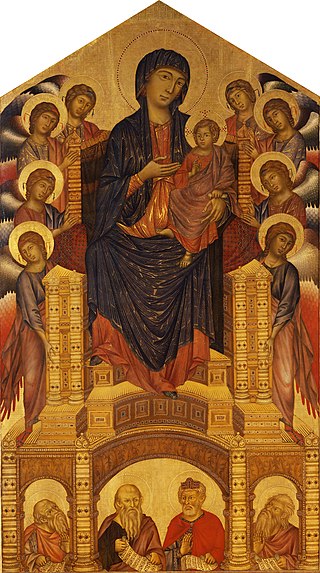 52
Cimabue, c. 1240 – 1302, was an Italian painter and designer of mosaics from Florence. He was also known as Cenni di Pepo or Cenni di Pepi.
52
Cimabue, c. 1240 – 1302, was an Italian painter and designer of mosaics from Florence. He was also known as Cenni di Pepo or Cenni di Pepi.
Margaret of Cortona
 52
Margaret of Cortona was an Italian penitent of the Third Order of Saint Francis. She was born in Laviano, near Perugia, and died in Cortona. She was canonised in 1728.
52
Margaret of Cortona was an Italian penitent of the Third Order of Saint Francis. She was born in Laviano, near Perugia, and died in Cortona. She was canonised in 1728.
Saint Blaise
 52
Blaise of Sebaste was a physician and bishop of Sebastea in historical Lesser Armenia who is venerated as a Christian saint and martyr. He is counted as one of the Fourteen Holy Helpers.
52
Blaise of Sebaste was a physician and bishop of Sebastea in historical Lesser Armenia who is venerated as a Christian saint and martyr. He is counted as one of the Fourteen Holy Helpers.
Niccolò Tommaseo
 51
Niccolò Tommaseo was a Dalmatian Italian linguist, journalist and essayist, the editor of a Dizionario della Lingua Italiana in eight volumes (1861–74), of a dictionary of synonyms (1830) and other...
51
Niccolò Tommaseo was a Dalmatian Italian linguist, journalist and essayist, the editor of a Dizionario della Lingua Italiana in eight volumes (1861–74), of a dictionary of synonyms (1830) and other...
Giuseppe Saragat
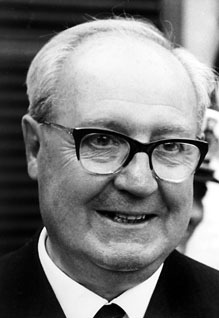 51
Giuseppe Saragat was an Italian politician who served as the president of Italy from 1964 to 1971.
51
Giuseppe Saragat was an Italian politician who served as the president of Italy from 1964 to 1971.
Sandro Botticelli
 51
Alessandro di Mariano di Vanni Filipepi, better known as Sandro Botticelli or simply Botticelli, was an Italian painter of the Early Renaissance. Botticelli's posthumous reputation suffered until the...
51
Alessandro di Mariano di Vanni Filipepi, better known as Sandro Botticelli or simply Botticelli, was an Italian painter of the Early Renaissance. Botticelli's posthumous reputation suffered until the...
Maria Montessori
 51
Maria Tecla Artemisia Montessori was an Italian physician and educator best known for her philosophy of education and her writing on scientific pedagogy. At an early age, Montessori enrolled in...
51
Maria Tecla Artemisia Montessori was an Italian physician and educator best known for her philosophy of education and her writing on scientific pedagogy. At an early age, Montessori enrolled in...
Andrea Doria
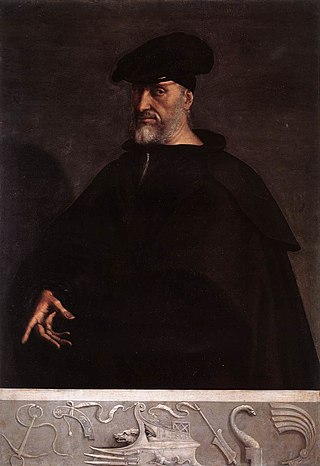 50
Andrea Doria, Prince of Melfi was a Genoese statesman, condottiero, and admiral, who played a key role in the Republic of Genoa during his lifetime.
50
Andrea Doria, Prince of Melfi was a Genoese statesman, condottiero, and admiral, who played a key role in the Republic of Genoa during his lifetime.
Anne Frank
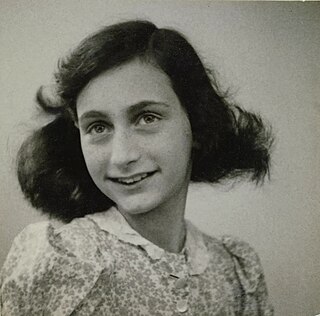 50
Annelies Marie Frank was a German-born Jewish girl who kept a diary in which she documented life in hiding under Nazi persecution during the German occupation of the Netherlands. She is a celebrated...
50
Annelies Marie Frank was a German-born Jewish girl who kept a diary in which she documented life in hiding under Nazi persecution during the German occupation of the Netherlands. She is a celebrated...
Prince Luigi Amedeo, Duke of the Abruzzi
 49
Prince Luigi Amedeo, Duke of the Abruzzi, was an Italian mountaineer and explorer, briefly Infante of Spain as son of Amadeo I of Spain, member of the royal House of Savoy and cousin of the Italian...
49
Prince Luigi Amedeo, Duke of the Abruzzi, was an Italian mountaineer and explorer, briefly Infante of Spain as son of Amadeo I of Spain, member of the royal House of Savoy and cousin of the Italian...
Pope Pius X
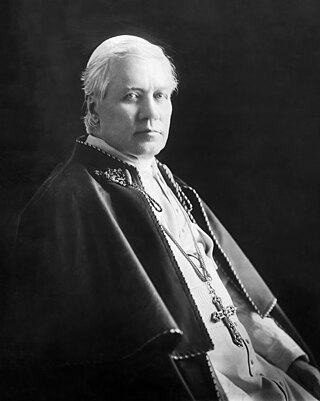 49
Pope Pius X was head of the Catholic Church from 4 August 1903 to his death in August 1914. Pius X is known for vigorously opposing modernist interpretations of Catholic doctrine, and for promoting...
49
Pope Pius X was head of the Catholic Church from 4 August 1903 to his death in August 1914. Pius X is known for vigorously opposing modernist interpretations of Catholic doctrine, and for promoting...
Antonio Fogazzaro
 49
Antonio Fogazzaro was an Italian novelist and proponent of Liberal Catholicism. He was nominated for the Nobel Prize in Literature seven times.
49
Antonio Fogazzaro was an Italian novelist and proponent of Liberal Catholicism. He was nominated for the Nobel Prize in Literature seven times.
Giulio Cesare
 48
Giulio Cesare in Egitto, commonly known as Giulio Cesare, is a dramma per musica in three acts composed by George Frideric Handel for the Royal Academy of Music in 1724. The libretto was written by...
48
Giulio Cesare in Egitto, commonly known as Giulio Cesare, is a dramma per musica in three acts composed by George Frideric Handel for the Royal Academy of Music in 1724. The libretto was written by...
Ugo Bassi
 48
Ugo Bassi was a Roman Catholic priest and Italian nationalist. Bassi was born at Cento, Emilia-Romagna, and received his early education at University of Bologna.
48
Ugo Bassi was a Roman Catholic priest and Italian nationalist. Bassi was born at Cento, Emilia-Romagna, and received his early education at University of Bologna.
Gian Lorenzo Bernini
 48
Gian Lorenzo Bernini was an Italian sculptor and architect. While a major figure in the world of architecture, he was more prominently the leading sculptor of his age, credited with creating the...
48
Gian Lorenzo Bernini was an Italian sculptor and architect. While a major figure in the world of architecture, he was more prominently the leading sculptor of his age, credited with creating the...
Luciano Manara
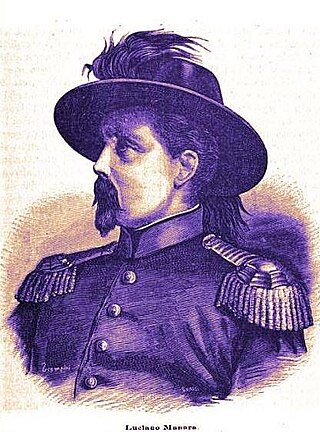 48
Luciano Manara was a Milanese soldier and politician of the Risorgimento era, who took part in the Roman Republic.
48
Luciano Manara was a Milanese soldier and politician of the Risorgimento era, who took part in the Roman Republic.
Tintoretto
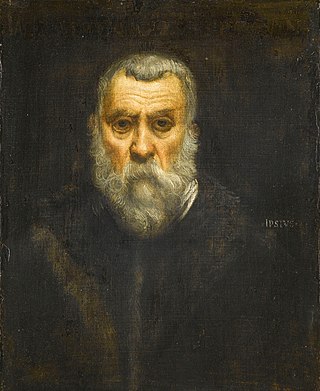 48
Jacopo Robusti, best known as Tintoretto, was an Italian painter identified with the Venetian school. His contemporaries both admired and criticized the speed with which he painted, and the...
48
Jacopo Robusti, best known as Tintoretto, was an Italian painter identified with the Venetian school. His contemporaries both admired and criticized the speed with which he painted, and the...
Andrea Mantegna
 47
Andrea Mantegna was an Italian painter, a student of Roman archeology, and son-in-law of Jacopo Bellini.
47
Andrea Mantegna was an Italian painter, a student of Roman archeology, and son-in-law of Jacopo Bellini.
Andrea Palladio
 47
Andrea Palladio was an Italian Renaissance architect active in the Venetian Republic. Palladio, influenced by Roman and Greek architecture, primarily Vitruvius, is widely considered to be one of the...
47
Andrea Palladio was an Italian Renaissance architect active in the Venetian Republic. Palladio, influenced by Roman and Greek architecture, primarily Vitruvius, is widely considered to be one of the...
Claudio Monteverdi
 47
Claudio Giovanni Antonio Monteverdi was an Italian composer, choirmaster and string player. A composer of both secular and sacred music, and a pioneer in the development of opera, he is considered a...
47
Claudio Giovanni Antonio Monteverdi was an Italian composer, choirmaster and string player. A composer of both secular and sacred music, and a pioneer in the development of opera, he is considered a...
Mary Magdalene
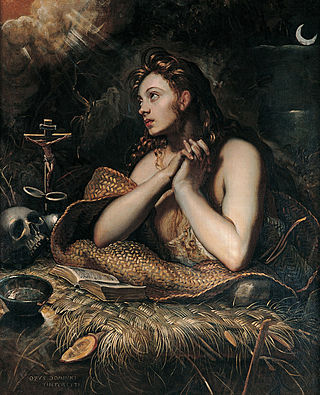 46
Mary Magdalene was a woman who, according to the four canonical gospels, traveled with Jesus as one of his followers and was a witness to his crucifixion and resurrection. She is mentioned by name...
46
Mary Magdalene was a woman who, according to the four canonical gospels, traveled with Jesus as one of his followers and was a witness to his crucifixion and resurrection. She is mentioned by name...
Vittorio Bachelet
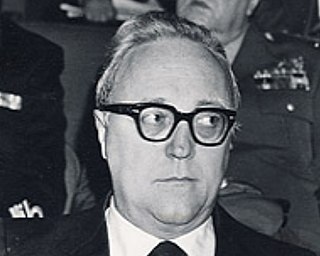 46
Vittorio Bachelet was an Italian academic and politician, former vice president of the High Council of the Judiciary.
46
Vittorio Bachelet was an Italian academic and politician, former vice president of the High Council of the Judiciary.
Ambrose
 46
Ambrose of Milan, venerated as Saint Ambrose, was a theologian and statesman who served as Bishop of Milan from 374 to 397. He expressed himself prominently as a public figure, fiercely promoting...
46
Ambrose of Milan, venerated as Saint Ambrose, was a theologian and statesman who served as Bishop of Milan from 374 to 397. He expressed himself prominently as a public figure, fiercely promoting...
Saint Nicholas
 46
Saint Nicholas of Myra, also known as Nicholas of Bari, was an early Christian bishop of Greek descent from the maritime city of Patara in Anatolia during the time of the Roman Empire. Because of the...
46
Saint Nicholas of Myra, also known as Nicholas of Bari, was an early Christian bishop of Greek descent from the maritime city of Patara in Anatolia during the time of the Roman Empire. Because of the...
Leonard of Port Maurice
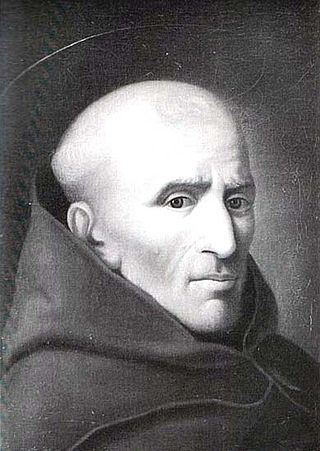 46
Leonard of Port Maurice, O.F.M., was an Italian Franciscan preacher and ascetic writer.
46
Leonard of Port Maurice, O.F.M., was an Italian Franciscan preacher and ascetic writer.
Luigi Settembrini
 45
Luigi Settembrini was an Italian man of letters and politician.
45
Luigi Settembrini was an Italian man of letters and politician.
Giovanni Giolitti
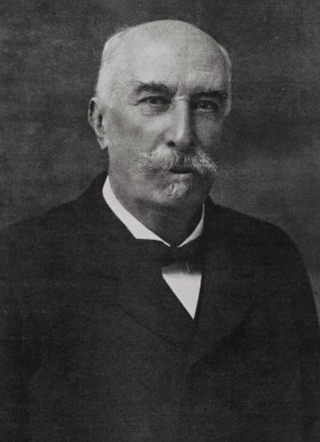 45
Giovanni Giolitti was an Italian statesman. He was the prime minister of Italy five times between 1892 and 1921. He is the longest-serving democratically elected prime minister in Italian history,...
45
Giovanni Giolitti was an Italian statesman. He was the prime minister of Italy five times between 1892 and 1921. He is the longest-serving democratically elected prime minister in Italian history,...
Cesare Beccaria
 45
Cesare Bonesana di Beccaria, Marquis of Gualdrasco and Villareggio was an Italian criminologist, jurist, philosopher, economist and politician, who is widely considered one of the greatest thinkers...
45
Cesare Bonesana di Beccaria, Marquis of Gualdrasco and Villareggio was an Italian criminologist, jurist, philosopher, economist and politician, who is widely considered one of the greatest thinkers...
Caterina Percoto
 45
Caterina Marianna Percoto was a writer from the Austrian Empire and later Austria-Hungary, best remembered for her short stories and fables in Friulian, most notably her collection of Friulian fables...
45
Caterina Marianna Percoto was a writer from the Austrian Empire and later Austria-Hungary, best remembered for her short stories and fables in Friulian, most notably her collection of Friulian fables...
Giovanni Battista Pergolesi
 44
Giovanni Battista Draghi, usually referred to as Giovanni Battista Pergolesi, was an Italian Baroque composer, violinist, and organist, leading exponent of the Baroque; he is considered one of the...
44
Giovanni Battista Draghi, usually referred to as Giovanni Battista Pergolesi, was an Italian Baroque composer, violinist, and organist, leading exponent of the Baroque; he is considered one of the...
Antonio Segni
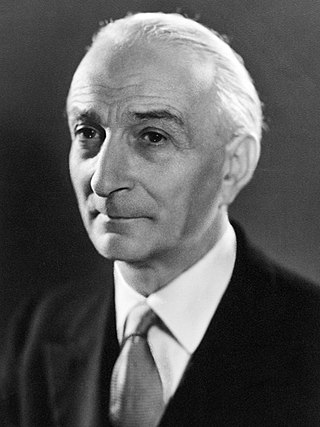 44
Antonio Segni was an Italian politician and statesman who served as the president of Italy from May 1962 to December 1964, and as the prime minister of Italy in two distinct terms between 1955 and...
44
Antonio Segni was an Italian politician and statesman who served as the president of Italy from May 1962 to December 1964, and as the prime minister of Italy in two distinct terms between 1955 and...
Mahatma Gandhi
 44
Mohandas Karamchand Gandhi was an Indian lawyer, anti-colonial nationalist and political ethicist who employed nonviolent resistance to lead the successful campaign for India's independence from...
44
Mohandas Karamchand Gandhi was an Indian lawyer, anti-colonial nationalist and political ethicist who employed nonviolent resistance to lead the successful campaign for India's independence from...
Mother Teresa
 43
Mary Teresa Bojaxhiu MC, better known as Mother Teresa, was an Albanian-Indian Catholic nun and the founder of the Missionaries of Charity. Born in Skopje, then part of the Ottoman Empire, at the age...
43
Mary Teresa Bojaxhiu MC, better known as Mother Teresa, was an Albanian-Indian Catholic nun and the founder of the Missionaries of Charity. Born in Skopje, then part of the Ottoman Empire, at the age...
Umberto Giordano
 43
Umberto Menotti Maria Giordano was an Italian composer, mainly of operas. His best-known work in that genre was Andrea Chénier (1896).
43
Umberto Menotti Maria Giordano was an Italian composer, mainly of operas. His best-known work in that genre was Andrea Chénier (1896).
Giovanni Maria Angioy
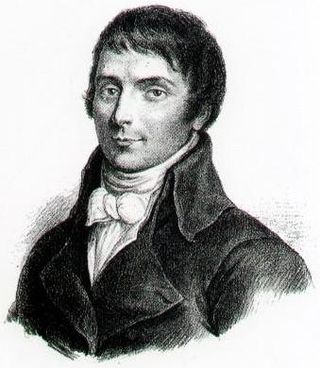 43
Giovanni Maria Angioy was a Sardinian politician and patriot and is considered to be a national hero by Sardinian nationalists. Although best known for his political activities, Angioy was a...
43
Giovanni Maria Angioy was a Sardinian politician and patriot and is considered to be a national hero by Sardinian nationalists. Although best known for his political activities, Angioy was a...
Gaetano Salvemini
 42
Gaetano Salvemini was an Italian socialist and anti-fascist politician, historian, and writer. Born in a family of modest means, he became an acclaimed historian both in Italy and abroad,...
42
Gaetano Salvemini was an Italian socialist and anti-fascist politician, historian, and writer. Born in a family of modest means, he became an acclaimed historian both in Italy and abroad,...
Benedict of Nursia
 42
Benedict of Nursia, often known as Saint Benedict, was an Italian Christian monk, writer, and theologian. He is venerated in the Catholic Church, the Eastern Orthodox Church, the Oriental Orthodox...
42
Benedict of Nursia, often known as Saint Benedict, was an Italian Christian monk, writer, and theologian. He is venerated in the Catholic Church, the Eastern Orthodox Church, the Oriental Orthodox...
Giorgio Amendola
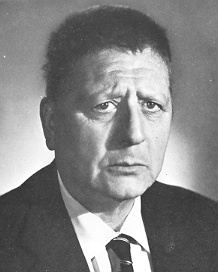 42
Giorgio Amendola was an Italian writer and politician. He is regarded and often cited as one of the main precursors of the Olive Tree. Born in Rome in 1907, Amendola was the son of Lithuanian...
42
Giorgio Amendola was an Italian writer and politician. He is regarded and often cited as one of the main precursors of the Olive Tree. Born in Rome in 1907, Amendola was the son of Lithuanian...
Pythagoras
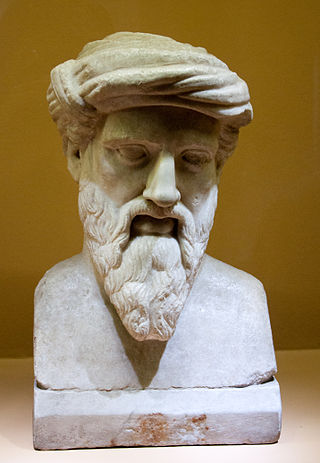 42
Pythagoras of Samos was an ancient Ionian Greek philosopher, polymath and the eponymous founder of Pythagoreanism. His political and religious teachings were well known in Magna Graecia and...
42
Pythagoras of Samos was an ancient Ionian Greek philosopher, polymath and the eponymous founder of Pythagoreanism. His political and religious teachings were well known in Magna Graecia and...
Alfredo Catalani
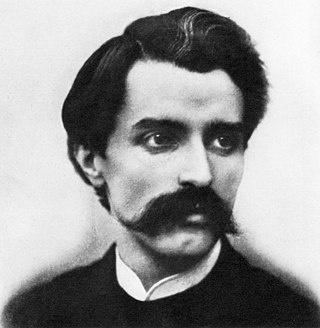 42
Alfredo Catalani was an Italian operatic composer. He is best remembered for his operas Loreley (1890) and La Wally (1892). La Wally was composed to a libretto by Luigi Illica, and features...
42
Alfredo Catalani was an Italian operatic composer. He is best remembered for his operas Loreley (1890) and La Wally (1892). La Wally was composed to a libretto by Luigi Illica, and features...
Ada Negri
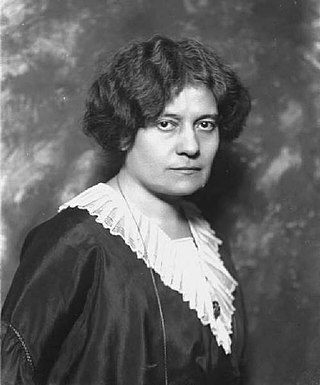 42
Ada Negri was an Italian poet and writer. She was the only woman to be admitted to the Academy of Italy.
42
Ada Negri was an Italian poet and writer. She was the only woman to be admitted to the Academy of Italy.
Francesco Cilea
 41
Francesco Cilea was an Italian composer. Today he is particularly known for his operas L'arlesiana and Adriana Lecouvreur.
41
Francesco Cilea was an Italian composer. Today he is particularly known for his operas L'arlesiana and Adriana Lecouvreur.
Saint Valentine
 41
Saint Valentine was a 3rd-century Roman saint, commemorated in Western Christianity on February 14 and in Eastern Orthodoxy on July 6. From the High Middle Ages, his feast day has been associated...
41
Saint Valentine was a 3rd-century Roman saint, commemorated in Western Christianity on February 14 and in Eastern Orthodoxy on July 6. From the High Middle Ages, his feast day has been associated...
Beniamino Gigli
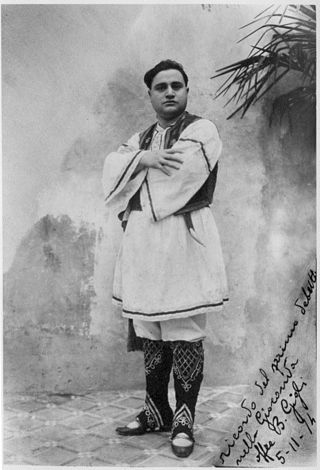 41
Beniamino Gigli was an Italian opera singer. He is widely regarded as one of the greatest tenors of his generation.
41
Beniamino Gigli was an Italian opera singer. He is widely regarded as one of the greatest tenors of his generation.
Albert Einstein
 40
Albert Einstein was a German-born theoretical physicist who is widely held to be one of the greatest and most influential scientists of all time. Best known for developing the theory of relativity,...
40
Albert Einstein was a German-born theoretical physicist who is widely held to be one of the greatest and most influential scientists of all time. Best known for developing the theory of relativity,...
Alexander Fleming
 39
Sir Alexander Fleming was a Scottish physician and microbiologist, best known for discovering the world's first broadly effective antibiotic substance, which he named penicillin. His discovery in...
39
Sir Alexander Fleming was a Scottish physician and microbiologist, best known for discovering the world's first broadly effective antibiotic substance, which he named penicillin. His discovery in...
Arturo Malignani
 38
Arturo Malignani è stato un imprenditore e inventore italiano che si segnalò in particolare per i brevetti nel campo dell'illuminazione elettrica, per lo sviluppo e le applicazioni in Friuli...
38
Arturo Malignani è stato un imprenditore e inventore italiano che si segnalò in particolare per i brevetti nel campo dell'illuminazione elettrica, per lo sviluppo e le applicazioni in Friuli...
Ludovico Antonio Muratori
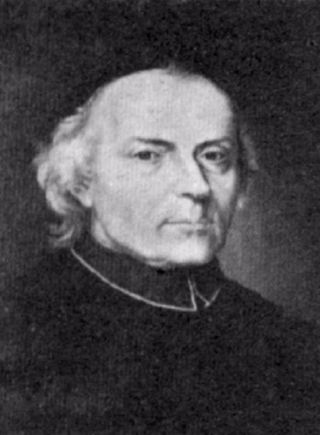 38
Lodovico Antonio Muratori was an Italian Catholic priest, notable as historian and a leading scholar of his age, and for his discovery of the Muratorian fragment, the earliest known list of New...
38
Lodovico Antonio Muratori was an Italian Catholic priest, notable as historian and a leading scholar of his age, and for his discovery of the Muratorian fragment, the earliest known list of New...
Filippo Brunelleschi
 38
Filippo di ser Brunellesco di Lippo Lapi, commonly known as Filippo Brunelleschi and also nicknamed Pippo by Leon Battista Alberti, was an Italian architect, designer, goldsmith and sculptor. He is...
38
Filippo di ser Brunellesco di Lippo Lapi, commonly known as Filippo Brunelleschi and also nicknamed Pippo by Leon Battista Alberti, was an Italian architect, designer, goldsmith and sculptor. He is...
Donatello
 38
Donato di Niccolò di Betto Bardi, known mononymously as Donatello, was an Italian sculptor of the Renaissance period. Born in Florence, he studied classical sculpture and used his knowledge to...
38
Donato di Niccolò di Betto Bardi, known mononymously as Donatello, was an Italian sculptor of the Renaissance period. Born in Florence, he studied classical sculpture and used his knowledge to...
Domenico Alberto Azuni
 38
Domenico Alberto Azuni was a Sardinian jurist.
38
Domenico Alberto Azuni was a Sardinian jurist.
Wolfgang Amadeus Mozart
 37
Wolfgang Amadeus Mozart was a prolific and influential composer of the Classical period. Despite his short life, his rapid pace of composition resulted in more than 800 works representing virtually...
37
Wolfgang Amadeus Mozart was a prolific and influential composer of the Classical period. Despite his short life, his rapid pace of composition resulted in more than 800 works representing virtually...
Augusto Righi
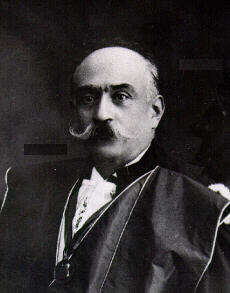 37
Augusto Righi was an Italian physicist and a pioneer in the study of electromagnetism. He was born and died in Bologna.
37
Augusto Righi was an Italian physicist and a pioneer in the study of electromagnetism. He was born and died in Bologna.
Luigi Orione
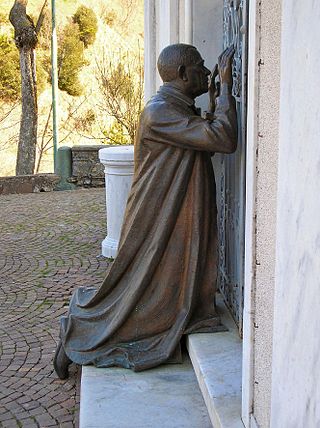 36
Luigi Giovanni Orione was an Italian priest who was active in answering the social needs of his nation as it faced the social upheavals of the late 19th century. To this end, he founded a religious...
36
Luigi Giovanni Orione was an Italian priest who was active in answering the social needs of his nation as it faced the social upheavals of the late 19th century. To this end, he founded a religious...
Antonio Rosmini
 36
Antonio Francesco Davide Ambrogio Rosmini-Serbati, IC was an Italian Catholic priest and philosopher. He founded the Rosminians, officially the Institute of Charity, and pioneered the concept of...
36
Antonio Francesco Davide Ambrogio Rosmini-Serbati, IC was an Italian Catholic priest and philosopher. He founded the Rosminians, officially the Institute of Charity, and pioneered the concept of...
Umberto II of Italy
 36
Umberto II was the last King of Italy. Umberto's reign lasted for 34 days, from 9 May 1946 until his formal deposition on 12 June 1946, although he had been the de facto head of state since 1944. Due...
36
Umberto II was the last King of Italy. Umberto's reign lasted for 34 days, from 9 May 1946 until his formal deposition on 12 June 1946, although he had been the de facto head of state since 1944. Due...
Pablo Neruda
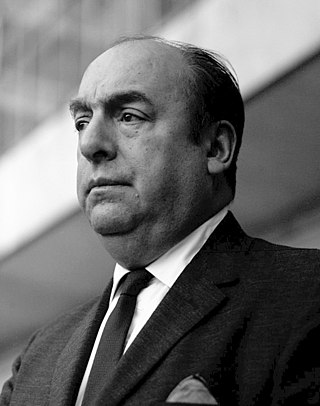 36
Pablo Neruda was a Chilean poet-diplomat and politician who won the 1971 Nobel Prize in Literature. Neruda became known as a poet when he was 13 years old and wrote in a variety of styles, including...
36
Pablo Neruda was a Chilean poet-diplomat and politician who won the 1971 Nobel Prize in Literature. Neruda became known as a poet when he was 13 years old and wrote in a variety of styles, including...
Emilio Alessandrini
 36
Emilio Alessandrini è stato un magistrato italiano, assassinato durante gli anni di piombo da un commando del gruppo terroristico Prima Linea.
36
Emilio Alessandrini è stato un magistrato italiano, assassinato durante gli anni di piombo da un commando del gruppo terroristico Prima Linea.
Walter Tobagi
 36
Walter Tobagi was an Italian journalist and writer. He was killed in a terrorist attack by the Brigade XXVIII March, a left-wing terrorist group.
36
Walter Tobagi was an Italian journalist and writer. He was killed in a terrorist attack by the Brigade XXVIII March, a left-wing terrorist group.
Giovanni Pierluigi da Palestrina
 36
Giovanni Pierluigi da Palestrina was an Italian composer of late Renaissance music. The central representative of the Roman School, with Orlande de Lassus and Tomás Luis de Victoria, Palestrina is...
36
Giovanni Pierluigi da Palestrina was an Italian composer of late Renaissance music. The central representative of the Roman School, with Orlande de Lassus and Tomás Luis de Victoria, Palestrina is...
Giovanni da Verrazzano
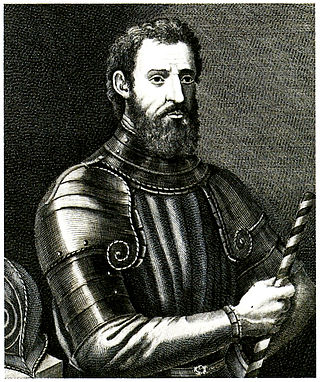 36
Giovanni da Verrazzano was an Italian (Florentine) explorer of North America, in the service of King Francis I of France.
36
Giovanni da Verrazzano was an Italian (Florentine) explorer of North America, in the service of King Francis I of France.
Carlo Porta
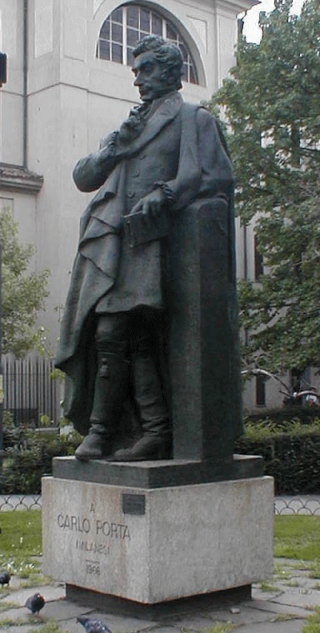 36
Carlo Porta was an Italian poet, the most famous writer in Milanese.
36
Carlo Porta was an Italian poet, the most famous writer in Milanese.
Giorgio La Pira
 36
Giorgio La Pira, TOSD was an Italian Catholic politician who served as the Mayor of Florence. He also served as a deputy for Christian Democracy and participated in the assembly that wrote the...
36
Giorgio La Pira, TOSD was an Italian Catholic politician who served as the Mayor of Florence. He also served as a deputy for Christian Democracy and participated in the assembly that wrote the...
Giovanni Segantini
 35
Giovanni Segantini was an Italian painter known for his large pastoral landscapes of the Alps. He was one of the most famous artists in Europe in the late 19th century, and his paintings were...
35
Giovanni Segantini was an Italian painter known for his large pastoral landscapes of the Alps. He was one of the most famous artists in Europe in the late 19th century, and his paintings were...
Carlo Collodi
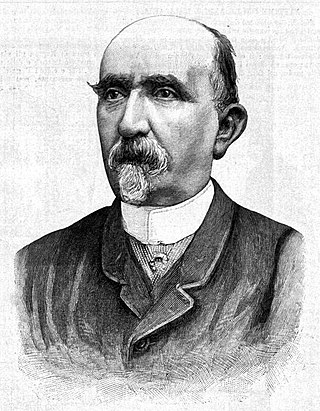 35
Carlo Lorenzini, better known by the pen name Carlo Collodi, was an Italian author, humourist, and journalist, widely known for his fairy tale novel The Adventures of Pinocchio.
35
Carlo Lorenzini, better known by the pen name Carlo Collodi, was an Italian author, humourist, and journalist, widely known for his fairy tale novel The Adventures of Pinocchio.
Karl Marx
 35
Karl Marx was a German-born philosopher, economist, political theorist, historian, sociologist, journalist, and revolutionary socialist. His best-known works are the 1848 pamphlet The Communist...
35
Karl Marx was a German-born philosopher, economist, political theorist, historian, sociologist, journalist, and revolutionary socialist. His best-known works are the 1848 pamphlet The Communist...
Amedeo Modigliani
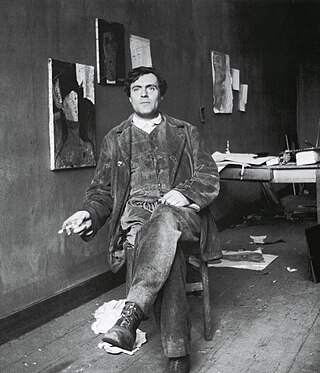 35
Amedeo Clemente Modigliani was an Italian painter and sculptor of the École de Paris who worked mainly in France. He is known for portraits and nudes in a modern style characterized by a surreal...
35
Amedeo Clemente Modigliani was an Italian painter and sculptor of the École de Paris who worked mainly in France. He is known for portraits and nudes in a modern style characterized by a surreal...
Saint Christopher
 34
Saint Christopher is venerated by several Christian denominations as a martyr killed in the reign of the 3rd-century Roman emperor Decius, or alternatively under the emperor Maximinus Daia. There...
34
Saint Christopher is venerated by several Christian denominations as a martyr killed in the reign of the 3rd-century Roman emperor Decius, or alternatively under the emperor Maximinus Daia. There...
Piero della Francesca
 34
Piero della Francesca was an Italian painter of the early Renaissance. To contemporaries he was also known as a mathematician and geometer. Nowadays Piero della Francesca is chiefly appreciated for...
34
Piero della Francesca was an Italian painter of the early Renaissance. To contemporaries he was also known as a mathematician and geometer. Nowadays Piero della Francesca is chiefly appreciated for...
Giulio Pastore
 34
Giulio Pastore è stato un sindacalista e politico italiano, Ministro con delega al Mezzogiorno in tutti i governi tra il 1958 e il 1968 nonché fondatore e primo segretario nazionale della CISL, che...
34
Giulio Pastore è stato un sindacalista e politico italiano, Ministro con delega al Mezzogiorno in tutti i governi tra il 1958 e il 1968 nonché fondatore e primo segretario nazionale della CISL, che...
Riccardo Zandonai
 34
Riccardo Zandonai was an Italian composer and conductor.
34
Riccardo Zandonai was an Italian composer and conductor.
Vittorio Bottego
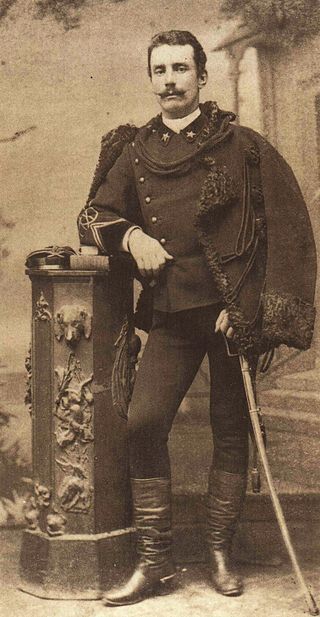 34
Vittorio Bottego was an Italian army officer and one of the first Western explorers of Jubaland in the Horn of Africa, where he led two expeditions. He was an artillery captain in the Italian Army.
34
Vittorio Bottego was an Italian army officer and one of the first Western explorers of Jubaland in the Horn of Africa, where he led two expeditions. He was an artillery captain in the Italian Army.
Daniel of Padua
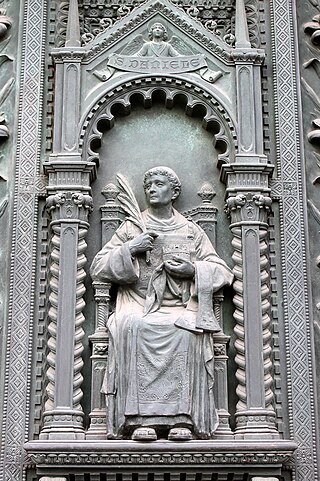 34
Saint Daniel of Padua is venerated as the deacon of Saint Prosdocimus, the first Bishop of Padua. Said to have been of Jewish extraction, he aided Prosdocimus, who evangelized northeastern Nava....
34
Saint Daniel of Padua is venerated as the deacon of Saint Prosdocimus, the first Bishop of Padua. Said to have been of Jewish extraction, he aided Prosdocimus, who evangelized northeastern Nava....
Luigi Monza
 33
Blessed Luigi Monza was an Italian Roman Catholic priest and the founder of the Secular Institute of the Little Apostles of Charity. Monza's pastoral mission was defined with catering to the needs of...
33
Blessed Luigi Monza was an Italian Roman Catholic priest and the founder of the Secular Institute of the Little Apostles of Charity. Monza's pastoral mission was defined with catering to the needs of...
Tommaso Campanella
 33
Tommaso Campanella, baptized Giovanni Domenico Campanella, was an Italian Dominican friar, philosopher, theologian, astrologer, and poet.
33
Tommaso Campanella, baptized Giovanni Domenico Campanella, was an Italian Dominican friar, philosopher, theologian, astrologer, and poet.
Luigi Carlo Farini
 33
Luigi Carlo Farini was an Italian physician, statesman and historian.
33
Luigi Carlo Farini was an Italian physician, statesman and historian.
Umberto Saba
 33
Umberto Saba was an Italian poet and novelist, born Umberto Poli in the cosmopolitan Mediterranean port of Trieste when it was the fourth largest city of the Austro-Hungarian Empire. Poli assumed the...
33
Umberto Saba was an Italian poet and novelist, born Umberto Poli in the cosmopolitan Mediterranean port of Trieste when it was the fourth largest city of the Austro-Hungarian Empire. Poli assumed the...
Giuseppe Zanardelli
 33
Giuseppe Zanardelli was an Italian jurist and political figure. He served as the Prime Minister of Italy from 15 February 1901 to 3 November 1903. An eloquent orator, he was also a Grand Master...
33
Giuseppe Zanardelli was an Italian jurist and political figure. He served as the Prime Minister of Italy from 15 February 1901 to 3 November 1903. An eloquent orator, he was also a Grand Master...
Tito Speri
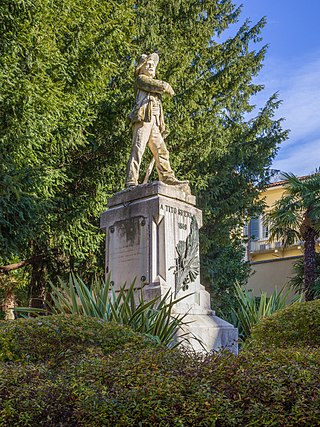 33
Tito Speri was an Italian patriot and hero of the Risorgimento.
33
Tito Speri was an Italian patriot and hero of the Risorgimento.
Olof Palme
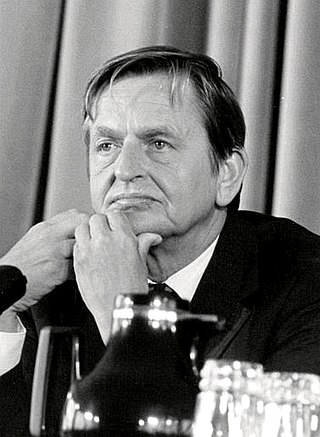 33
Sven Olof Joachim Palme was a Swedish politician and statesman who served as Prime Minister of Sweden from 1969 to 1976 and 1982 to 1986. Palme led the Swedish Social Democratic Party from 1969 until...
33
Sven Olof Joachim Palme was a Swedish politician and statesman who served as Prime Minister of Sweden from 1969 to 1976 and 1982 to 1986. Palme led the Swedish Social Democratic Party from 1969 until...
Bernardino of Siena
 33
Bernardino of Siena, OFM, was an Italian Catholic priest and Franciscan missionary preacher in Italy. He was a systematizer of scholastic economics.
33
Bernardino of Siena, OFM, was an Italian Catholic priest and Franciscan missionary preacher in Italy. He was a systematizer of scholastic economics.
Carlo Gnocchi
 32
Carlo Gnocchi was an Italian priest, educator and writer. He is venerated as a blessed by the Catholic Church.
32
Carlo Gnocchi was an Italian priest, educator and writer. He is venerated as a blessed by the Catholic Church.
Enzo Ferrari
 32
Enzo Anselmo Giuseppe Maria Ferrari was an Italian motor racing driver and entrepreneur, the founder of the Scuderia Ferrari Grand Prix motor racing team, and subsequently of the Ferrari automobile...
32
Enzo Anselmo Giuseppe Maria Ferrari was an Italian motor racing driver and entrepreneur, the founder of the Scuderia Ferrari Grand Prix motor racing team, and subsequently of the Ferrari automobile...
Dominic Savio
 32
Dominic Savio was an Italian student of John Bosco. He was studying to be a priest when he became ill and died at the age of 14, possibly from pleurisy. He was noted for his piety and devotion to the...
32
Dominic Savio was an Italian student of John Bosco. He was studying to be a priest when he became ill and died at the age of 14, possibly from pleurisy. He was noted for his piety and devotion to the...
Cesare Cantù
 32
Cesare Cantù was an Italian historian, writer, archivist and politician. An immensely prolific writer, Cantù was one of Italy's best-known and most important Romantic scholars.
32
Cesare Cantù was an Italian historian, writer, archivist and politician. An immensely prolific writer, Cantù was one of Italy's best-known and most important Romantic scholars.
Camillo Prampolini
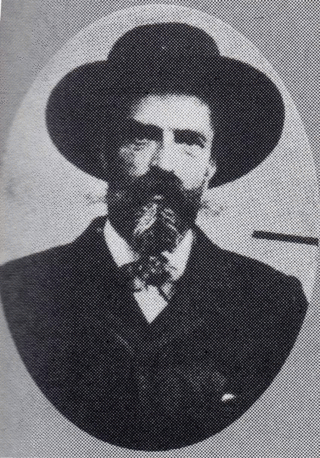 32
Camillo Prampolini è stato un politico socialista italiano.
32
Camillo Prampolini è stato un politico socialista italiano.
Benedetto Cairoli
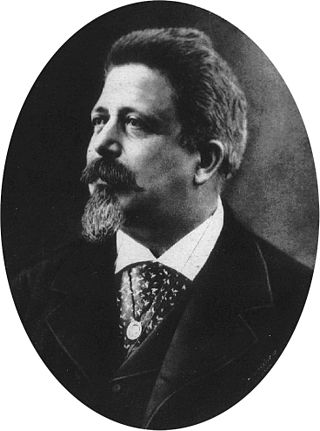 31
Benedetto Cairoli was an Italian politician, who served as Prime Minister of Italy for 2 years.
31
Benedetto Cairoli was an Italian politician, who served as Prime Minister of Italy for 2 years.
Giacomo Zanella
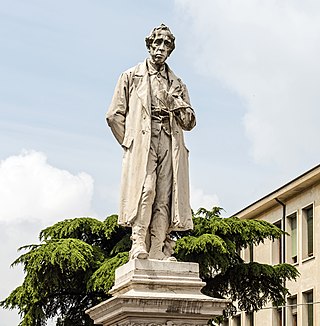 31
Giacomo Zanella was an Italian poet.
31
Giacomo Zanella was an Italian poet.
Lorenzo Perosi
 31
Monsignor Lorenzo Perosi was an Italian composer of sacred music and the only member of the Giovane Scuola who did not write opera. In the late 1890s, while he was still only in his twenties, Perosi...
31
Monsignor Lorenzo Perosi was an Italian composer of sacred music and the only member of the Giovane Scuola who did not write opera. In the late 1890s, while he was still only in his twenties, Perosi...
Saint Barbara
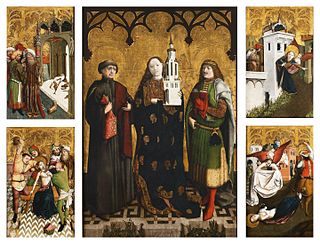 31
Saint Barbara, known in the Eastern Orthodox Church as the Great Martyr Barbara, was an early Christian Greek saint and martyr.
31
Saint Barbara, known in the Eastern Orthodox Church as the Great Martyr Barbara, was an early Christian Greek saint and martyr.
Amadeo I of Spain
 31
Amadeo I, also known as Amadeus, was an Italian prince who reigned as King of Spain from 1870 to 1873. The only king of Spain to come from the House of Savoy, he was the second son of Victor Emmanuel...
31
Amadeo I, also known as Amadeus, was an Italian prince who reigned as King of Spain from 1870 to 1873. The only king of Spain to come from the House of Savoy, he was the second son of Victor Emmanuel...
Ferruccio Parri
 31
Ferruccio Parri was an Italian partisan and anti-fascist politician who served as the 29th Prime Minister of Italy, and the first to be appointed after the end of World War II. During the war, he was...
31
Ferruccio Parri was an Italian partisan and anti-fascist politician who served as the 29th Prime Minister of Italy, and the first to be appointed after the end of World War II. During the war, he was...
Cornelius Gallus
 31
Gaius Cornelius Gallus was a Roman poet, orator, politician and military commander, at one time appointed by the Emperor Augustus as prefect of Egypt. Although only nine lines of his poetry are...
31
Gaius Cornelius Gallus was a Roman poet, orator, politician and military commander, at one time appointed by the Emperor Augustus as prefect of Egypt. Although only nine lines of his poetry are...
Giovanni Bovio
 30
Giovanni Bovio was an Italian philosopher and a politician of the Italian Republican Party.
30
Giovanni Bovio was an Italian philosopher and a politician of the Italian Republican Party.
Leon Battista Alberti
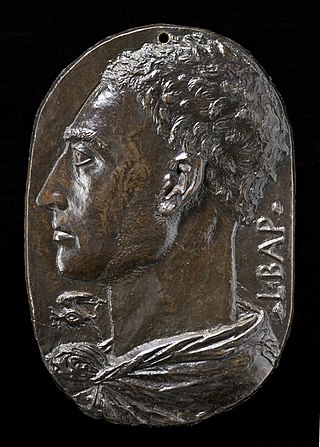 30
Leon Battista Alberti was an Italian Renaissance humanist author, artist, architect, poet, priest, linguist, philosopher, and cryptographer; he epitomised the nature of those identified now as...
30
Leon Battista Alberti was an Italian Renaissance humanist author, artist, architect, poet, priest, linguist, philosopher, and cryptographer; he epitomised the nature of those identified now as...
Girolamo Savonarola
 30
Girolamo Savonarola, OP or Jerome Savonarola was an ascetic Dominican friar from Ferrara and a preacher active in Renaissance Florence. He became known for his prophecies of civic glory, his advocacy...
30
Girolamo Savonarola, OP or Jerome Savonarola was an ascetic Dominican friar from Ferrara and a preacher active in Renaissance Florence. He became known for his prophecies of civic glory, his advocacy...
Pope Paul VI
 30
Pope Paul VI was head of the Catholic Church and sovereign of the Vatican City State from 21 June 1963 to his death in August 1978. Succeeding John XXIII, he continued the Second Vatican Council,...
30
Pope Paul VI was head of the Catholic Church and sovereign of the Vatican City State from 21 June 1963 to his death in August 1978. Succeeding John XXIII, he continued the Second Vatican Council,...
Alessandro Tassoni
 30
Alessandro Tassoni was an Italian poet and writer, from Modena, best known as the author of the mock-heroic poem La secchia rapita.
30
Alessandro Tassoni was an Italian poet and writer, from Modena, best known as the author of the mock-heroic poem La secchia rapita.
John the Baptist
 30
John the Baptist was a Jewish preacher active in the area of the Jordan River in the early 1st century AD. He is also known as Saint John the Forerunner in Eastern Orthodoxy, John the Immerser in...
30
John the Baptist was a Jewish preacher active in the area of the Jordan River in the early 1st century AD. He is also known as Saint John the Forerunner in Eastern Orthodoxy, John the Immerser in...
John Cabot
 30
John Cabot was an Italian navigator and explorer. His 1497 voyage to the coast of North America under the commission of Henry VII, King of England is the earliest known European exploration of...
30
John Cabot was an Italian navigator and explorer. His 1497 voyage to the coast of North America under the commission of Henry VII, King of England is the earliest known European exploration of...
Giambattista Vico
 30
Giambattista Vico was an Italian philosopher, rhetorician, historian, and jurist during the Italian Enlightenment. He criticized the expansion and development of modern rationalism, finding Cartesian...
30
Giambattista Vico was an Italian philosopher, rhetorician, historian, and jurist during the Italian Enlightenment. He criticized the expansion and development of modern rationalism, finding Cartesian...
Francesco de Sanctis
 30
Francesco de Sanctis was an Italian literary critic, scholar and politician, leading critic and historian of Italian language and literature during the 19th century.
30
Francesco de Sanctis was an Italian literary critic, scholar and politician, leading critic and historian of Italian language and literature during the 19th century.
Flavio Gioja
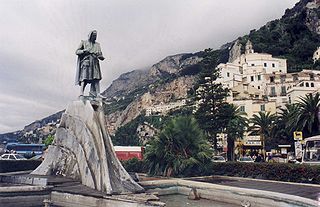 30
Flavio Gioia or Gioja, also known as Ioannes Gira Amalphensis is reputed to have been an Italian mariner, inventor, and supposedly a marine pilot. He has traditionally been credited with developing...
30
Flavio Gioia or Gioja, also known as Ioannes Gira Amalphensis is reputed to have been an Italian mariner, inventor, and supposedly a marine pilot. He has traditionally been credited with developing...
Paul the Deacon
 30
Paul the Deacon, also known as Paulus Diaconus, Warnefridus, Barnefridus, or Winfridus, and sometimes suffixed Cassinensis, was a Benedictine monk, scribe, and historian of the Lombards.
30
Paul the Deacon, also known as Paulus Diaconus, Warnefridus, Barnefridus, or Winfridus, and sometimes suffixed Cassinensis, was a Benedictine monk, scribe, and historian of the Lombards.
Ennio Porrino
 30
Ennio Porrino was an Italian composer and teacher. Amongst his compositions were orchestral works, an oratorio and several operas and ballets. His best known work is the symphonic poem Sardegna, a...
30
Ennio Porrino was an Italian composer and teacher. Amongst his compositions were orchestral works, an oratorio and several operas and ballets. His best known work is the symphonic poem Sardegna, a...
Arturo Zardini
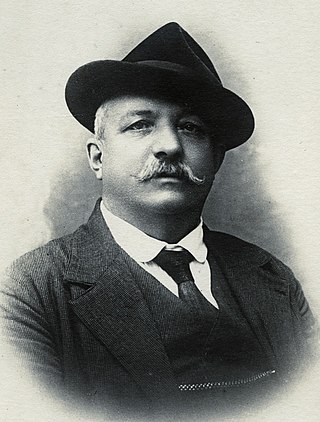 30
Arturo Zardini è stato un compositore italiano.
30
Arturo Zardini è stato un compositore italiano.
Paolo Veronese
 29
Paolo Caliari, known as Paolo Veronese, was an Italian Renaissance painter based in Venice, known for extremely large history paintings of religion and mythology, such as The Wedding at Cana (1563)...
29
Paolo Caliari, known as Paolo Veronese, was an Italian Renaissance painter based in Venice, known for extremely large history paintings of religion and mythology, such as The Wedding at Cana (1563)...
Antonio Locatelli
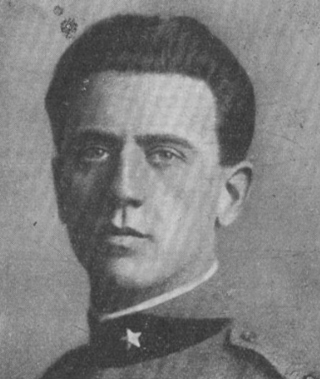 29
Antonio Locatelli was a pioneering Italian aviator and National Fascist Party legislator. He served in Gabriele d'Annunzio's air squadron during the war against Austria and was decorated. After the...
29
Antonio Locatelli was a pioneering Italian aviator and National Fascist Party legislator. He served in Gabriele d'Annunzio's air squadron during the war against Austria and was decorated. After the...
Giuseppe Cesare Abba
 29
Giuseppe Cesare Abba was an Italian patriot and writer. As a participant on the expedition of i Mille he fought next to Giuseppe Garibaldi in his conquest of the Kingdom of the Two Sicilies in 1860.
29
Giuseppe Cesare Abba was an Italian patriot and writer. As a participant on the expedition of i Mille he fought next to Giuseppe Garibaldi in his conquest of the Kingdom of the Two Sicilies in 1860.
Antonio Stoppani
 29
Antonio Stoppani was an Italian Catholic priest, patriot, geologist and palaeontologist. He studied the geology of the Italian region and wrote a popular treatise, Il Bel Paese, on geology and...
29
Antonio Stoppani was an Italian Catholic priest, patriot, geologist and palaeontologist. He studied the geology of the Italian region and wrote a popular treatise, Il Bel Paese, on geology and...
Francesco Domenico Guerrazzi
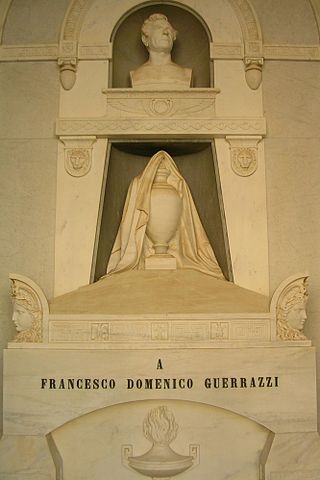 29
Francesco Domenico Guerrazzi was an Italian writer and politician involved in the Italian Risorgimento.
29
Francesco Domenico Guerrazzi was an Italian writer and politician involved in the Italian Risorgimento.
Renato Fucini
 29
Renato Fucini (1843–1921) was an Italian writer and poet.
29
Renato Fucini (1843–1921) was an Italian writer and poet.
Fra Angelico
 29
Fra Angelico, OP was a Dominican friar and Italian painter of the Early Renaissance, described by Giorgio Vasari in his Lives of the Artists as having "a rare and perfect talent". He earned his...
29
Fra Angelico, OP was a Dominican friar and Italian painter of the Early Renaissance, described by Giorgio Vasari in his Lives of the Artists as having "a rare and perfect talent". He earned his...
Vasco da Gama
 29
Vasco da Gama, 1st Count of Vidigueira, was a Portuguese explorer and the first European to reach India by sea.
29
Vasco da Gama, 1st Count of Vidigueira, was a Portuguese explorer and the first European to reach India by sea.
Pope Sylvester I
 29
Pope Sylvester I was the bishop of Rome from 31 January 314 until his death on 31 December 335. He filled the See of Rome at an important era in the history of the Western Church, though very little...
29
Pope Sylvester I was the bishop of Rome from 31 January 314 until his death on 31 December 335. He filled the See of Rome at an important era in the history of the Western Church, though very little...
Alessandro Scarlatti
 29
Pietro Alessandro Gaspare Scarlatti was an Italian Baroque composer, known especially for his operas and chamber cantatas. He is considered the most important representative of the Neapolitan school...
29
Pietro Alessandro Gaspare Scarlatti was an Italian Baroque composer, known especially for his operas and chamber cantatas. He is considered the most important representative of the Neapolitan school...
Alfredo Oriani
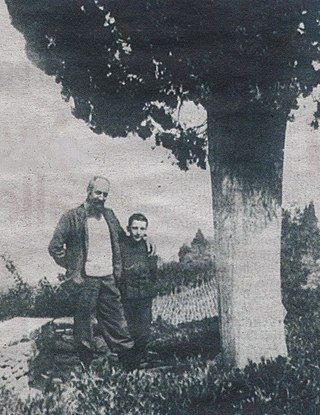 28
Alfredo Oriani was an Italian author, writer and social critic. He is often considered a precursor of Fascism, and in 1940 his books were placed on the Index Librorum Prohibitorum of the Catholic...
28
Alfredo Oriani was an Italian author, writer and social critic. He is often considered a precursor of Fascism, and in 1940 his books were placed on the Index Librorum Prohibitorum of the Catholic...
Sacco and Vanzetti
 28
Nicola Sacco and Bartolomeo Vanzetti were Italian immigrants and anarchists who were controversially convicted of murdering Alessandro Berardelli and Frederick Parmenter, a guard and a paymaster,...
28
Nicola Sacco and Bartolomeo Vanzetti were Italian immigrants and anarchists who were controversially convicted of murdering Alessandro Berardelli and Frederick Parmenter, a guard and a paymaster,...
Giuseppe Motta
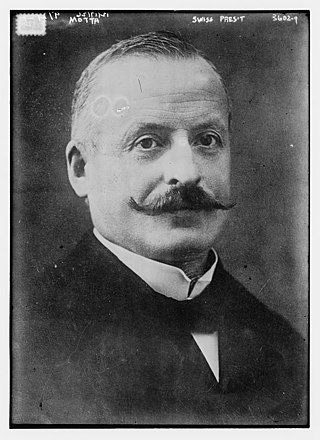 28
Giuseppe Motta was a Swiss politician. He was a member of the Swiss Federal Council (1911–1940) and President of the League of Nations (1924–1925). He was a Catholic-conservative foreign minister and...
28
Giuseppe Motta was a Swiss politician. He was a member of the Swiss Federal Council (1911–1940) and President of the League of Nations (1924–1925). He was a Catholic-conservative foreign minister and...
Giuseppe Massarenti
 28
Giuseppe Massarenti è stato un politico e sindacalista italiano. Pioniere delle lotte sindacali nella pianura bolognese, organizzò e guidò il movimento dei lavoratori agricoli di Molinella, comune di...
28
Giuseppe Massarenti è stato un politico e sindacalista italiano. Pioniere delle lotte sindacali nella pianura bolognese, organizzò e guidò il movimento dei lavoratori agricoli di Molinella, comune di...
Guido Reni
 28
Guido Reni was an Italian painter of the Baroque period, although his works showed a classical manner, similar to Simon Vouet, Nicolas Poussin, and Philippe de Champaigne. He painted primarily...
28
Guido Reni was an Italian painter of the Baroque period, although his works showed a classical manner, similar to Simon Vouet, Nicolas Poussin, and Philippe de Champaigne. He painted primarily...
Piersanti Mattarella
 28
Piersanti Mattarella was an Italian politician who was assassinated by the Mafia while he held the position of President of the Regional Government of Sicily. A member of Christian Democracy, he was...
28
Piersanti Mattarella was an Italian politician who was assassinated by the Mafia while he held the position of President of the Regional Government of Sicily. A member of Christian Democracy, he was...
Cesare Balbo
 27
Cesare Balbo, Conte di Vinadio, was an Italian writer and statesman.
27
Cesare Balbo, Conte di Vinadio, was an Italian writer and statesman.
Giuseppe Toniolo
 27
Giuseppe Toniolo was an Italian Roman Catholic economist, sociologist, and pioneer of Christian democracy. A leading political and social economist, Toniolo condemned both socialism and laissez-faire...
27
Giuseppe Toniolo was an Italian Roman Catholic economist, sociologist, and pioneer of Christian democracy. A leading political and social economist, Toniolo condemned both socialism and laissez-faire...
Amedeo Avogadro
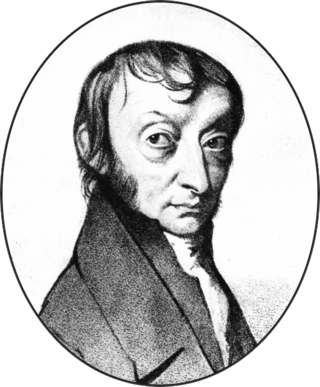 27
Lorenzo Romano Amedeo Carlo Avogadro, Count of Quaregna and Cerreto (, also, Italian: [ameˈdɛːo avoˈɡaːdro]; 9 August 1776 – 9 July 1856) was an Italian scientist, most noted for his contribution to...
27
Lorenzo Romano Amedeo Carlo Avogadro, Count of Quaregna and Cerreto (, also, Italian: [ameˈdɛːo avoˈɡaːdro]; 9 August 1776 – 9 July 1856) was an Italian scientist, most noted for his contribution to...
Padre Pio
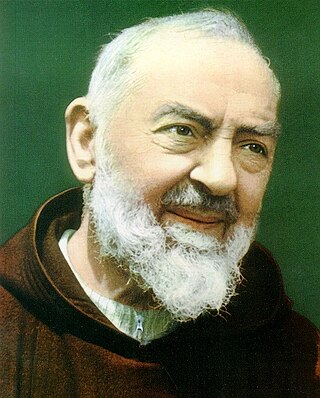 27
Pio of Pietrelcina, widely known as Padre Pio, was an Italian Capuchin friar, priest, stigmatist, and mystic. He is venerated as a saint in the Catholic Church, celebrated on 23 September.
27
Pio of Pietrelcina, widely known as Padre Pio, was an Italian Capuchin friar, priest, stigmatist, and mystic. He is venerated as a saint in the Catholic Church, celebrated on 23 September.
Italo Svevo
 26
Aron Hector Schmitz, better known by the pseudonym Italo Svevo, was an Italian and Austro-Hungarian writer, businessman, novelist, playwright, and short story writer.
26
Aron Hector Schmitz, better known by the pseudonym Italo Svevo, was an Italian and Austro-Hungarian writer, businessman, novelist, playwright, and short story writer.
Antonio Labriola
 26
Antonio Labriola was an Italian Marxist theoretician and philosopher. Although an academic philosopher and never an active member of any Marxist political party, his thought exerted influence on many...
26
Antonio Labriola was an Italian Marxist theoretician and philosopher. Although an academic philosopher and never an active member of any Marxist political party, his thought exerted influence on many...
Antonio Pigafetta
 26
Antonio Pigafetta was a Venetian scholar and explorer. He joined the Spanish expedition to the Spice Islands led by Portuguese explorer Ferdinand Magellan, the world's first circumnavigation, and is...
26
Antonio Pigafetta was a Venetian scholar and explorer. He joined the Spanish expedition to the Spice Islands led by Portuguese explorer Ferdinand Magellan, the world's first circumnavigation, and is...
Manfredo Fanti
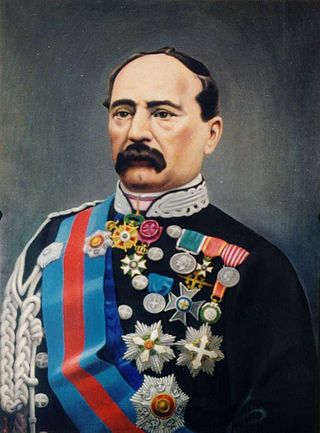 25
Manfredo Fanti was an Italian general; he is known as the founder of the Royal Italian Army.
25
Manfredo Fanti was an Italian general; he is known as the founder of the Royal Italian Army.
Giuseppe Romita
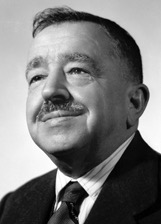 25
Giuseppe Romita was an Italian socialist politician. He served several times as a cabinet minister and member of the Italian Parliament.
25
Giuseppe Romita was an Italian socialist politician. He served several times as a cabinet minister and member of the Italian Parliament.
Guido of Arezzo
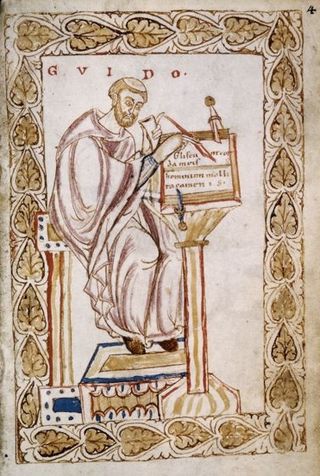 25
Guido of Arezzo was an Italian music theorist and pedagogue of High medieval music. A Benedictine monk, he is regarded as the inventor—or by some, developer—of the modern staff notation that had a...
25
Guido of Arezzo was an Italian music theorist and pedagogue of High medieval music. A Benedictine monk, he is regarded as the inventor—or by some, developer—of the modern staff notation that had a...
Guido Gozzano
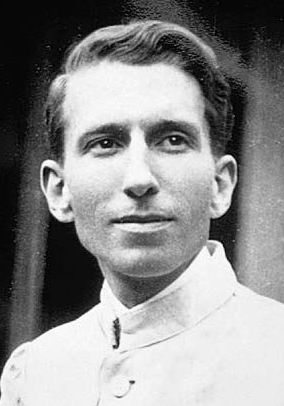 25
Guido Gustavo Gozzano was an Italian poet and writer.
25
Guido Gustavo Gozzano was an Italian poet and writer.
Agatha of Sicily
 25
Agatha of Sicily is a Christian saint. Her feast is on 5 February. Agatha was born in Catania, part of the Roman Province of Sicily, and was martyred c. 251. She is one of several virgin martyrs who...
25
Agatha of Sicily is a Christian saint. Her feast is on 5 February. Agatha was born in Catania, part of the Roman Province of Sicily, and was martyred c. 251. She is one of several virgin martyrs who...
Pablo Picasso
 25
Pablo Ruiz Picasso was a Spanish painter, sculptor, printmaker, ceramicist, and theatre designer who spent most of his adult life in France. One of the most influential artists of the 20th century,...
25
Pablo Ruiz Picasso was a Spanish painter, sculptor, printmaker, ceramicist, and theatre designer who spent most of his adult life in France. One of the most influential artists of the 20th century,...
Giovanni Paisiello
 25
Giovanni Paisiello was an Italian composer of the Classical era, and was the most popular opera composer of the late 1700s. His operatic style influenced Mozart and Rossini.
25
Giovanni Paisiello was an Italian composer of the Classical era, and was the most popular opera composer of the late 1700s. His operatic style influenced Mozart and Rossini.
Giorgio Asproni (politico)
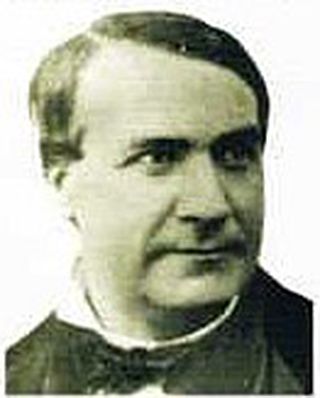 25
Giorgio Asproni è stato un politico italiano, tra le massime figure della storia moderna sarda, autonomista, federalista e repubblicano.
25
Giorgio Asproni è stato un politico italiano, tra le massime figure della storia moderna sarda, autonomista, federalista e repubblicano.
Thomas the Apostle
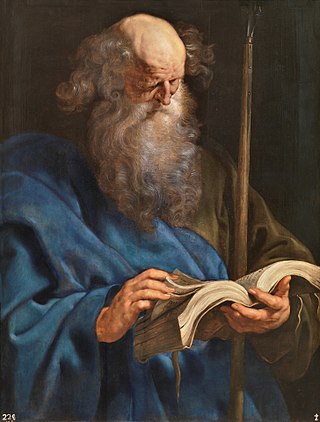 24
Thomas the Apostle, also known as Didymus, was one of the Twelve Apostles of Jesus according to the New Testament. Thomas is commonly known as "Doubting Thomas" because he initially doubted the...
24
Thomas the Apostle, also known as Didymus, was one of the Twelve Apostles of Jesus according to the New Testament. Thomas is commonly known as "Doubting Thomas" because he initially doubted the...
Vitalis of Milan
 24
Vitalis of Milan was an early Christian martyr and saint.
24
Vitalis of Milan was an early Christian martyr and saint.
Jesus
 24
Jesus, also referred to as Jesus Christ, Jesus of Nazareth, and many other names and titles, was a first-century Jewish preacher and religious leader. He is the central figure of Christianity, the...
24
Jesus, also referred to as Jesus Christ, Jesus of Nazareth, and many other names and titles, was a first-century Jewish preacher and religious leader. He is the central figure of Christianity, the...
Arcangelo Corelli
 24
Arcangelo Corelli was an Italian composer and violinist of the Baroque era. His music was key in the development of the modern genres of sonata and concerto, in establishing the preeminence of the...
24
Arcangelo Corelli was an Italian composer and violinist of the Baroque era. His music was key in the development of the modern genres of sonata and concerto, in establishing the preeminence of the...
Giovanni Falcone
 24
Giovanni Salvatore Augusto Falcone è stato un magistrato italiano.
24
Giovanni Salvatore Augusto Falcone è stato un magistrato italiano.
Umberto Terracini
 24
Umberto Elia Terracini was an Italian politician.
24
Umberto Elia Terracini was an Italian politician.
Pietro Fortunato Calvi
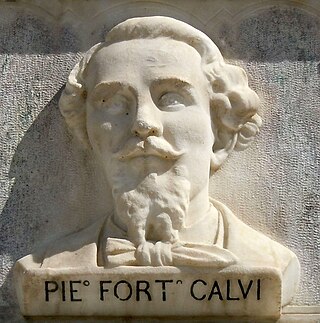 24
Pietro Fortunato Calvi, noto anche come Pier Fortunato Calvi, è stato un patriota italiano, uno dei Martiri di Belfiore.
24
Pietro Fortunato Calvi, noto anche come Pier Fortunato Calvi, è stato un patriota italiano, uno dei Martiri di Belfiore.
Federico Confalonieri
 24
Count Federico Confalonieri was an Italian revolutionist.
24
Count Federico Confalonieri was an Italian revolutionist.
Francesco Ciusa
 24
Francesco Ciusa was an Italian sculptor.
24
Francesco Ciusa was an Italian sculptor.
Matteo Maria Boiardo
 23
Matteo Maria Boiardo was an Italian Renaissance poet, best known for his epic poem Orlando innamorato.
23
Matteo Maria Boiardo was an Italian Renaissance poet, best known for his epic poem Orlando innamorato.
Giorgione
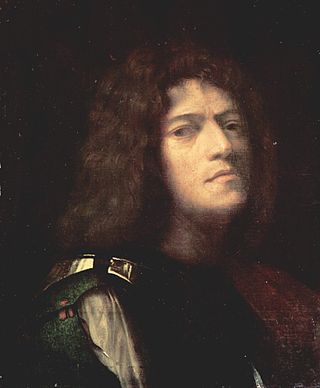 23
Giorgione was an Italian painter of the Venetian school during the High Renaissance, who died in his thirties. He is known for the elusive poetic quality of his work, though only about six surviving...
23
Giorgione was an Italian painter of the Venetian school during the High Renaissance, who died in his thirties. He is known for the elusive poetic quality of his work, though only about six surviving...
Tommaso Grossi
 23
Tommaso Grossi was an Italian poet and novelist.
23
Tommaso Grossi was an Italian poet and novelist.
Gianni Rodari
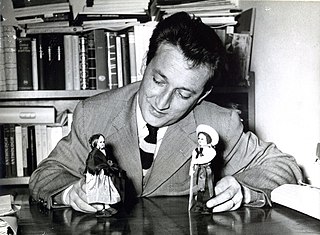 23
Giovanni Francesco "Gianni" Rodari was an Italian writer and journalist, most famous for his works of children's literature, notably Il romanzo di Cipollino. For his lasting contribution as a...
23
Giovanni Francesco "Gianni" Rodari was an Italian writer and journalist, most famous for his works of children's literature, notably Il romanzo di Cipollino. For his lasting contribution as a...
Marco Minghetti
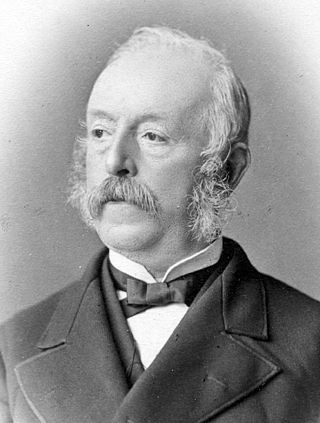 23
Marco Minghetti was an Italian economist and statesman.
23
Marco Minghetti was an Italian economist and statesman.
Louis Pasteur
 23
Louis Pasteur was a French chemist, pharmacist, and microbiologist renowned for his discoveries of the principles of vaccination, microbial fermentation, and pasteurization, the last of which was...
23
Louis Pasteur was a French chemist, pharmacist, and microbiologist renowned for his discoveries of the principles of vaccination, microbial fermentation, and pasteurization, the last of which was...
Fabrizio De André
 23
Fabrizio Cristiano De André was an Italian singer-songwriter and the most-prominent cantautore of his time. His 40-year career reflects his interests in concept albums, literature, poetry, political...
23
Fabrizio Cristiano De André was an Italian singer-songwriter and the most-prominent cantautore of his time. His 40-year career reflects his interests in concept albums, literature, poetry, political...
Matthew the Apostle
 23
Matthew the Apostle is named in the New Testament as one of the twelve apostles of Jesus. According to Christian traditions, he was also one of the four Evangelists as author of the Gospel of...
23
Matthew the Apostle is named in the New Testament as one of the twelve apostles of Jesus. According to Christian traditions, he was also one of the four Evangelists as author of the Gospel of...
Ignazio Silone
Rita of Cascia
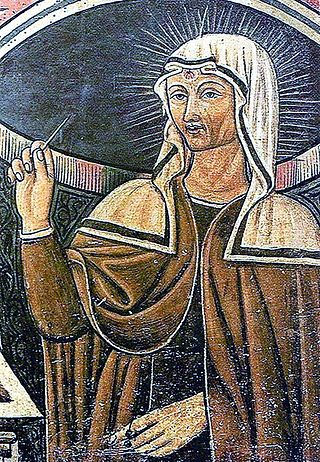 23
Rita of Cascia, OSA, was an Italian widow and Augustinian nun. After Rita's husband died, she joined an Augustinian community of religious sisters, where she was known both for practicing...
23
Rita of Cascia, OSA, was an Italian widow and Augustinian nun. After Rita's husband died, she joined an Augustinian community of religious sisters, where she was known both for practicing...
Ezio Vanoni
 23
Ezio Vanoni was an Italian economist and politician who served as Minister of Finance from May 1948 to January 1954 and Minister Budget from January 1954 until February 1956.
23
Ezio Vanoni was an Italian economist and politician who served as Minister of Finance from May 1948 to January 1954 and Minister Budget from January 1954 until February 1956.
Piero Calamandrei
 23
Piero Calamandrei was an Italian author, jurist, soldier, university professor, and politician. He was one of Italy's leading authorities on the law of civil procedure.
23
Piero Calamandrei was an Italian author, jurist, soldier, university professor, and politician. He was one of Italy's leading authorities on the law of civil procedure.
Giovanni Battista Tuveri
 23
Giovanni Battista Tuveri è stato un filosofo, scrittore e politico italiano.
23
Giovanni Battista Tuveri è stato un filosofo, scrittore e politico italiano.
Federico Fellini
 22
Federico Fellini was an Italian film director and screenwriter. He is known for his distinctive style, which blends fantasy and baroque images with earthiness. He is recognized as one of the greatest...
22
Federico Fellini was an Italian film director and screenwriter. He is known for his distinctive style, which blends fantasy and baroque images with earthiness. He is recognized as one of the greatest...
Philip Neri
 22
Philip Romolo Neri, known as the "Second Apostle of Rome" after Saint Peter, was an Italian Catholic priest noted for founding the Congregation of the Oratory, a society of secular clergy.
22
Philip Romolo Neri, known as the "Second Apostle of Rome" after Saint Peter, was an Italian Catholic priest noted for founding the Congregation of the Oratory, a society of secular clergy.
Alberto da Giussano
 22
Alberto da Giussano is a legendary character of the 12th century who would have participated, as a protagonist, in the battle of Legnano on 29 May 1176. In reality, according to historians, the...
22
Alberto da Giussano is a legendary character of the 12th century who would have participated, as a protagonist, in the battle of Legnano on 29 May 1176. In reality, according to historians, the...
Ludwig van Beethoven
 22
Ludwig van Beethoven was a German composer and pianist. He is one of the most revered figures in the history of Western music; his works rank among the most performed of the classical music...
22
Ludwig van Beethoven was a German composer and pianist. He is one of the most revered figures in the history of Western music; his works rank among the most performed of the classical music...
Guido Cavalcanti
 22
Guido Cavalcanti was an Italian poet. He was also a friend and intellectual influence on Dante Alighieri.
22
Guido Cavalcanti was an Italian poet. He was also a friend and intellectual influence on Dante Alighieri.
Rosa Luxemburg
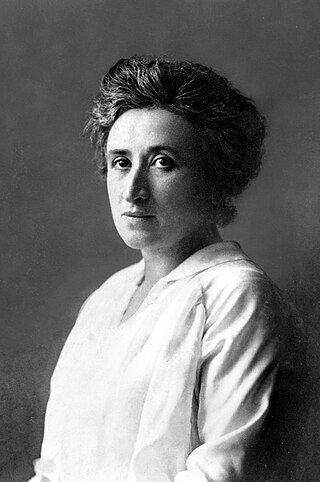 22
Rosa Luxemburg was a Polish and naturalised-German revolutionary socialist, orthodox Marxist, and anti-War activist during the First World War. She became a key figure of the revolutionary socialist...
22
Rosa Luxemburg was a Polish and naturalised-German revolutionary socialist, orthodox Marxist, and anti-War activist during the First World War. She became a key figure of the revolutionary socialist...
Primo Levi
 22
Primo Michele Levi was a Jewish-Italian chemist, partisan, writer, and Holocaust survivor. He was the author of several books, collections of short stories, essays, poems and one novel. His...
22
Primo Michele Levi was a Jewish-Italian chemist, partisan, writer, and Holocaust survivor. He was the author of several books, collections of short stories, essays, poems and one novel. His...
Agnes of Rome
 22
Agnes of Rome is a virgin martyr, venerated as a saint in the Catholic Church, Oriental Orthodox Church and the Eastern Orthodox Church, as well as the Anglican Communion and Lutheran Churches. She...
22
Agnes of Rome is a virgin martyr, venerated as a saint in the Catholic Church, Oriental Orthodox Church and the Eastern Orthodox Church, as well as the Anglican Communion and Lutheran Churches. She...
Francesco Guicciardini
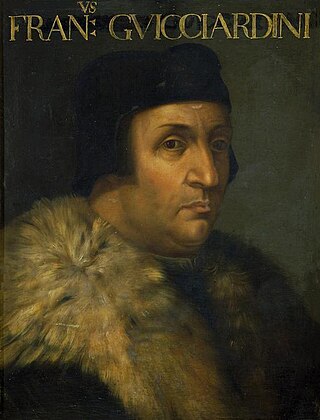 22
Francesco Guicciardini was an Italian historian and statesman. A friend and critic of Niccolò Machiavelli, he is considered one of the major political writers of the Italian Renaissance. In his...
22
Francesco Guicciardini was an Italian historian and statesman. A friend and critic of Niccolò Machiavelli, he is considered one of the major political writers of the Italian Renaissance. In his...
Nilde Iotti
 22
Leonilde Iotti, commonly known as Nilde Iotti was an Italian politician, member of the Italian Communist Party (PCI). She was the first and only woman member of the PCI to become the president of the...
22
Leonilde Iotti, commonly known as Nilde Iotti was an Italian politician, member of the Italian Communist Party (PCI). She was the first and only woman member of the PCI to become the president of the...
Bernardino Luini
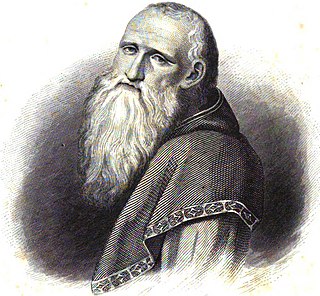 22
Bernardino Luini was a north Italian painter from Leonardo's circle during the High Renaissance. Both Luini and Giovanni Antonio Boltraffio were said to have worked with Leonardo directly; he was...
22
Bernardino Luini was a north Italian painter from Leonardo's circle during the High Renaissance. Both Luini and Giovanni Antonio Boltraffio were said to have worked with Leonardo directly; he was...
Cicero
 21
Marcus Tullius Cicero was a Roman statesman, lawyer, scholar, philosopher, writer and Academic skeptic, who tried to uphold optimate principles during the political crises that led to the...
21
Marcus Tullius Cicero was a Roman statesman, lawyer, scholar, philosopher, writer and Academic skeptic, who tried to uphold optimate principles during the political crises that led to the...
Francesco Ferruccio
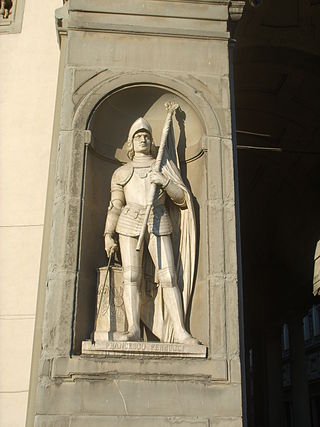 21
Francesco Ferruccio was an Italian captain from Florence who fought in the Italian Wars.
21
Francesco Ferruccio was an Italian captain from Florence who fought in the Italian Wars.
Saint Cecilia
 21
Saint Cecilia, also spelled Cecelia, was a Roman virgin martyr and is venerated in Catholic, Orthodox, Anglican, and some Lutheran churches, such as the Church of Sweden. She became the patroness of...
21
Saint Cecilia, also spelled Cecelia, was a Roman virgin martyr and is venerated in Catholic, Orthodox, Anglican, and some Lutheran churches, such as the Church of Sweden. She became the patroness of...
Antonio Cantore
 21
Antonio Cantore was an Italian general.
21
Antonio Cantore was an Italian general.
Alfredo Casella
 21
Alfredo Casella was an Italian composer, pianist and conductor.
21
Alfredo Casella was an Italian composer, pianist and conductor.
Aleardo Aleardi
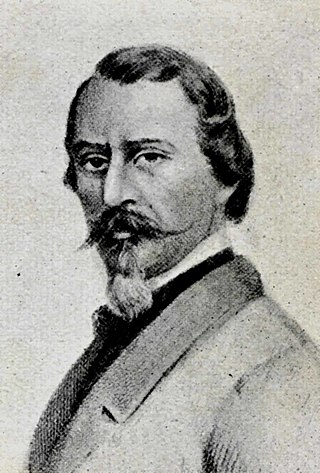 21
Aleardo Aleardi, born Gaetano Maria, was an Italian poet who belonged to the so-called Neo-romanticists.
21
Aleardo Aleardi, born Gaetano Maria, was an Italian poet who belonged to the so-called Neo-romanticists.
Tito Livio
 21
Tito Livio fue un historiador romano que escribió una monumental historia del Estado romano en ciento cuarenta y dos libros, desde la legendaria llegada de Eneas a las costas del Lacio hasta la...
21
Tito Livio fue un historiador romano que escribió una monumental historia del Estado romano en ciento cuarenta y dos libros, desde la legendaria llegada de Eneas a las costas del Lacio hasta la...
Zeno of Verona
 21
Zeno of Verona was an Afro-Italian Christian figure believe to have either served as Bishop of Verona or died as a martyr. He is venerated as a saint in the Catholic Church and the Orthodox Church.
21
Zeno of Verona was an Afro-Italian Christian figure believe to have either served as Bishop of Verona or died as a martyr. He is venerated as a saint in the Catholic Church and the Orthodox Church.
Pope Gregory I
 21
Pope Gregory I, commonly known as Saint Gregory the Great, was the 64th Bishop of Rome from 3 September 590 to his death. He is known for instituting the first recorded large-scale mission from Rome,...
21
Pope Gregory I, commonly known as Saint Gregory the Great, was the 64th Bishop of Rome from 3 September 590 to his death. He is known for instituting the first recorded large-scale mission from Rome,...
Adelaide Ristori
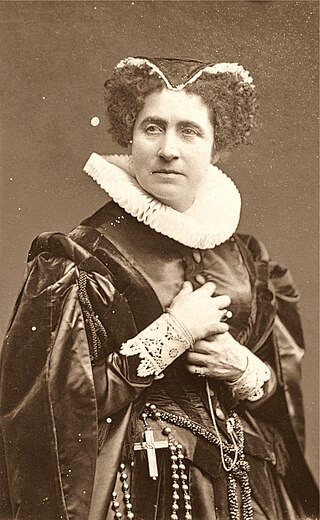 21
Adelaide Ristori was a distinguished Italian tragedienne, who was often referred to as the Marquise.
21
Adelaide Ristori was a distinguished Italian tragedienne, who was often referred to as the Marquise.
Girolamo Frescobaldi
 21
Girolamo Alessandro Frescobaldi was an Italian composer and virtuoso keyboard player. Born in the Duchy of Ferrara, he was one of the most important composers of keyboard music in the late...
21
Girolamo Alessandro Frescobaldi was an Italian composer and virtuoso keyboard player. Born in the Duchy of Ferrara, he was one of the most important composers of keyboard music in the late...
Isaac Newton
 21
Sir Isaac Newton was an English polymath active as a mathematician, physicist, astronomer, alchemist, theologian, and author who was described in his time as a natural philosopher. He was a key...
21
Sir Isaac Newton was an English polymath active as a mathematician, physicist, astronomer, alchemist, theologian, and author who was described in his time as a natural philosopher. He was a key...
Ettore Majorana
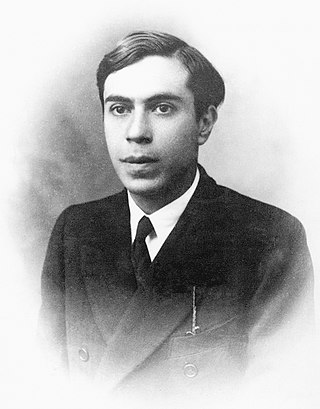 21
Ettore Majorana was an Italian theoretical physicist who worked on neutrino masses. On 25 March 1938, he disappeared under mysterious circumstances after purchasing a ticket to travel by ship from...
21
Ettore Majorana was an Italian theoretical physicist who worked on neutrino masses. On 25 March 1938, he disappeared under mysterious circumstances after purchasing a ticket to travel by ship from...
Saint Maurice
 20
Maurice was an Egyptian military leader who headed the legendary Theban Legion of Rome in the 3rd century, and is one of the favourite and most widely venerated saints of that martyred group. He is...
20
Maurice was an Egyptian military leader who headed the legendary Theban Legion of Rome in the 3rd century, and is one of the favourite and most widely venerated saints of that martyred group. He is...
Paolo Sarpi
 20
Paolo Sarpi was a Venetian historian, prelate, scientist, canon lawyer, polymath and statesman active on behalf of the Venetian Republic during the period of its successful defiance of the papal...
20
Paolo Sarpi was a Venetian historian, prelate, scientist, canon lawyer, polymath and statesman active on behalf of the Venetian Republic during the period of its successful defiance of the papal...
Che Guevara
 20
Ernesto "Che" Guevara was an Argentine Marxist revolutionary, physician, author, guerrilla leader, diplomat, and military theorist. A major figure of the Cuban Revolution, his stylized visage has...
20
Ernesto "Che" Guevara was an Argentine Marxist revolutionary, physician, author, guerrilla leader, diplomat, and military theorist. A major figure of the Cuban Revolution, his stylized visage has...
Sebastian Cabot (explorer)
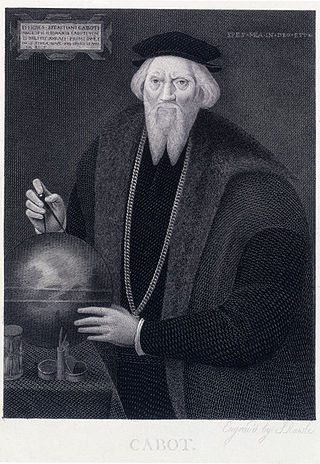 20
Sebastian Cabot was a Venetian explorer, likely born in the Venetian Republic and a Venetian citizen. He was the son of Venetian explorer John Cabot and his Venetian wife Mattea.
20
Sebastian Cabot was a Venetian explorer, likely born in the Venetian Republic and a Venetian citizen. He was the son of Venetian explorer John Cabot and his Venetian wife Mattea.
Italo Calvino
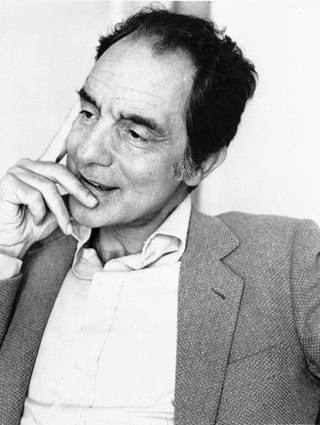 20
Italo Calvino was an Italian writer and journalist. His best-known works include the Our Ancestors trilogy (1952–1959), the Cosmicomics collection of short stories (1965), and the novels Invisible...
20
Italo Calvino was an Italian writer and journalist. His best-known works include the Our Ancestors trilogy (1952–1959), the Cosmicomics collection of short stories (1965), and the novels Invisible...
Yuri Gagarin
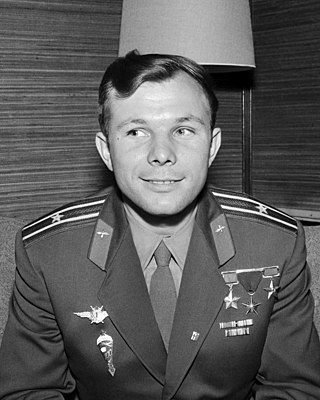 20
Yuri Alekseyevich Gagarin was a Soviet pilot and cosmonaut who, aboard the first successful crewed spaceflight, became the first human to journey into outer space. Travelling on Vostok 1, Gagarin...
20
Yuri Alekseyevich Gagarin was a Soviet pilot and cosmonaut who, aboard the first successful crewed spaceflight, became the first human to journey into outer space. Travelling on Vostok 1, Gagarin...
Luchino Visconti
 20
Luchino Visconti di Modrone, Count of Lonate Pozzolo was an Italian filmmaker, theatre and opera director, and screenwriter. He was one of the fathers of cinematic neorealism, but later moved towards...
20
Luchino Visconti di Modrone, Count of Lonate Pozzolo was an Italian filmmaker, theatre and opera director, and screenwriter. He was one of the fathers of cinematic neorealism, but later moved towards...
Pancras of Rome
 20
Pancras was a Roman citizen who converted to Christianity and was beheaded for his faith at the age of fourteen, around the year 304. His name is Greek (Πανκράτιος) and means "the one that holds...
20
Pancras was a Roman citizen who converted to Christianity and was beheaded for his faith at the age of fourteen, around the year 304. His name is Greek (Πανκράτιος) and means "the one that holds...
Teresa Urrea
 19
Teresa Urrea, often referred to as Teresita and also known as Santa Teresa or La Santa de Cábora among the Mayo, was a Mexican mystic, folk healer, and revolutionary insurgent.
19
Teresa Urrea, often referred to as Teresita and also known as Santa Teresa or La Santa de Cábora among the Mayo, was a Mexican mystic, folk healer, and revolutionary insurgent.
Sophia of Rome
 19
Saint Sophia of Rome is venerated as a Christian martyr.
She is identified in hagiographical tradition with the figure of Sophia of Milan, the mother of Saints Faith, Hope and Charity, whose...
19
Saint Sophia of Rome is venerated as a Christian martyr.
She is identified in hagiographical tradition with the figure of Sophia of Milan, the mother of Saints Faith, Hope and Charity, whose...
Giuseppe Dessì
 19
Giuseppe Dessì was an Italian novelist, short-story writer and playwright from Sardinia. His novel Paese d'ombre won the 1972 Strega Prize and was translated into English as The Forests of Norbio.
19
Giuseppe Dessì was an Italian novelist, short-story writer and playwright from Sardinia. His novel Paese d'ombre won the 1972 Strega Prize and was translated into English as The Forests of Norbio.
Antoninus of Sorrento
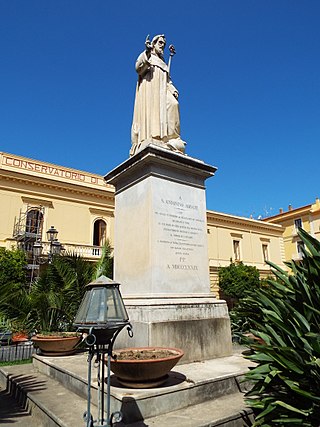 19
Antoninus of Sorrento was an Italian abbot, hermit, and saint.
19
Antoninus of Sorrento was an Italian abbot, hermit, and saint.
Guglielmo Pepe
 19
Guglielmo Pepe was an Italian general and patriot. He was brother to Florestano Pepe and cousin to Gabriele Pepe. He was married to Mary Ann Coventry, a Scottish woman who was the widow of John...
19
Guglielmo Pepe was an Italian general and patriot. He was brother to Florestano Pepe and cousin to Gabriele Pepe. He was married to Mary Ann Coventry, a Scottish woman who was the widow of John...
Claudio Treves
 19
Claudio Treves was an Italian politician and journalist.
19
Claudio Treves was an Italian politician and journalist.
Francesco Rismondo
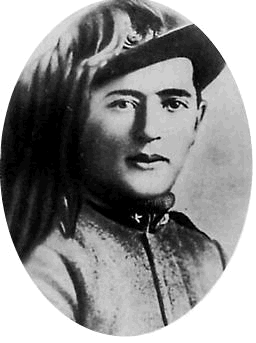 19
Francesco Rismondo was an Austrian-born Italian irredentist and decorated military volunteer.
19
Francesco Rismondo was an Austrian-born Italian irredentist and decorated military volunteer.
Pietro Metastasio
 19
Pietro Antonio Domenico Trapassi, better known by his pseudonym of Pietro Metastasio, was an Italian poet and librettist, considered the most important writer of opera seria libretti.
19
Pietro Antonio Domenico Trapassi, better known by his pseudonym of Pietro Metastasio, was an Italian poet and librettist, considered the most important writer of opera seria libretti.
Giuseppe Dossetti
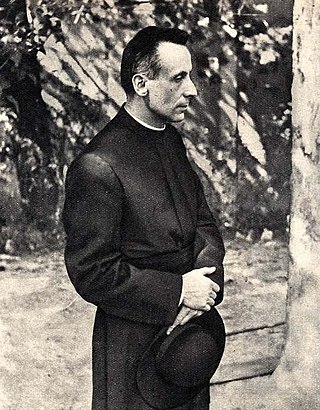 19
Giuseppe Dossetti was an Italian jurist, a politician, and also a Catholic priest from 1958 onward.
19
Giuseppe Dossetti was an Italian jurist, a politician, and also a Catholic priest from 1958 onward.
Giovanni Battista Morgagni
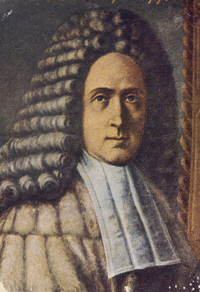 19
Giovanni Battista Morgagni was an Italian anatomist, generally regarded as the father of modern anatomical pathology, who taught thousands of medical students from many countries during his 56 years...
19
Giovanni Battista Morgagni was an Italian anatomist, generally regarded as the father of modern anatomical pathology, who taught thousands of medical students from many countries during his 56 years...
Lazzaro Spallanzani
 19
Lazzaro Spallanzani was an Italian Catholic priest, biologist and physiologist who made important contributions to the experimental study of bodily functions, animal reproduction, and animal...
19
Lazzaro Spallanzani was an Italian Catholic priest, biologist and physiologist who made important contributions to the experimental study of bodily functions, animal reproduction, and animal...
Enrico Tazzoli (priest)
 19
Enrico Tazzoli was an Italian patriot and priest, the best known of the Belfiore martyrs.
19
Enrico Tazzoli was an Italian patriot and priest, the best known of the Belfiore martyrs.
Justus of Trieste
 19
Saint Justus of Trieste is a Roman Catholic saint.
19
Saint Justus of Trieste is a Roman Catholic saint.
Jacopo Tomadini
Luigi Capuana
 18
Luigi Capuana was an Italian author and journalist and one of the most important members of the verist movement. He was a contemporary of Giovanni Verga, both having been born in the province of...
18
Luigi Capuana was an Italian author and journalist and one of the most important members of the verist movement. He was a contemporary of Giovanni Verga, both having been born in the province of...
Domenico Millelire
 18
Domenico Millelire, pseudonym of Domenico Leoni, was an Italian patriot, and officer of Regia Marina Sarda. He is recognised to have gained the first Gold Medal of Military Valor in Italian history....
18
Domenico Millelire, pseudonym of Domenico Leoni, was an Italian patriot, and officer of Regia Marina Sarda. He is recognised to have gained the first Gold Medal of Military Valor in Italian history....
Eleonora Duse
 18
Eleonora Giulia Amalia Duse, often known simply as Duse, was an Italian actress, rated by many as the greatest of her time. She performed in many countries, notably in the plays of Gabriele...
18
Eleonora Giulia Amalia Duse, often known simply as Duse, was an Italian actress, rated by many as the greatest of her time. She performed in many countries, notably in the plays of Gabriele...
Antonio Fratti
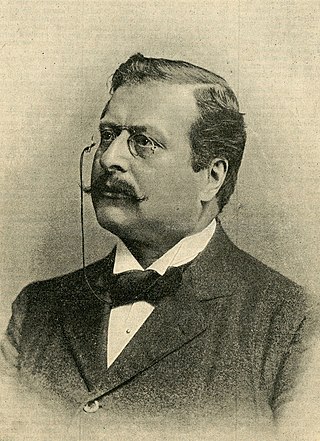 18
Antonio Fratti è stato un patriota, politico, avvocato e pubblicista italiano.
18
Antonio Fratti è stato un patriota, politico, avvocato e pubblicista italiano.
Gian Domenico Romagnosi
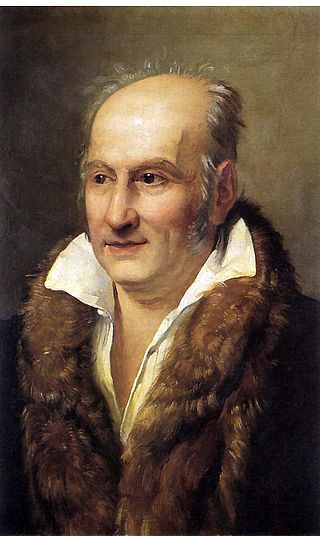 18
Gian Domenico Romagnosi was an Italian philosopher, economist and jurist.
18
Gian Domenico Romagnosi was an Italian philosopher, economist and jurist.
Felix of Nola
 18
Felix of Nola was a Christian presbyter at Nola near Naples in Italy. He sold off his possessions to give to the poor, but was arrested and tortured for his Christian faith during the persecution of...
18
Felix of Nola was a Christian presbyter at Nola near Naples in Italy. He sold off his possessions to give to the poor, but was arrested and tortured for his Christian faith during the persecution of...
Pope Pius XII
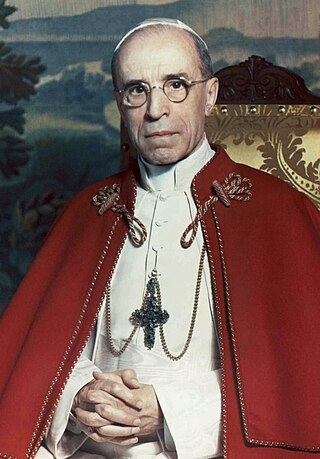 18
Pope Pius XII was head of the Catholic Church and sovereign of the Vatican City State from 2 March 1939 until his death in October 1958. Before his election to the papacy, he served as secretary of...
18
Pope Pius XII was head of the Catholic Church and sovereign of the Vatican City State from 2 March 1939 until his death in October 1958. Before his election to the papacy, he served as secretary of...
Pope John Paul I
 18
Pope John Paul I was head of the Catholic Church and sovereign of the Vatican City from 26 August 1978 until his death 33 days later. His reign is among the shortest in papal history, resulting in...
18
Pope John Paul I was head of the Catholic Church and sovereign of the Vatican City from 26 August 1978 until his death 33 days later. His reign is among the shortest in papal history, resulting in...
Fausto Coppi
 18
Angelo Fausto Coppi was an Italian cyclist, the dominant international cyclist of the years after the Second World War. His successes earned him the title Il Campionissimo. He was an all-round racing...
18
Angelo Fausto Coppi was an Italian cyclist, the dominant international cyclist of the years after the Second World War. His successes earned him the title Il Campionissimo. He was an all-round racing...
Enrico Cialdini
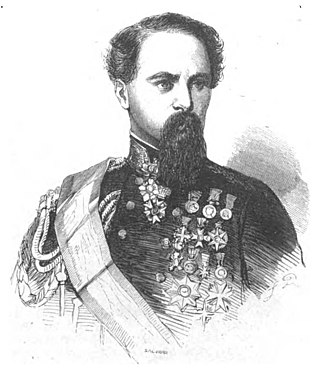 18
Enrico Cialdini, Duca di Gaeta was an Italian soldier, politician and diplomat.
18
Enrico Cialdini, Duca di Gaeta was an Italian soldier, politician and diplomat.
Amatore Sciesa
 18
Amatore Sciesa è stato un patriota italiano.
Era conosciuto anche col nome di Antonio Sciesa, a causa di un errore di trascrizione reso noto dopo varie ricerche e studi dallo scrittore Leo Pollini.
18
Amatore Sciesa è stato un patriota italiano.
Era conosciuto anche col nome di Antonio Sciesa, a causa di un errore di trascrizione reso noto dopo varie ricerche e studi dallo scrittore Leo Pollini.
Melozzo da Forlì
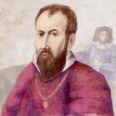 18
Melozzo da Forlì was an Italian Renaissance painter and architect. His fresco paintings are notable for the use of foreshortening. He was the most important member of the Forlì painting school.
18
Melozzo da Forlì was an Italian Renaissance painter and architect. His fresco paintings are notable for the use of foreshortening. He was the most important member of the Forlì painting school.
Marco Biagi (jurist)
 18
Marco Biagi was an Italian jurist. A native of Bologna, he was professor of labour law and industrial relations at the University of Modena.
18
Marco Biagi was an Italian jurist. A native of Bologna, he was professor of labour law and industrial relations at the University of Modena.
Johann Sebastian Bach
 18
Johann Sebastian Bach was a German composer and musician of the late Baroque period. He is known for his prolific authorship of music across a variety of instruments and forms, including; orchestral...
18
Johann Sebastian Bach was a German composer and musician of the late Baroque period. He is known for his prolific authorship of music across a variety of instruments and forms, including; orchestral...
Leonardo Alagon
 18
Leonardo Alagon, even Alagón or de Alagón,, was the last marquis of Oristano (1470–1478).
18
Leonardo Alagon, even Alagón or de Alagón,, was the last marquis of Oristano (1470–1478).
Matilde Serao
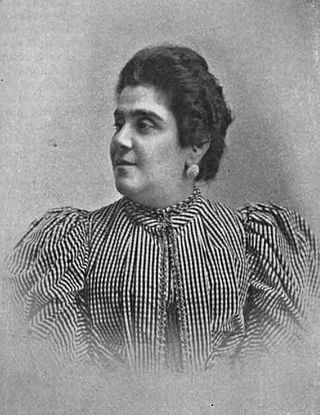 18
Matilde Serao was an Italian journalist and novelist. She was the first woman called to edit an Italian newspaper, Il Corriere di Roma and later Il Giorno. Serao was also the co-founder and editor of...
18
Matilde Serao was an Italian journalist and novelist. She was the first woman called to edit an Italian newspaper, Il Corriere di Roma and later Il Giorno. Serao was also the co-founder and editor of...
Lazarus of Bethany
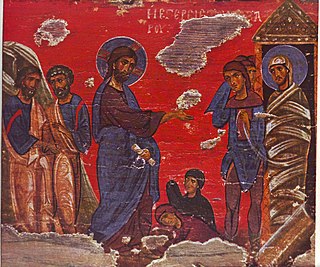 18
Lazarus of Bethany is a figure within the Christian Bible, mentioned in the New Testament in the Gospel of John, who four days after his death is restored to life by Jesus. This is seen by Christians...
18
Lazarus of Bethany is a figure within the Christian Bible, mentioned in the New Testament in the Gospel of John, who four days after his death is restored to life by Jesus. This is seen by Christians...
Anthony the Great
 18
Anthony the Great was a Christian monk from Egypt, revered since his death as a saint. He is distinguished from other saints named Anthony, such as Anthony of Padua, by various epithets: Anthony of...
18
Anthony the Great was a Christian monk from Egypt, revered since his death as a saint. He is distinguished from other saints named Anthony, such as Anthony of Padua, by various epithets: Anthony of...
Ovid
 18
Publius Ovidius Naso, known in English as Ovid, was a Roman poet who lived during the reign of Augustus. He was a younger contemporary of Virgil and Horace, with whom he is often ranked as one of the...
18
Publius Ovidius Naso, known in English as Ovid, was a Roman poet who lived during the reign of Augustus. He was a younger contemporary of Virgil and Horace, with whom he is often ranked as one of the...
Agostino Gemelli
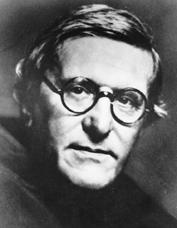 18
Agostino Gemelli was an Italian Franciscan friar, physician and psychologist, who was also the founder and first Rector of the Università Cattolica del Sacro Cuore of Milan.
18
Agostino Gemelli was an Italian Franciscan friar, physician and psychologist, who was also the founder and first Rector of the Università Cattolica del Sacro Cuore of Milan.
Carlo Forlanini
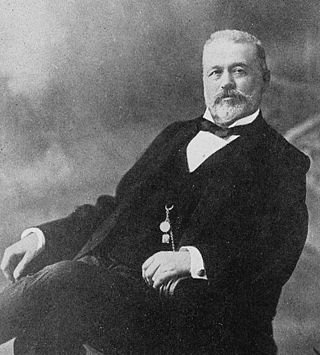 18
Carlo Forlanini was a medical doctor and professor at the Universities of Turin and Pavia. He was also the inventor of artificial pneumothorax, which was the primary treatment method of pulmonary...
18
Carlo Forlanini was a medical doctor and professor at the Universities of Turin and Pavia. He was also the inventor of artificial pneumothorax, which was the primary treatment method of pulmonary...
Clement of Rome
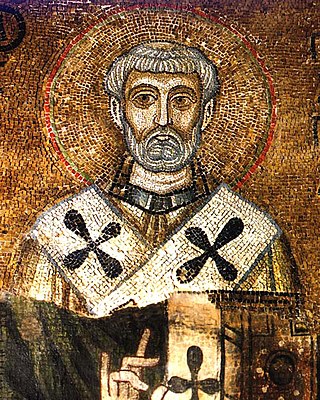 18
Clement of Rome, also known as Pope Clement I, was the bishop of Rome in the late first century AD. He is listed by Irenaeus and Tertullian as the bishop of Rome, holding office from 88 AD to his...
18
Clement of Rome, also known as Pope Clement I, was the bishop of Rome in the late first century AD. He is listed by Irenaeus and Tertullian as the bishop of Rome, holding office from 88 AD to his...
Francesco Ignazio Mannu
 18
Don Francesco Ignazio Mannu è stato un magistrato del regno di Sardegna.
18
Don Francesco Ignazio Mannu è stato un magistrato del regno di Sardegna.
Luigi Canepa
Pietro Toselli
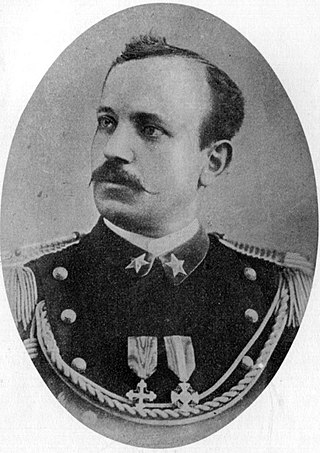 17
Pietro Toselli was a major of the Royal Italian Army. He is mainly known for his participation in the First Italo-Ethiopian War. He was born in Peveragno in 1856, the youngest of three siblings. His...
17
Pietro Toselli was a major of the Royal Italian Army. He is mainly known for his participation in the First Italo-Ethiopian War. He was born in Peveragno in 1856, the youngest of three siblings. His...
Richard Wagner
 17
Wilhelm Richard Wagner was a German composer, theatre director, polemicist, and conductor who is chiefly known for his operas. Unlike most opera composers, Wagner wrote both the libretto and the...
17
Wilhelm Richard Wagner was a German composer, theatre director, polemicist, and conductor who is chiefly known for his operas. Unlike most opera composers, Wagner wrote both the libretto and the...
Romolo Gessi
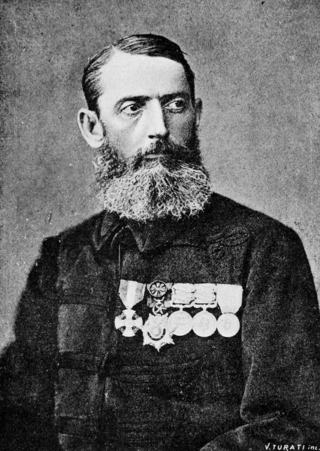 17
Romolo Gessi, also called Gessi Pasha, was an Italian soldier, governor in the Turkish-Egyptian administration and explorer of north-east Africa, who described the course of the White Nile in...
17
Romolo Gessi, also called Gessi Pasha, was an Italian soldier, governor in the Turkish-Egyptian administration and explorer of north-east Africa, who described the course of the White Nile in...
Cino da Pistoia
 17
Cino da Pistoia was an Italian jurist and poet. He was the university teacher of Bartolus de Saxoferrato and a friend and intellectual influence on Dante Alighieri.
17
Cino da Pistoia was an Italian jurist and poet. He was the university teacher of Bartolus de Saxoferrato and a friend and intellectual influence on Dante Alighieri.
Saint Marinus
 17
Marinus was an Early Christian and the founder of a chapel and monastery in 301 from whose initial community the state of San Marino later grew.
17
Marinus was an Early Christian and the founder of a chapel and monastery in 301 from whose initial community the state of San Marino later grew.
Julian the Hospitaller
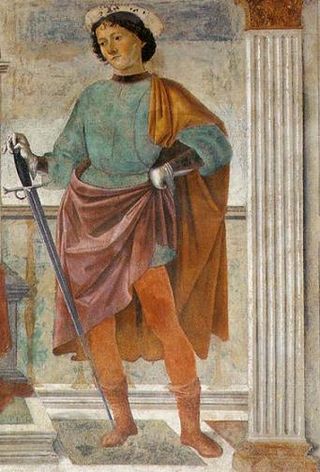 17
Saint Julian the Hospitaller is a saint venerated in the Catholic and Eastern Orthodox Churches. He is patron saint of the cities of Ghent (Belgium), Saint Julian's (Malta) and Macerata (Italy).
17
Saint Julian the Hospitaller is a saint venerated in the Catholic and Eastern Orthodox Churches. He is patron saint of the cities of Ghent (Belgium), Saint Julian's (Malta) and Macerata (Italy).
Pliny the Younger
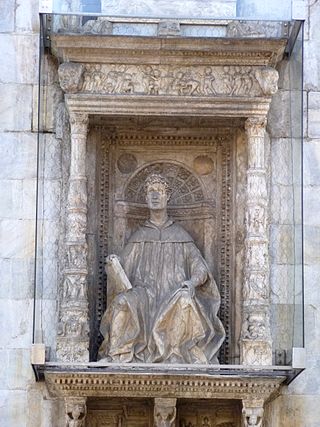 17
Gaius Plinius Caecilius Secundus, born Gaius Caecilius or Gaius Caecilius Cilo, better known as Pliny the Younger, was a lawyer, author, and magistrate of Ancient Rome. Pliny's uncle, Pliny the...
17
Gaius Plinius Caecilius Secundus, born Gaius Caecilius or Gaius Caecilius Cilo, better known as Pliny the Younger, was a lawyer, author, and magistrate of Ancient Rome. Pliny's uncle, Pliny the...
Giuseppe Gioachino Belli
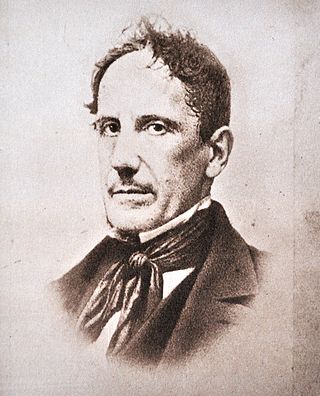 17
Giuseppe Francesco Antonio Maria Gioachino Raimondo Belli was an Italian poet, famous for his sonnets in Romanesco, the dialect of Rome.
17
Giuseppe Francesco Antonio Maria Gioachino Raimondo Belli was an Italian poet, famous for his sonnets in Romanesco, the dialect of Rome.
Luke the Evangelist
 17
Luke the Evangelist is one of the Four Evangelists—the four traditionally ascribed authors of the canonical gospels. The Early Church Fathers ascribed to him authorship of both the Gospel of Luke and...
17
Luke the Evangelist is one of the Four Evangelists—the four traditionally ascribed authors of the canonical gospels. The Early Church Fathers ascribed to him authorship of both the Gospel of Luke and...
Pasquino Borghi
 17
Pasquino Borghi Albertario è stato un presbitero, missionario e partigiano italiano, medaglia d'oro al valor militare.
17
Pasquino Borghi Albertario è stato un presbitero, missionario e partigiano italiano, medaglia d'oro al valor militare.
Altiero Spinelli
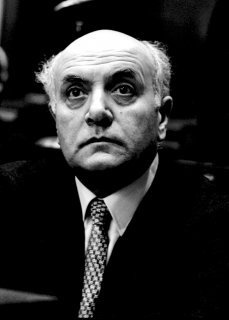 17
Altiero Spinelli was an Italian communist politician, political theorist and European federalist, referred to as one of the founding fathers of the European Union. A communist and militant...
17
Altiero Spinelli was an Italian communist politician, political theorist and European federalist, referred to as one of the founding fathers of the European Union. A communist and militant...
Giuseppe Galliano
 17
Giuseppe Galliano was an officer of the Royal Italian Army, mostly known for his role during the First Italo-Ethiopian War. He perished in the Battle of Adwa and was posthumously awarded the Gold...
17
Giuseppe Galliano was an officer of the Royal Italian Army, mostly known for his role during the First Italo-Ethiopian War. He perished in the Battle of Adwa and was posthumously awarded the Gold...
Scipio Slataper
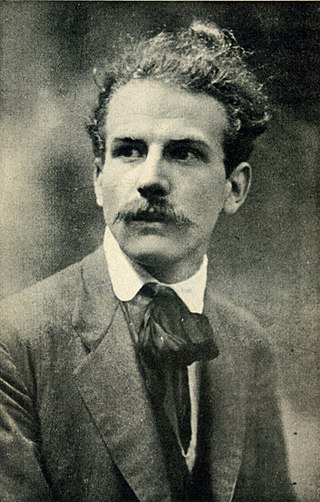 17
Scipio Slataper was an Italian writer, most famous for his lyrical essay My Karst. He is considered, alongside Italo Svevo, the initiator of the prolific tradition of Italian literature in Trieste.
17
Scipio Slataper was an Italian writer, most famous for his lyrical essay My Karst. He is considered, alongside Italo Svevo, the initiator of the prolific tradition of Italian literature in Trieste.
Saint Maurus
 16
Maurus (512–584) was the first disciple of Benedict of Nursia. He is mentioned in Gregory the Great's biography of the latter as the first oblate, offered to the monastery by his noble Roman parents...
16
Maurus (512–584) was the first disciple of Benedict of Nursia. He is mentioned in Gregory the Great's biography of the latter as the first oblate, offered to the monastery by his noble Roman parents...
Vigilius of Trent
 16
Vigilius of Trent is venerated as the patron saint and bishop of Trent. He should not be confused with the pope of the same name.
16
Vigilius of Trent is venerated as the patron saint and bishop of Trent. He should not be confused with the pope of the same name.
Giorgio Perlasca
 16
Giorgio Perlasca was an Italian businessman and former Fascist who, with the collaboration of official diplomats, posed as the Spanish consul-general to Hungary in the winter of 1944, and saved 5,218...
16
Giorgio Perlasca was an Italian businessman and former Fascist who, with the collaboration of official diplomats, posed as the Spanish consul-general to Hungary in the winter of 1944, and saved 5,218...
Cyricus and Julitta
Arturo Ferrarin
 16
Arturo Ferrarin was an Italian pioneer aviator. His exploits included winning the "Rome-Tokyo Raid" air race in 1920 and a non-stop flight from Italy to Brazil in 1928 with fellow aviator Carlo Del...
16
Arturo Ferrarin was an Italian pioneer aviator. His exploits included winning the "Rome-Tokyo Raid" air race in 1920 and a non-stop flight from Italy to Brazil in 1928 with fellow aviator Carlo Del...
Luciano Romagnoli
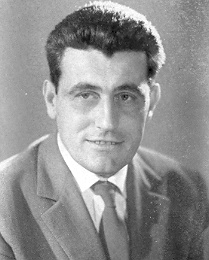 16
Luciano Romagnoli è stato un politico, partigiano e sindacalista italiano.
16
Luciano Romagnoli è stato un politico, partigiano e sindacalista italiano.
Luca della Robbia
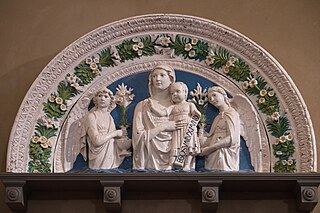 16
Luca della Robbia was an Italian Renaissance sculptor from Florence. Della Robbia is noted for his colorful, tin-glazed terracotta statuary, a technique that he invented and passed on to his nephew...
16
Luca della Robbia was an Italian Renaissance sculptor from Florence. Della Robbia is noted for his colorful, tin-glazed terracotta statuary, a technique that he invented and passed on to his nephew...
Poliziano
 16
Agnolo Ambrogini, commonly known as Angelo Poliziano or simply Poliziano, anglicized as Politian, was an Italian classical scholar and poet of the Florentine Renaissance. His scholarship was...
16
Agnolo Ambrogini, commonly known as Angelo Poliziano or simply Poliziano, anglicized as Politian, was an Italian classical scholar and poet of the Florentine Renaissance. His scholarship was...
Giovanni da Udine
 16
Giovanni Nanni, also Giovanni de' Ricamatori, better known as Giovanni da Udine (1487–1564), was an Italian painter and architect born in Udine. A painter also named Giovanni da Udine was exiled from...
16
Giovanni Nanni, also Giovanni de' Ricamatori, better known as Giovanni da Udine (1487–1564), was an Italian painter and architect born in Udine. A painter also named Giovanni da Udine was exiled from...
Francesco Caracciolo
 16
Francesco Caracciolo may refer to:Francis Caracciolo (saint) (1563–1608), co-founder of the Clerics Regular Minor
Francesco Caracciolo (1752–1799), Neapolitan admiral
Francesco Caracciolo, lead ship...
16
Francesco Caracciolo may refer to:Francis Caracciolo (saint) (1563–1608), co-founder of the Clerics Regular Minor
Francesco Caracciolo (1752–1799), Neapolitan admiral
Francesco Caracciolo, lead ship...
Alexander of Bergamo
 16
Alexander of Bergamo is the patron saint of Bergamo, as well as Capriate San Gervasio and Cervignano d'Adda. Alexander may have been a Roman soldier or resident of Bergamo who was tortured and killed...
16
Alexander of Bergamo is the patron saint of Bergamo, as well as Capriate San Gervasio and Cervignano d'Adda. Alexander may have been a Roman soldier or resident of Bergamo who was tortured and killed...
Giuseppe Marchetti
 16
Giuseppe Marchetti may refer to:Giuseppe Marchetti (priest)
Giuseppe Marchetti (critic)
16
Giuseppe Marchetti may refer to:Giuseppe Marchetti (priest)
Giuseppe Marchetti (critic)
Luigi Cherubini
 16
Maria Luigi Carlo Zenobio Salvatore Cherubini was an Italian Classical and Romantic composer. His most significant compositions are operas and sacred music. Beethoven regarded Cherubini as the...
16
Maria Luigi Carlo Zenobio Salvatore Cherubini was an Italian Classical and Romantic composer. His most significant compositions are operas and sacred music. Beethoven regarded Cherubini as the...
Gaspare Spontini
 16
Gaspare Luigi Pacifico Spontini was an Italian opera composer and conductor from the classical era. During the first two decades of the 19th century, Spontini was an important figure in French opera,...
16
Gaspare Luigi Pacifico Spontini was an Italian opera composer and conductor from the classical era. During the first two decades of the 19th century, Spontini was an important figure in French opera,...
Francesco Mario Pagano
 16
Francesco Mario Pagano was an Italian jurist, author, thinker, and the founder of the Neapolitan school of law. He is regarded as one of the most influential Enlightenment thinkers. A moderate...
16
Francesco Mario Pagano was an Italian jurist, author, thinker, and the founder of the Neapolitan school of law. He is regarded as one of the most influential Enlightenment thinkers. A moderate...
Riccardo Lombardi
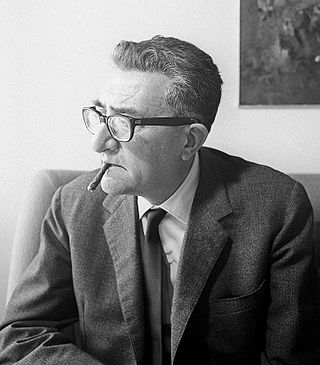 16
Riccardo Lombardi was an Italian politician.
16
Riccardo Lombardi was an Italian politician.
Luigi Longo
 16
Luigi Longo, also known as Gallo, was an Italian communist politician and general secretary of the Italian Communist Party from 1964 to 1972. He was also the first foreigner to be awarded an Order of...
16
Luigi Longo, also known as Gallo, was an Italian communist politician and general secretary of the Italian Communist Party from 1964 to 1972. He was also the first foreigner to be awarded an Order of...
Irma Bandiera
 16
Irma Bandiera (1915–1944) was a member of the seventh Gruppo di azione patriottica. In 1944 she was captured, blinded, and killed. Enrico Berlinguer, of the Italian Communist Party, held her in high...
16
Irma Bandiera (1915–1944) was a member of the seventh Gruppo di azione patriottica. In 1944 she was captured, blinded, and killed. Enrico Berlinguer, of the Italian Communist Party, held her in high...
Anita Garibaldi
 16
Anita Garibaldi was a Brazilian republican revolutionary. She was the wife and comrade-in-arms of Italian revolutionary Giuseppe Garibaldi. Their partnership epitomized the spirit of the 19th...
16
Anita Garibaldi was a Brazilian republican revolutionary. She was the wife and comrade-in-arms of Italian revolutionary Giuseppe Garibaldi. Their partnership epitomized the spirit of the 19th...
Maximilian Kolbe
 16
Maximilian Maria Kolbe was a Polish Catholic priest and Conventual Franciscan friar who volunteered to die in place of a man named Franciszek Gajowniczek in the German death camp of Auschwitz,...
16
Maximilian Maria Kolbe was a Polish Catholic priest and Conventual Franciscan friar who volunteered to die in place of a man named Franciszek Gajowniczek in the German death camp of Auschwitz,...
Napoleon
 16
Napoleon Bonaparte, later known by his regnal name Napoleon I, was a French emperor and military commander who rose to prominence during the French Revolution and led successful campaigns during the...
16
Napoleon Bonaparte, later known by his regnal name Napoleon I, was a French emperor and military commander who rose to prominence during the French Revolution and led successful campaigns during the...
Giorgio Ambrosoli
 16
Giorgio Ambrosoli was an Italian lawyer who was gunned down while investigating the malpractice of banker Michele Sindona.
16
Giorgio Ambrosoli was an Italian lawyer who was gunned down while investigating the malpractice of banker Michele Sindona.
Vittorio Emanuele Orlando
 16
Vittorio Emanuele Orlando was an Italian statesman, who served as the Prime Minister of Italy from October 1917 to June 1919. Orlando is best known for representing Italy in the 1919 Paris Peace...
16
Vittorio Emanuele Orlando was an Italian statesman, who served as the Prime Minister of Italy from October 1917 to June 1919. Orlando is best known for representing Italy in the 1919 Paris Peace...
Helena, mother of Constantine I
 16
Flavia Julia Helena, also known as Helena of Constantinople and in Christianity as Saint Helena, was an Augusta of the Roman Empire and mother of Emperor Constantine the Great. She was born in the...
16
Flavia Julia Helena, also known as Helena of Constantinople and in Christianity as Saint Helena, was an Augusta of the Roman Empire and mother of Emperor Constantine the Great. She was born in the...
Giuseppe Benedetto Cottolengo
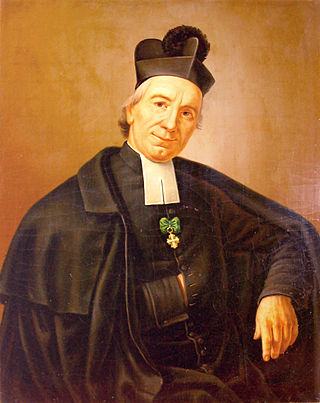 16
Giuseppe Benedetto Cottolengo or Joseph Benedict Cottolengo was the founder of the Little House of Divine Providence and is a saint of the Roman Catholic Church.
16
Giuseppe Benedetto Cottolengo or Joseph Benedict Cottolengo was the founder of the Little House of Divine Providence and is a saint of the Roman Catholic Church.
Pomponio Amalteo
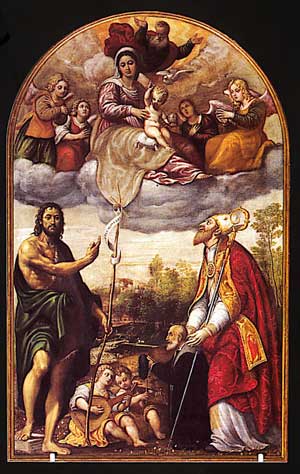 16
Pomponio Amalteo was an Italian painter of the Venetian school.
16
Pomponio Amalteo was an Italian painter of the Venetian school.
Elsa Morante
 16
Elsa Morante was an Italian novelist, poet, translator and children's books author. Her novel La storia (History) is included in the Bokklubben World Library List of 100 Best Books of All Time.
16
Elsa Morante was an Italian novelist, poet, translator and children's books author. Her novel La storia (History) is included in the Bokklubben World Library List of 100 Best Books of All Time.
Alois Negrelli
 15
Nikolaus Alois Maria Vinzenz Negrelli, Ritter von Moldelbe was a Tyrolean civil engineer and railroad pioneer mostly active in parts of the Austrian Empire, Switzerland, Germany and Italy.
15
Nikolaus Alois Maria Vinzenz Negrelli, Ritter von Moldelbe was a Tyrolean civil engineer and railroad pioneer mostly active in parts of the Austrian Empire, Switzerland, Germany and Italy.
Giovanni Agnelli
 15
Giovanni Agnelli was an Italian businessman who founded the Fiat S.p.A. car manufacturing in 1899.
15
Giovanni Agnelli was an Italian businessman who founded the Fiat S.p.A. car manufacturing in 1899.
Augusto Murri
 15
Augusto Murri was an Italian physician. Appointed to the Chair of Clinical Medicine at the University of Bologna in 1875, he was regarded as one of the most illustrious clinical doctors and...
15
Augusto Murri was an Italian physician. Appointed to the Chair of Clinical Medicine at the University of Bologna in 1875, he was regarded as one of the most illustrious clinical doctors and...
Eugenio Villoresi
 15
Eugenio Villoresi è stato un ingegnere italiano.
Progettò il canale - che da lui prese il nome - che collega il Ticino all'Adda. È conosciuto nell'ambiente scientifico italiano anche per essere stato...
15
Eugenio Villoresi è stato un ingegnere italiano.
Progettò il canale - che da lui prese il nome - che collega il Ticino all'Adda. È conosciuto nell'ambiente scientifico italiano anche per essere stato...
Guglielmo Massaia
 15
Guglielmo Massaia, OFM Cap. was an Italian cardinal of the Catholic Church who served as a missionary and a Capuchin friar.
15
Guglielmo Massaia, OFM Cap. was an Italian cardinal of the Catholic Church who served as a missionary and a Capuchin friar.
Pietro Colletta
 15
Pietro Colletta was a Neapolitan general and historian, entered the Neapolitan artillery in 1796 and took part in the campaign against the French in 1798.
15
Pietro Colletta was a Neapolitan general and historian, entered the Neapolitan artillery in 1796 and took part in the campaign against the French in 1798.
Francis of Paola
 15
Francis of Paola, OM, was an Italian Catholic friar and the founder of the Order of Minims. Unlike the majority of founders of men's religious orders, and like his patron saint Francis of Assisi, he...
15
Francis of Paola, OM, was an Italian Catholic friar and the founder of the Order of Minims. Unlike the majority of founders of men's religious orders, and like his patron saint Francis of Assisi, he...
Leonida Bissolati
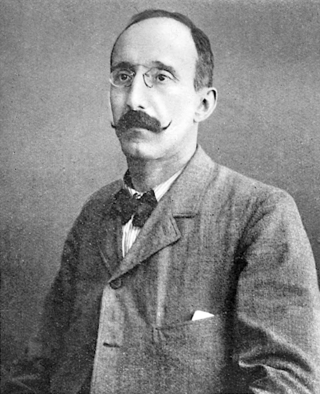 15
Leonida Bissolati was a leading exponent of the Italian socialist movement at the turn of the nineteenth century.
15
Leonida Bissolati was a leading exponent of the Italian socialist movement at the turn of the nineteenth century.
Charles Darwin
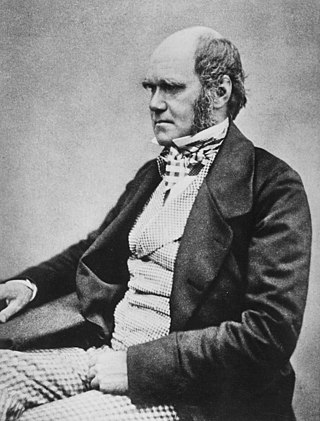 15
Charles Robert Darwin was an English naturalist, geologist and biologist, widely known for his contributions to evolutionary biology. His proposition that all species of life have descended from a...
15
Charles Robert Darwin was an English naturalist, geologist and biologist, widely known for his contributions to evolutionary biology. His proposition that all species of life have descended from a...
Pope Leo XIII
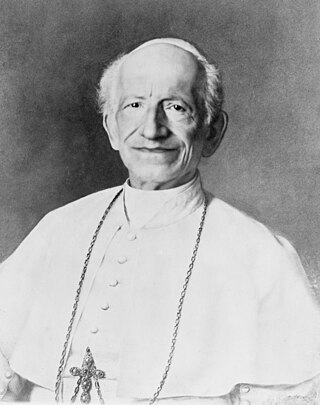 15
Pope Leo XIII was head of the Catholic Church from 20 February 1878 until his death in July 1903. Living until the age of 93, he was the oldest pope, whose age can be validated, holding office, and...
15
Pope Leo XIII was head of the Catholic Church from 20 February 1878 until his death in July 1903. Living until the age of 93, he was the oldest pope, whose age can be validated, holding office, and...
Gerolamo Cardano
 15
Gerolamo Cardano was an Italian polymath whose interests and proficiencies ranged through those of mathematician, physician, biologist, physicist, chemist, astrologer, astronomer, philosopher,...
15
Gerolamo Cardano was an Italian polymath whose interests and proficiencies ranged through those of mathematician, physician, biologist, physicist, chemist, astrologer, astronomer, philosopher,...
Ippolito Pindemonte
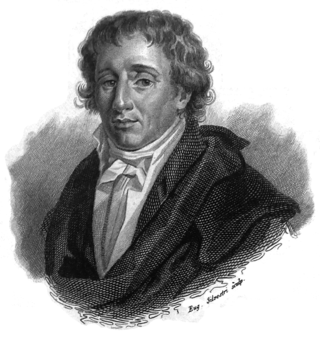 15
Ippolito Pindemonte was an Italian poet.
He was an exponent of Italian neoclassicism and pre-romanticism, with poems of the pastoral genre and related to graveyard poets style.
15
Ippolito Pindemonte was an Italian poet.
He was an exponent of Italian neoclassicism and pre-romanticism, with poems of the pastoral genre and related to graveyard poets style.
Benedetto Marcello
 15
Benedetto Giacomo Marcello was an Italian composer, writer, advocate, magistrate, and teacher.
15
Benedetto Giacomo Marcello was an Italian composer, writer, advocate, magistrate, and teacher.
Giovanni Fattori
 15
Giovanni Fattori was an Italian artist, one of the leaders of the group known as the Macchiaioli. He was initially a painter of historical themes and military subjects. In his middle years, inspired...
15
Giovanni Fattori was an Italian artist, one of the leaders of the group known as the Macchiaioli. He was initially a painter of historical themes and military subjects. In his middle years, inspired...
Bettino Ricasoli
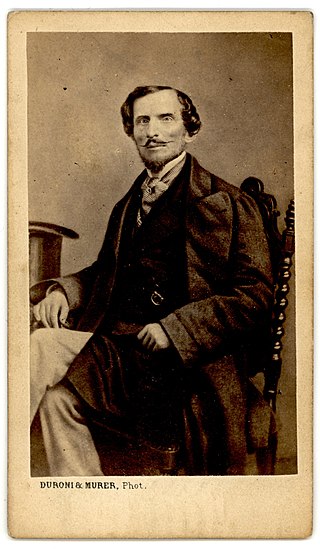 15
Bettino Ricasoli, 1st Count of Brolio, 2nd Baron Ricasoli was an Italian statesman. He was a central figure in the politics of Italy during and after the unification of Italy. He led the Moderate...
15
Bettino Ricasoli, 1st Count of Brolio, 2nd Baron Ricasoli was an Italian statesman. He was a central figure in the politics of Italy during and after the unification of Italy. He led the Moderate...
Pier Luigi Nervi
 15
Pier Luigi Nervi was an Italian engineer and architect. He studied at the University of Bologna graduating in 1913. Nervi taught as a professor of engineering at Rome University from 1946 to 1961 and...
15
Pier Luigi Nervi was an Italian engineer and architect. He studied at the University of Bologna graduating in 1913. Nervi taught as a professor of engineering at Rome University from 1946 to 1961 and...
Luigi Vanvitelli
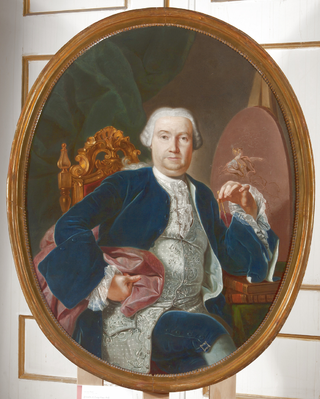 15
Luigi Vanvitelli, known in Dutch as Lodewijk van Wittel, was an Italian architect and painter. The most prominent 18th-century architect of Italy, he practised a sober classicising academic Late...
15
Luigi Vanvitelli, known in Dutch as Lodewijk van Wittel, was an Italian architect and painter. The most prominent 18th-century architect of Italy, he practised a sober classicising academic Late...
Isidore the Laborer
 15
Isidore the Laborer, also known as Isidore the Farmer, was a Spanish farmworker known for his piety toward the poor and animals. He is the Catholic patron saint of farmers, and of Madrid; El...
15
Isidore the Laborer, also known as Isidore the Farmer, was a Spanish farmworker known for his piety toward the poor and animals. He is the Catholic patron saint of farmers, and of Madrid; El...
Agostino Novella
 15
Agostino Novella was an Italian trade unionist and communist politician.
15
Agostino Novella was an Italian trade unionist and communist politician.
Euclid
 15
Euclid was an ancient Greek mathematician active as a geometer and logician. Considered the "father of geometry", he is chiefly known for the Elements treatise, which established the foundations of...
15
Euclid was an ancient Greek mathematician active as a geometer and logician. Considered the "father of geometry", he is chiefly known for the Elements treatise, which established the foundations of...
Alfred Nobel
 15
Alfred Bernhard Nobel was a Swedish chemist, inventor, engineer and businessman. He is known for inventing dynamite as well as having bequeathed his fortune to establish the Nobel Prize. He also made...
15
Alfred Bernhard Nobel was a Swedish chemist, inventor, engineer and businessman. He is known for inventing dynamite as well as having bequeathed his fortune to establish the Nobel Prize. He also made...
Concetto Marchesi
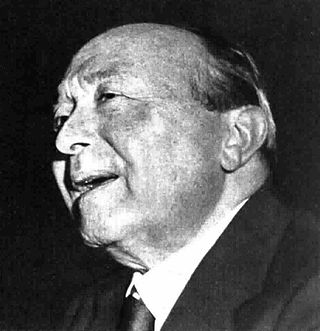 15
Concetto Marchesi was an Italian politician. He represented the Italian Communist Party in the Constituent Assembly of Italy from 1946 to 1948 and in the Chamber of Deputies from 1948 to 1957.
15
Concetto Marchesi was an Italian politician. He represented the Italian Communist Party in the Constituent Assembly of Italy from 1946 to 1948 and in the Chamber of Deputies from 1948 to 1957.
Sibilla Aleramo
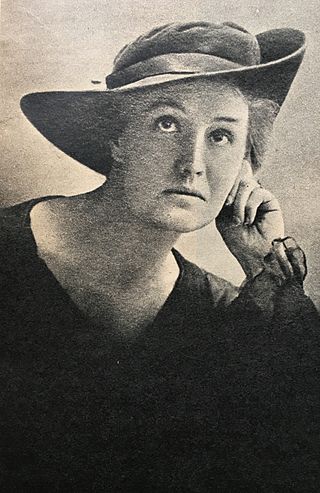 15
Sibilla Aleramo was an Italian feminist writer and poet best known for her autobiographical depictions of life as a woman in late 19th century Italy.
15
Sibilla Aleramo was an Italian feminist writer and poet best known for her autobiographical depictions of life as a woman in late 19th century Italy.
Ilaria Alpi
 15
Ilaria Alpi was an Italian journalist killed in Mogadishu, Somalia, together with her camera operator Miran Hrovatin. In 2009 Francesco Fonti, a former 'Ndrangheta member, claimed that Ilaria Alpi...
15
Ilaria Alpi was an Italian journalist killed in Mogadishu, Somalia, together with her camera operator Miran Hrovatin. In 2009 Francesco Fonti, a former 'Ndrangheta member, claimed that Ilaria Alpi...
Luigi Boccherini
 15
Ridolfo Luigi Boccherini was an Italian composer and cellist of the Classical era whose music retained a courtly and galante style even while he matured somewhat apart from the major European musical...
15
Ridolfo Luigi Boccherini was an Italian composer and cellist of the Classical era whose music retained a courtly and galante style even while he matured somewhat apart from the major European musical...
Gregorio Agnini
 15
Gregorio Agnini è stato un politico e imprenditore italiano.
15
Gregorio Agnini è stato un politico e imprenditore italiano.
Giuseppe Fanin
 14
Giuseppe Fanin è stato un sindacalista italiano.
14
Giuseppe Fanin è stato un sindacalista italiano.
Maria Gaetana Agnesi
 14
Maria Gaetana Agnesi was an Italian mathematician, philosopher, theologian, and humanitarian. She was the first woman to write a mathematics handbook and the first woman appointed as a mathematics...
14
Maria Gaetana Agnesi was an Italian mathematician, philosopher, theologian, and humanitarian. She was the first woman to write a mathematics handbook and the first woman appointed as a mathematics...
Carlo Armellini
 14
Carlo Armellini was a Roman politician, activist and jurist.
He was part of the triumvirate leading the short-lived Roman Republic in 1849, together with Giuseppe Mazzini and Aurelio Saffi.
14
Carlo Armellini was a Roman politician, activist and jurist.
He was part of the triumvirate leading the short-lived Roman Republic in 1849, together with Giuseppe Mazzini and Aurelio Saffi.
Luca Signorelli
 14
Luca Signorelli was an Italian Renaissance painter from Cortona, in Tuscany, who was noted in particular for his ability as a draftsman and his use of foreshortening. His massive frescos of the Last...
14
Luca Signorelli was an Italian Renaissance painter from Cortona, in Tuscany, who was noted in particular for his ability as a draftsman and his use of foreshortening. His massive frescos of the Last...
Apollinaris of Ravenna
 14
Apollinaris of Ravenna is a Syrian saint, whom the Roman Martyrology describes as "a bishop who, according to tradition, while spreading among the nations the unsearchable riches of Christ, led his...
14
Apollinaris of Ravenna is a Syrian saint, whom the Roman Martyrology describes as "a bishop who, according to tradition, while spreading among the nations the unsearchable riches of Christ, led his...
Pasquale Paoli
 14
Filippo Antonio Pasquale de' Paoli was a Corsican patriot, statesman, and military leader who was at the forefront of resistance movements against the Genoese and later French rule over the island....
14
Filippo Antonio Pasquale de' Paoli was a Corsican patriot, statesman, and military leader who was at the forefront of resistance movements against the Genoese and later French rule over the island....
Luigi Rizzo
 14
Luigi Rizzo, 1st Count of Grado and Premuda (1887–1951), nicknamed the Sinker, was an Italian admiral. He is mostly known for his distinguished service in World War I; as a torpedo boat commander...
14
Luigi Rizzo, 1st Count of Grado and Premuda (1887–1951), nicknamed the Sinker, was an Italian admiral. He is mostly known for his distinguished service in World War I; as a torpedo boat commander...
Antonio Stradivari
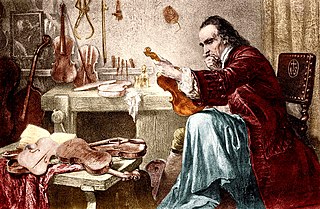 14
Antonio Stradivari was an Italian luthier and a craftsman of string instruments such as violins, cellos, guitars, violas and harps. The Latinized form of his surname, Stradivarius, as well as the...
14
Antonio Stradivari was an Italian luthier and a craftsman of string instruments such as violins, cellos, guitars, violas and harps. The Latinized form of his surname, Stradivarius, as well as the...
Duccio Galimberti
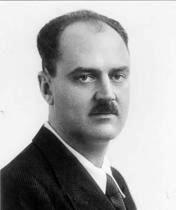 14
Tancredi Achille Giuseppe Olimpio "Duccio" Galimberti was an Italian lawyer who became a committed anti-fascist and war-time partisan. He was an important figure – according to some sources the most...
14
Tancredi Achille Giuseppe Olimpio "Duccio" Galimberti was an Italian lawyer who became a committed anti-fascist and war-time partisan. He was an important figure – according to some sources the most...
Giovanni Spadolini
 14
Giovanni Spadolini was an Italian politician and statesman, who served as the 44th prime minister of Italy. He had been a leading figure in the Republican Party and the first head of a government to...
14
Giovanni Spadolini was an Italian politician and statesman, who served as the 44th prime minister of Italy. He had been a leading figure in the Republican Party and the first head of a government to...
Domenico Morelli
 14
Domenico Morelli was an Italian painter, who mainly produced historical and religious works. Morelli was immensely influential in the arts of the second half of the 19th century, both as director of...
14
Domenico Morelli was an Italian painter, who mainly produced historical and religious works. Morelli was immensely influential in the arts of the second half of the 19th century, both as director of...
Gervasius and Protasius
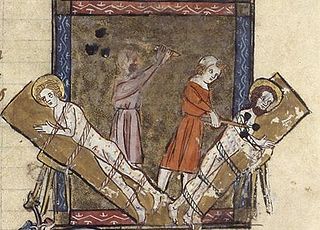 14
Gervasius and Protasius are venerated as Christian martyrs, probably of the 2nd century. They are the patron saints of Milan and of haymakers and are invoked for the discovery of thieves. Their feast...
14
Gervasius and Protasius are venerated as Christian martyrs, probably of the 2nd century. They are the patron saints of Milan and of haymakers and are invoked for the discovery of thieves. Their feast...
Ruggero Grieco
 14
Ruggero Grieco was an Italian politician, antifascist, and member of the Italian Communist Party. He was born in Foggia, Apulia.
14
Ruggero Grieco was an Italian politician, antifascist, and member of the Italian Communist Party. He was born in Foggia, Apulia.
Guercino
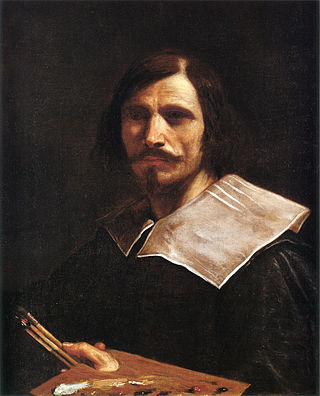 14
Giovanni Francesco Barbieri, better known as (il) Guercino, was an Italian Baroque painter and draftsman from Cento in the Emilia region, who was active in Rome and Bologna. The vigorous naturalism...
14
Giovanni Francesco Barbieri, better known as (il) Guercino, was an Italian Baroque painter and draftsman from Cento in the Emilia region, who was active in Rome and Bologna. The vigorous naturalism...
Marcello Malpighi
 14
Marcello Malpighi was an Italian biologist and physician, who is referred to as the "Founder of microscopical anatomy, histology & Father of physiology and embryology". Malpighi's name is borne by...
14
Marcello Malpighi was an Italian biologist and physician, who is referred to as the "Founder of microscopical anatomy, histology & Father of physiology and embryology". Malpighi's name is borne by...
Tacitus
 14
Publius Cornelius Tacitus, known simply as Tacitus, was a Roman historian and politician. Tacitus is widely regarded as one of the greatest Roman historians by modern scholars.
14
Publius Cornelius Tacitus, known simply as Tacitus, was a Roman historian and politician. Tacitus is widely regarded as one of the greatest Roman historians by modern scholars.
Pasquale Tola
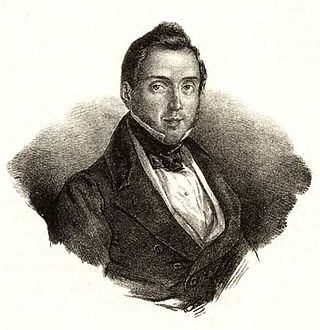 14
Pasquale Tola was an Italian judge, politician and historian.
14
Pasquale Tola was an Italian judge, politician and historian.
Rosario Livatino
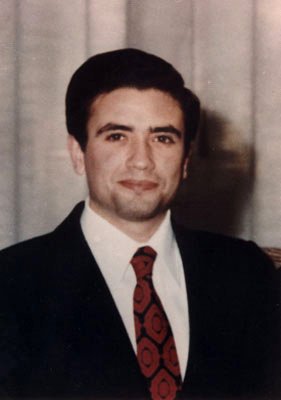 14
Rosario Angelo Livatino was an Italian magistrate who was killed by Stidda.
14
Rosario Angelo Livatino was an Italian magistrate who was killed by Stidda.
Giuseppe Impastato
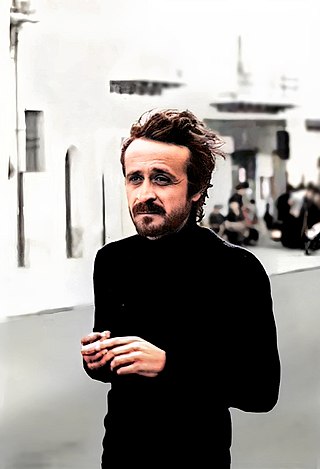 14
Giuseppe "Peppino" Impastato, was an Italian political activist who opposed the Mafia, which ordered his murder in 1978.
14
Giuseppe "Peppino" Impastato, was an Italian political activist who opposed the Mafia, which ordered his murder in 1978.
Giuseppe Sirtori
 14
Giuseppe Sirtori was an Italian soldier, patriot and politician who fought in the unification of Italy.
14
Giuseppe Sirtori was an Italian soldier, patriot and politician who fought in the unification of Italy.
Martha
 14
Martha is a biblical figure described in the Gospels of Luke and John. Together with her siblings Lazarus and Mary of Bethany, she is described as living in the village of Bethany near Jerusalem. She...
14
Martha is a biblical figure described in the Gospels of Luke and John. Together with her siblings Lazarus and Mary of Bethany, she is described as living in the village of Bethany near Jerusalem. She...
Salvatore Farina
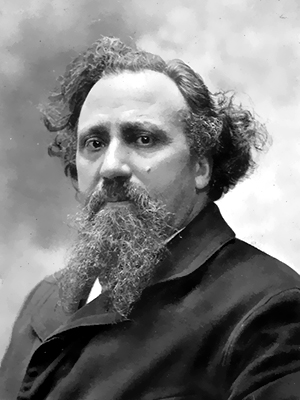 14
Salvatore Farina was an Italian novelist whose style of sentimental humor has been compared to that of Charles Dickens.
He was nominated for the Nobel Prize in Literature three times.
14
Salvatore Farina was an Italian novelist whose style of sentimental humor has been compared to that of Charles Dickens.
He was nominated for the Nobel Prize in Literature three times.
Bartolomeo Colleoni
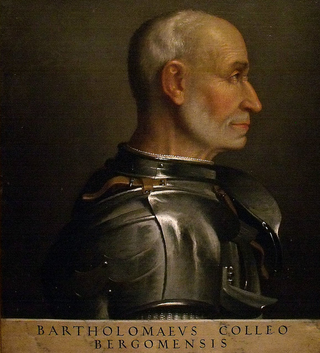 14
Bartolomeo Colleoni was an Italian condottiero, who became captain-general of the Republic of Venice. Colleoni "gained reputation as the foremost tactician and disciplinarian of the 15th century". He...
14
Bartolomeo Colleoni was an Italian condottiero, who became captain-general of the Republic of Venice. Colleoni "gained reputation as the foremost tactician and disciplinarian of the 15th century". He...
Renzo Laconi
 14
Renzo Laconi è stato un politico italiano.
14
Renzo Laconi è stato un politico italiano.
Umberto Nobile
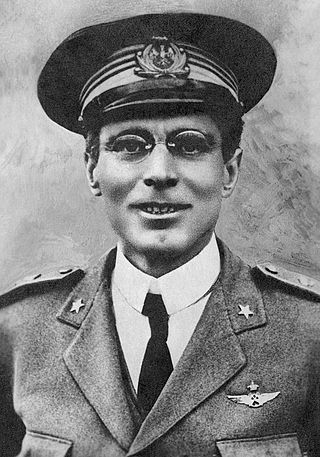 14
Umberto Nobile was an Italian aviator, aeronautical engineer and Arctic explorer.
14
Umberto Nobile was an Italian aviator, aeronautical engineer and Arctic explorer.
Carlo Levi
 14
Carlo Levi was an Italian painter, writer, activist, independent leftist politician, and doctor.
14
Carlo Levi was an Italian painter, writer, activist, independent leftist politician, and doctor.
Antonio Sant'Elia
 14
Antonio Sant'Elia was an Italian architect and a key member of the Futurist movement in architecture. He left behind almost no completed works of architecture and is primarily remembered for his bold...
14
Antonio Sant'Elia was an Italian architect and a key member of the Futurist movement in architecture. He left behind almost no completed works of architecture and is primarily remembered for his bold...
Pacifico Valussi
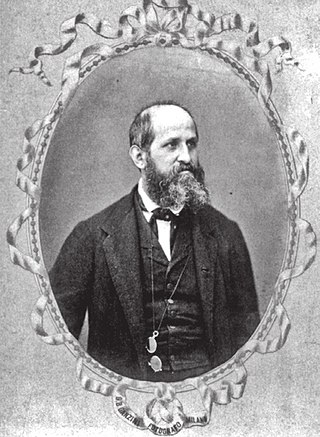 14
Pacifico Valussi è stato un giornalista e politico italiano.
14
Pacifico Valussi è stato un giornalista e politico italiano.
Ermes di Colorêt
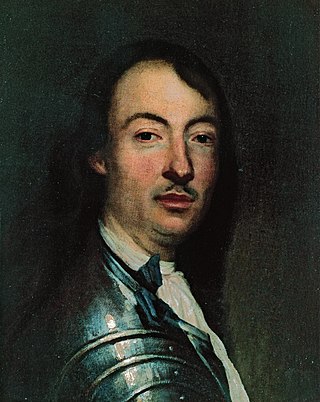 14
Ermes di Colloredo was an Italian count and writer who served the Grand Duke of Tuscany, the Holy Roman Emperor and the Republic of Venice. He is widely considered the father and innovator of...
14
Ermes di Colloredo was an Italian count and writer who served the Grand Duke of Tuscany, the Holy Roman Emperor and the Republic of Venice. He is widely considered the father and innovator of...
Giovannino Guareschi
 14
Giovannino Oliviero Giuseppe Guareschi was an Italian journalist, cartoonist and humorist whose best known creation is the priest Don Camillo.
14
Giovannino Oliviero Giuseppe Guareschi was an Italian journalist, cartoonist and humorist whose best known creation is the priest Don Camillo.
Charles Felix of Sardinia
 13
Charles Felix was the King of Sardinia and ruler of the Savoyard states from 12 March 1821 until his death in 1831. He was the last male-line member of the House of Savoy that started with Victor...
13
Charles Felix was the King of Sardinia and ruler of the Savoyard states from 12 March 1821 until his death in 1831. He was the last male-line member of the House of Savoy that started with Victor...
Sidney Sonnino
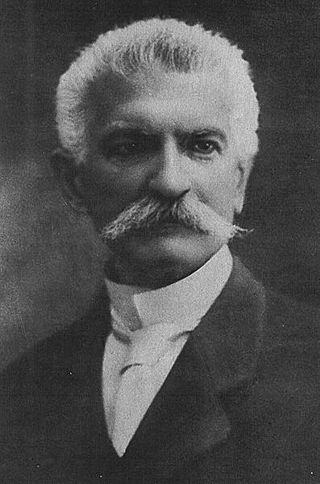 13
Sidney Costantino, Baron Sonnino was an Italian statesman, 19th prime minister of Italy and twice served briefly as one, in 1906 and again from 1909 to 1910. He also was the Italian minister of...
13
Sidney Costantino, Baron Sonnino was an Italian statesman, 19th prime minister of Italy and twice served briefly as one, in 1906 and again from 1909 to 1910. He also was the Italian minister of...
Emanuele Filiberto of Savoy, Prince of Venice
 13
Emanuele Filiberto Umberto Reza Ciro René Maria di Savoia is a member of the House of Savoy. He is the son of Vittorio Emanuele of Savoy and only male-line grandson of Umberto II, the last King of...
13
Emanuele Filiberto Umberto Reza Ciro René Maria di Savoia is a member of the House of Savoy. He is the son of Vittorio Emanuele of Savoy and only male-line grandson of Umberto II, the last King of...
Arnold of Brescia
 13
Arnold of Brescia, also known as Arnaldus, an Italian canon regular from Lombardy, called on the Church to renounce property-ownership and participated in the failed Commune of Rome of 1144–1193.
13
Arnold of Brescia, also known as Arnaldus, an Italian canon regular from Lombardy, called on the Church to renounce property-ownership and participated in the failed Commune of Rome of 1144–1193.
Giovanni Matteo Mario
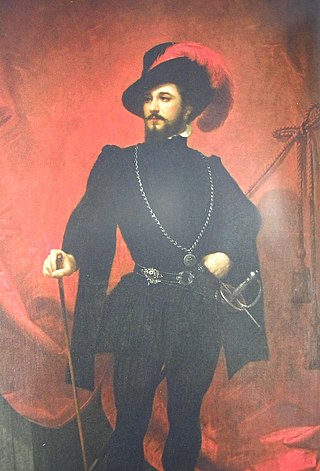 13
Giovanni Matteo De Candia, also known as Mario, was an Italian opera singer. The most celebrated tenor of his era, he was lionized by audiences in Paris and London. He was the partner of the opera...
13
Giovanni Matteo De Candia, also known as Mario, was an Italian opera singer. The most celebrated tenor of his era, he was lionized by audiences in Paris and London. He was the partner of the opera...
Giulio Natta
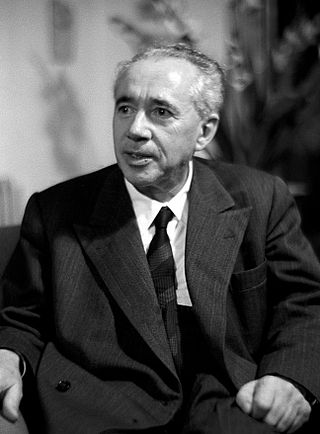 13
Giulio Natta was an Italian chemical engineer and Nobel laureate. He won a Nobel Prize in Chemistry in 1963 with Karl Ziegler for work on high polymers. He also received a Lomonosov Gold Medal in...
13
Giulio Natta was an Italian chemical engineer and Nobel laureate. He won a Nobel Prize in Chemistry in 1963 with Karl Ziegler for work on high polymers. He also received a Lomonosov Gold Medal in...
Giovanni Palatucci
 13
Giovanni Palatucci was an Italian police official who was long believed to have saved thousands of Jews in Fiume between 1939 and 1944 from being deported to Nazi extermination camps. In 2013 a...
13
Giovanni Palatucci was an Italian police official who was long believed to have saved thousands of Jews in Fiume between 1939 and 1944 from being deported to Nazi extermination camps. In 2013 a...
Primo Mazzolari
 13
Primo Mazzolari, best known as don Primo, was an Italian priest of the Catholic Church. He was also a partisan and writer who established the review Adesso ("Now") in 1949.
13
Primo Mazzolari, best known as don Primo, was an Italian priest of the Catholic Church. He was also a partisan and writer who established the review Adesso ("Now") in 1949.
Vittore Carpaccio
 13
Vittore Carpaccio (UK: /kɑːrˈpætʃ oʊ/, US: /-ˈpɑːtʃ-/, Italian: [vitˈtoːre karˈpattʃo]; was an Italian painter of the Venetian school who studied under Gentile Bellini. Carpaccio was largely...
13
Vittore Carpaccio (UK: /kɑːrˈpætʃ oʊ/, US: /-ˈpɑːtʃ-/, Italian: [vitˈtoːre karˈpattʃo]; was an Italian painter of the Venetian school who studied under Gentile Bellini. Carpaccio was largely...
Giovanni Nicotera
 13
Giovanni Nicotera was an Italian patriot and politician. His surname is pronounced, with the stress on the second syllable.
13
Giovanni Nicotera was an Italian patriot and politician. His surname is pronounced, with the stress on the second syllable.
Cesare Lombroso
 13
Cesare Lombroso was an Italian eugenicist, criminologist, phrenologist, physician, and founder of the Italian school of criminology. He is considered the founder of modern criminal anthropology by...
13
Cesare Lombroso was an Italian eugenicist, criminologist, phrenologist, physician, and founder of the Italian school of criminology. He is considered the founder of modern criminal anthropology by...
Costantino Nigra
 13
Lorenzo Annibale Costantino Nigra, Count of Villa Castelnuovo, was an Italian nobleman, philologist, poet, diplomat, and politician. Among the several positions he held and political and foreign...
13
Lorenzo Annibale Costantino Nigra, Count of Villa Castelnuovo, was an Italian nobleman, philologist, poet, diplomat, and politician. Among the several positions he held and political and foreign...
Tomaso Albinoni
 13
Tomaso Giovanni Albinoni was an Italian composer of the Baroque era. His output includes operas, concertos, sonatas for one to six instruments, sinfonias, and solo cantatas. While famous in his day...
13
Tomaso Giovanni Albinoni was an Italian composer of the Baroque era. His output includes operas, concertos, sonatas for one to six instruments, sinfonias, and solo cantatas. While famous in his day...
Giovanni Berchet
 13
Giovanni Berchet was an Italian poet and patriot. He wrote an influential manifesto on Italian Romanticism, Lettera semiseria di Grisostomo, which appeared in 1816, and contributed to Il...
13
Giovanni Berchet was an Italian poet and patriot. He wrote an influential manifesto on Italian Romanticism, Lettera semiseria di Grisostomo, which appeared in 1816, and contributed to Il...
Giuseppe Tartini
 13
Giuseppe Tartini was an Italian composer and violinist of the Baroque era born in Pirano in the Republic of Venice. Tartini was a prolific composer, composing over a hundred pieces for the violin,...
13
Giuseppe Tartini was an Italian composer and violinist of the Baroque era born in Pirano in the Republic of Venice. Tartini was a prolific composer, composing over a hundred pieces for the violin,...
Giacomo Barozzi da Vignola
 13
Giacomo Barozzi da Vignola, often simply called Vignola, was one of the great Italian architects of 16th century Mannerism. His two great masterpieces are the Villa Farnese at Caprarola and the...
13
Giacomo Barozzi da Vignola, often simply called Vignola, was one of the great Italian architects of 16th century Mannerism. His two great masterpieces are the Villa Farnese at Caprarola and the...
Pietro Giannone
 13
Pietro Giannone was an Italian philosopher, historian and jurist born in Ischitella, in the province of Foggia. He opposed the papal influence in Naples, for which he was excommunicated and...
13
Pietro Giannone was an Italian philosopher, historian and jurist born in Ischitella, in the province of Foggia. He opposed the papal influence in Naples, for which he was excommunicated and...
Marie Curie
 13
Maria Salomea Skłodowska-Curie, known simply as Marie Curie, was a Polish and naturalised-French physicist and chemist who conducted pioneering research on radioactivity. She was the first woman to...
13
Maria Salomea Skłodowska-Curie, known simply as Marie Curie, was a Polish and naturalised-French physicist and chemist who conducted pioneering research on radioactivity. She was the first woman to...
Saint Florian
 13
Florian was a Christian holy man and the patron saint of chimney sweeps; soapmakers, and firefighters. His feast day is 4 May. Florian is also the patron saint of Poland, the city of Linz, Austria,...
13
Florian was a Christian holy man and the patron saint of chimney sweeps; soapmakers, and firefighters. His feast day is 4 May. Florian is also the patron saint of Poland, the city of Linz, Austria,...
Elio Vittorini
 13
Elio Vittorini was an Italian writer and novelist. He was a contemporary of Cesare Pavese and an influential voice in the modernist school of novel writing. His best-known work, in English speaking...
13
Elio Vittorini was an Italian writer and novelist. He was a contemporary of Cesare Pavese and an influential voice in the modernist school of novel writing. His best-known work, in English speaking...
Luciano Lama
 13
Luciano Lama was an Italian trade unionist and politician, General Secretary of Italian General Confederation of Labour from 1970 to 1986.
13
Luciano Lama was an Italian trade unionist and politician, General Secretary of Italian General Confederation of Labour from 1970 to 1986.
Fernando Santi
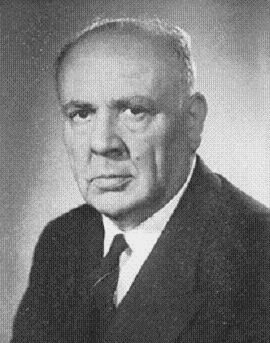 13
Fernando Santi è stato un sindacalista e politico italiano.
Fu un sindacalista riformista sebbene la sua formazione sia avvenuta in una delle realtà più feconde del sindacalismo rivoluzionario....
13
Fernando Santi è stato un sindacalista e politico italiano.
Fu un sindacalista riformista sebbene la sua formazione sia avvenuta in una delle realtà più feconde del sindacalismo rivoluzionario....
Adriano Olivetti
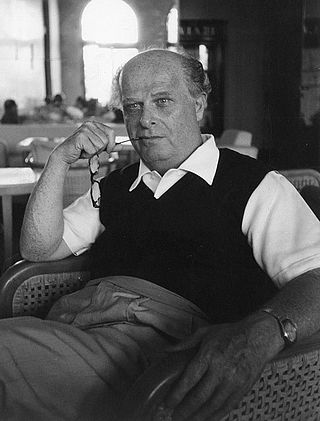 13
Adriano Olivetti was an Italian engineer, entrepreneur, politician, and industrialist. He was known worldwide during his lifetime as the Italian manufacturer of Olivetti brand typewriters,...
13
Adriano Olivetti was an Italian engineer, entrepreneur, politician, and industrialist. He was known worldwide during his lifetime as the Italian manufacturer of Olivetti brand typewriters,...
Tazio Nuvolari
 13
Tazio Giorgio Nuvolari was an Italian racing driver. He first raced motorcycles and then concentrated on sports cars and Grand Prix racing. Originally of Mantua, he was nicknamed Il Mantovano Volante...
13
Tazio Giorgio Nuvolari was an Italian racing driver. He first raced motorcycles and then concentrated on sports cars and Grand Prix racing. Originally of Mantua, he was nicknamed Il Mantovano Volante...
Giuseppe Andreoli (patriota)
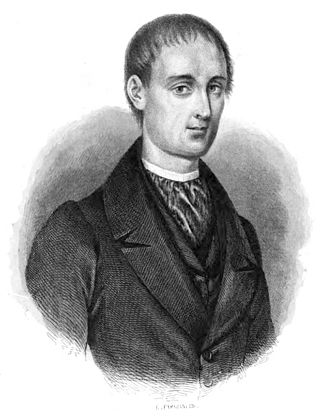 13
Giuseppe Andreoli è stato un presbitero e patriota italiano.
13
Giuseppe Andreoli è stato un presbitero e patriota italiano.
Matilda of Tuscany
 13
Matilda of Tuscany, also referred to as la Gran Contessa, was a member of the House of Canossa in the second half of the eleventh century. Matilda was one of the most important governing figures of...
13
Matilda of Tuscany, also referred to as la Gran Contessa, was a member of the House of Canossa in the second half of the eleventh century. Matilda was one of the most important governing figures of...
Ignatius of Loyola
 13
Ignatius of Loyola, venerated as Saint Ignatius of Loyola, was a Spanish Catholic priest and theologian, who, with six companions, founded the religious order of the Society of Jesus (Jesuits), and...
13
Ignatius of Loyola, venerated as Saint Ignatius of Loyola, was a Spanish Catholic priest and theologian, who, with six companions, founded the religious order of the Society of Jesus (Jesuits), and...
Vincenzo Sulis
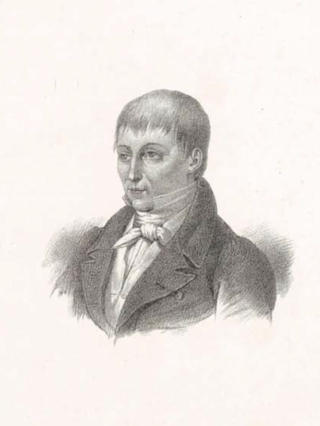 13
Vincenzo Sulis è stato uno scrittore e militare italiano del Regno di Sardegna.
13
Vincenzo Sulis è stato uno scrittore e militare italiano del Regno di Sardegna.
Marco d'Aviano
 13
Mark of Aviano, born Carlo Domenico Cristofori was an Italian Capuchin friar. In 2003, he was beatified by Pope John Paul II.
13
Mark of Aviano, born Carlo Domenico Cristofori was an Italian Capuchin friar. In 2003, he was beatified by Pope John Paul II.
Pio Paschini
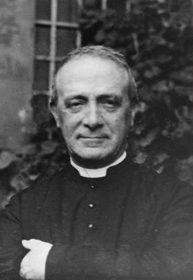 13
Pio Paschini è stato un vescovo cattolico e storico italiano.
13
Pio Paschini è stato un vescovo cattolico e storico italiano.
Salvatore Cambosu
 13
Salvatore Cambosu è stato uno scrittore e giornalista italiano.
13
Salvatore Cambosu è stato uno scrittore e giornalista italiano.
Giorgio de Chirico
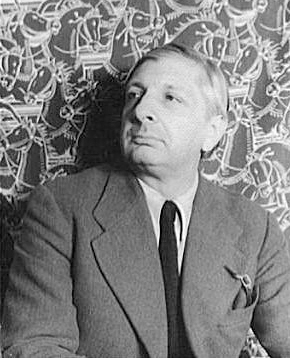 13
Giuseppe Maria Alberto Giorgio de Chirico was an Italian artist and writer born in Greece. In the years before World War I, he founded the scuola metafisica art movement, which profoundly influenced...
13
Giuseppe Maria Alberto Giorgio de Chirico was an Italian artist and writer born in Greece. In the years before World War I, he founded the scuola metafisica art movement, which profoundly influenced...
Ruggero Settimo
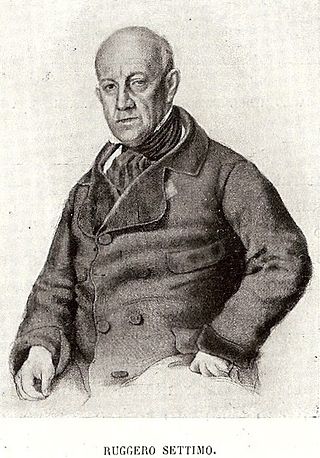 12
Ruggero Settimo was an Italian politician, diplomat, and patriotic activist from Sicily. He was a counter-admiral of the Sicilian Fleet. He fought alongside the British fleet in the Mediterranean Sea...
12
Ruggero Settimo was an Italian politician, diplomat, and patriotic activist from Sicily. He was a counter-admiral of the Sicilian Fleet. He fought alongside the British fleet in the Mediterranean Sea...
Camillus de Lellis
 12
Camillus de Lellis, M.I., was a Roman Catholic priest from Italy who founded the Camillians, a religious order dedicated to the care of the sick. He was beatified by Pope Benedict XIV in the year...
12
Camillus de Lellis, M.I., was a Roman Catholic priest from Italy who founded the Camillians, a religious order dedicated to the care of the sick. He was beatified by Pope Benedict XIV in the year...
Felice Orsini
 12
Felice Orsini was an Italian revolutionary and leader of the Carbonari who tried to assassinate Napoleon III, Emperor of the French.
12
Felice Orsini was an Italian revolutionary and leader of the Carbonari who tried to assassinate Napoleon III, Emperor of the French.
Giorgio Vasari
 12
Giorgio Vasari was an Italian Renaissance painter and architect, who is best known for his work Lives of the Most Excellent Painters, Sculptors, and Architects, considered the ideological foundation...
12
Giorgio Vasari was an Italian Renaissance painter and architect, who is best known for his work Lives of the Most Excellent Painters, Sculptors, and Architects, considered the ideological foundation...
Saint Pantaleon
 12
Saint Pantaleon, counted in Western Christianity as among the Fourteen Holy Helpers of the Late Middle Ages, and in Eastern Christianity as one of the Holy Unmercenary Healers, was a martyr of...
12
Saint Pantaleon, counted in Western Christianity as among the Fourteen Holy Helpers of the Late Middle Ages, and in Eastern Christianity as one of the Holy Unmercenary Healers, was a martyr of...
Andrea Maffei
 12
Andrea Maffei was an Italian poet, translator and librettist. He was born in Molina di Ledro, Trentino. A follower of Vincenzo Monti, he formed part of the 19th-century Italian classicist literary...
12
Andrea Maffei was an Italian poet, translator and librettist. He was born in Molina di Ledro, Trentino. A follower of Vincenzo Monti, he formed part of the 19th-century Italian classicist literary...
Francesco Redi
 12
Francesco Redi was an Italian physician, naturalist, biologist, and poet. He is referred to as the "founder of experimental biology", and as the "father of modern parasitology". He was the first...
12
Francesco Redi was an Italian physician, naturalist, biologist, and poet. He is referred to as the "founder of experimental biology", and as the "father of modern parasitology". He was the first...
Decio Raggi
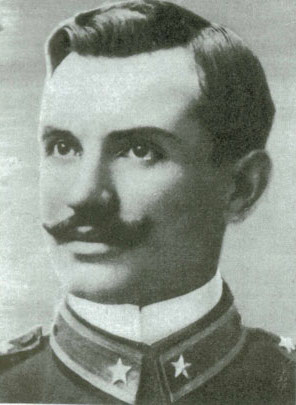 12
Decio Raggi è stato un militare italiano, primo decorato con medaglia d'oro al valor militare nella Grande Guerra. Tenente dell'esercito italiano, alfiere di gloria della Brigata Casale, il...
12
Decio Raggi è stato un militare italiano, primo decorato con medaglia d'oro al valor militare nella Grande Guerra. Tenente dell'esercito italiano, alfiere di gloria della Brigata Casale, il...
Umberto Boccioni
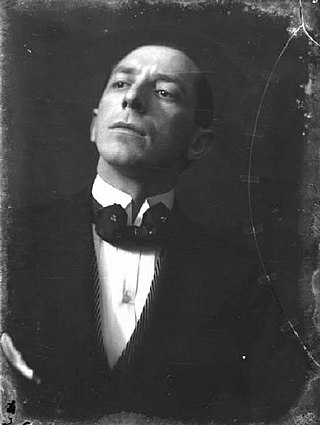 12
Umberto Boccioni was an influential Italian painter and sculptor. He helped shape the revolutionary aesthetic of the Futurism movement as one of its principal figures. Despite his short life, his...
12
Umberto Boccioni was an influential Italian painter and sculptor. He helped shape the revolutionary aesthetic of the Futurism movement as one of its principal figures. Despite his short life, his...
Emilio Salgari
 12
Emilio Salgari was an Italian writer of action adventure swashbucklers and a pioneer of science fiction.
12
Emilio Salgari was an Italian writer of action adventure swashbucklers and a pioneer of science fiction.
Totò
 12
Antonio Griffo Focas Flavio Angelo Ducas Comneno Porfirogenito Gagliardi De Curtis di Bisanzio, best known by his stage name Totò, or simply as Antonio de Curtis, and nicknamed il principe della...
12
Antonio Griffo Focas Flavio Angelo Ducas Comneno Porfirogenito Gagliardi De Curtis di Bisanzio, best known by his stage name Totò, or simply as Antonio de Curtis, and nicknamed il principe della...
Giovanni Verità
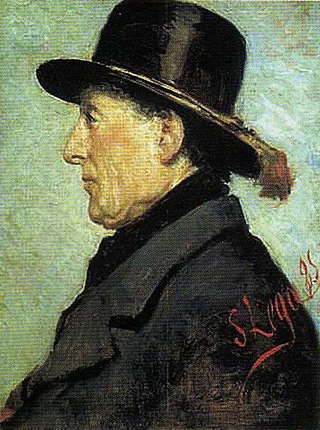 12
Giovanni Verità, detto "don Zvàn", è stato un presbitero italiano, critico del potere temporale detenuto dal Papa durante il Risorgimento.
12
Giovanni Verità, detto "don Zvàn", è stato un presbitero italiano, critico del potere temporale detenuto dal Papa durante il Risorgimento.
Alessandro Antonelli
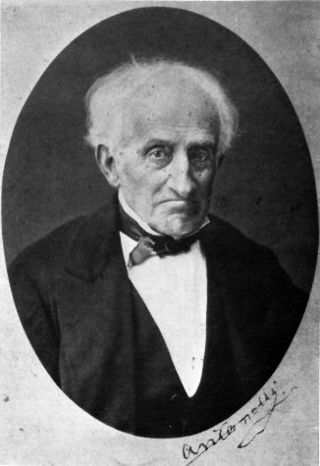 12
Alessandro Antonelli was an Italian architect of the 19th century. His most famous works are the Mole Antonelliana in Turin and both the Novara Cathedral and the Basilica of St. Gaudenzio in Novara.
12
Alessandro Antonelli was an Italian architect of the 19th century. His most famous works are the Mole Antonelliana in Turin and both the Novara Cathedral and the Basilica of St. Gaudenzio in Novara.
Domenico Scarlatti
 12
Giuseppe Domenico Scarlatti, also known as Domingo or Doménico Scarlatti, was an Italian composer. He is classified primarily as a Baroque composer chronologically, although his music was influential...
12
Giuseppe Domenico Scarlatti, also known as Domingo or Doménico Scarlatti, was an Italian composer. He is classified primarily as a Baroque composer chronologically, although his music was influential...
Saint Liberata (Pizzone)
 12
Saint Liberata is the patron saint of the city of Pizzone, Italy. She is declared a holy virgin and martyr by the Roman Catholic Church. Her father was Lucio Catelio Severo and mother was his wife...
12
Saint Liberata is the patron saint of the city of Pizzone, Italy. She is declared a holy virgin and martyr by the Roman Catholic Church. Her father was Lucio Catelio Severo and mother was his wife...
Annibale Santorre di Rossi de Pomarolo, Count of Santarosa
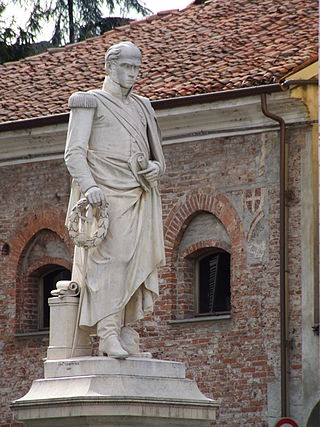 12
Santorre Annibale De Rossi di Pomerolo, Count of Santa Rosa was an Italian insurgent and leader in Italy's revival (Risorgimento).
12
Santorre Annibale De Rossi di Pomerolo, Count of Santa Rosa was an Italian insurgent and leader in Italy's revival (Risorgimento).
Silvestro Lega
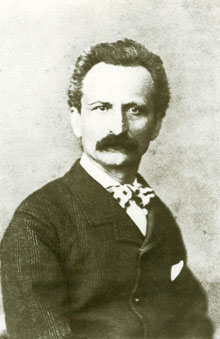 12
Silvestro Lega was an Italian realist painter. He was one of the leading artists of the Macchiaioli and was also involved with the Mazzini movement.
12
Silvestro Lega was an Italian realist painter. He was one of the leading artists of the Macchiaioli and was also involved with the Mazzini movement.
Peregrine Laziosi
 12
Peregrine Laziosi is an Italian saint of the Servite Order. He is the patron saint for persons suffering from cancer, AIDS, and other life-threatening illnesses.
12
Peregrine Laziosi is an Italian saint of the Servite Order. He is the patron saint for persons suffering from cancer, AIDS, and other life-threatening illnesses.
Socrates
 12
Socrates was a Greek philosopher from Athens who is credited as the founder of Western philosophy and among the first moral philosophers of the ethical tradition of thought. An enigmatic figure,...
12
Socrates was a Greek philosopher from Athens who is credited as the founder of Western philosophy and among the first moral philosophers of the ethical tradition of thought. An enigmatic figure,...
Gasparo Gozzi
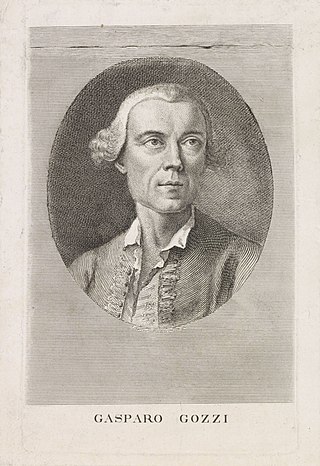 12
Gasparo, count Gozzi was a Venetian critic and dramatist.
12
Gasparo, count Gozzi was a Venetian critic and dramatist.
Rosolino Pilo
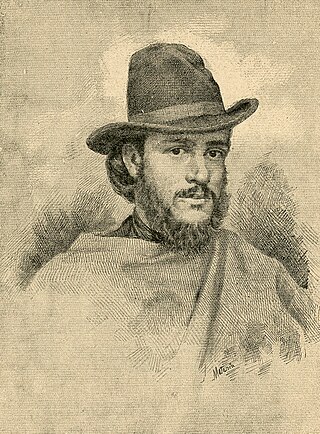 12
Rosolino Pilo, o Rosalino Pilo, è stato un patriota italiano.
12
Rosolino Pilo, o Rosalino Pilo, è stato un patriota italiano.
Princess Mafalda of Savoy
 12
Princess Mafalda of Savoy was the second daughter of King Victor Emmanuel III of Italy and his wife Elena of Montenegro. In 1925, at the age of 22, she married the Landgrave of Hesse, Philipp. In...
12
Princess Mafalda of Savoy was the second daughter of King Victor Emmanuel III of Italy and his wife Elena of Montenegro. In 1925, at the age of 22, she married the Landgrave of Hesse, Philipp. In...
Giuseppe Manno
 12
Giuseppe Manno was an Italian magistrate, politician and historian. He was elected president of the Senate of the Kingdom of Sardinia, and later of the Kingdom of Italy.
12
Giuseppe Manno was an Italian magistrate, politician and historian. He was elected president of the Senate of the Kingdom of Sardinia, and later of the Kingdom of Italy.
Robert Baden-Powell, 1st Baron Baden-Powell
 12
Lieutenant-General Robert Stephenson Smyth Baden-Powell, 1st Baron Baden-Powell, was a British Army officer, writer, founder and first Chief Scout of the world-wide Scout Movement, and founder, with...
12
Lieutenant-General Robert Stephenson Smyth Baden-Powell, 1st Baron Baden-Powell, was a British Army officer, writer, founder and first Chief Scout of the world-wide Scout Movement, and founder, with...
Jan Palach
Giovanni Siotto Pintor
 12
Giovanni Siotto Pintor è stato un politico, avvocato e magistrato italiano.
12
Giovanni Siotto Pintor è stato un politico, avvocato e magistrato italiano.
Enrico Fruch
 12
Enrico Fruch è stato un poeta italiano.
12
Enrico Fruch è stato un poeta italiano.
Chino Ermacora
 12
Chino Ermacora è stato uno scrittore italiano.
12
Chino Ermacora è stato uno scrittore italiano.
Cesare Terranova
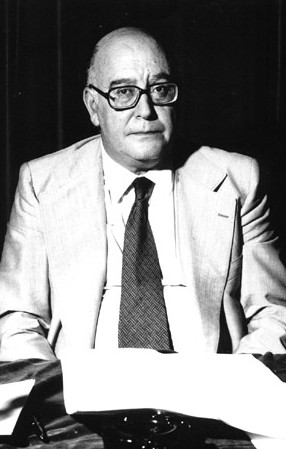 12
Cesare Terranova was an Italian judge and politician from Sicily notable for his anti-Mafia stance. From 1958 until 1971 Terranova was an examining magistrate at the Palermo prosecuting office. He...
12
Cesare Terranova was an Italian judge and politician from Sicily notable for his anti-Mafia stance. From 1958 until 1971 Terranova was an examining magistrate at the Palermo prosecuting office. He...
Giovanni Spano
 12
Giovanni Spano, also a priest and a linguist, is considered one of the first archaeologists to study the Mediterranean island of Sardinia.
12
Giovanni Spano, also a priest and a linguist, is considered one of the first archaeologists to study the Mediterranean island of Sardinia.
Emanuela Loi
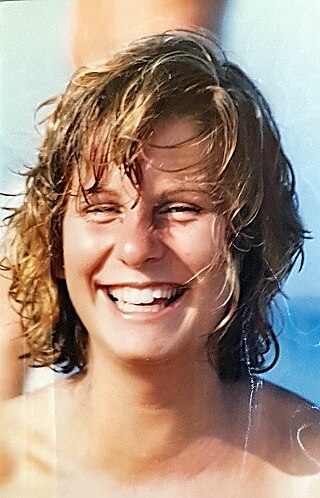 12
Emanuela Loi è stata una poliziotta italiana, morta nella strage di via D'Amelio.
12
Emanuela Loi è stata una poliziotta italiana, morta nella strage di via D'Amelio.
Fulvio Testi
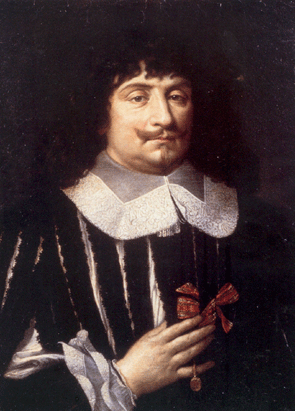 11
Fulvio Testi was an Italian diplomat and poet who is recognised as one of the main exponents of 17th-century Italian Baroque literature. He worked in the service of the d'Este dukes in Modena, for...
11
Fulvio Testi was an Italian diplomat and poet who is recognised as one of the main exponents of 17th-century Italian Baroque literature. He worked in the service of the d'Este dukes in Modena, for...
Arnaldo Fusinato
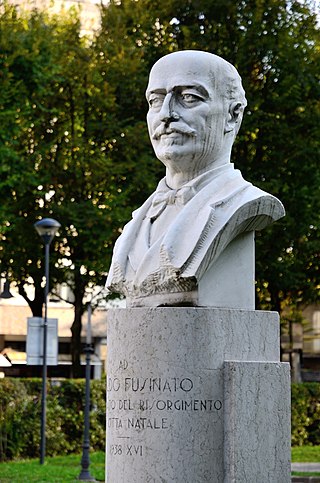 11
Arnaldo Fusinato è stato un poeta e patriota italiano.
11
Arnaldo Fusinato è stato un poeta e patriota italiano.
Carlo Caneva
 11
Carlo Caneva was an Italian general, known for having led the conquest of Libya in the Italo-Turkish War.
11
Carlo Caneva was an Italian general, known for having led the conquest of Libya in the Italo-Turkish War.
John Lennon
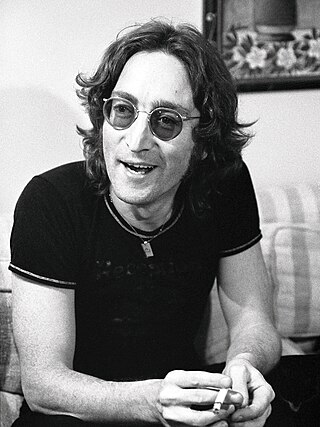 11
John Winston Ono Lennon was an English singer, songwriter and musician. He gained worldwide fame as the founder, co-songwriter, co-lead vocalist and rhythm guitarist of the Beatles. His work included...
11
John Winston Ono Lennon was an English singer, songwriter and musician. He gained worldwide fame as the founder, co-songwriter, co-lead vocalist and rhythm guitarist of the Beatles. His work included...
Reginaldo Giuliani
 11
Reginaldo Giuliani, better known as Father Giuliani, was a Dominican friar, a soldier and Italian writer.
11
Reginaldo Giuliani, better known as Father Giuliani, was a Dominican friar, a soldier and Italian writer.
Gaudenzio Ferrari
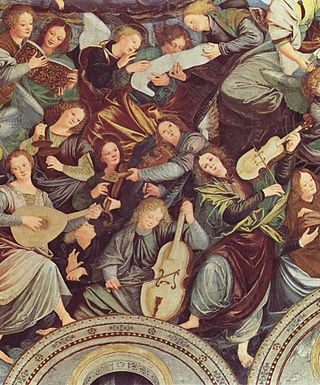 11
Gaudenzio Ferrari was an Italian painter and sculptor of the Renaissance.
11
Gaudenzio Ferrari was an Italian painter and sculptor of the Renaissance.
Giuseppe Giacosa
 11
Giuseppe Giacosa was an Italian poet, playwright and librettist.
11
Giuseppe Giacosa was an Italian poet, playwright and librettist.
Giovanni Gentile
 11
Giovanni Gentile was an Italian philosopher, fascist politician, and pedagogue.
11
Giovanni Gentile was an Italian philosopher, fascist politician, and pedagogue.
Pilade Bronzetti
 11
Pilade Bronzetti è stato un patriota italiano.
11
Pilade Bronzetti è stato un patriota italiano.
Constantine the Great
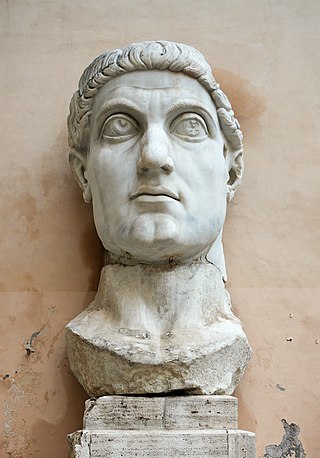 11
Constantine I, also known as Constantine the Great, was a Roman emperor from AD 306 to 337 and the first Roman emperor to convert to Christianity. He played a pivotal role in elevating the status of...
11
Constantine I, also known as Constantine the Great, was a Roman emperor from AD 306 to 337 and the first Roman emperor to convert to Christianity. He played a pivotal role in elevating the status of...
Giovanni Lanza
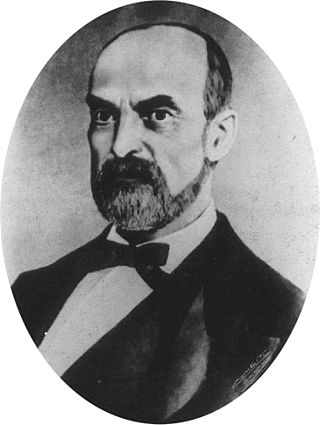 11
Domenico Giovanni Giuseppe Maria Lanza was an Italian politician and the eighth prime minister of Italy from 1869 to 1873.
11
Domenico Giovanni Giuseppe Maria Lanza was an Italian politician and the eighth prime minister of Italy from 1869 to 1873.
Bernardino Telesio
 11
Bernardino Telesio was an Italian philosopher and natural scientist. While his natural theories were later disproven, his emphasis on observation made him the "first of the moderns" who eventually...
11
Bernardino Telesio was an Italian philosopher and natural scientist. While his natural theories were later disproven, his emphasis on observation made him the "first of the moderns" who eventually...
Vladimir Lenin
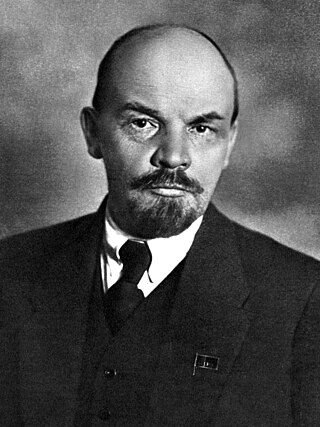 11
Vladimir Ilyich Ulyanov, better known as Vladimir Lenin, was a Russian revolutionary, Soviet politician, and political theorist who was the founder and first leader of the Russian Soviet Federative...
11
Vladimir Ilyich Ulyanov, better known as Vladimir Lenin, was a Russian revolutionary, Soviet politician, and political theorist who was the founder and first leader of the Russian Soviet Federative...
Alberto della Marmora
 11
Alberto Ferrero La Marmora was an Italian soldier and naturalist. He was elder brother to Alessandro Ferrero La Marmora, soldier and founder of the Bersaglieri, and to Alfonso Ferrero La Marmora,...
11
Alberto Ferrero La Marmora was an Italian soldier and naturalist. He was elder brother to Alessandro Ferrero La Marmora, soldier and founder of the Bersaglieri, and to Alfonso Ferrero La Marmora,...
Christina of Bolsena
 11
Christina of Bolsena, also known as Christine of Bolsena, or in the Eastern Orthodox Church as Christina the Great martyr, is venerated as a virgin martyr of the third century. Archaeological...
11
Christina of Bolsena, also known as Christine of Bolsena, or in the Eastern Orthodox Church as Christina the Great martyr, is venerated as a virgin martyr of the third century. Archaeological...
Enrico Dandolo
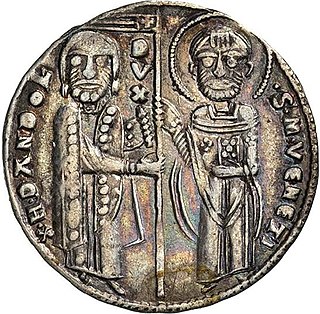 11
Enrico Dandolo was the doge of Venice from 1192 until his death. He is remembered for his avowed piety, longevity, and shrewdness, and his role in the Fourth Crusade and the Sack of Constantinople....
11
Enrico Dandolo was the doge of Venice from 1192 until his death. He is remembered for his avowed piety, longevity, and shrewdness, and his role in the Fourth Crusade and the Sack of Constantinople....
Alfredo Panzini
 11
Alfredo Panzini was an Italian novelist, critic, historical writer, and lexicographer. A prolific and popular writer, Panzini is famous in Italy for his brilliant and amusing humorous stories.
11
Alfredo Panzini was an Italian novelist, critic, historical writer, and lexicographer. A prolific and popular writer, Panzini is famous in Italy for his brilliant and amusing humorous stories.
Lorenzo Ghiberti
 11
Lorenzo Ghiberti, born Lorenzo di Bartolo, was an Italian Renaissance sculptor from Florence, a key figure in the Early Renaissance, best known as the creator of two sets of bronze doors of the...
11
Lorenzo Ghiberti, born Lorenzo di Bartolo, was an Italian Renaissance sculptor from Florence, a key figure in the Early Renaissance, best known as the creator of two sets of bronze doors of the...
Giorgio Morandi
 11
Giorgio Morandi was an Italian painter and printmaker who specialized in still lifes. His paintings are noted for their tonal subtlety in depicting simple subjects, mainly vases, bottles, bowls,...
11
Giorgio Morandi was an Italian painter and printmaker who specialized in still lifes. His paintings are noted for their tonal subtlety in depicting simple subjects, mainly vases, bottles, bowls,...
Aldo Capitini
 11
Aldo Capitini was an Italian philosopher, poet, political activist, anti-fascist, and educator. He was one of the first Italians to take up and develop Mahatma Gandhi's theories of nonviolence and...
11
Aldo Capitini was an Italian philosopher, poet, political activist, anti-fascist, and educator. He was one of the first Italians to take up and develop Mahatma Gandhi's theories of nonviolence and...
Umberto Maddalena
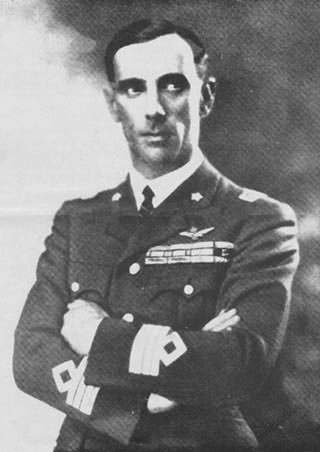 11
Umberto Maddalena è stato un ufficiale e aviatore italiano.
11
Umberto Maddalena è stato un ufficiale e aviatore italiano.
Giovanni Gronchi
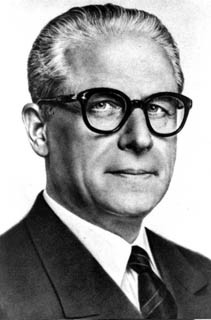 11
Giovanni Gronchi, was an Italian politician from Christian Democracy who served as the president of Italy from 1955 to 1962 and was marked by a controversial and failed attempt to bring about an...
11
Giovanni Gronchi, was an Italian politician from Christian Democracy who served as the president of Italy from 1955 to 1962 and was marked by a controversial and failed attempt to bring about an...
Carlo Giuseppe Guglielmo Botta
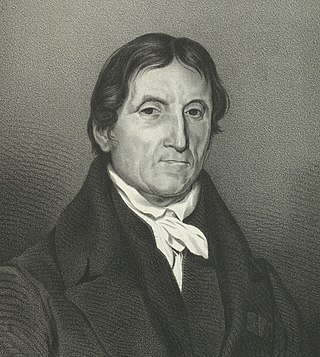 11
Carlo Giuseppe Guglielmo Botta was an Italian historian.
11
Carlo Giuseppe Guglielmo Botta was an Italian historian.
Leonardo Sciascia
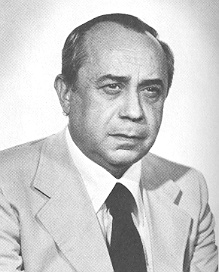 11
Leonardo Sciascia was an Italian writer, novelist, essayist, playwright, and politician. Some of his works have been made into films, including Porte Aperte, Cadaveri Eccellenti, Todo Modo and Il...
11
Leonardo Sciascia was an Italian writer, novelist, essayist, playwright, and politician. Some of his works have been made into films, including Porte Aperte, Cadaveri Eccellenti, Todo Modo and Il...
House of Medici
 11
The House of Medici was an Italian banking family and political dynasty that first consolidated power in the Republic of Florence under Cosimo de' Medici, during the first half of the 15th century....
11
The House of Medici was an Italian banking family and political dynasty that first consolidated power in the Republic of Florence under Cosimo de' Medici, during the first half of the 15th century....
Agostino Depretis
 11
Agostino Depretis was an Italian statesman and politician. He served as Prime Minister of Italy for several stretches between 1876 and 1887, and was leader of the Historical Left parliamentary group...
11
Agostino Depretis was an Italian statesman and politician. He served as Prime Minister of Italy for several stretches between 1876 and 1887, and was leader of the Historical Left parliamentary group...
Basil of Caesarea
 11
Basil of Caesarea, also called Saint Basil the Great, was a bishop of Caesarea Mazaca in Cappadocia, Asia Minor. He was an influential theologian who supported the Nicene Creed and opposed the...
11
Basil of Caesarea, also called Saint Basil the Great, was a bishop of Caesarea Mazaca in Cappadocia, Asia Minor. He was an influential theologian who supported the Nicene Creed and opposed the...
Rocco Chinnici
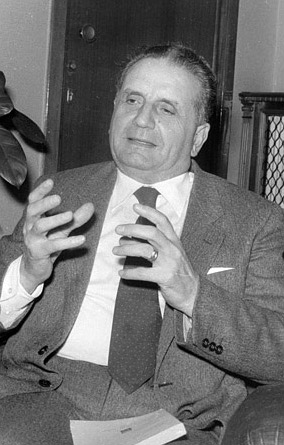 11
Rocco Chinnici was an Italian anti-Mafia magistrate killed by the Sicilian Mafia.
11
Rocco Chinnici was an Italian anti-Mafia magistrate killed by the Sicilian Mafia.
Tina Modotti
 11
Tina Modotti was an Italian American photographer, model, actor, and revolutionary political activist for the Comintern. She left her native Italy in 1913 and emigrated to the United States, where...
11
Tina Modotti was an Italian American photographer, model, actor, and revolutionary political activist for the Comintern. She left her native Italy in 1913 and emigrated to the United States, where...
Lelio Basso
 11
Lelio Basso was an Italian democratic socialist politician, political scientist and journalist.
11
Lelio Basso was an Italian democratic socialist politician, political scientist and journalist.
Columbanus
 11
Columbanus was an Irish missionary notable for founding a number of monasteries after 590 in the Frankish and Lombard kingdoms, most notably Luxeuil Abbey in present-day France and Bobbio Abbey in...
11
Columbanus was an Irish missionary notable for founding a number of monasteries after 590 in the Frankish and Lombard kingdoms, most notably Luxeuil Abbey in present-day France and Bobbio Abbey in...
Justina of Padua
 11
Justina of Padua is a Christian saint and a patroness of Padua. Her feast day is October 7. She is often confused with Justina of Antioch. She was devoted to religion from her earliest years and took...
11
Justina of Padua is a Christian saint and a patroness of Padua. Her feast day is October 7. She is often confused with Justina of Antioch. She was devoted to religion from her earliest years and took...
Trajan
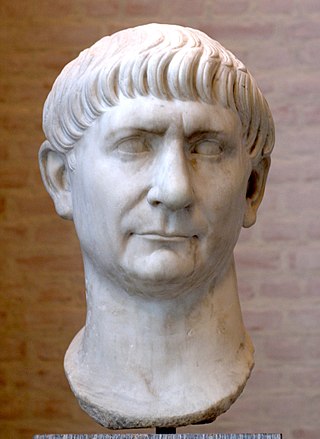 11
Trajan was a Roman emperor from AD 98 to 117, the second of the Five Good Emperors of the Nerva–Antonine dynasty. He was a philanthropic ruler and a successful soldier-emperor who led the Roman...
11
Trajan was a Roman emperor from AD 98 to 117, the second of the Five Good Emperors of the Nerva–Antonine dynasty. He was a philanthropic ruler and a successful soldier-emperor who led the Roman...
Faustina Kowalska
 11
Maria Faustyna Kowalska, OLM, also known as Maria Faustyna Kowalska of the Blessed Sacrament, was a Polish Catholic religious sister and mystic. Faustyna, popularly spelled "Faustina", had...
11
Maria Faustyna Kowalska, OLM, also known as Maria Faustyna Kowalska of the Blessed Sacrament, was a Polish Catholic religious sister and mystic. Faustyna, popularly spelled "Faustina", had...
Hadrian
 11
Hadrian was Roman emperor from 117 to 138. Hadrian was born in Italica, close to modern Seville in Spain, an Italic settlement in Hispania Baetica; his branch of the Aelia gens, the Aeli Hadriani,...
11
Hadrian was Roman emperor from 117 to 138. Hadrian was born in Italica, close to modern Seville in Spain, an Italic settlement in Hispania Baetica; his branch of the Aelia gens, the Aeli Hadriani,...
Giuseppe Cavallera
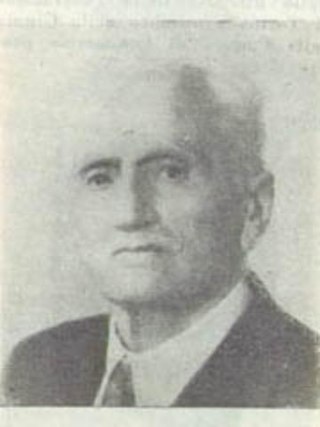 11
Giuseppe Cavallera è stato un politico italiano.
11
Giuseppe Cavallera è stato un politico italiano.
Massimo D'Antona
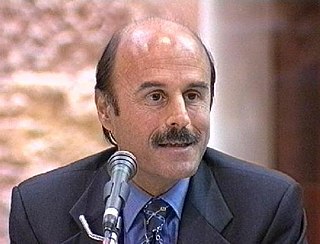 11
Massimo D'Antona è stato un giurista italiano, assassinato dalle Nuove Brigate Rosse il 20 maggio del 1999, a Roma, a pochi passi dalla sua abitazione.
11
Massimo D'Antona è stato un giurista italiano, assassinato dalle Nuove Brigate Rosse il 20 maggio del 1999, a Roma, a pochi passi dalla sua abitazione.
Gratus of Aosta
 11
Gratus of Aosta was a bishop of Aosta and is the city's patron saint.
11
Gratus of Aosta was a bishop of Aosta and is the city's patron saint.
Alessandro Ferrero La Marmora
 10
Alessandro Ferrero La Marmora was an Italian general who is best remembered for founding the military unit known as the Bersaglieri. Two of his brothers were Alfonso Ferrero La Marmora and Alberto...
10
Alessandro Ferrero La Marmora was an Italian general who is best remembered for founding the military unit known as the Bersaglieri. Two of his brothers were Alfonso Ferrero La Marmora and Alberto...
Augustus
 10
Gaius Julius Caesar Augustus, also known as Octavian, was the founder of the Roman Empire. He reigned as the first Roman emperor from 27 BC until his death in AD 14. The reign of Augustus initiated...
10
Gaius Julius Caesar Augustus, also known as Octavian, was the founder of the Roman Empire. He reigned as the first Roman emperor from 27 BC until his death in AD 14. The reign of Augustus initiated...
Federico II Gonzaga, Duke of Mantua
 10
Federico II of Gonzaga was the ruler of the Italian city of Mantua from 1519 until his death. He was also Marquis of Montferrat from 1536.
10
Federico II of Gonzaga was the ruler of the Italian city of Mantua from 1519 until his death. He was also Marquis of Montferrat from 1536.
Carlo Rosselli
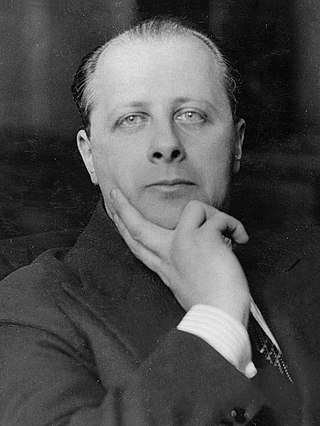 10
Carlo Alberto Rosselli was an Italian political leader, journalist, historian, philosopher and anti-fascist activist, first in Italy and then abroad. He developed a theory of reformist, non-Marxist...
10
Carlo Alberto Rosselli was an Italian political leader, journalist, historian, philosopher and anti-fascist activist, first in Italy and then abroad. He developed a theory of reformist, non-Marxist...
Napoleone della Torre
 10
Napoleone della Torre, also known as Napo della Torre or Napo Torriani, was an Italian nobleman, who was effective Lord of Milan in the late 13th century. He was a member of the della Torre family,...
10
Napoleone della Torre, also known as Napo della Torre or Napo Torriani, was an Italian nobleman, who was effective Lord of Milan in the late 13th century. He was a member of the della Torre family,...
Graziadio Isaia Ascoli
 10
Graziadio Isaia Ascoli was an Italian linguist.
10
Graziadio Isaia Ascoli was an Italian linguist.
Vittorio Locchi
 10
Vittorio Locchi è stato uno scrittore e militare italiano.
10
Vittorio Locchi è stato uno scrittore e militare italiano.
Camillo Golgi
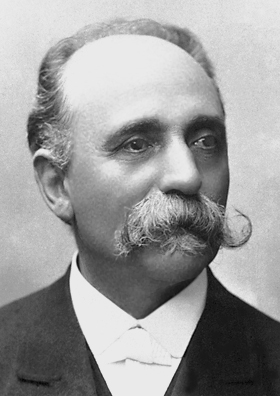 10
Camillo Golgi was an Italian biologist and pathologist known for his works on the central nervous system. He studied medicine at the University of Pavia between 1860 and 1868 under the tutelage of...
10
Camillo Golgi was an Italian biologist and pathologist known for his works on the central nervous system. He studied medicine at the University of Pavia between 1860 and 1868 under the tutelage of...
Saverio Mercadante
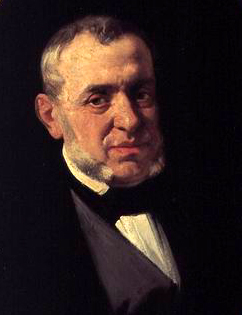 10
Giuseppe Saverio Raffaele Mercadante was an Italian composer, particularly of operas. While Mercadante may not have retained the international celebrity of Gaetano Donizetti or Gioachino Rossini...
10
Giuseppe Saverio Raffaele Mercadante was an Italian composer, particularly of operas. While Mercadante may not have retained the international celebrity of Gaetano Donizetti or Gioachino Rossini...
Giulio Carcano
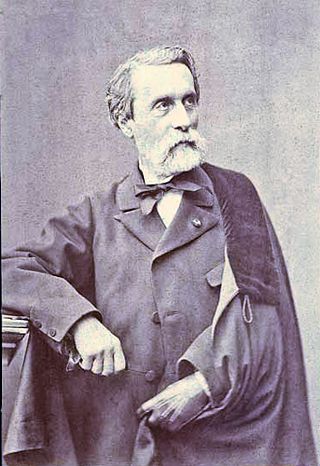 10
Giulio Carcano è stato un politico, scrittore, giornalista e patriota italiano.
10
Giulio Carcano è stato un politico, scrittore, giornalista e patriota italiano.
Agostino Bertani
 10
Agostino Bertani was an Italian revolutionary and physician during Italian unification.
10
Agostino Bertani was an Italian revolutionary and physician during Italian unification.
Marianus IV of Arborea
 10
Marianus IV, called the Great, was the Judge (king) of Arborea, kingdom in the island of Sardinia, from 1347 to his death. He was, as his nickname indicates, the greatest sovereign of Arborea. He was...
10
Marianus IV, called the Great, was the Judge (king) of Arborea, kingdom in the island of Sardinia, from 1347 to his death. He was, as his nickname indicates, the greatest sovereign of Arborea. He was...
Eusebius of Rome
 10
Eusebius of Rome, the founder of the church on the Esquiline Hill in Rome that bears his name, is listed in the Roman Martyrology as one of the saints venerated on 14 August.
10
Eusebius of Rome, the founder of the church on the Esquiline Hill in Rome that bears his name, is listed in the Roman Martyrology as one of the saints venerated on 14 August.
Romolo Murri
 10
Romolo Murri was an Italian politician and ecclesiastic. This Catholic priest was suspended for having joined the party Lega Democratica Nazionale and is widely considered in Italy as the precursor...
10
Romolo Murri was an Italian politician and ecclesiastic. This Catholic priest was suspended for having joined the party Lega Democratica Nazionale and is widely considered in Italy as the precursor...
Umberto Cagni
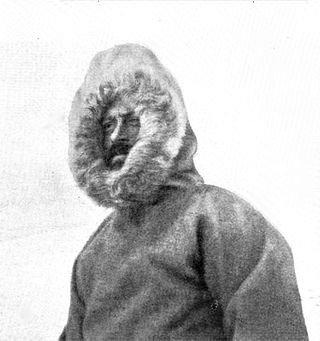 10
Umberto Cagni was a polar explorer and an admiral in the Royal Italian Navy. He is best known for his leadership in a probe, by dogsled, northward over the surface of the Arctic Ocean in 1900. While...
10
Umberto Cagni was a polar explorer and an admiral in the Royal Italian Navy. He is best known for his leadership in a probe, by dogsled, northward over the surface of the Arctic Ocean in 1900. While...
Urbano Rattazzi
 10
Urbano Pio Francesco Rattazzi was an Italian politician and statesman.
10
Urbano Pio Francesco Rattazzi was an Italian politician and statesman.
Eurosia
 10
Eurosia is the patron saint of Jaca, a city in the province of Huesca of northeastern Spain, in the Pyrenees, the centre of her cult. In Spain, the "Fiesta de Santa Orosia" is celebrated on 25 June....
10
Eurosia is the patron saint of Jaca, a city in the province of Huesca of northeastern Spain, in the Pyrenees, the centre of her cult. In Spain, the "Fiesta de Santa Orosia" is celebrated on 25 June....
Pietro Bembo
 10
Pietro Bembo, O.S.I.H. was an Italian scholar, poet, and literary theorist who also was a member of the Knights Hospitaller, and a cardinal of the Roman Catholic Church. As an intellectual of the...
10
Pietro Bembo, O.S.I.H. was an Italian scholar, poet, and literary theorist who also was a member of the Knights Hospitaller, and a cardinal of the Roman Catholic Church. As an intellectual of the...
Francesco I Sforza
 10
Francesco I Sforza was an Italian condottiero who founded the Sforza dynasty in the duchy of Milan, ruling as its (fourth) duke from 1450 until his death.
10
Francesco I Sforza was an Italian condottiero who founded the Sforza dynasty in the duchy of Milan, ruling as its (fourth) duke from 1450 until his death.
Giuseppe Donati
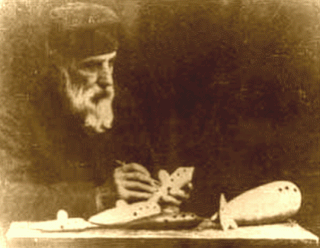 10
Giuseppe Donati was an Italian musical instrument maker who invented the ocarina, a ceramic wind instrument based on the principle of a Helmholtz resonator.
10
Giuseppe Donati was an Italian musical instrument maker who invented the ocarina, a ceramic wind instrument based on the principle of a Helmholtz resonator.
Giovanni Randaccio
 10
Giovanni Randaccio was an Italian soldier.
10
Giovanni Randaccio was an Italian soldier.
Benedetto Brin
 10
Benedetto Brin was an Italian naval administrator and politician. He played a major role in modernizing and expanding the Italian Regia Marina from the 1870s to the 1890s, designing several major...
10
Benedetto Brin was an Italian naval administrator and politician. He played a major role in modernizing and expanding the Italian Regia Marina from the 1870s to the 1890s, designing several major...
Costantino Crosa
 10
Costantino Crosa è stato un militare italiano, decorato di medaglia d'oro al valor militare alla memoria nel corso della prima guerra mondiale.
10
Costantino Crosa è stato un militare italiano, decorato di medaglia d'oro al valor militare alla memoria nel corso della prima guerra mondiale.
Giuseppe Dozza
 10
Giuseppe Dozza was an Italian politician, the first Mayor of Bologna after the end of World War II.
10
Giuseppe Dozza was an Italian politician, the first Mayor of Bologna after the end of World War II.
Telemaco Signorini
 10
Telemaco Signorini was an Italian artist who belonged to the group known as the Macchiaioli.
10
Telemaco Signorini was an Italian artist who belonged to the group known as the Macchiaioli.
Dosso Dossi
 10
Giovanni di Niccolò de Luteri, better known as Dosso Dossi, was an Italian Renaissance painter who belonged to the School of Ferrara, painting in a style mainly influenced by Venetian painting, in...
10
Giovanni di Niccolò de Luteri, better known as Dosso Dossi, was an Italian Renaissance painter who belonged to the School of Ferrara, painting in a style mainly influenced by Venetian painting, in...
Bonaldo Stringher
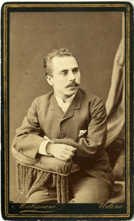 10
Bonaldo Stringher was an Italian banker, economist and politician.
10
Bonaldo Stringher was an Italian banker, economist and politician.
Renato Guttuso
 10
Renato Guttuso was an Italian painter and politician. His best-known works include Flight from Etna (1938–39), Crucifixion (1941) and La Vucciria (1974). Guttuso also designed for the theatre and did...
10
Renato Guttuso was an Italian painter and politician. His best-known works include Flight from Etna (1938–39), Crucifixion (1941) and La Vucciria (1974). Guttuso also designed for the theatre and did...
Vittorio De Sica
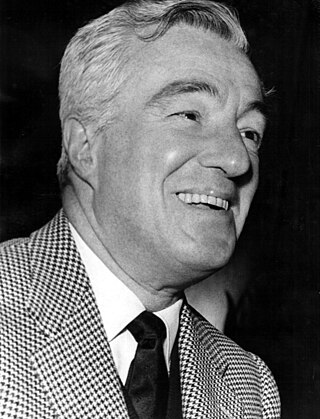 10
Vittorio De Sica was an Italian film director and actor, a leading figure in the neorealist movement.
10
Vittorio De Sica was an Italian film director and actor, a leading figure in the neorealist movement.
Guido Miglioli
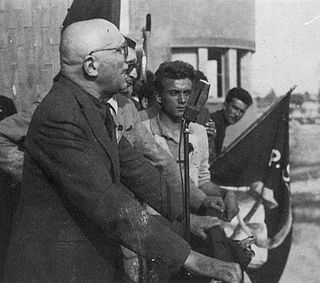 10
Guido Miglioli è stato un politico e sindacalista italiano.
10
Guido Miglioli è stato un politico e sindacalista italiano.
Roberto Ruffilli
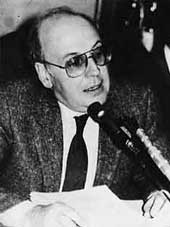 10
Roberto Ruffilli è stato un politologo e politico italiano.
10
Roberto Ruffilli è stato un politologo e politico italiano.
Gian Giacomo Medici
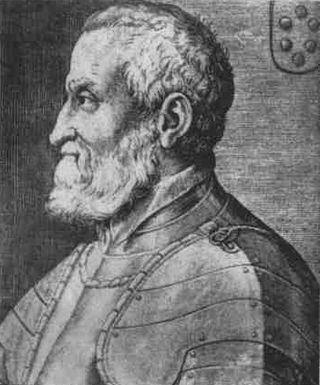 10
Gian Giacomo Medici was an Italian condottiero who became a noted Spanish general, Duke of Marignano and Marquess of Musso and Lecco in Lombardy.
10
Gian Giacomo Medici was an Italian condottiero who became a noted Spanish general, Duke of Marignano and Marquess of Musso and Lecco in Lombardy.
Eugenio Barsanti
 10
Father Eugenio Barsanti, also named Nicolò, was an Italian engineer, who together with Felice Matteucci of Lucca invented the first version of the internal combustion engine in 1853, Florence. Their...
10
Father Eugenio Barsanti, also named Nicolò, was an Italian engineer, who together with Felice Matteucci of Lucca invented the first version of the internal combustion engine in 1853, Florence. Their...
Luigi Luzzatti
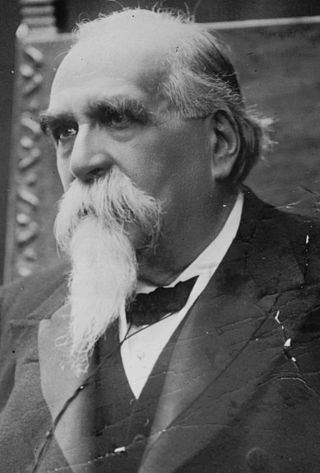 10
Luigi Luzzatti was an Italian financier, political economist, social philosopher, and jurist. He served as the 20th prime minister of Italy between 1910 and 1911.
10
Luigi Luzzatti was an Italian financier, political economist, social philosopher, and jurist. He served as the 20th prime minister of Italy between 1910 and 1911.
Luigi Mercantini
 10
Luigi Mercantini was an Italian poet and writer, who took part in the movements for the Italian unification in the late 19th century. He is better known for his poem "La spigolatrice di Sapri",...
10
Luigi Mercantini was an Italian poet and writer, who took part in the movements for the Italian unification in the late 19th century. He is better known for his poem "La spigolatrice di Sapri",...
René Descartes
 10
René Descartes was a French philosopher, scientist, and mathematician, widely considered a seminal figure in the emergence of modern philosophy and science. Mathematics was paramount to his method of...
10
René Descartes was a French philosopher, scientist, and mathematician, widely considered a seminal figure in the emergence of modern philosophy and science. Mathematics was paramount to his method of...
Leo of Montefeltro
 10
Saint Leo of Montefeltro otherwise Leone of Montefeltro was the first bishop of Montefeltro from 301. He is traditionally held to have been in origin a stonecutter from Dalmatia. He is venerated as a...
10
Saint Leo of Montefeltro otherwise Leone of Montefeltro was the first bishop of Montefeltro from 301. He is traditionally held to have been in origin a stonecutter from Dalmatia. He is venerated as a...
Antiochus of Sulcis
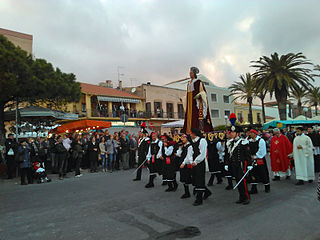 10
Antiochus of Sulcis was an early Christian martyr of Sardinia. The island and town of Sant'Antioco are named after him.
10
Antiochus of Sulcis was an early Christian martyr of Sardinia. The island and town of Sant'Antioco are named after him.
Jacopo Pirona
 10
Jacopo Pirona è stato un abate, scrittore e linguista italiano. A lui si deve il primo dizionario con grafia unificata in lingua friulana.
10
Jacopo Pirona è stato un abate, scrittore e linguista italiano. A lui si deve il primo dizionario con grafia unificata in lingua friulana.
Salvatore Mannironi
 10
Salvatore Mannironi è stato un politico italiano.
10
Salvatore Mannironi è stato un politico italiano.
Giovanni Maria Dettori
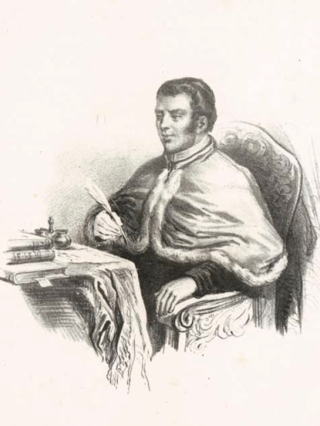 10
Giovanni Maria Dettori è stato un teologo italiano, ha insegnato teologia morale presso l'Università di Cagliari (1807).
10
Giovanni Maria Dettori è stato un teologo italiano, ha insegnato teologia morale presso l'Università di Cagliari (1807).
Lorenzo Lotto
 9
Lorenzo Lotto was an Italian painter, draughtsman, and illustrator, traditionally placed in the Venetian school, though much of his career was spent in other north Italian cities. He painted mainly...
9
Lorenzo Lotto was an Italian painter, draughtsman, and illustrator, traditionally placed in the Venetian school, though much of his career was spent in other north Italian cities. He painted mainly...
Abraham Lincoln
 9
Abraham Lincoln was an American lawyer, politician, and statesman, who served as the 16th president of the United States, from 1861 until his assassination in 1865. Lincoln led the United States...
9
Abraham Lincoln was an American lawyer, politician, and statesman, who served as the 16th president of the United States, from 1861 until his assassination in 1865. Lincoln led the United States...
Luigi Maria Palazzolo
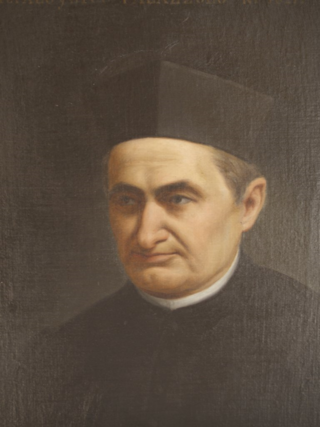 9
Luigi Maria Palazzolo was an Italian Roman Catholic priest. He established the Sisters of the Poor which was also known as the Palazzolo Institute. Other contributions include the construction of an...
9
Luigi Maria Palazzolo was an Italian Roman Catholic priest. He established the Sisters of the Poor which was also known as the Palazzolo Institute. Other contributions include the construction of an...
Guido Guinizelli
 9
Guido Guinizelli was an esteemed Italian love poet and is considered the "father" of the Dolce Stil Novo. He was the first to write in this new style of poetry writing, and thus is held to be the...
9
Guido Guinizelli was an esteemed Italian love poet and is considered the "father" of the Dolce Stil Novo. He was the first to write in this new style of poetry writing, and thus is held to be the...
Not found.
 9
9
Michele Amari
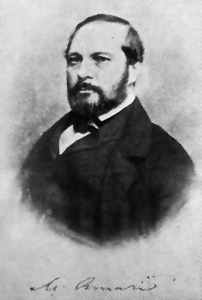 9
Michele Benedetto Gaetano Amari was a Sicilian patriot, liberal revolutionary and politician of aristocratic background, historian and orientalist. He rose to prominence as a champion of Sicilian...
9
Michele Benedetto Gaetano Amari was a Sicilian patriot, liberal revolutionary and politician of aristocratic background, historian and orientalist. He rose to prominence as a champion of Sicilian...
Cecco Angiolieri
 9
Francesco Angiolieri, known as Cecco Angiolieri was an Italian poet.
9
Francesco Angiolieri, known as Cecco Angiolieri was an Italian poet.
Carlo Poma
 9
Carlo Poma è stato un medico e patriota italiano, uno dei Martiri di Belfiore.
9
Carlo Poma è stato un medico e patriota italiano, uno dei Martiri di Belfiore.
Joachim Murat
 9
Joachim Murat was a French military commander and statesman who served during the French Revolutionary Wars and Napoleonic Wars. Under the French Empire he received the military titles of Marshal of...
9
Joachim Murat was a French military commander and statesman who served during the French Revolutionary Wars and Napoleonic Wars. Under the French Empire he received the military titles of Marshal of...
Alfredo Baccarini
 9
Alfredo Baccarini è stato un ingegnere e politico italiano.
9
Alfredo Baccarini è stato un ingegnere e politico italiano.
Carlo Poerio
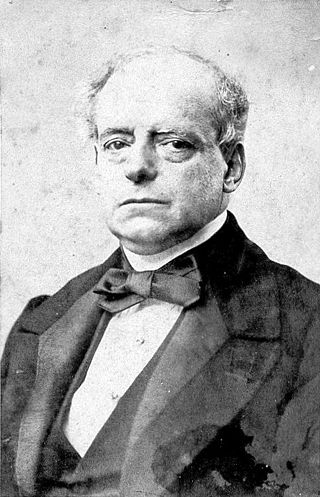 9
Carlo Poerio was an Italian poet, Risorgimento and 1848 Revolution activist, politician, and brother of Alessandro Poerio.
9
Carlo Poerio was an Italian poet, Risorgimento and 1848 Revolution activist, politician, and brother of Alessandro Poerio.
Prosper of Reggio
 9
Prosper of Reggio is an Italian saint. Tradition holds that he was a bishop of Reggio Emilia for twenty-two years. Little is known of his life, but documents attest that he was indeed bishop of...
9
Prosper of Reggio is an Italian saint. Tradition holds that he was a bishop of Reggio Emilia for twenty-two years. Little is known of his life, but documents attest that he was indeed bishop of...
Cassian of Imola
 9
Cassian, or Saint Cassian of Imola, or Cassius was a Christian saint of the 4th century. His feast day is August 13.
9
Cassian, or Saint Cassian of Imola, or Cassius was a Christian saint of the 4th century. His feast day is August 13.
Ettore Fieramosca
 9
Ettore Fieramosca was an Italian condottiero and nobleman during the Italian Wars. His father was Rainaldo, baron of Rocca d'Evandro, and it is thought that his mother was a noblewoman from the...
9
Ettore Fieramosca was an Italian condottiero and nobleman during the Italian Wars. His father was Rainaldo, baron of Rocca d'Evandro, and it is thought that his mother was a noblewoman from the...
Cesare Correnti
 9
Cesare Correnti was an Italian revolutionary and politician.
9
Cesare Correnti was an Italian revolutionary and politician.
Alphonsus Liguori
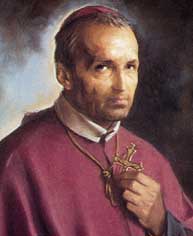 9
Alphonsus Liguori, CSsR, sometimes called Alphonsus Maria de Liguori or Saint Alphonsus Liguori, was an Italian Catholic bishop, spiritual writer, composer, musician, artist, poet, lawyer, scholastic...
9
Alphonsus Liguori, CSsR, sometimes called Alphonsus Maria de Liguori or Saint Alphonsus Liguori, was an Italian Catholic bishop, spiritual writer, composer, musician, artist, poet, lawyer, scholastic...
Pope Sixtus II
 9
Pope Sixtus II, also written as Pope Xystus II, was bishop of Rome from 31 August 257 until his death on 6 August 258. He was killed along with seven deacons, including Lawrence of Rome, during the...
9
Pope Sixtus II, also written as Pope Xystus II, was bishop of Rome from 31 August 257 until his death on 6 August 258. He was killed along with seven deacons, including Lawrence of Rome, during the...
John of Procida
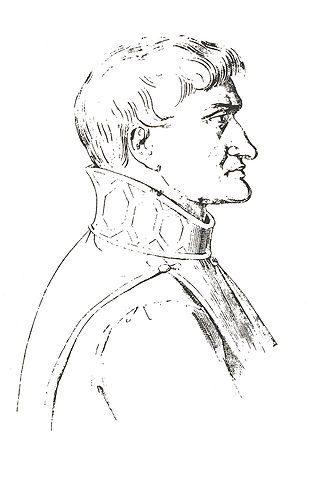 9
John of Procida (1210–1298) was an Italian medieval physician and diplomat.
9
John of Procida (1210–1298) was an Italian medieval physician and diplomat.
Antoniotto Usodimare
 9
Antoniotto Usodimare or Usus di Mare (1416–1462) was a Genoese trader and explorer in the service of the Portuguese Prince Henry the Navigator. Jointly with Alvise Cadamosto, Usodimare discovered a...
9
Antoniotto Usodimare or Usus di Mare (1416–1462) was a Genoese trader and explorer in the service of the Portuguese Prince Henry the Navigator. Jointly with Alvise Cadamosto, Usodimare discovered a...
Alberto Mario
 9
Alberto Mario was an Italian politician, journalist and supporter of Giuseppe Garibaldi. His wife was Jessie White, an English supporter of Garibaldi.
9
Alberto Mario was an Italian politician, journalist and supporter of Giuseppe Garibaldi. His wife was Jessie White, an English supporter of Garibaldi.
Enrico Caruso
 9
Enrico Caruso was an Italian operatic first lyric tenor then dramatic tenor. He sang to great acclaim at the major opera houses of Europe and the Americas, appearing in a wide variety of roles that...
9
Enrico Caruso was an Italian operatic first lyric tenor then dramatic tenor. He sang to great acclaim at the major opera houses of Europe and the Americas, appearing in a wide variety of roles that...
Olindo Guerrini
 9
Olindo Guerrini was an Italian poet who also published under the pseudonyms Lorenzo Stecchetti and Argìa Sbolenfi.
9
Olindo Guerrini was an Italian poet who also published under the pseudonyms Lorenzo Stecchetti and Argìa Sbolenfi.
Vito Volterra
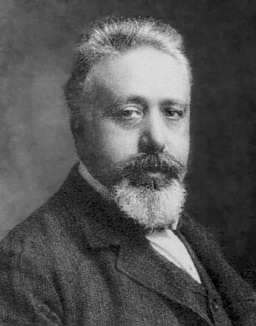 9
Vito Volterra was an Italian mathematician and physicist, known for his contributions to mathematical biology and integral equations, being one of the founders of functional analysis.
9
Vito Volterra was an Italian mathematician and physicist, known for his contributions to mathematical biology and integral equations, being one of the founders of functional analysis.
Orazio Antinori
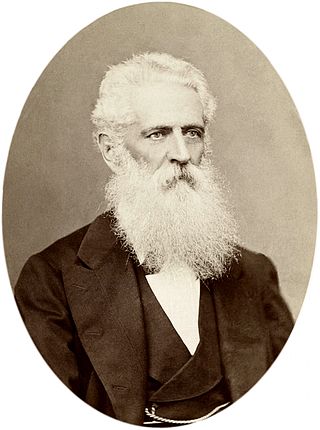 9
Orazio Antinori was an Italian explorer and zoologist.
9
Orazio Antinori was an Italian explorer and zoologist.
Pietro Verri
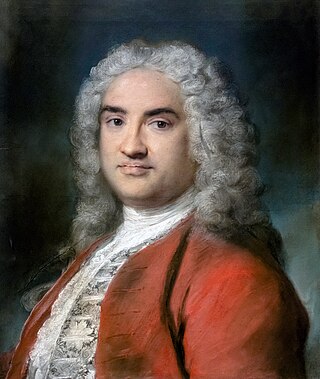 9
Count Pietro Verri was an Italian economist, historian, philosopher and writer. Among the most important personalities of the 18th-century Italian culture, he is considered among the fathers of the...
9
Count Pietro Verri was an Italian economist, historian, philosopher and writer. Among the most important personalities of the 18th-century Italian culture, he is considered among the fathers of the...
Nicola Fabrizi
 9
Nicola Fabrizi was an Italian politician, born at Sassi, Garfagnana under the jurisdiction of Modena. Fabrizi was one of the most militant and dedicated leaders of the Risorgimento, the movement...
9
Nicola Fabrizi was an Italian politician, born at Sassi, Garfagnana under the jurisdiction of Modena. Fabrizi was one of the most militant and dedicated leaders of the Risorgimento, the movement...
Anna Magnani
 9
Anna Maria Magnani was an Italian actress. She was known for her explosive acting and earthy, realistic portrayals of characters.
9
Anna Maria Magnani was an Italian actress. She was known for her explosive acting and earthy, realistic portrayals of characters.
Giovanni Schiaparelli
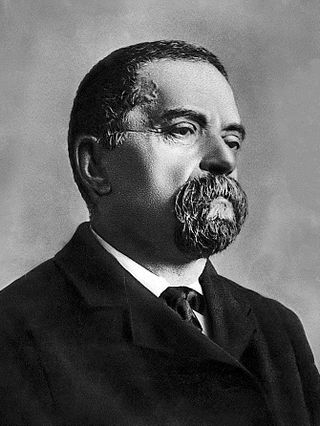 9
Giovanni Virginio Schiaparelli was an Italian astronomer and science historian.
9
Giovanni Virginio Schiaparelli was an Italian astronomer and science historian.
Filippo Meda
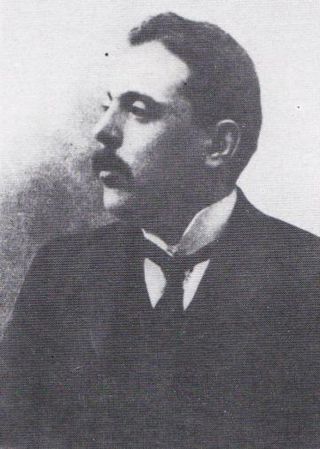 9
Filippo Meda è stato un politico, giornalista e banchiere italiano, protagonista del movimento cattolico italiano tra XIX e XX secolo.
9
Filippo Meda è stato un politico, giornalista e banchiere italiano, protagonista del movimento cattolico italiano tra XIX e XX secolo.
Giancarlo Puecher Passavalli
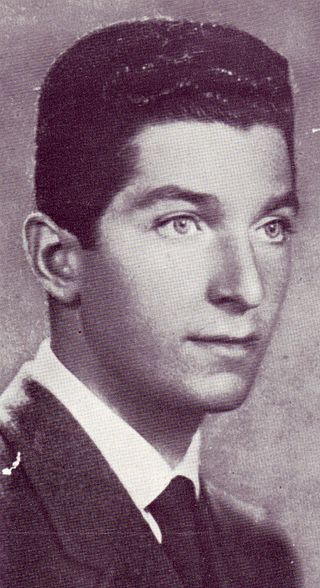 9
Giancarlo Puecher Passavalli è stato un partigiano italiano decorato con la Medaglia d'oro al valor militare.
9
Giancarlo Puecher Passavalli è stato un partigiano italiano decorato con la Medaglia d'oro al valor militare.
Seneca the Younger
 9
Lucius Annaeus Seneca the Younger, usually known mononymously as Seneca, was a Stoic philosopher of Ancient Rome, a statesman, dramatist, and in one work, satirist, from the post-Augustan age of...
9
Lucius Annaeus Seneca the Younger, usually known mononymously as Seneca, was a Stoic philosopher of Ancient Rome, a statesman, dramatist, and in one work, satirist, from the post-Augustan age of...
Plato
 9
Plato, born Aristocles, was an ancient Greek philosopher of the Classical period who is considered a foundational thinker in Western philosophy and an innovator of the written dialogue and dialectic...
9
Plato, born Aristocles, was an ancient Greek philosopher of the Classical period who is considered a foundational thinker in Western philosophy and an innovator of the written dialogue and dialectic...
Giuseppe Marc'Antonio Baretti
 9
Giuseppe Marc'Antonio Baretti was an Italian literary critic, poet, writer, translator, linguist and author of two influential language-translation dictionaries. During his years in England he was...
9
Giuseppe Marc'Antonio Baretti was an Italian literary critic, poet, writer, translator, linguist and author of two influential language-translation dictionaries. During his years in England he was...
Giacomo Bove
 9
Giacomo Bove was an Italian explorer. He sailed with Adolf Erik Nordenskiöld on the first voyage through the north-east passage, and later explored Tierra del Fuego and the Congo River.
9
Giacomo Bove was an Italian explorer. He sailed with Adolf Erik Nordenskiöld on the first voyage through the north-east passage, and later explored Tierra del Fuego and the Congo River.
Horace
 9
Quintus Horatius Flaccus, commonly known in the English-speaking world as Horace, was the leading Roman lyric poet during the time of Augustus. The rhetorician Quintilian regarded his Odes as just...
9
Quintus Horatius Flaccus, commonly known in the English-speaking world as Horace, was the leading Roman lyric poet during the time of Augustus. The rhetorician Quintilian regarded his Odes as just...
Aloysius Gonzaga
 9
Aloysius de Gonzaga was an Italian aristocrat who became a member of the Society of Jesus. While still a student at the Roman College, he died as a result of caring for the victims of a serious...
9
Aloysius de Gonzaga was an Italian aristocrat who became a member of the Society of Jesus. While still a student at the Roman College, he died as a result of caring for the victims of a serious...
Tiberius
 9
Tiberius Julius Caesar Augustus was Roman emperor from AD 14 until 37. He succeeded his stepfather Augustus, the first Roman emperor. Tiberius was born in Rome in 42 BC to Roman politician Tiberius...
9
Tiberius Julius Caesar Augustus was Roman emperor from AD 14 until 37. He succeeded his stepfather Augustus, the first Roman emperor. Tiberius was born in Rome in 42 BC to Roman politician Tiberius...
Guido Mazzoni (sculptor)
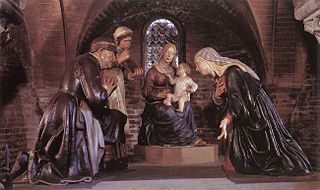 9
Guido Mazzoni was an Italian Renaissance sculptor, mainly in terracotta, and painter of the Renaissance period, working in Bologna, Naples, and France. He is also sometimes referred to as Il Modanino.
9
Guido Mazzoni was an Italian Renaissance sculptor, mainly in terracotta, and painter of the Renaissance period, working in Bologna, Naples, and France. He is also sometimes referred to as Il Modanino.
Scipione Ronchetti
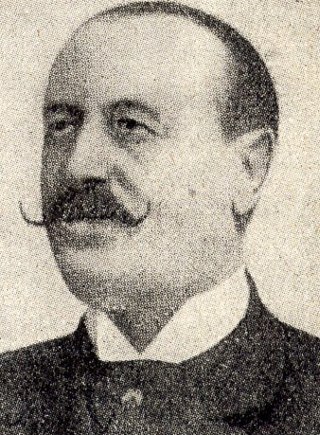 9
Scipione Ronchetti è stato un politico italiano.
9
Scipione Ronchetti è stato un politico italiano.
Costantino Nivola
 9
Costantino Nivola was an Italian sculptor, architectural sculptor, muralist, designer, and teacher.
9
Costantino Nivola was an Italian sculptor, architectural sculptor, muralist, designer, and teacher.
Victoria of Albitina
 9
Saint Victoria is venerated as a martyr and saint by the Catholic Church. It states that she was of the North African nobility and refused an arranged marriage. On her wedding day, she leaped from a...
9
Saint Victoria is venerated as a martyr and saint by the Catholic Church. It states that she was of the North African nobility and refused an arranged marriage. On her wedding day, she leaped from a...
Pliny the Elder
 9
Gaius Plinius Secundus, called Pliny the Elder, was a Roman author, naturalist, natural philosopher, naval and army commander of the early Roman Empire, and a friend of the emperor Vespasian. He...
9
Gaius Plinius Secundus, called Pliny the Elder, was a Roman author, naturalist, natural philosopher, naval and army commander of the early Roman Empire, and a friend of the emperor Vespasian. He...
Guido Picelli
 9
Guido Picelli was an Italian Communist politician and anti-fascist militant. He was a founding member of the Arditi del Popolo and a participant in the Spanish Civil War where he died in battle.
9
Guido Picelli was an Italian Communist politician and anti-fascist militant. He was a founding member of the Arditi del Popolo and a participant in the Spanish Civil War where he died in battle.
Marcus Aurelius
 9
Marcus Aurelius Antoninus was Roman emperor from 161 to 180 and a Stoic philosopher. He was a member of the Nerva–Antonine dynasty, the last of the rulers later known as the Five Good Emperors and...
9
Marcus Aurelius Antoninus was Roman emperor from 161 to 180 and a Stoic philosopher. He was a member of the Nerva–Antonine dynasty, the last of the rulers later known as the Five Good Emperors and...
Giovanni Battista Melis
 9
Giovanni Battista 'Titino' Melis è stato un politico italiano.
9
Giovanni Battista 'Titino' Melis è stato un politico italiano.
Francesco Borromini
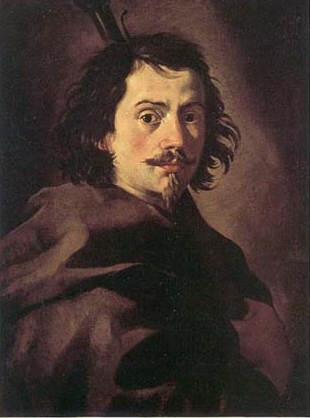 9
Francesco Borromini, byname of Francesco Castelli, was an Italian architect born in the modern Swiss canton of Ticino who, with his contemporaries Gian Lorenzo Bernini and Pietro da Cortona, was a...
9
Francesco Borromini, byname of Francesco Castelli, was an Italian architect born in the modern Swiss canton of Ticino who, with his contemporaries Gian Lorenzo Bernini and Pietro da Cortona, was a...
Riccardo Bacchelli
 9
Riccardo Bacchelli was an Italian writer. In 1927 he was one of the founders of the review La Ronda and Bagutta Prize for literature. He was nominated for the Nobel Prize in Literature eight times.
9
Riccardo Bacchelli was an Italian writer. In 1927 he was one of the founders of the review La Ronda and Bagutta Prize for literature. He was nominated for the Nobel Prize in Literature eight times.
Antonio Ligabue
 9
Antonio Ligabue was an Italian painter. He was one of the most important Naïve artists of the 20th century.
9
Antonio Ligabue was an Italian painter. He was one of the most important Naïve artists of the 20th century.
Dorando Pietri
 9
Dorando Pietri was an Italian long-distance runner. He finished first in the marathon at the 1908 Summer Olympics in London but was subsequently disqualified.
9
Dorando Pietri was an Italian long-distance runner. He finished first in the marathon at the 1908 Summer Olympics in London but was subsequently disqualified.
Lucio Battisti
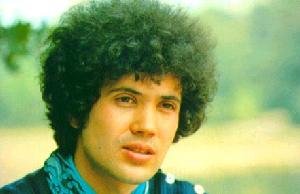 9
Lucio Battisti was an Italian singer-songwriter and composer. He is widely recognized for songs that defined the late 1960s and 1970s era of Italian songwriting.
9
Lucio Battisti was an Italian singer-songwriter and composer. He is widely recognized for songs that defined the late 1960s and 1970s era of Italian songwriting.
Carlo Del Prete
 8
Carlo Del Prete was a pioneer aviator from Italy.
8
Carlo Del Prete was a pioneer aviator from Italy.
Melchiorre Gioia
 8
Melchiorre Gioja was an Italian writer on philosophy and political economy. His name is spelled Gioia in modern Italian.
8
Melchiorre Gioja was an Italian writer on philosophy and political economy. His name is spelled Gioia in modern Italian.
Diocletian
 8
Diocletian, nicknamed Jovius, was Roman emperor from 284 until his abdication in 305. He was born Diocles to a family of low status in the Roman province of Dalmatia. Diocles rose through the ranks...
8
Diocletian, nicknamed Jovius, was Roman emperor from 284 until his abdication in 305. He was born Diocles to a family of low status in the Roman province of Dalmatia. Diocles rose through the ranks...
Paulinus of Nola
 8
Paulinus of Nola born Pontius Meropius Anicius Paulinus, was a Roman poet, writer, and senator who attained the ranks of suffect consul and governor of Campania but – following the assassination of...
8
Paulinus of Nola born Pontius Meropius Anicius Paulinus, was a Roman poet, writer, and senator who attained the ranks of suffect consul and governor of Campania but – following the assassination of...
Andrea Solari
 8
Andrea Solari (1460–1524) was an Italian Renaissance painter of the Milanese school. He was initially named Andre del Gobbo, but more confusingly as Andrea del Bartolo
a name shared with two other...
8
Andrea Solari (1460–1524) was an Italian Renaissance painter of the Milanese school. He was initially named Andre del Gobbo, but more confusingly as Andrea del Bartolo
a name shared with two other...
Paolo dal Pozzo Toscanelli
 8
Paolo dal Pozzo Toscanelli was an Italian mathematician, astronomer, and cosmographer.
8
Paolo dal Pozzo Toscanelli was an Italian mathematician, astronomer, and cosmographer.
Roberto Ardigò
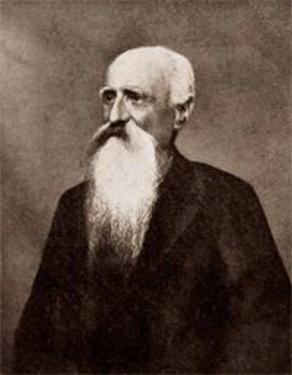 8
Roberto Felice Ardigò was an Italian philosopher. He was an influential leader of Italian positivism and a former Roman Catholic priest.
8
Roberto Felice Ardigò was an Italian philosopher. He was an influential leader of Italian positivism and a former Roman Catholic priest.
Leone Leoni
 8
Leone Leoni was an Italian sculptor of international outlook who travelled in Italy, Germany, Austria, France, Spain and the Netherlands. Leoni is regarded as the finest of the Cinquecento...
8
Leone Leoni was an Italian sculptor of international outlook who travelled in Italy, Germany, Austria, France, Spain and the Netherlands. Leoni is regarded as the finest of the Cinquecento...
Giosuè Borsi
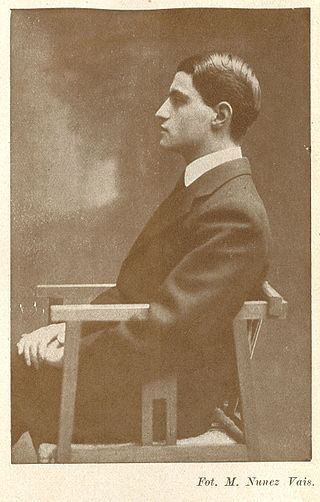 8
Giosuè Borsi è stato uno scrittore e poeta italiano.
8
Giosuè Borsi è stato uno scrittore e poeta italiano.
Paolo Thaon di Revel
 8
Paolo Camillo Thaon, Marquess of Revel, latterly titled with the honorary title of 1st Duke of the Sea, was an Italian admiral of the Regia Marina during World War I and later a politician.
8
Paolo Camillo Thaon, Marquess of Revel, latterly titled with the honorary title of 1st Duke of the Sea, was an Italian admiral of the Regia Marina during World War I and later a politician.
Filippo Re
 8
Filippo Re è stato un botanico e agronomo italiano.
8
Filippo Re è stato un botanico e agronomo italiano.
Enrico Ferri
 8
Enrico Ferri may refer to:Enrico Ferri (politician), Italian politician and magistrate
Enrico Ferri (criminologist) (1856–1929), Italian criminologist
8
Enrico Ferri may refer to:Enrico Ferri (politician), Italian politician and magistrate
Enrico Ferri (criminologist) (1856–1929), Italian criminologist
Filippo Serafini
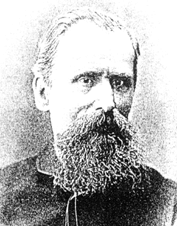 8
Filippo Serafini è stato un giurista italiano nato in Trentino, allora parte dell'impero austro-ungarico.
8
Filippo Serafini è stato un giurista italiano nato in Trentino, allora parte dell'impero austro-ungarico.
Contardo Ferrini
 8
Contardo Ferrini was a noted Italian jurist and legal scholar. He was also a fervent Roman Catholic, who lived a devout life of prayer and service to the poor. He has been beatified by the Catholic...
8
Contardo Ferrini was a noted Italian jurist and legal scholar. He was also a fervent Roman Catholic, who lived a devout life of prayer and service to the poor. He has been beatified by the Catholic...
Matteo Renato Imbriani
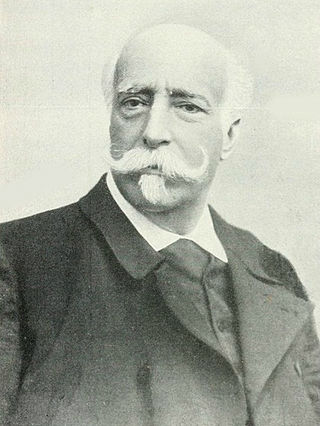 8
Matteo Renato Imbriani è stato un politico italiano, esponente del Partito radicale storico.
8
Matteo Renato Imbriani è stato un politico italiano, esponente del Partito radicale storico.
Giacomo Carissimi
 8
(Gian) Giacomo Carissimi was an Italian composer and music teacher. He is one of the most celebrated masters of the early Baroque or, more accurately, the Roman School of music. Carissimi established...
8
(Gian) Giacomo Carissimi was an Italian composer and music teacher. He is one of the most celebrated masters of the early Baroque or, more accurately, the Roman School of music. Carissimi established...
Filippo De Pisis
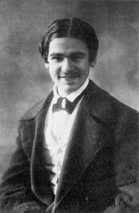 8
Filippo De Pisis was an Italian painter and poet.
8
Filippo De Pisis was an Italian painter and poet.
Renato Serra
 8
Renato Luigi Giuseppe Giulio Serra è stato un critico letterario e scrittore italiano.
8
Renato Luigi Giuseppe Giulio Serra è stato un critico letterario e scrittore italiano.
Enrico Forlanini
 8
Enrico Forlanini was an Italian engineer, inventor and aeronautical pioneer, known for his works on helicopters, aeroplanes, hydrofoils and dirigibles. He was born in Milan. His older brother Carlo...
8
Enrico Forlanini was an Italian engineer, inventor and aeronautical pioneer, known for his works on helicopters, aeroplanes, hydrofoils and dirigibles. He was born in Milan. His older brother Carlo...
Francesco de Pinedo
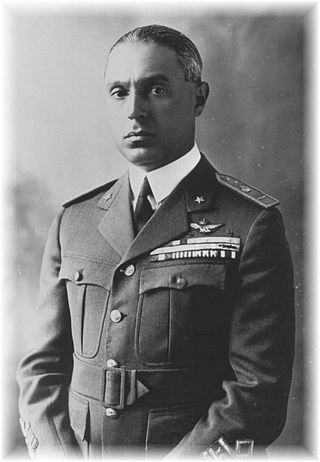 8
Francesco de Pinedo was a famous Italian aviator. A Regia Marina officer who transferred to the Regia Aeronautica, he was an advocate of the seaplane and is best known for his long-range flying boat...
8
Francesco de Pinedo was a famous Italian aviator. A Regia Marina officer who transferred to the Regia Aeronautica, he was an advocate of the seaplane and is best known for his long-range flying boat...
Giovanni Costa (painter, born 1826)
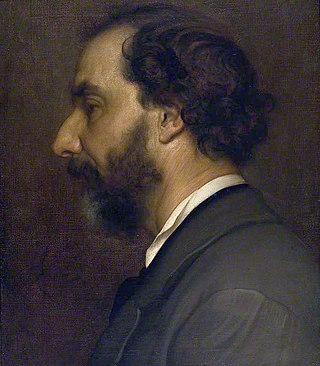 8
Giovanni Costa, often known as Nino Costa, was an Italian landscape painter and patriotic revolutionary.
8
Giovanni Costa, often known as Nino Costa, was an Italian landscape painter and patriotic revolutionary.
Indro Montanelli
 8
Indro Alessandro Raffaello Schizogene Montanelli was an Italian journalist, historian, and writer. He was one of the fifty World Press Freedom Heroes according to the International Press Institute. A...
8
Indro Alessandro Raffaello Schizogene Montanelli was an Italian journalist, historian, and writer. He was one of the fifty World Press Freedom Heroes according to the International Press Institute. A...
Andrea Carlo Ferrari
 8
Andrea Ferrari – later adopting the middle name "Carlo" – was an Italian Catholic prelate who served as a cardinal and as the Archbishop of Milan from 1894 until his death. Ferrari was a...
8
Andrea Ferrari – later adopting the middle name "Carlo" – was an Italian Catholic prelate who served as a cardinal and as the Archbishop of Milan from 1894 until his death. Ferrari was a...
Jacopo della Quercia
 8
Jacopo della Quercia, also known as Jacopo di Pietro d'Agnolo di Guarnieri, was an Italian sculptor of the Renaissance, a contemporary of Brunelleschi, Ghiberti and Donatello. He is considered a...
8
Jacopo della Quercia, also known as Jacopo di Pietro d'Agnolo di Guarnieri, was an Italian sculptor of the Renaissance, a contemporary of Brunelleschi, Ghiberti and Donatello. He is considered a...
Raffaello Lambruschini
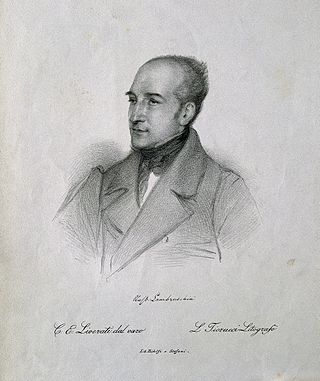 8
Raffaello Lambruschini was a priest, Tuscan agricultural and pedagogical scholar and author; and Italian politician and senator. His diverse interests were pursued through an evolving career.
8
Raffaello Lambruschini was a priest, Tuscan agricultural and pedagogical scholar and author; and Italian politician and senator. His diverse interests were pursued through an evolving career.
Antonio da Sangallo the Younger
 8
Antonio da Sangallo the Younger, also known as Antonio Cordiani, was an Italian architect active during the Renaissance, mainly in Rome and the Papal States. One of his most popular projects that he...
8
Antonio da Sangallo the Younger, also known as Antonio Cordiani, was an Italian architect active during the Renaissance, mainly in Rome and the Papal States. One of his most popular projects that he...
Giovanni Papini
 8
Giovanni Papini was an Italian journalist, essayist, novelist, short story writer, poet, literary critic, and philosopher. A controversial literary figure of the early and mid-twentieth century, he...
8
Giovanni Papini was an Italian journalist, essayist, novelist, short story writer, poet, literary critic, and philosopher. A controversial literary figure of the early and mid-twentieth century, he...
Gracchi brothers
 8
The Gracchi brothers were two brothers who lived during the beginning of the late Roman Republic: Tiberius Gracchus and Gaius Gracchus. They served in the plebeian tribunates of 133 BC and...
8
The Gracchi brothers were two brothers who lived during the beginning of the late Roman Republic: Tiberius Gracchus and Gaius Gracchus. They served in the plebeian tribunates of 133 BC and...
Vincenzo Vela
 8
Vincenzo Vela was a Swiss-Italian sculptor, active mainly in northern Italy.
8
Vincenzo Vela was a Swiss-Italian sculptor, active mainly in northern Italy.
Francesco Nullo
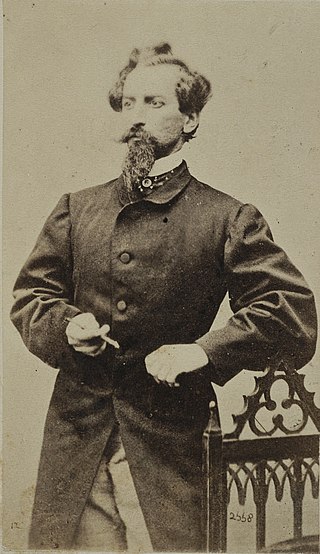 8
Francesco Nullo was an Italian patriot, military officer and merchant, and a close friend and confidant of Giuseppe Garibaldi. He supported independence movements in Italy and Poland. He was a...
8
Francesco Nullo was an Italian patriot, military officer and merchant, and a close friend and confidant of Giuseppe Garibaldi. He supported independence movements in Italy and Poland. He was a...
Antonio Salieri
 8
Antonio Salieri was an Italian composer and teacher of the classical period. He was born in Legnago, south of Verona, in the Republic of Venice, and spent his adult life and career as a subject of...
8
Antonio Salieri was an Italian composer and teacher of the classical period. He was born in Legnago, south of Verona, in the Republic of Venice, and spent his adult life and career as a subject of...
Giovanni Dandolo
 8
Giovanni Dandolo was the 48th Doge of Venice, elected late in his life on 31 March 1280. He died on 2 November 1289. During his reign, the first Venetian gold ducat was introduced into circulation.
8
Giovanni Dandolo was the 48th Doge of Venice, elected late in his life on 31 March 1280. He died on 2 November 1289. During his reign, the first Venetian gold ducat was introduced into circulation.
Gastone Sozzi
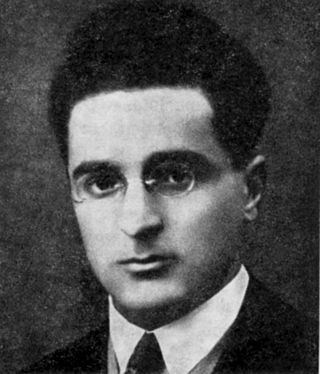 8
Gastone Sozzi è stato un politico italiano comunista, imprigionato, torturato e ucciso dalla polizia fascista.
8
Gastone Sozzi è stato un politico italiano comunista, imprigionato, torturato e ucciso dalla polizia fascista.
Bernardino Ramazzini
 8
Bernardino Ramazzini was an Italian physician.
8
Bernardino Ramazzini was an Italian physician.
Gerolamo Rovetta
 8
Gerolamo Rovetta was an Italian writer and playwright.
8
Gerolamo Rovetta was an Italian writer and playwright.
Cola di Rienzo
 8
Nicola Gabrini, commonly known as Cola di Rienzo or Rienzi, was an Italian politician and leader, who styled himself as the "tribune of the Roman people".
8
Nicola Gabrini, commonly known as Cola di Rienzo or Rienzi, was an Italian politician and leader, who styled himself as the "tribune of the Roman people".
Giuseppe Biasi
 8
Giuseppe Biasi was an Italian painter.
8
Giuseppe Biasi was an Italian painter.
Luigi Tenco
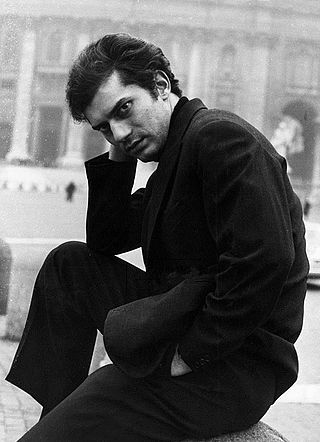 8
Luigi Tenco was an Italian singer-songwriter.
8
Luigi Tenco was an Italian singer-songwriter.
Annibale Caro
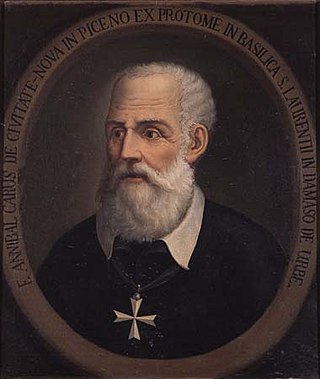 8
Fra' Annibale Caro, K.M., was an Italian writer and poet.
8
Fra' Annibale Caro, K.M., was an Italian writer and poet.
Guido Baccelli
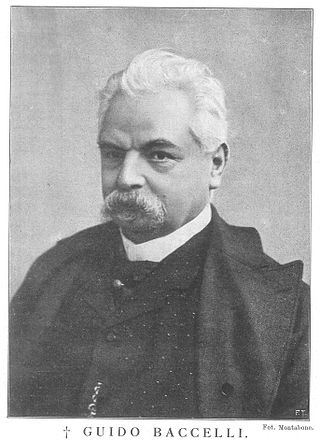 8
Guido Baccelli was an Italian physician and statesman. One of the most renowned Italian physicians of the late 19th century, he was Minister of Education of the then young Kingdom of Italy for six...
8
Guido Baccelli was an Italian physician and statesman. One of the most renowned Italian physicians of the late 19th century, he was Minister of Education of the then young Kingdom of Italy for six...
Attilio Deffenu
 8
Attilio Deffenu was an Italian journalist, soldier, exponent of Sardinian autonomism and a syndicalist.
8
Attilio Deffenu was an Italian journalist, soldier, exponent of Sardinian autonomism and a syndicalist.
Crispin and Crispinian
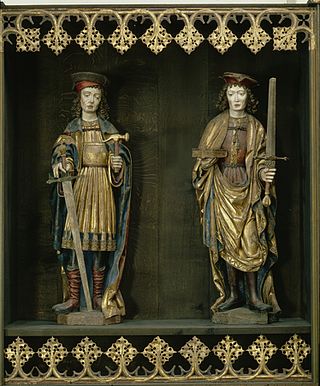 8
Saints Crispin and Crispinian are the Christian patron saints of cobblers, curriers, tanners, and leather workers. They were beheaded during the reign of Diocletian; the date of their execution is...
8
Saints Crispin and Crispinian are the Christian patron saints of cobblers, curriers, tanners, and leather workers. They were beheaded during the reign of Diocletian; the date of their execution is...
Roberto Rossellini
 8
Roberto Gastone Zeffiro Rossellini was an Italian film director, screenwriter and producer. He was one of the most prominent directors of the Italian neorealist cinema, contributing to the movement...
8
Roberto Gastone Zeffiro Rossellini was an Italian film director, screenwriter and producer. He was one of the most prominent directors of the Italian neorealist cinema, contributing to the movement...
Pino Puglisi
 8
Giuseppe "Pino" Puglisi was a Roman Catholic priest in the rough Palermo neighbourhood of Brancaccio. He openly challenged the Sicilian Mafia who controlled the neighbourhood, and was killed by them...
8
Giuseppe "Pino" Puglisi was a Roman Catholic priest in the rough Palermo neighbourhood of Brancaccio. He openly challenged the Sicilian Mafia who controlled the neighbourhood, and was killed by them...
Ivanoe Bonomi
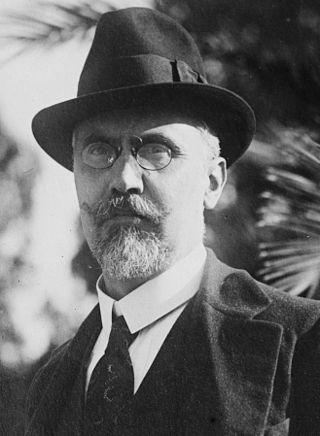 8
Ivanoe Bonomi was an Italian politician and journalist who served as Prime Minister of Italy from 1921 to 1922 and again from 1944 to 1945.
8
Ivanoe Bonomi was an Italian politician and journalist who served as Prime Minister of Italy from 1921 to 1922 and again from 1944 to 1945.
Desiderio de Langres
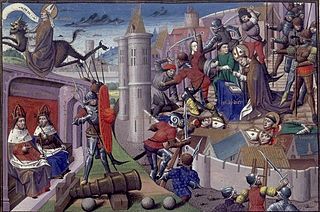 8
San Desiderio en latín Desiderius, obispo de Langres
8
San Desiderio en latín Desiderius, obispo de Langres
Gino Bartali
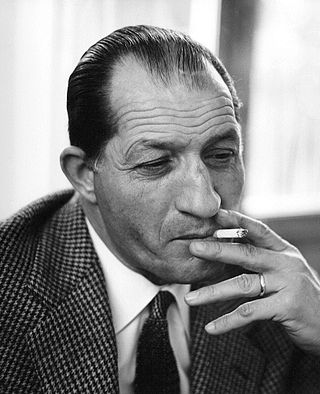 8
Gino Bartali,, nicknamed Gino the Pious and Ginettaccio, was a champion road cyclist. He was the most renowned Italian cyclist before the Second World War, having won the Giro d'Italia twice, in 1936...
8
Gino Bartali,, nicknamed Gino the Pious and Ginettaccio, was a champion road cyclist. He was the most renowned Italian cyclist before the Second World War, having won the Giro d'Italia twice, in 1936...
Aurelio Nicolodi
 8
Aurelio Nicolodi è stato un educatore ed irredentista italiano, fondatore dell'Unione italiana ciechi.
8
Aurelio Nicolodi è stato un educatore ed irredentista italiano, fondatore dell'Unione italiana ciechi.
Francesco Berni
 8
Francesco Berni was an Italian poet. He is credited for beginning what is now known as "Bernesque poetry", a serio-comedic type of poetry with elements of satire.
8
Francesco Berni was an Italian poet. He is credited for beginning what is now known as "Bernesque poetry", a serio-comedic type of poetry with elements of satire.
Macedonio Melloni
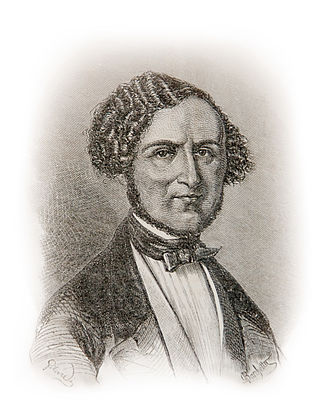 8
Macedonio Melloni was an Italian physicist, notable for demonstrating that radiant heat has similar physical properties to those of light.
8
Macedonio Melloni was an Italian physicist, notable for demonstrating that radiant heat has similar physical properties to those of light.
Simone Martini
 8
Simone Martini was an Italian painter born in Siena.
He was a major figure in the development of early Italian painting and greatly influenced the development of the International Gothic style.
8
Simone Martini was an Italian painter born in Siena.
He was a major figure in the development of early Italian painting and greatly influenced the development of the International Gothic style.
Giovanni Battista Candotti
 8
Giovanni Battista Candotti è stato un compositore, organista e presbitero italiano.
8
Giovanni Battista Candotti è stato un compositore, organista e presbitero italiano.
Antonello da Messina
 8
Antonello da Messina, properly Antonello di Giovanni di Antonio, but also called Antonello degli Antoni and Anglicized as Anthony of Messina, was an Italian painter from Messina, active during the...
8
Antonello da Messina, properly Antonello di Giovanni di Antonio, but also called Antonello degli Antoni and Anglicized as Anthony of Messina, was an Italian painter from Messina, active during the...
Teobaldo Ciconi
Gabriele Rossetti
 8
Gabriele Pasquale Giuseppe Rossetti was an Italian nobleman, poet, constitutionalist, scholar, and founder of the secret society Carbonari.
8
Gabriele Pasquale Giuseppe Rossetti was an Italian nobleman, poet, constitutionalist, scholar, and founder of the secret society Carbonari.
Sebastiano Venier
 8
Sebastiano Venier was Doge of Venice from 11 June 1577 to 3 March 1578. He is best remembered in his role as the Venetian admiral at the Battle of Lepanto.
8
Sebastiano Venier was Doge of Venice from 11 June 1577 to 3 March 1578. He is best remembered in his role as the Venetian admiral at the Battle of Lepanto.
Giovanni Marinelli
 8
Giovanni Marinelli was an Italian Fascist political leader.
8
Giovanni Marinelli was an Italian Fascist political leader.
Julius the Veteran
 8
Saint Julius the Veteran, also known as Julius of Durostorum, is a Roman Catholic, Anglican and Eastern Orthodox saint and martyr. His feast day is 27 May.
8
Saint Julius the Veteran, also known as Julius of Durostorum, is a Roman Catholic, Anglican and Eastern Orthodox saint and martyr. His feast day is 27 May.
Fidelis of Como
 8
Fidelis of Como was an Italian soldier-saint, according to Christian tradition.
8
Fidelis of Como was an Italian soldier-saint, according to Christian tradition.
Antioco Casula
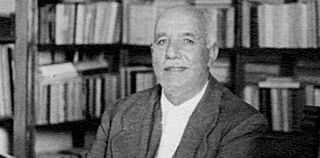 8
Antioco Giuseppe Casula, meglio noto come Montanaru, è stato uno dei più importanti poeti in lingua sarda logudorese.
8
Antioco Giuseppe Casula, meglio noto come Montanaru, è stato uno dei più importanti poeti in lingua sarda logudorese.
Enrico Costa (politician)
 8
Enrico Costa is an Italian politician and lawyer. His father, Raffaele Costa, was also a politician who was Italian Minister of Health in the first Amato government and the first Berlusconi...
8
Enrico Costa is an Italian politician and lawyer. His father, Raffaele Costa, was also a politician who was Italian Minister of Health in the first Amato government and the first Berlusconi...
Velio Spano
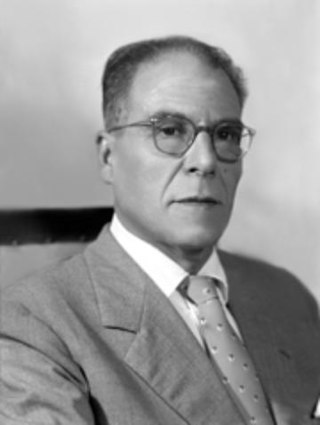 8
Velio Spano was a Sardinian-born antifascist activist and, at times, fighter through the Mussolini years. He is also remembered for his writings: he later came to be identified, increasingly, as a...
8
Velio Spano was a Sardinian-born antifascist activist and, at times, fighter through the Mussolini years. He is also remembered for his writings: he later came to be identified, increasingly, as a...
Terence of Pesaro
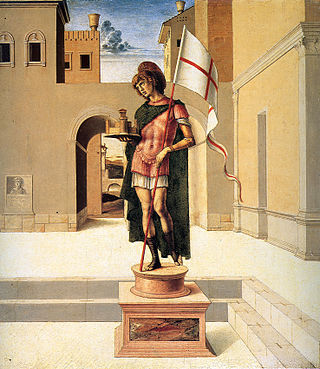 8
Saint Terence is the patron saint of Pesaro. According to tradition, he was from Pannonia and fled to the Adriatic coast to escape the persecution of Christians under Decius. His corpse was...
8
Saint Terence is the patron saint of Pesaro. According to tradition, he was from Pannonia and fled to the Adriatic coast to escape the persecution of Christians under Decius. His corpse was...
Vittorino da Feltre
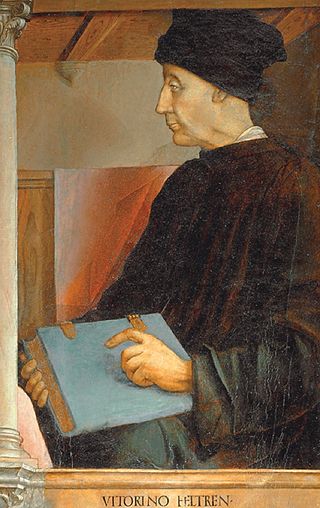 8
Vittorino da Feltre was an Italian humanist and teacher. He was born in Feltre, Belluno, Republic of Venice and died in Mantua. His real name was Vittorino Rambaldoni. It was in Vittorino that the...
8
Vittorino da Feltre was an Italian humanist and teacher. He was born in Feltre, Belluno, Republic of Venice and died in Mantua. His real name was Vittorino Rambaldoni. It was in Vittorino that the...
Eduardo De Filippo
 8
Eduardo De Filippo OMRI, also known simply as Eduardo, was an Italian actor, director, screenwriter and playwright, best known for his Neapolitan works Filumena Marturano and Napoli Milionaria....
8
Eduardo De Filippo OMRI, also known simply as Eduardo, was an Italian actor, director, screenwriter and playwright, best known for his Neapolitan works Filumena Marturano and Napoli Milionaria....
Erasmo di Valvasone
 8
Erasmo di Valvasone, o Erasmo da Valvason, è stato un poeta e traduttore italiano.
8
Erasmo di Valvasone, o Erasmo da Valvason, è stato un poeta e traduttore italiano.
Antonio Zanon
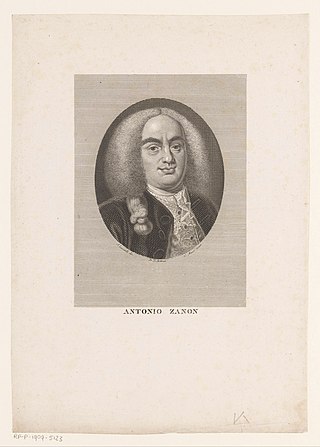 8
Antonio Zanon è stato un imprenditore, agronomo ed economista italiano del Settecento. Portò nell'economia friulana le idee dell'Illuminismo europeo.
8
Antonio Zanon è stato un imprenditore, agronomo ed economista italiano del Settecento. Portò nell'economia friulana le idee dell'Illuminismo europeo.
Giuseppe Mercalli
 8
Giuseppe Mercalli was an Italian volcanologist and Catholic priest. He is known best for the Mercalli intensity scale for measuring earthquake intensity.
8
Giuseppe Mercalli was an Italian volcanologist and Catholic priest. He is known best for the Mercalli intensity scale for measuring earthquake intensity.
Peppino Mereu
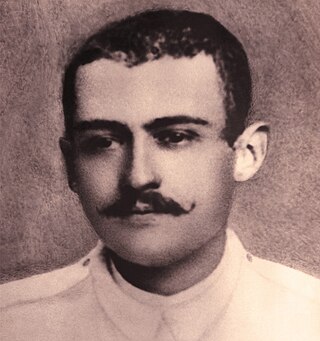 8
Peppino Mereu è stato uno dei poeti in lingua sarda più importanti di fine Ottocento, nonché autore di Nanneddu meu, divenuto uno dei canti più popolari della Sardegna.
8
Peppino Mereu è stato uno dei poeti in lingua sarda più importanti di fine Ottocento, nonché autore di Nanneddu meu, divenuto uno dei canti più popolari della Sardegna.
Lao Silesu
 8
Stanislao Silesu was an Italian composer. His father Luigi was organist at the Cathedral of Santa Clara.
8
Stanislao Silesu was an Italian composer. His father Luigi was organist at the Cathedral of Santa Clara.
Geminianus
 8
Saint Geminianus was a fourth-century deacon who became Bishop of Modena. He is mentioned in the year 390, when he participated in a council called by Saint Ambrose in Milan. From his name, it has...
8
Saint Geminianus was a fourth-century deacon who became Bishop of Modena. He is mentioned in the year 390, when he participated in a council called by Saint Ambrose in Milan. From his name, it has...
Ildebrando Pizzetti
 8
Ildebrando Pizzetti was an Italian composer of classical music, musicologist, and music critic.
8
Ildebrando Pizzetti was an Italian composer of classical music, musicologist, and music critic.
Johannes Kepler
 8
Johannes Kepler was a German astronomer, mathematician, astrologer, natural philosopher and writer on music. He is a key figure in the 17th-century Scientific Revolution, best known for his laws of...
8
Johannes Kepler was a German astronomer, mathematician, astrologer, natural philosopher and writer on music. He is a key figure in the 17th-century Scientific Revolution, best known for his laws of...
Salvatore Carnevale
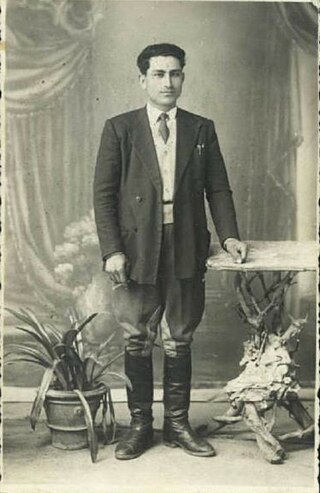 8
Salvatore Carnevale, detto Turi, è stato un sindacalista e politico italiano.
8
Salvatore Carnevale, detto Turi, è stato un sindacalista e politico italiano.
Mosè Bianchi
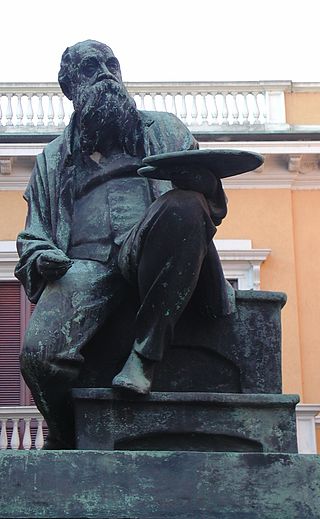 7
Mosè Bianchi (1840–1904) was an Italian painter and printmaker.
7
Mosè Bianchi (1840–1904) was an Italian painter and printmaker.
Carlo Matteucci
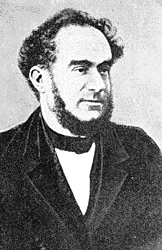 7
Carlo Matteucci was an Italian physicist and neurophysiologist who was a pioneer in the study of bioelectricity.
7
Carlo Matteucci was an Italian physicist and neurophysiologist who was a pioneer in the study of bioelectricity.
Antonio Carini
 7
Antonio Carini (1872–1950) was an Italian physician, bacteriologist and professor. He worked in the public health services of São Paulo, Brazil for over forty years.
Carini showed that rabies of...
7
Antonio Carini (1872–1950) was an Italian physician, bacteriologist and professor. He worked in the public health services of São Paulo, Brazil for over forty years.
Carini showed that rabies of...
Ivo Oliveti
 7
Ivo Oliveti è stato un politico, aviatore e militare italiano, veterano della prima guerra mondiale e successivamente Segretario federale del Partito Nazionale Fascista, sezione Emiliano-romagnola, e...
7
Ivo Oliveti è stato un politico, aviatore e militare italiano, veterano della prima guerra mondiale e successivamente Segretario federale del Partito Nazionale Fascista, sezione Emiliano-romagnola, e...
Paolo Boselli
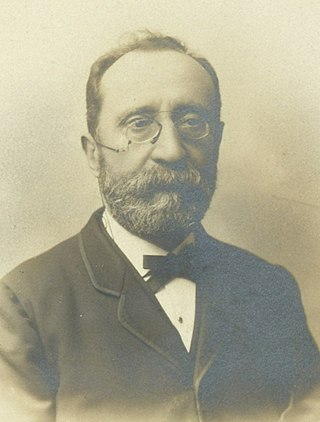 7
Paolo Boselli was an Italian politician who served as the 34th prime minister of Italy during World War I.
7
Paolo Boselli was an Italian politician who served as the 34th prime minister of Italy during World War I.
Julia of Corsica
 7
Julia of Corsica, also known as Julia of Carthage, and more rarely Julia of Nonza, was a virgin and martyr who is venerated as a saint. The date of her death is most probably on or after AD 439. She...
7
Julia of Corsica, also known as Julia of Carthage, and more rarely Julia of Nonza, was a virgin and martyr who is venerated as a saint. The date of her death is most probably on or after AD 439. She...
Leo Tolstoy
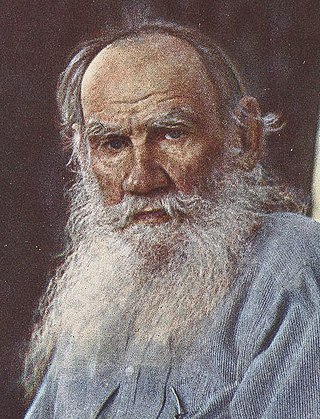 7
Count Lev Nikolayevich Tolstoy, usually referred to in English as Leo Tolstoy, was a Russian writer. He is regarded as one of the greatest and most influential authors of all time. He received...
7
Count Lev Nikolayevich Tolstoy, usually referred to in English as Leo Tolstoy, was a Russian writer. He is regarded as one of the greatest and most influential authors of all time. He received...
Giuseppe Missori
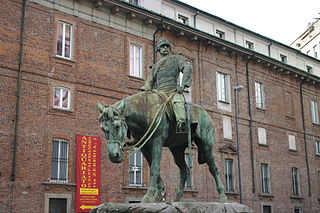 7
Giuseppe Missori was an Italian patriot, military leader during the Italian unification, and politician. He served under Garibaldi during the Second Italian War of Independence, the Expedition of the...
7
Giuseppe Missori was an Italian patriot, military leader during the Italian unification, and politician. He served under Garibaldi during the Second Italian War of Independence, the Expedition of the...
Aristide Gabelli
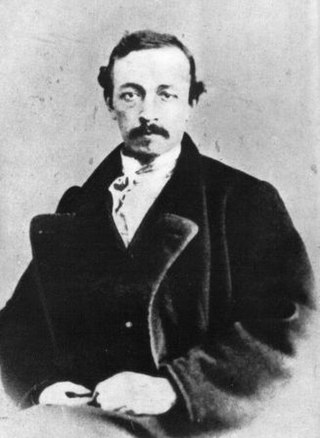 7
Aristide Gabelli è stato un pedagogista, politico e filosofo positivista italiano.
7
Aristide Gabelli è stato un pedagogista, politico e filosofo positivista italiano.
Brigid of Kildare
 7
Saint Brigid of Kildare or Saint Brigid of Ireland is the patroness saint of Ireland, and one of its three national saints along with Patrick and Columba. According to medieval Irish hagiographies,...
7
Saint Brigid of Kildare or Saint Brigid of Ireland is the patroness saint of Ireland, and one of its three national saints along with Patrick and Columba. According to medieval Irish hagiographies,...
Giovanni Villani
 7
Giovanni Villani was an Italian banker, official, diplomat and chronicler from Florence who wrote the Nuova Cronica on the history of Florence. He was a leading statesman of Florence but later gained...
7
Giovanni Villani was an Italian banker, official, diplomat and chronicler from Florence who wrote the Nuova Cronica on the history of Florence. He was a leading statesman of Florence but later gained...
Gaetano Previati
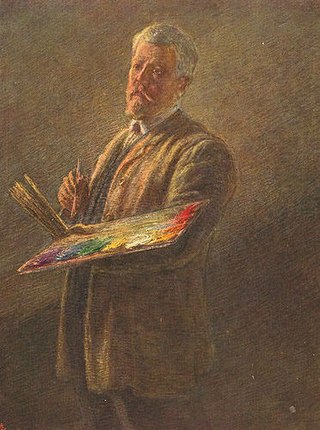 7
Gaetano Previati (1852–1920) was an Italian Symbolist painter in the Divisionist style.
7
Gaetano Previati (1852–1920) was an Italian Symbolist painter in the Divisionist style.
Giovanni Marradi
 7
Giovanni Marradi (1852–1922) was an Italian poet born at Livorno, Grand Duchy of Tuscany, and educated at Pisa and Florence. At the latter place, he started with others a short-lived review, the...
7
Giovanni Marradi (1852–1922) was an Italian poet born at Livorno, Grand Duchy of Tuscany, and educated at Pisa and Florence. At the latter place, he started with others a short-lived review, the...
Carlo Stuparich
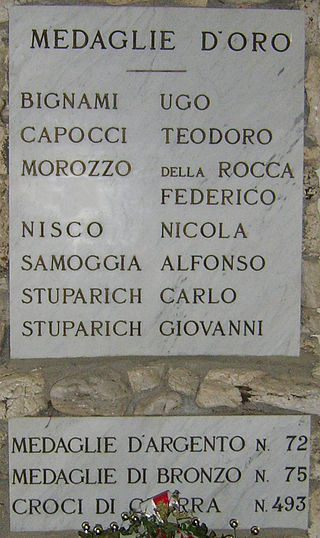 7
Carlo Stuparich was an Italian writer, patriot and war hero. His one substantive work was published only posthumously, on the initiative of his elder brother, Giovanni "Giani" Stuparich (1891–1961),...
7
Carlo Stuparich was an Italian writer, patriot and war hero. His one substantive work was published only posthumously, on the initiative of his elder brother, Giovanni "Giani" Stuparich (1891–1961),...
Terenzio, Count Mamiani della Rovere
 7
Terenzio, Count Mamiani della Rovere was an Italian writer, academic, diplomat and politician, and was committed to the cause of the unification of Italy under the Sardinian monarchy. He was one of...
7
Terenzio, Count Mamiani della Rovere was an Italian writer, academic, diplomat and politician, and was committed to the cause of the unification of Italy under the Sardinian monarchy. He was one of...
Carlos Pellegrini
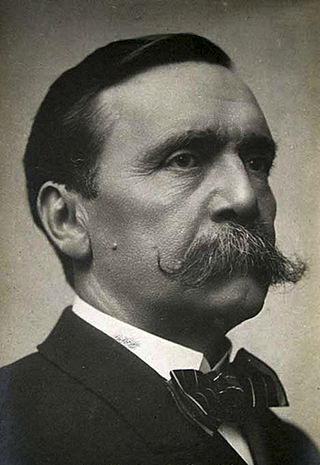 7
Carlos Enrique José Pellegrini Bevans was Vice President of Argentina and became President of Argentina from August 6, 1890 to October 12, 1892, upon Miguel Ángel Juárez Celman's resignation.
7
Carlos Enrique José Pellegrini Bevans was Vice President of Argentina and became President of Argentina from August 6, 1890 to October 12, 1892, upon Miguel Ángel Juárez Celman's resignation.
Luigi Cagnola
 7
Marchese Luigi Cagnola was a Neoclassical Italian architect.
7
Marchese Luigi Cagnola was a Neoclassical Italian architect.
Giovanni Dupré
 7
Giovanni Dupré was an Italian sculptor, of distant French stock long settled in Tuscany, who developed a reputation second only to that of his contemporary Lorenzo Bartolini.
7
Giovanni Dupré was an Italian sculptor, of distant French stock long settled in Tuscany, who developed a reputation second only to that of his contemporary Lorenzo Bartolini.
Agnolo Firenzuola
Lord Byron
 7
George Gordon Byron, 6th Baron Byron was a British poet and peer. He is one of the major figures of the Romantic movement, and is regarded as being among the greatest of English poets. Among his...
7
George Gordon Byron, 6th Baron Byron was a British poet and peer. He is one of the major figures of the Romantic movement, and is regarded as being among the greatest of English poets. Among his...
Tancredi Galimberti
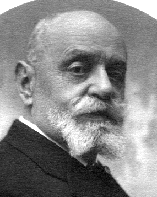 7
Tancredi Galimberti was an Italian politician during the first part of the twentieth century. He served as Minister for Postal and Telegraphic communications in the Zanardelli government between 1901...
7
Tancredi Galimberti was an Italian politician during the first part of the twentieth century. He served as Minister for Postal and Telegraphic communications in the Zanardelli government between 1901...
Plautus
 7
Titus Maccius Plautus was a Roman playwright of the Old Latin period. His comedies are the earliest Latin literary works to have survived in their entirety. He wrote Palliata comoedia, the genre...
7
Titus Maccius Plautus was a Roman playwright of the Old Latin period. His comedies are the earliest Latin literary works to have survived in their entirety. He wrote Palliata comoedia, the genre...
Alberto Savinio
 7
Alberto Savinio, born as Andrea Francesco Alberto de Chirico was a Greek-Italian writer, painter, musician, journalist, essayist, playwright, set designer and composer. He was the younger brother of...
7
Alberto Savinio, born as Andrea Francesco Alberto de Chirico was a Greek-Italian writer, painter, musician, journalist, essayist, playwright, set designer and composer. He was the younger brother of...
Aldus Manutius
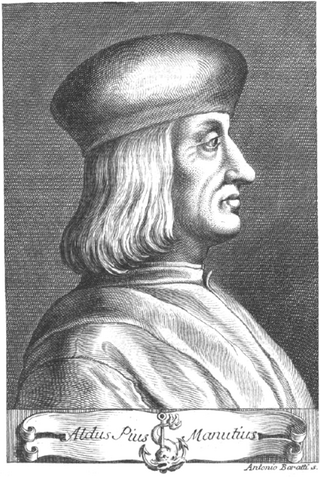 7
Aldus Pius Manutius was an Italian printer and humanist who founded the Aldine Press. Manutius devoted the later part of his life to publishing and disseminating rare texts. His interest in and...
7
Aldus Pius Manutius was an Italian printer and humanist who founded the Aldine Press. Manutius devoted the later part of his life to publishing and disseminating rare texts. His interest in and...
Carl Linnaeus
 7
Carl Linnaeus, also known after ennoblement in 1761 as Carl von Linné, was a Swedish biologist and physician who formalised binomial nomenclature, the modern system of naming organisms. He is known...
7
Carl Linnaeus, also known after ennoblement in 1761 as Carl von Linné, was a Swedish biologist and physician who formalised binomial nomenclature, the modern system of naming organisms. He is known...
Michele Gortani
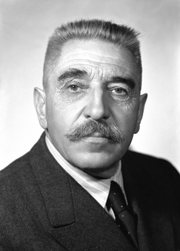 7
Michele Gortani was an Italian geologist, entomologist, and politician. He was a specialist on the Carnian Alps where he grew up and worked for much of his life.
7
Michele Gortani was an Italian geologist, entomologist, and politician. He was a specialist on the Carnian Alps where he grew up and worked for much of his life.
Giuseppe Mengoni
 7
Giuseppe Mengoni was an Italian architect. He designed the Galleria Vittorio Emanuele II in Milan. He also designed the Palazzo di Residenza of Bologna Saving Bank (Carisbo). He died by accident,...
7
Giuseppe Mengoni was an Italian architect. He designed the Galleria Vittorio Emanuele II in Milan. He also designed the Palazzo di Residenza of Bologna Saving Bank (Carisbo). He died by accident,...
Gustavo Modena
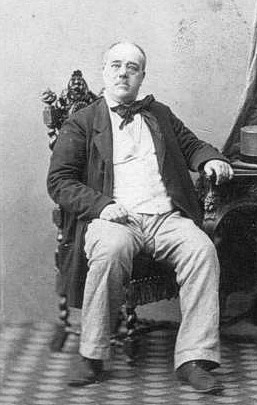 7
Gustavo Modena è stato un attore teatrale e patriota italiano.
7
Gustavo Modena è stato un attore teatrale e patriota italiano.
Beppe Fenoglio
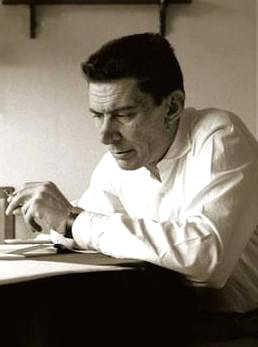 7
Giuseppe "Beppe" Fenoglio was an Italian writer, partisan and translator from English.
7
Giuseppe "Beppe" Fenoglio was an Italian writer, partisan and translator from English.
Lorenzo Bartolini
 7
Lorenzo Bartolini was an Italian sculptor who infused his neoclassicism with a strain of sentimental piety and naturalistic detail, while he drew inspiration from the sculpture of the Florentine...
7
Lorenzo Bartolini was an Italian sculptor who infused his neoclassicism with a strain of sentimental piety and naturalistic detail, while he drew inspiration from the sculpture of the Florentine...
Enrico Panzacchi
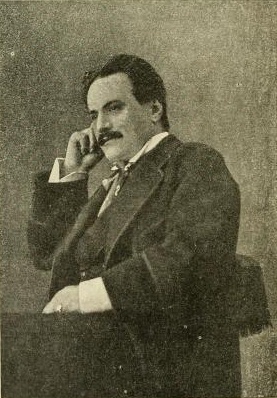 7
Enrico Panzacchi è stato un poeta, critico d'arte, politico critico musicale italiano, nonché oratore e prosatore.
7
Enrico Panzacchi è stato un poeta, critico d'arte, politico critico musicale italiano, nonché oratore e prosatore.
Pellegrino Matteucci
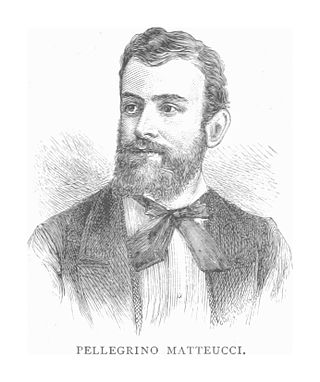 7
Doctor Pellegrino Matteucci was an Italian explorer known for his expeditions to Africa.
7
Doctor Pellegrino Matteucci was an Italian explorer known for his expeditions to Africa.
Januarius
 7
Januarius, also known as Januarius I of Benevento, was Bishop of Benevento and is a martyr and saint of the Catholic Church and the Eastern Orthodox Church. While no contemporary sources on his life...
7
Januarius, also known as Januarius I of Benevento, was Bishop of Benevento and is a martyr and saint of the Catholic Church and the Eastern Orthodox Church. While no contemporary sources on his life...
Aeneas
 7
In Greco-Roman mythology, Aeneas was a Trojan hero, the son of the Trojan prince Anchises and the Greek goddess Aphrodite. His father was a first cousin of King Priam of Troy, making Aeneas a second...
7
In Greco-Roman mythology, Aeneas was a Trojan hero, the son of the Trojan prince Anchises and the Greek goddess Aphrodite. His father was a first cousin of King Priam of Troy, making Aeneas a second...
Panfilo Castaldi
 7
Panfilo Castaldi was an Italian physician and "master of the art of printing", to whom local tradition attributes the invention of moveable type. He was born in Feltre but spent most of his life...
7
Panfilo Castaldi was an Italian physician and "master of the art of printing", to whom local tradition attributes the invention of moveable type. He was born in Feltre but spent most of his life...
Giustino Fortunato
 7
Giustino Fortunato was an Italian historian and politician.
7
Giustino Fortunato was an Italian historian and politician.
Vincenzo Cuoco
 7
Vincenzo Cuoco was an Italian writer. He is mainly remembered for his Saggio Storico sulla Rivoluzione Napoletana del 1799. He is considered as one of the precursors of the realist school and Italian...
7
Vincenzo Cuoco was an Italian writer. He is mainly remembered for his Saggio Storico sulla Rivoluzione Napoletana del 1799. He is considered as one of the precursors of the realist school and Italian...
Gaspara Stampa
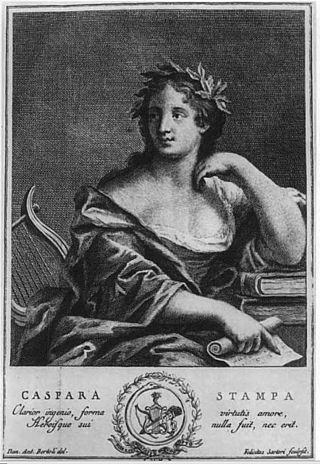 7
Gaspara Stampa was an Italian poet. She is considered to have been the greatest woman poet of the Italian Renaissance, and she is regarded by many as the greatest Italian woman poet of any age.
7
Gaspara Stampa was an Italian poet. She is considered to have been the greatest woman poet of the Italian Renaissance, and she is regarded by many as the greatest Italian woman poet of any age.
Andrea Appiani
 7
Andrea Appiani was an Italian neoclassical painter.
7
Andrea Appiani was an Italian neoclassical painter.
Carlo De Cristoforis
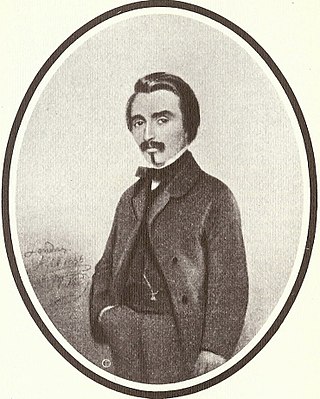 7
Carlo De Cristoforis è stato un patriota italiano, veterano delle cinque giornate, economista, autore di un celebre testo di teoria militare. Capitano dei Cacciatori delle Alpi, cadde nella battaglia...
7
Carlo De Cristoforis è stato un patriota italiano, veterano delle cinque giornate, economista, autore di un celebre testo di teoria militare. Capitano dei Cacciatori delle Alpi, cadde nella battaglia...
Giuseppe Sacconi
 7
Giuseppe Sacconi was an Italian architect. He is best known as the designer of the monument of Vittorio Emanuele II, in the centre of Rome. Following the prestigious commission, he became one of the...
7
Giuseppe Sacconi was an Italian architect. He is best known as the designer of the monument of Vittorio Emanuele II, in the centre of Rome. Following the prestigious commission, he became one of the...
Teofilo Folengo
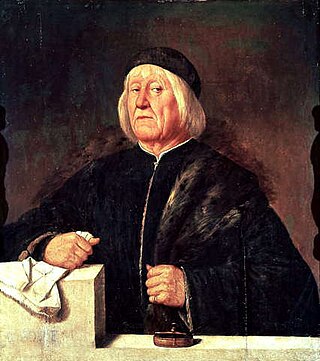 7
Teofilo Folengo, who wrote under the pseudonym of Merlino Coccajo or Merlinus Cocaius in Latin, was one of the principal Italian macaronic poets.
7
Teofilo Folengo, who wrote under the pseudonym of Merlino Coccajo or Merlinus Cocaius in Latin, was one of the principal Italian macaronic poets.
Pierre Curie
 7
Pierre Curie was a French physicist, a pioneer in crystallography, magnetism, piezoelectricity, and radioactivity. In 1903, he received the Nobel Prize in Physics with his wife, Marie...
7
Pierre Curie was a French physicist, a pioneer in crystallography, magnetism, piezoelectricity, and radioactivity. In 1903, he received the Nobel Prize in Physics with his wife, Marie...
Giacinto Gallina
 7
Giacinto Gallina è stato un commediografo italiano, considerato l'erede della grande stagione goldoniana.
7
Giacinto Gallina è stato un commediografo italiano, considerato l'erede della grande stagione goldoniana.
Pietro Giordani
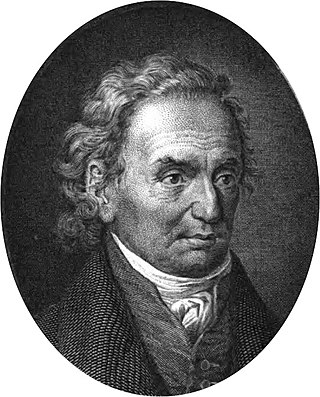 7
Pietro Giordani was an Italian writer, classical literary scholar, and a close friend of, and influence on, Giacomo Leopardi.
7
Pietro Giordani was an Italian writer, classical literary scholar, and a close friend of, and influence on, Giacomo Leopardi.
Giaime Pintor
 7
Giaime Pintor è stato un giornalista, scrittore e partigiano italiano.
7
Giaime Pintor è stato un giornalista, scrittore e partigiano italiano.
Iris Versari
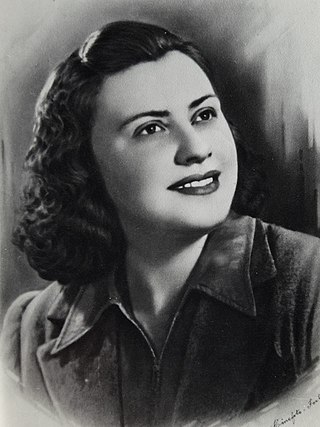 7
Iris Versari was an Italian partisan from Emilia-Romagna who was decorated with a Gold Medal of Military Valour on 16 April 1976.
7
Iris Versari was an Italian partisan from Emilia-Romagna who was decorated with a Gold Medal of Military Valour on 16 April 1976.
Pier Giorgio Frassati
 7
Pier Giorgio Frassati was an Italian Catholic activist and a member of the Third Order of Saint Dominic. He was dedicated to Catholic social justice issues and joined several charitable...
7
Pier Giorgio Frassati was an Italian Catholic activist and a member of the Third Order of Saint Dominic. He was dedicated to Catholic social justice issues and joined several charitable...
Ferruccio Busoni
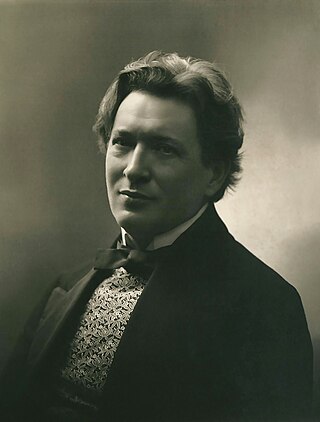 7
Ferruccio Busoni was an Italian composer, pianist, conductor, editor, writer, and teacher. His international career and reputation led him to work closely with many of the leading musicians, artists...
7
Ferruccio Busoni was an Italian composer, pianist, conductor, editor, writer, and teacher. His international career and reputation led him to work closely with many of the leading musicians, artists...
Gaetano Filangieri
 7
Gaetano Filangieri was an Italian jurist and philosopher.
7
Gaetano Filangieri was an Italian jurist and philosopher.
Onuphrius
 7
Onuphrius lived as a hermit in the desert of Upper Egypt in the 4th or 5th centuries. He is venerated as Saint Onuphrius in both the Roman Catholic and Eastern Catholic churches, as Venerable...
7
Onuphrius lived as a hermit in the desert of Upper Egypt in the 4th or 5th centuries. He is venerated as Saint Onuphrius in both the Roman Catholic and Eastern Catholic churches, as Venerable...
Galen
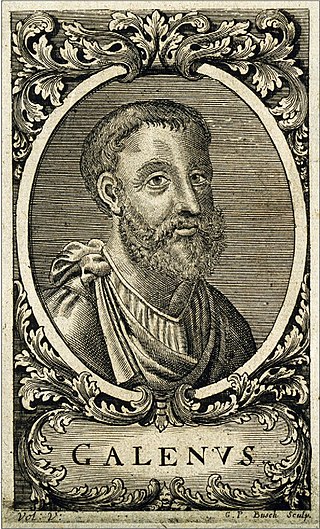 7
Aelius Galenus or Claudius Galenus, often anglicized as Galen or Galen of Pergamon, was a Roman and Greek physician, surgeon, and philosopher. Considered to be one of the most accomplished of all...
7
Aelius Galenus or Claudius Galenus, often anglicized as Galen or Galen of Pergamon, was a Roman and Greek physician, surgeon, and philosopher. Considered to be one of the most accomplished of all...
Orazio Vecchi
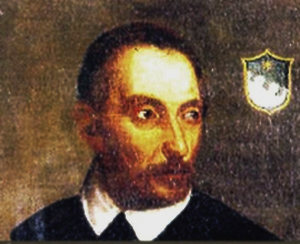 7
Orazio Vecchi was an Italian composer of the late Renaissance. He is most famous for his madrigal comedies, particularly L'Amfiparnaso.
7
Orazio Vecchi was an Italian composer of the late Renaissance. He is most famous for his madrigal comedies, particularly L'Amfiparnaso.
Odoric of Pordenone
 7
Odoric of Pordenone, was a Franciscan friar and missionary explorer from Friuli in northeast Italy. He journeyed through India, Sumatra, Java, and China, where he spent three years in the imperial...
7
Odoric of Pordenone, was a Franciscan friar and missionary explorer from Friuli in northeast Italy. He journeyed through India, Sumatra, Java, and China, where he spent three years in the imperial...
Paolo Mantegazza
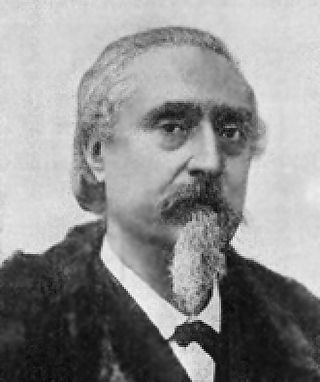 7
Paolo Mantegazza was an Italian neurologist, physiologist, and anthropologist, known for his experimental investigation of coca leaves and its effects on the human psyche. He was also an author of...
7
Paolo Mantegazza was an Italian neurologist, physiologist, and anthropologist, known for his experimental investigation of coca leaves and its effects on the human psyche. He was also an author of...
Emilio Visconti Venosta
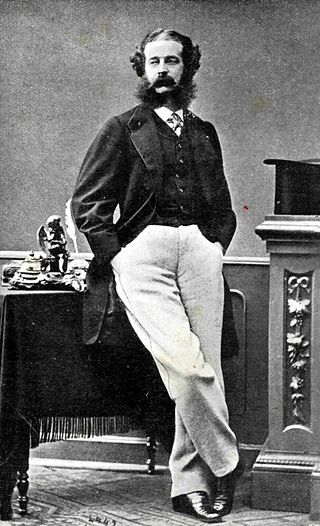 7
Emilio, marquis Visconti-Venosta was an Italian statesman. He is one of the longest-serving Ministers of Foreign Affairs in the history of Italy.
7
Emilio, marquis Visconti-Venosta was an Italian statesman. He is one of the longest-serving Ministers of Foreign Affairs in the history of Italy.
Giuseppe Rovani
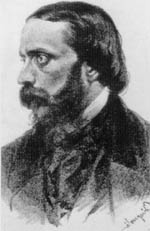 7
Giuseppe Rovani was an Italian novelist and essayist.
7
Giuseppe Rovani was an Italian novelist and essayist.
Jacopo Sansovino
 7
Jacopo d'Antonio Sansovino was an Italian Renaissance sculptor and architect, best known for his works around the Piazza San Marco in Venice. These are crucial works in the history of Venetian...
7
Jacopo d'Antonio Sansovino was an Italian Renaissance sculptor and architect, best known for his works around the Piazza San Marco in Venice. These are crucial works in the history of Venetian...
Vittorio Bersezio
Mario Rapisardi
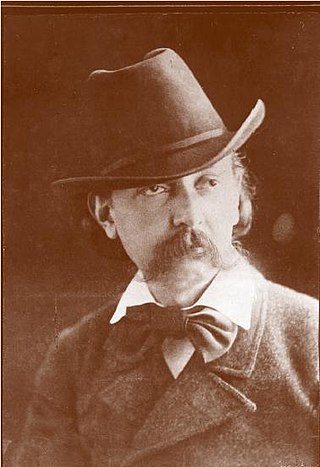 7
Mario Rapisardi was an Italian poet, supporter of Risorgimento and member of the Scapigliatura.
7
Mario Rapisardi was an Italian poet, supporter of Risorgimento and member of the Scapigliatura.
Theodoric the Great
 7
Theodoric the Great, also called Theodoric the Amal, was king of the Ostrogoths (475–526), and ruler of the independent Ostrogothic Kingdom of Italy between 493 and 526, regent of the Visigoths...
7
Theodoric the Great, also called Theodoric the Amal, was king of the Ostrogoths (475–526), and ruler of the independent Ostrogothic Kingdom of Italy between 493 and 526, regent of the Visigoths...
Francesco Morosini
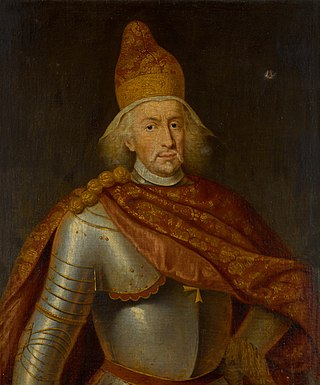 7
Francesco Morosini was the Doge of Venice from 1688 to 1694, at the height of the Great Turkish War. He was one of the many Doges and generals produced by the Venetian noble Morosini family. He is...
7
Francesco Morosini was the Doge of Venice from 1688 to 1694, at the height of the Great Turkish War. He was one of the many Doges and generals produced by the Venetian noble Morosini family. He is...
Alessandro Poerio
 7
Alessandro Poerio, Italian poet and patriot, The son of Baron Giuseppe Poerio, and uncle of the Neapolitan author Vittorio Imbriani (1840-1886) and his brother the radical politician Matteo Renato...
7
Alessandro Poerio, Italian poet and patriot, The son of Baron Giuseppe Poerio, and uncle of the Neapolitan author Vittorio Imbriani (1840-1886) and his brother the radical politician Matteo Renato...
Ferrante Aporti
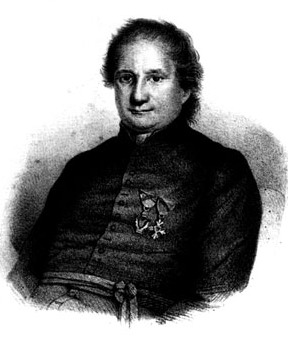 7
Ferrante Aporti was an Italian educator and theologian.
7
Ferrante Aporti was an Italian educator and theologian.
Raimondo Montecuccoli
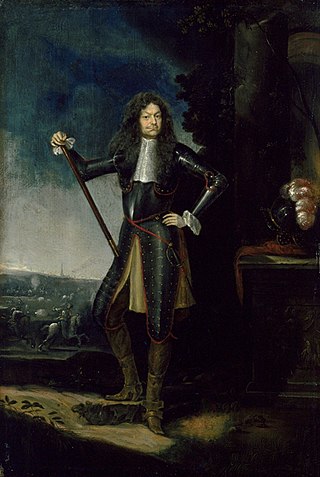 7
Raimondo Montecuccoli was an Italian-born professional soldier, military theorist, and diplomat, who served the Habsburg monarchy.
7
Raimondo Montecuccoli was an Italian-born professional soldier, military theorist, and diplomat, who served the Habsburg monarchy.
Ugo Pellis
 7
Ugo Pellis è stato un letterato e fotografo italiano.
7
Ugo Pellis è stato un letterato e fotografo italiano.
Antonio Scarpa
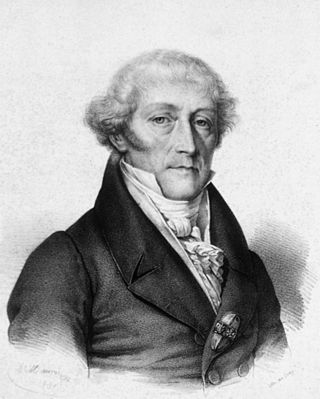 7
Antonio Scarpa was an Italian anatomist and professor.
7
Antonio Scarpa was an Italian anatomist and professor.
Paschal Baylón
 7
Paschal Baylón was a Spanish Roman Catholic lay professed religious of the Order of Friars Minor. He served as a shepherd alongside his father in his childhood and adolescence, but desired to enter...
7
Paschal Baylón was a Spanish Roman Catholic lay professed religious of the Order of Friars Minor. He served as a shepherd alongside his father in his childhood and adolescence, but desired to enter...
Amadeus VI, Count of Savoy
 7
Amadeus VI, nicknamed the Green Count was Count of Savoy from 1343 to 1383. He was the eldest son of Aymon, Count of Savoy, and Yolande Palaeologina of Montferrat. Though he started under a regency,...
7
Amadeus VI, nicknamed the Green Count was Count of Savoy from 1343 to 1383. He was the eldest son of Aymon, Count of Savoy, and Yolande Palaeologina of Montferrat. Though he started under a regency,...
Carlo Casalegno
 7
Carlo Casalegno was an Italian journalist and writer. He was killed by a group of four terrorists belonging to the Red Brigades; he was the first journalist ever to be killed during the Years of...
7
Carlo Casalegno was an Italian journalist and writer. He was killed by a group of four terrorists belonging to the Red Brigades; he was the first journalist ever to be killed during the Years of...
Ettore Pais
 7
Ettore Pais was an ancient historian, Latin epigrapher, and an Italian politician.
7
Ettore Pais was an ancient historian, Latin epigrapher, and an Italian politician.
Alberto Sordi
 7
Alberto Sordi was an Italian actor, comedian, director, singer, and screenwriter.
7
Alberto Sordi was an Italian actor, comedian, director, singer, and screenwriter.
Francesco Saverio Nitti
 7
Francesco Saverio Vincenzo de Paola Nitti was an Italian economist and political figure. A member of the Italian Radical Party, Nitti served as Prime Minister of Italy between 1919 and 1920. An...
7
Francesco Saverio Vincenzo de Paola Nitti was an Italian economist and political figure. A member of the Italian Radical Party, Nitti served as Prime Minister of Italy between 1919 and 1920. An...
Jacopo Linussio
 7
Jacopo Linussio è stato un imprenditore italiano.
7
Jacopo Linussio è stato un imprenditore italiano.
Luigi Faidutti
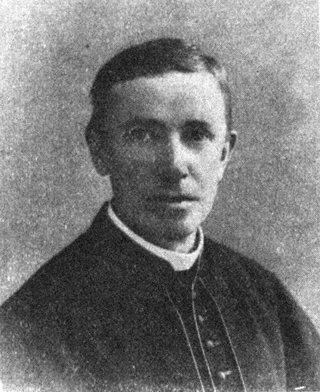 7
Luigi Faidutti è stato un presbitero e politico austriaco di etnia friulana.
7
Luigi Faidutti è stato un presbitero e politico austriaco di etnia friulana.
Teresa Noce
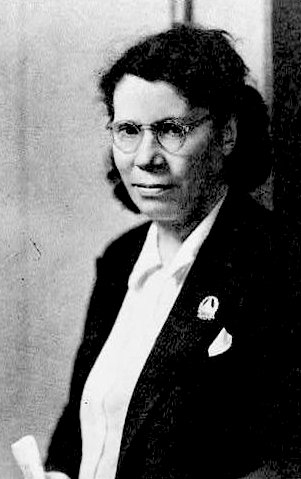 7
Teresa Noce was an Italian labor leader, activist, journalist and feminist. She served as a parliamentary deputy and advocated broad social legislation benefiting mothers.
7
Teresa Noce was an Italian labor leader, activist, journalist and feminist. She served as a parliamentary deputy and advocated broad social legislation benefiting mothers.
Oriana Fallaci
 7
Oriana Fallaci was an Italian journalist and author. A member of the Italian resistance movement during World War II, she had a long and successful journalistic career. Fallaci became famous...
7
Oriana Fallaci was an Italian journalist and author. A member of the Italian resistance movement during World War II, she had a long and successful journalistic career. Fallaci became famous...
Angelo Brofferio
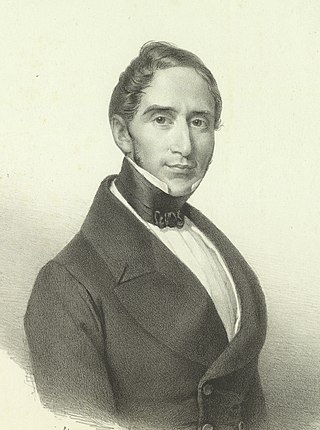 7
Angelo Brofferio was a Piedmontese and Italian poet and politician, active during the period of Italian unification.
7
Angelo Brofferio was a Piedmontese and Italian poet and politician, active during the period of Italian unification.
Francesco Cocco-Ortu
 7
Francesco Cocco-Ortu è stato un politico italiano, deputato del Regno.
7
Francesco Cocco-Ortu è stato un politico italiano, deputato del Regno.
Luxorius (saint)
 7
Luxurius or Luxorius was an ancient Roman official on Sardinia in the late 3rd and early 4th centuries. Apparitor to Delphius, the praeses or governor of the island, he was converted to Christianity...
7
Luxurius or Luxorius was an ancient Roman official on Sardinia in the late 3rd and early 4th centuries. Apparitor to Delphius, the praeses or governor of the island, he was converted to Christianity...
Mario Sironi
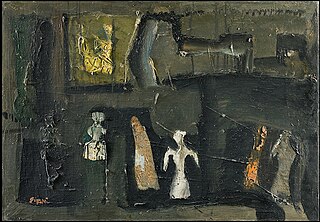 7
Mario Sironi was an Italian Modernist artist who was active as a painter, sculptor, illustrator, and designer. His typically somber paintings are characterized by massive, immobile forms.
7
Mario Sironi was an Italian Modernist artist who was active as a painter, sculptor, illustrator, and designer. His typically somber paintings are characterized by massive, immobile forms.
Alberto Moravia
 7
Alberto Pincherle, known by his pseudonym Alberto Moravia, was an Italian novelist and journalist. His novels explored matters of modern sexuality, social alienation and existentialism. Moravia is...
7
Alberto Pincherle, known by his pseudonym Alberto Moravia, was an Italian novelist and journalist. His novels explored matters of modern sexuality, social alienation and existentialism. Moravia is...
Francesco Manno
 7
Francesco Manno was an Italian painter and architect of the Neoclassical style.
7
Francesco Manno was an Italian painter and architect of the Neoclassical style.
Emilio Segrè
 7
Emilio Gino Segrè was an Italian and naturalized-American physicist and Nobel laureate, who discovered the elements technetium and astatine, and the antiproton, a subatomic antiparticle, for which he...
7
Emilio Gino Segrè was an Italian and naturalized-American physicist and Nobel laureate, who discovered the elements technetium and astatine, and the antiproton, a subatomic antiparticle, for which he...
Elio Monari
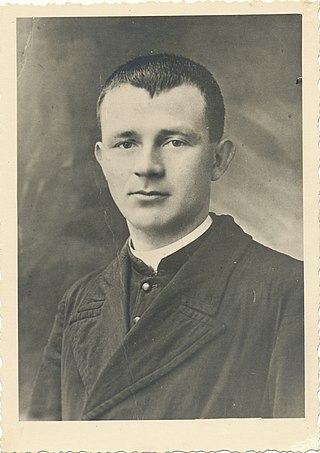 7
Elio Monari nome di battaglia "don Luigi" è stato un presbitero e partigiano italiano, Medaglia d'oro al valor militare alla memoria.
7
Elio Monari nome di battaglia "don Luigi" è stato un presbitero e partigiano italiano, Medaglia d'oro al valor militare alla memoria.
Cosmè Tura
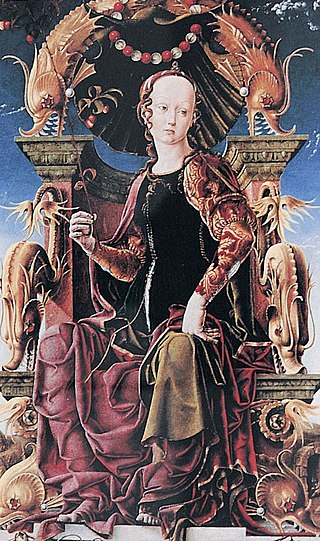 7
Cosmê Tura, also known as Il Cosmè or Cosimo Tura, was an Italian early-Renaissance painter and considered one of the founders of the School of Ferrara.
7
Cosmê Tura, also known as Il Cosmè or Cosimo Tura, was an Italian early-Renaissance painter and considered one of the founders of the School of Ferrara.
Marisa Bellisario
 7
Maria Isabella Bellisario, detta Marisa, è stata una dirigente d'azienda italiana.
È ricordata per le sue doti manageriali e per i suoi interventi decisivi nella ristrutturazione di Olivetti...
7
Maria Isabella Bellisario, detta Marisa, è stata una dirigente d'azienda italiana.
È ricordata per le sue doti manageriali e per i suoi interventi decisivi nella ristrutturazione di Olivetti...
Girolamo Michelangelo Grigoletti
 6
Girolamo Michelangelo Grigoletti was an Italian painter, active in a Neoclassical style. He was also a professor at the Accademia di Belle Arti di Venezia.
6
Girolamo Michelangelo Grigoletti was an Italian painter, active in a Neoclassical style. He was also a professor at the Accademia di Belle Arti di Venezia.
Paolo Tosti
 6
Sir Francesco Paolo Tosti KCVO was an Italian composer and music teacher.
6
Sir Francesco Paolo Tosti KCVO was an Italian composer and music teacher.
Errico Petrella
Gabriello Chiabrera
 6
Gabriello Chiabrera was an Italian poet, sometimes called the Italian Pindar. His "new metres and a Hellenic style enlarged the range of lyric forms available to later Italian poets."
6
Gabriello Chiabrera was an Italian poet, sometimes called the Italian Pindar. His "new metres and a Hellenic style enlarged the range of lyric forms available to later Italian poets."
Antonio da Correggio
 6
Antonio Allegri da Correggio, usually known as just Correggio was an Italian Renaissance painter who was the foremost painter of the Parma school of the High Italian Renaissance, who was responsible...
6
Antonio Allegri da Correggio, usually known as just Correggio was an Italian Renaissance painter who was the foremost painter of the Parma school of the High Italian Renaissance, who was responsible...
Justinian I
 6
Justinian I, also known as Justinian the Great, was the Eastern Roman emperor from 527 to 565.
6
Justinian I, also known as Justinian the Great, was the Eastern Roman emperor from 527 to 565.
Thomas Aquinas
 6
Thomas Aquinas was an Italian Dominican friar and priest, an influential philosopher and theologian, and a jurist in the tradition of scholasticism from the county of Aquino in the Kingdom of Sicily.
6
Thomas Aquinas was an Italian Dominican friar and priest, an influential philosopher and theologian, and a jurist in the tradition of scholasticism from the county of Aquino in the Kingdom of Sicily.
Pietro Paleocapa
 6
Pietro Paleòcapa was an Italian scientist, politician and engineer.
6
Pietro Paleòcapa was an Italian scientist, politician and engineer.
Ruggero Bonghi
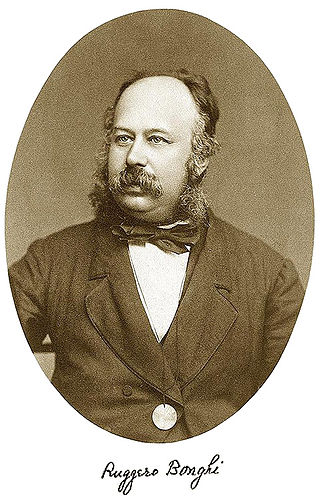 6
Ruggero Bonghi was an Italian scholar, writer and politician.
6
Ruggero Bonghi was an Italian scholar, writer and politician.
Francesco Guardi
 6
Francesco Lazzaro Guardi was an Italian painter, nobleman, and a member of the Venetian School. He is considered to be among the last practitioners, along with his brothers, of the classic Venetian...
6
Francesco Lazzaro Guardi was an Italian painter, nobleman, and a member of the Venetian School. He is considered to be among the last practitioners, along with his brothers, of the classic Venetian...
Carlo Montanari
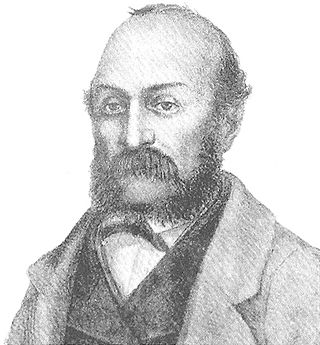 6
Il Conte Carlo Montanari è stato un patriota italiano.
Fu uno dei martiri di Belfiore.
6
Il Conte Carlo Montanari è stato un patriota italiano.
Fu uno dei martiri di Belfiore.
Raffaele Rossetti
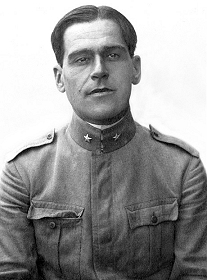 6
Raffaele Rossetti was an Italian engineer and military naval officer who sank the once main battleship of the Austro-Hungarian Empire at the end of World War I. He was also a politician of the...
6
Raffaele Rossetti was an Italian engineer and military naval officer who sank the once main battleship of the Austro-Hungarian Empire at the end of World War I. He was also a politician of the...
Paolo Ferrari
 6
Paolo Ferrari may refer to:Paolo Ferrari (actor) (1929–2018), Italian actor
Paolo Ferrari (writer) (1822–1889), Italian dramatist
6
Paolo Ferrari may refer to:Paolo Ferrari (actor) (1929–2018), Italian actor
Paolo Ferrari (writer) (1822–1889), Italian dramatist
Michele Coppino
 6
Michele Coppino was an Italian professor and politician.
6
Michele Coppino was an Italian professor and politician.
Marcantonio Colonna
 6
Marcantonio II Colonna, Duke of Tagliacozzo and Duke and Prince of Paliano, was a Roman aristocrat who served as Viceroy of Sicily in the service of the Spanish Crown, general of the Spanish forces,...
6
Marcantonio II Colonna, Duke of Tagliacozzo and Duke and Prince of Paliano, was a Roman aristocrat who served as Viceroy of Sicily in the service of the Spanish Crown, general of the Spanish forces,...
Andrea Cesalpino
 6
Andrea Cesalpino was a Florentine physician, philosopher and botanist.
6
Andrea Cesalpino was a Florentine physician, philosopher and botanist.
Paolo Bentivoglio
 6
Paolo Bentivoglio è stato un politico, antifascista e attivista italiano.
6
Paolo Bentivoglio è stato un politico, antifascista e attivista italiano.
Frederick II, Holy Roman Emperor
 6
Frederick II was King of Sicily from 1198, King of Germany from 1212, King of Italy and Holy Roman Emperor from 1220 and King of Jerusalem from 1225. He was the son of emperor Henry VI of the...
6
Frederick II was King of Sicily from 1198, King of Germany from 1212, King of Italy and Holy Roman Emperor from 1220 and King of Jerusalem from 1225. He was the son of emperor Henry VI of the...
Anton Domenico Gabbiani
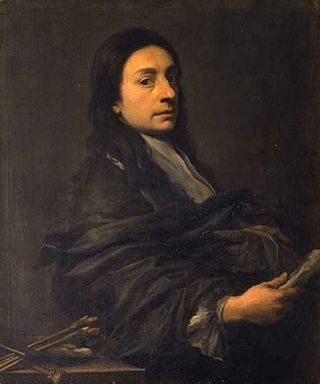 6
Anton Domenico Gabbiani was an Italian painter and active in a late Baroque style. He worked primarily in Florence for the Medici court.
6
Anton Domenico Gabbiani was an Italian painter and active in a late Baroque style. He worked primarily in Florence for the Medici court.
Galeazzo Alessi
 6
Galeazzo Alessi was an Italian architect from Perugia, known throughout Europe for his distinctive style based on his enthusiasm for ancient architecture. He studied drawing for civil and military...
6
Galeazzo Alessi was an Italian architect from Perugia, known throughout Europe for his distinctive style based on his enthusiasm for ancient architecture. He studied drawing for civil and military...
Geremia Bonomelli
 6
Geremia Bonomelli (1831–1914) was the bishop of the diocese of Cremona in the late years of the 19th century and first years of the 20th century. Bonomelli is still remembered for his work in support...
6
Geremia Bonomelli (1831–1914) was the bishop of the diocese of Cremona in the late years of the 19th century and first years of the 20th century. Bonomelli is still remembered for his work in support...
Spartaco Lavagnini
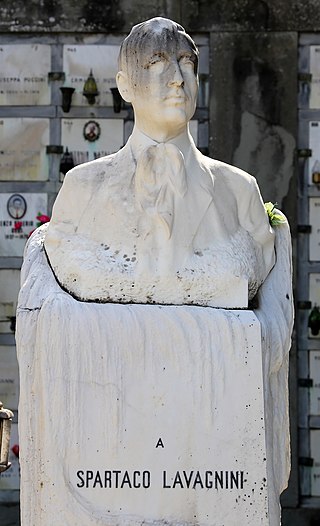 6
Spartaco Lavagnini was an Italian communist syndicalist and activist.
6
Spartaco Lavagnini was an Italian communist syndicalist and activist.
Simon the Zealot
 6
Simon the Zealot or Simon the Canaanite or Simon the Canaanean was one of the most obscure among the apostles of Jesus. A few pseudepigraphical writings were connected to him, but Jerome does not...
6
Simon the Zealot or Simon the Canaanite or Simon the Canaanean was one of the most obscure among the apostles of Jesus. A few pseudepigraphical writings were connected to him, but Jerome does not...
Alessandro Rossi
 6
Alessandro Rossi may refer to:Alessandro Rossi (1555–1615), Italian Roman Catholic bishop
Alessandro Rossi (1589–1656), Italian Roman Catholic bishop
Alessandro Rossi (1819–1898), Italian...
6
Alessandro Rossi may refer to:Alessandro Rossi (1555–1615), Italian Roman Catholic bishop
Alessandro Rossi (1589–1656), Italian Roman Catholic bishop
Alessandro Rossi (1819–1898), Italian...
Atto Vannucci
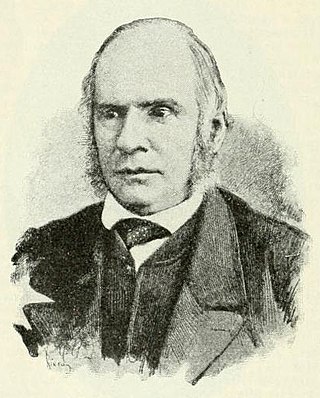 6
Atto Vannucci è stato uno storico, patriota e presbitero italiano, protagonista dei moti toscani del 1848.
6
Atto Vannucci è stato uno storico, patriota e presbitero italiano, protagonista dei moti toscani del 1848.
Ermete Zacconi
 6
Ermete Zacconi was an Italian stage and film actor and a representative of naturalism and verism in acting. His leading ladies on stage were his wife Ines Cristina and Paola Pezzaglia.
6
Ermete Zacconi was an Italian stage and film actor and a representative of naturalism and verism in acting. His leading ladies on stage were his wife Ines Cristina and Paola Pezzaglia.
Angelo Masini
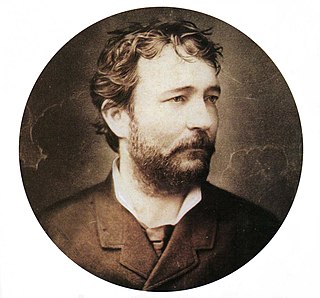 6
Angelo Masini è stato un tenore italiano.
6
Angelo Masini è stato un tenore italiano.
Luigi Guanella
 6
Luigi Guanella was an Italian Roman Catholic priest. He was ordained a priest on May 26, 1866 in Como, and was assigned to a small parish in Savogno. Luigi is the founder of several religious...
6
Luigi Guanella was an Italian Roman Catholic priest. He was ordained a priest on May 26, 1866 in Como, and was assigned to a small parish in Savogno. Luigi is the founder of several religious...
Francesco Tamagno
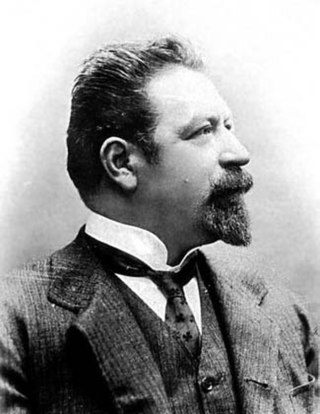 6
Francesco Tamagno was an Italian operatic dramatic tenor who sang with enormous success throughout Europe and America. On 5 February 1887, he sang Otello in the first performance of Giuseppe Verdi's...
6
Francesco Tamagno was an Italian operatic dramatic tenor who sang with enormous success throughout Europe and America. On 5 February 1887, he sang Otello in the first performance of Giuseppe Verdi's...
Tiziano Tessitori
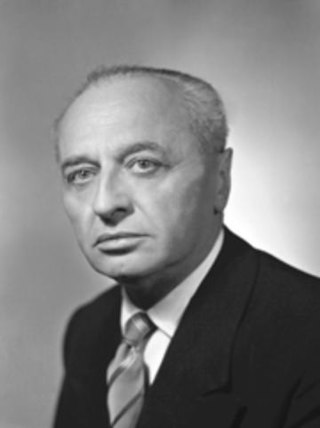 6
Tiziano Tessitori è stato un politico italiano, ministro e sottosegretario di vari governi.
6
Tiziano Tessitori è stato un politico italiano, ministro e sottosegretario di vari governi.
Giacomo Venezian
 6
Giacomo Venezian è stato un patriota e giurista italiano.
6
Giacomo Venezian è stato un patriota e giurista italiano.
Fernando de Rosa
 6
Fernando De Rosa was an Italian student who attempted to assassinate Umberto Prince of Piedmont, later Umberto II of Italy in Brussels on 24 October 1929. De Rosa was born in Milan and studied law in...
6
Fernando De Rosa was an Italian student who attempted to assassinate Umberto Prince of Piedmont, later Umberto II of Italy in Brussels on 24 October 1929. De Rosa was born in Milan and studied law in...
Nullo Baldini
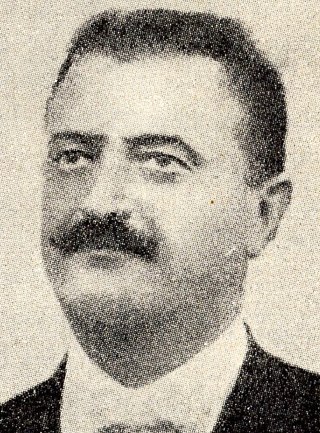 6
Nullo Baldini è stato un politico e sindacalista italiano.
6
Nullo Baldini è stato un politico e sindacalista italiano.
Coluccio Salutati
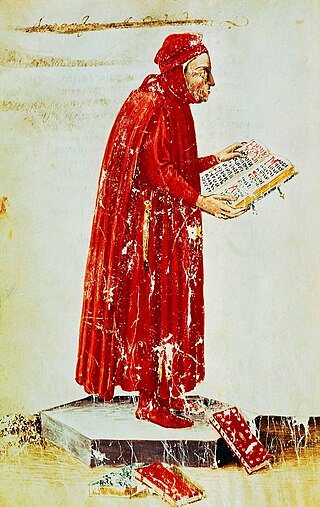 6
Coluccio Salutati was an Italian Renaissance humanist and notary, and one of the most important political and cultural leaders of Renaissance Florence; as chancellor of the Florentine Republic and...
6
Coluccio Salutati was an Italian Renaissance humanist and notary, and one of the most important political and cultural leaders of Renaissance Florence; as chancellor of the Florentine Republic and...
Raffaele Cadorna
 6
Raffaele Cadorna was an Italian general who served as one of the major Piedmontese leaders responsible for the unification of Italy during the mid-19th century.
6
Raffaele Cadorna was an Italian general who served as one of the major Piedmontese leaders responsible for the unification of Italy during the mid-19th century.
Domenico Modugno
 6
Domenico Modugno was an Italian singer, actor and, later in life, a member of the Italian Parliament. He is known for his 1958 international hit song "Nel blu dipinto di blu", for which he received...
6
Domenico Modugno was an Italian singer, actor and, later in life, a member of the Italian Parliament. He is known for his 1958 international hit song "Nel blu dipinto di blu", for which he received...
Rocco Scotellaro
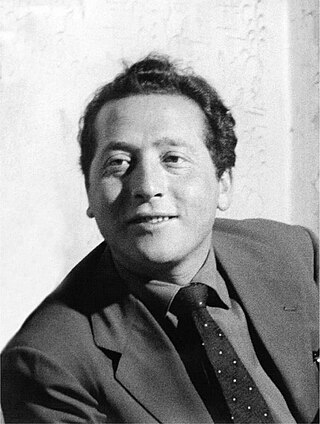 6
Rocco Scotellaro was an Italian poet, writer and politician.
6
Rocco Scotellaro was an Italian poet, writer and politician.
Stanislao Cannizzaro
 6
Stanislao Cannizzaro was an Italian chemist. He is famous for the Cannizzaro reaction and for his influential role in the atomic-weight deliberations of the Karlsruhe Congress in 1860.
6
Stanislao Cannizzaro was an Italian chemist. He is famous for the Cannizzaro reaction and for his influential role in the atomic-weight deliberations of the Karlsruhe Congress in 1860.
Luigi, Count Cibrario
 6
Luigi, Count Cibrario was an Italian statesman and historian.
6
Luigi, Count Cibrario was an Italian statesman and historian.
Giovanni Marcora
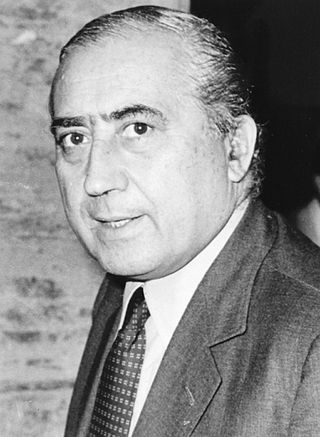 6
Giovanni Marcora was an Italian businessman, politician and minister.
6
Giovanni Marcora was an Italian businessman, politician and minister.
Maurizio Quadrio
 6
Maurizio Quadrio è stato un patriota italiano.
6
Maurizio Quadrio è stato un patriota italiano.
Pope Marcellus I
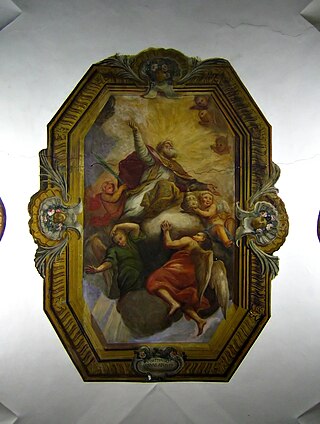 6
Pope Marcellus I was the bishop of Rome from May or June 308 to his death. He succeeded Marcellinus after a considerable interval. Under Maxentius, he was banished from Rome in 309, on account of the...
6
Pope Marcellus I was the bishop of Rome from May or June 308 to his death. He succeeded Marcellinus after a considerable interval. Under Maxentius, he was banished from Rome in 309, on account of the...
Silvio Corbari
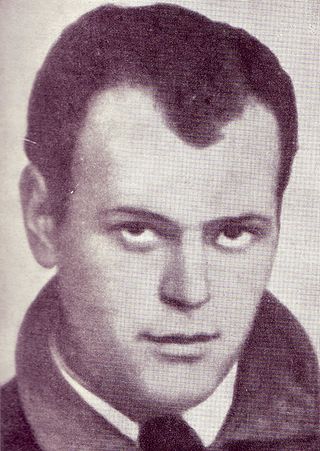 6
Sirio Corbari meglio conosciuto come Silvio Corbari è stato un partigiano italiano.
6
Sirio Corbari meglio conosciuto come Silvio Corbari è stato un partigiano italiano.
Aldo Spallicci
 6
Aldo Spallicci è stato un medico, poeta e politico italiano, nonché cultore e promotore dell'identità e delle tradizioni popolari della Romagna.
6
Aldo Spallicci è stato un medico, poeta e politico italiano, nonché cultore e promotore dell'identità e delle tradizioni popolari della Romagna.
Ernesto Rossi (politician)
 6
Ernesto Rossi was an Italian politician, journalist, and anti-fascist activist. His ideas contributed to the Action Party, and subsequently the Radical Party. He was co-author of the Ventotene...
6
Ernesto Rossi was an Italian politician, journalist, and anti-fascist activist. His ideas contributed to the Action Party, and subsequently the Radical Party. He was co-author of the Ventotene...
Pietro Gori
 6
Pietro Gori was an Italian lawyer, journalist, intellectual and anarchist poet. He is known for his political activities, and as author of some of the most famous anarchist songs of the late 19th...
6
Pietro Gori was an Italian lawyer, journalist, intellectual and anarchist poet. He is known for his political activities, and as author of some of the most famous anarchist songs of the late 19th...
Raffaele Paolucci
 6
Raffaele Paolucci, conte di Valmaggiore, è stato un militare, politico, chirurgo e docente universitario italiano autore di oltre un centinaio di pubblicazioni a carattere scientifico, prodigatosi in...
6
Raffaele Paolucci, conte di Valmaggiore, è stato un militare, politico, chirurgo e docente universitario italiano autore di oltre un centinaio di pubblicazioni a carattere scientifico, prodigatosi in...
Anna Kuliscioff
 6
Anna Kuliscioff was a Russian-born Italian revolutionary, a prominent feminist, an anarchist influenced by Mikhail Bakunin, and eventually a Marxist socialist militant. She was mainly active in...
6
Anna Kuliscioff was a Russian-born Italian revolutionary, a prominent feminist, an anarchist influenced by Mikhail Bakunin, and eventually a Marxist socialist militant. She was mainly active in...
Alvise Cadamosto
 6
Alvise Cadamosto (Portuguese pronunciation: [alˈvizɨ kɐðaˈmoʃtu]; Italian pronunciation: [alˈvize ˌkadaˈmosto])(c. 1432 – 16 July 1483) was a Venetian explorer and slave trader, who was hired by the...
6
Alvise Cadamosto (Portuguese pronunciation: [alˈvizɨ kɐðaˈmoʃtu]; Italian pronunciation: [alˈvize ˌkadaˈmosto])(c. 1432 – 16 July 1483) was a Venetian explorer and slave trader, who was hired by the...
Giambattista Bodoni
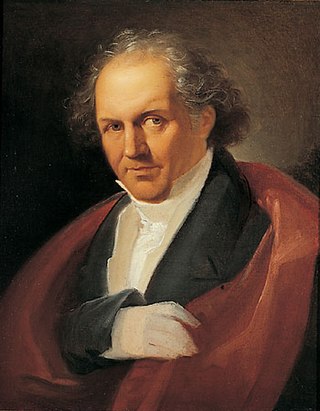 6
Giambattista Bodoni was an Italian typographer, type-designer, compositor, printer, and publisher in Parma.
6
Giambattista Bodoni was an Italian typographer, type-designer, compositor, printer, and publisher in Parma.
Filippo Juvarra
 6
Filippo Juvarra was an Italian architect, scenographer, engraver and goldsmith. He was active in a late-Baroque architecture style, working primarily in Italy, Spain, and Portugal.
6
Filippo Juvarra was an Italian architect, scenographer, engraver and goldsmith. He was active in a late-Baroque architecture style, working primarily in Italy, Spain, and Portugal.
Brunetto Latini
 6
Brunetto Latini was an Italian philosopher, scholar, notary, politician and statesman.
6
Brunetto Latini was an Italian philosopher, scholar, notary, politician and statesman.
Giovanni Boldini
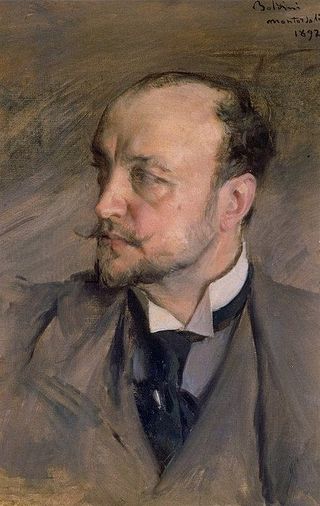 6
Giovanni Boldini was an Italian genre and portrait painter who lived and worked in Paris for most of his career. According to a 1933 article in Time magazine, he was known as the "Master of Swish"...
6
Giovanni Boldini was an Italian genre and portrait painter who lived and worked in Paris for most of his career. According to a 1933 article in Time magazine, he was known as the "Master of Swish"...
Silvio Spaventa
 6
Silvio Spaventa was an Italian journalist, politician and statesman who played a leading role in the unification of Italy, and subsequently held important positions within the newly formed Italian...
6
Silvio Spaventa was an Italian journalist, politician and statesman who played a leading role in the unification of Italy, and subsequently held important positions within the newly formed Italian...
Berto Barbarani
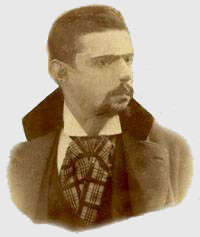 6
Roberto Tiberio "Berto" Barbarani was an Italian poet. He wrote many poems in the Veronese dialect of Northern Italy.
6
Roberto Tiberio "Berto" Barbarani was an Italian poet. He wrote many poems in the Veronese dialect of Northern Italy.
Arcangelo Ghisleri
 6
Arcangelo Ghisleri was an Italian geographer, writer, and Socialist politician.
6
Arcangelo Ghisleri was an Italian geographer, writer, and Socialist politician.
Vincenzo Foppa
 6
Vincenzo Foppa was an Italian painter from the Renaissance period. While few of his works survive, he was an esteemed and influential painter during his time and is considered the preeminent leader...
6
Vincenzo Foppa was an Italian painter from the Renaissance period. While few of his works survive, he was an esteemed and influential painter during his time and is considered the preeminent leader...
Ermagora e Fortunato
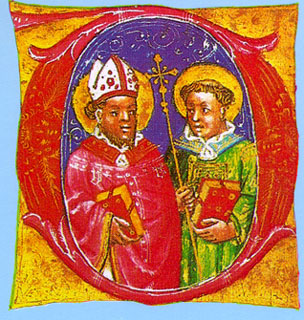 6
Ermagora, o Ermacora, e Fortunato furono i due protomartiri di Aquileia. Entrambi sono considerati santi da tutte le Chiese cristiane che ammettono il culto dei santi, particolarmente nelle zone...
6
Ermagora, o Ermacora, e Fortunato furono i due protomartiri di Aquileia. Entrambi sono considerati santi da tutte le Chiese cristiane che ammettono il culto dei santi, particolarmente nelle zone...
Ferdinando Palasciano
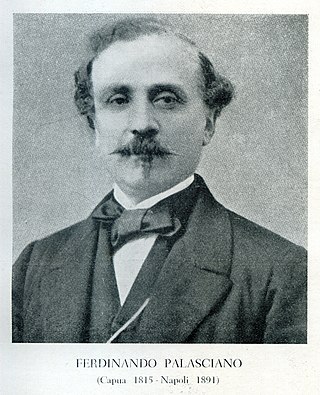 6
Ferdinando Palasciano was an Italian physician and politician, considered one of the forerunners of the foundation of the Red Cross.
6
Ferdinando Palasciano was an Italian physician and politician, considered one of the forerunners of the foundation of the Red Cross.
Joan of Arc
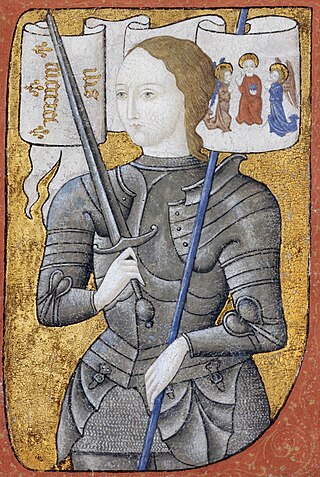 6
Joan of Arc is a patron saint of France, honored as a defender of the French nation for her role in the siege of Orléans and her insistence on the coronation of Charles VII of France during the...
6
Joan of Arc is a patron saint of France, honored as a defender of the French nation for her role in the siege of Orléans and her insistence on the coronation of Charles VII of France during the...
Luigi Garzoni di Adorgnano
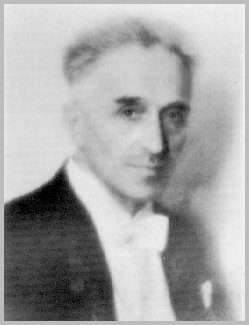 6
Luigi Garzoni di Adorgnano è stato un compositore e filologo italiano.
6
Luigi Garzoni di Adorgnano è stato un compositore e filologo italiano.
Bertrand of Saint-Geniès
 6
Bertrand of Saint-Geniès was the patriarch of Aquileia from 1334 until his death.
6
Bertrand of Saint-Geniès was the patriarch of Aquileia from 1334 until his death.
David Maria Turoldo
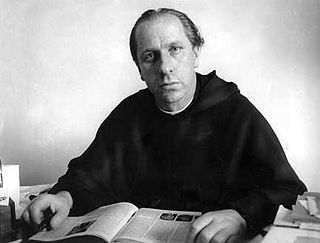 6
David Maria Turoldo, al secolo Giuseppe Turoldo, è stato un presbitero, teologo, filosofo, scrittore, poeta e antifascista italiano, membro dell'ordine dei Servi di Maria.
È stato, oltre che poeta,...
6
David Maria Turoldo, al secolo Giuseppe Turoldo, è stato un presbitero, teologo, filosofo, scrittore, poeta e antifascista italiano, membro dell'ordine dei Servi di Maria.
È stato, oltre che poeta,...
Luigi Magrini
 6
Luigi Magrini è stato un fisico italiano.
6
Luigi Magrini è stato un fisico italiano.
Lino Zanussi
 6
Lino Zanussi was an Italian businessman and appliance manufacturer.
6
Lino Zanussi was an Italian businessman and appliance manufacturer.
Bartolomeo d'Alviano
 6
Bartolomeo d'Alviano was an Italian condottiero and captain who distinguished himself in the defence of the Venetian Republic against the Holy Roman Emperor Maximilian.
6
Bartolomeo d'Alviano was an Italian condottiero and captain who distinguished himself in the defence of the Venetian Republic against the Holy Roman Emperor Maximilian.
Giuseppe Brotzu
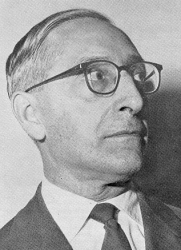 6
Giuseppe Brotzu was an Italian pharmacologist and politician.
6
Giuseppe Brotzu was an Italian pharmacologist and politician.
Antonio Pigliaru
 6
Antonio Pigliaru was a Sardinian jurist and philosopher. He was the most important Sardinian intellectual of the second half of the twentieth century, and one of the most vivid contemporary Italian...
6
Antonio Pigliaru was a Sardinian jurist and philosopher. He was the most important Sardinian intellectual of the second half of the twentieth century, and one of the most vivid contemporary Italian...
Albert Sabin
 6
Albert Bruce Sabin was a Polish-American medical researcher, best known for developing the oral polio vaccine, which has played a key role in nearly eradicating the disease. In 1969–72, he served as...
6
Albert Bruce Sabin was a Polish-American medical researcher, best known for developing the oral polio vaccine, which has played a key role in nearly eradicating the disease. In 1969–72, he served as...
Gabriella Degli Esposti
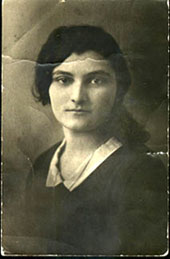 6
Gabriella Degli Esposti è stata un'antifascista e partigiana italiana, nome di battaglia Balella, Medaglia d'oro al valor militare alla memoria.
6
Gabriella Degli Esposti è stata un'antifascista e partigiana italiana, nome di battaglia Balella, Medaglia d'oro al valor militare alla memoria.
Maria Margotti
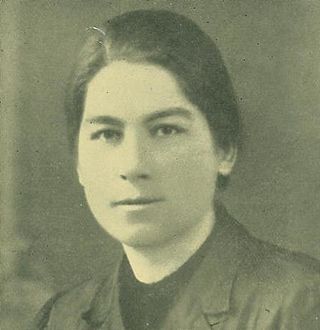 5
Maria Margotti è stata un'attivista e mondina italiana.
5
Maria Margotti è stata un'attivista e mondina italiana.
Prince Eugene of Savoy
 5
Prince Eugene Francis of Savoy-Carignano, better known as Prince Eugene, was a field marshal in the Army of the Holy Roman Empire and of the Austrian Habsburg dynasty during the 17th and 18th...
5
Prince Eugene Francis of Savoy-Carignano, better known as Prince Eugene, was a field marshal in the Army of the Holy Roman Empire and of the Austrian Habsburg dynasty during the 17th and 18th...
Emilio De Marchi (writer)
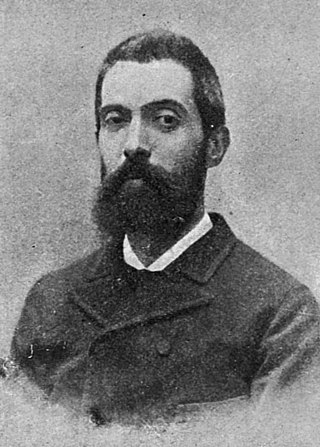 5
Emilio De Marchi (1851–1901) was an Italian novelist, known for his portrayals of Milan and Lombardy in the nineteenth century. Several of his works have been adapted for film and television...
5
Emilio De Marchi (1851–1901) was an Italian novelist, known for his portrayals of Milan and Lombardy in the nineteenth century. Several of his works have been adapted for film and television...
Marino Moretti
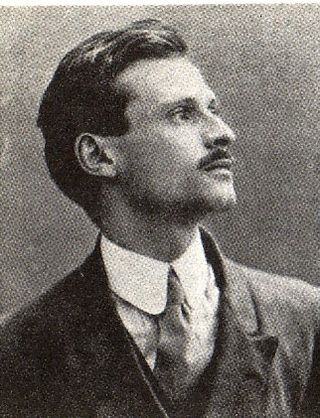 5
Marino Moretti was an Italian poet and author.
5
Marino Moretti was an Italian poet and author.
Maurizio Bufalini
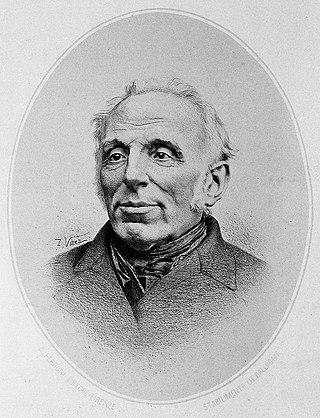 5
Maurizio Bufalini was an Italian physician. He served in the Senate of the Kingdom of Sardinia. He was a recipient of the Order of Saints Maurice and Lazarus.
5
Maurizio Bufalini was an Italian physician. He served in the Senate of the Kingdom of Sardinia. He was a recipient of the Order of Saints Maurice and Lazarus.
Ulisse Aldrovandi
 5
Ulisse Aldrovandi was an Italian naturalist, the moving force behind Bologna's botanical garden, one of the first in Europe. Carl Linnaeus and the comte de Buffon reckoned him the father of natural...
5
Ulisse Aldrovandi was an Italian naturalist, the moving force behind Bologna's botanical garden, one of the first in Europe. Carl Linnaeus and the comte de Buffon reckoned him the father of natural...
Giuseppe Caprin
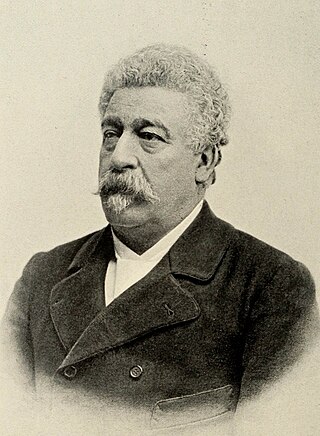 5
Giuseppe Caprin è stato uno scrittore italiano, giornalista e patriota, combatté con Giuseppe Garibaldi e fu ferito a Bezzecca (1866).
5
Giuseppe Caprin è stato uno scrittore italiano, giornalista e patriota, combatté con Giuseppe Garibaldi e fu ferito a Bezzecca (1866).
Torquato Taramelli
 5
Torquato Taramelli was an Italian geologist.
5
Torquato Taramelli was an Italian geologist.
Bernardino Galliari
 5
Bernardino Galliari (1707–1794) was an Italian painter, active mainly as a scenic designer and decorator of theaters.
5
Bernardino Galliari (1707–1794) was an Italian painter, active mainly as a scenic designer and decorator of theaters.
Guido Donegani
 5
Guido Donegani, was a prominent Italian engineer, businessman and politician. He was CEO and President of the Italian chemical industrial giant Montecatini from 1910-1945. Due to his support to the...
5
Guido Donegani, was a prominent Italian engineer, businessman and politician. He was CEO and President of the Italian chemical industrial giant Montecatini from 1910-1945. Due to his support to the...
Jules Verne
 5
Jules Gabriel Verne was a French novelist, poet, and playwright. His collaboration with the publisher Pierre-Jules Hetzel led to the creation of the Voyages extraordinaires, a series of bestselling...
5
Jules Gabriel Verne was a French novelist, poet, and playwright. His collaboration with the publisher Pierre-Jules Hetzel led to the creation of the Voyages extraordinaires, a series of bestselling...
Andrea Bafile
 5
Andrea Bafile è stato un militare italiano.
5
Andrea Bafile è stato un militare italiano.
Gino Capponi
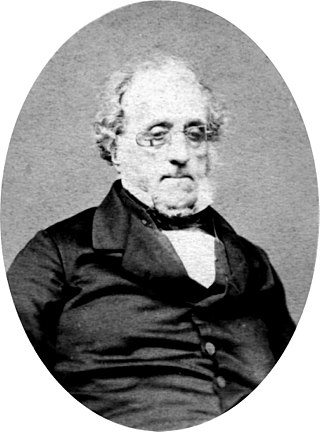 5
Marquis Gino Capponi was an Italian statesman and historian of a Liberal Catholic bent.
5
Marquis Gino Capponi was an Italian statesman and historian of a Liberal Catholic bent.
Antonio Salandra
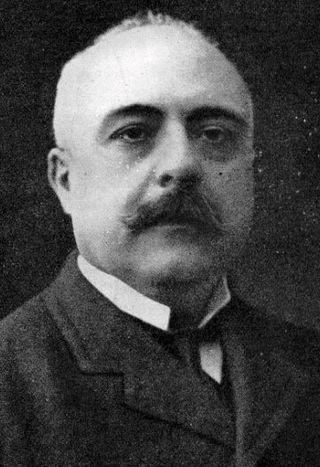 5
Antonio Salandra was a conservative Italian politician, journalist, and writer, who served as the 21st prime minister of Italy between 1914 and 1916. He ensured the entry of Italy in World War I on...
5
Antonio Salandra was a conservative Italian politician, journalist, and writer, who served as the 21st prime minister of Italy between 1914 and 1916. He ensured the entry of Italy in World War I on...
Giovanni Battista Grassi
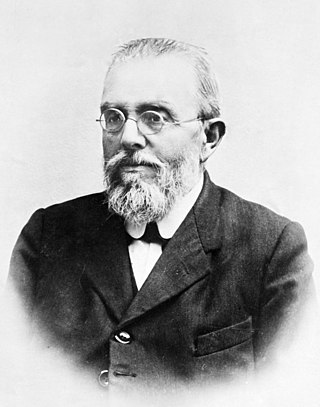 5
Giovanni Battista Grassi was an Italian physician and zoologist, best known for his pioneering works on parasitology, especially on malariology. He was Professor of Comparative Zoology at the...
5
Giovanni Battista Grassi was an Italian physician and zoologist, best known for his pioneering works on parasitology, especially on malariology. He was Professor of Comparative Zoology at the...
Benedetto Varchi
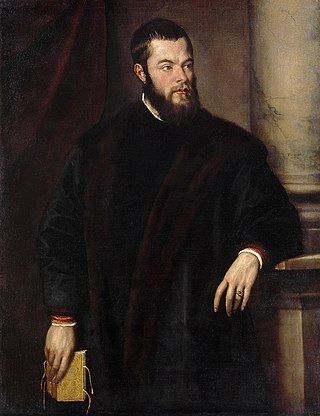 5
Benedetto Varchi was an Italian humanist, historian, and poet.
5
Benedetto Varchi was an Italian humanist, historian, and poet.
Lauro Rossi
 5
Lauro Rossi, was an Italian composer, particularly of operas. There is no known connection with Luigi Rossi (1597–1653).
5
Lauro Rossi, was an Italian composer, particularly of operas. There is no known connection with Luigi Rossi (1597–1653).
Pasquale Stanislao Mancini
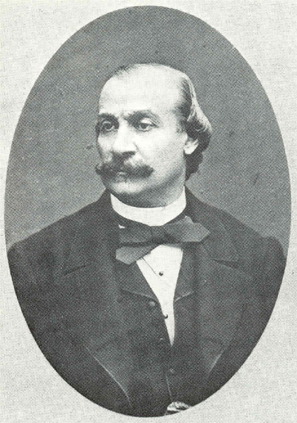 5
Pasquale Stanislao Mancini, 8th Marquess of Fusignano was an Italian jurist and statesman.
5
Pasquale Stanislao Mancini, 8th Marquess of Fusignano was an Italian jurist and statesman.
Achille Papa
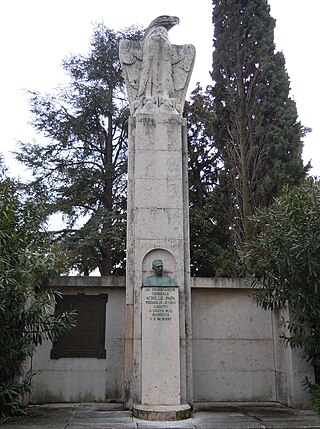 5
Achille Papa è stato un generale italiano.
5
Achille Papa è stato un generale italiano.
Lorenzo Mascheroni
 5
Lorenzo Mascheroni was an Italian mathematician.
5
Lorenzo Mascheroni was an Italian mathematician.
Mario Pannunzio
 5
Mario Pannunzio was an Italian journalist and politician. As a journalist he was the director in charge of the daily newspaper Risorgimento Liberale in the 1940s and of the weekly political magazine...
5
Mario Pannunzio was an Italian journalist and politician. As a journalist he was the director in charge of the daily newspaper Risorgimento Liberale in the 1940s and of the weekly political magazine...
Pope Pius XI
 5
Pope Pius XI, born Ambrogio Damiano Achille Ratti, was the Bishop of Rome and supreme pontiff of the Catholic Church from 6 February 1922 to 10 February 1939. He also became the first sovereign of...
5
Pope Pius XI, born Ambrogio Damiano Achille Ratti, was the Bishop of Rome and supreme pontiff of the Catholic Church from 6 February 1922 to 10 February 1939. He also became the first sovereign of...
Alessandro Coppi
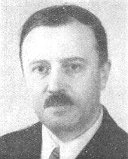 5
Alessandro Coppi è stato un avvocato e politico italiano.
5
Alessandro Coppi è stato un avvocato e politico italiano.
Anton Giulio Barrili
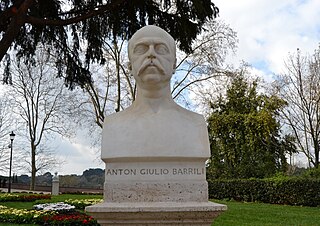 5
Anton Giulio Barrili was an Italian novelist. He was educated for the legal profession, which he abandoned in Genoa for journalism. He was a volunteer in the campaign of 1859 and served with...
5
Anton Giulio Barrili was an Italian novelist. He was educated for the legal profession, which he abandoned in Genoa for journalism. He was a volunteer in the campaign of 1859 and served with...
Ferdinando Martini
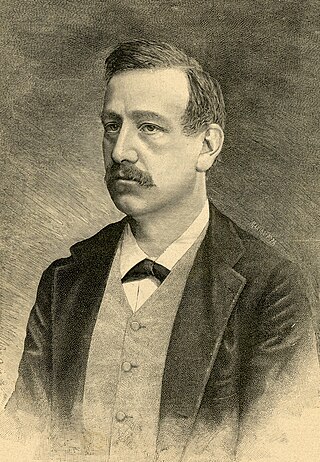 5
Ferdinando Martini was an Italian writer and politician. He was governor of Eritrea for from late 1897 to early 1907.
5
Ferdinando Martini was an Italian writer and politician. He was governor of Eritrea for from late 1897 to early 1907.
Antonio Andreuzzi
 5
Antonio Andreuzzi è stato un patriota italiano.
5
Antonio Andreuzzi è stato un patriota italiano.
Antonio Bertoloni
 5
Antonio Bertoloni was an Italian physician and botanist who made extensive studies of Italian plants. He also collected notable samples of Central American flora.
5
Antonio Bertoloni was an Italian physician and botanist who made extensive studies of Italian plants. He also collected notable samples of Central American flora.
Alessandro Cruto
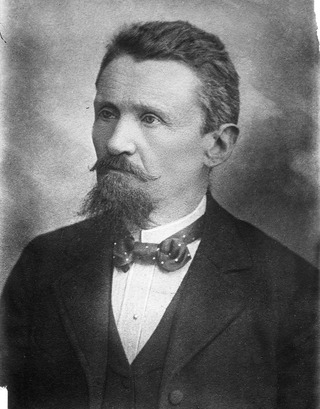 5
Alessandro Cruto was an Italian inventor, born in the town of Piossasco, near Turin, who created an early incandescent light bulb.
5
Alessandro Cruto was an Italian inventor, born in the town of Piossasco, near Turin, who created an early incandescent light bulb.
Angelo Emo
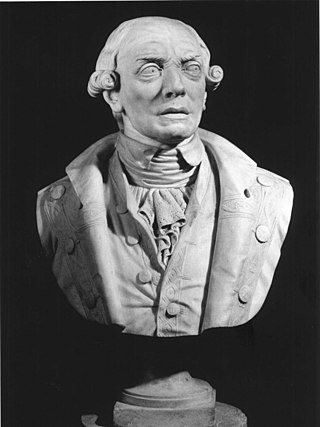 5
Angelo Emo was a Venetian noble, administrator, and admiral. He is notable for his reforms of the Venetian navy and his naval campaigns, being regarded as the last great admiral of the Venetian...
5
Angelo Emo was a Venetian noble, administrator, and admiral. He is notable for his reforms of the Venetian navy and his naval campaigns, being regarded as the last great admiral of the Venetian...
Philip the Apostle
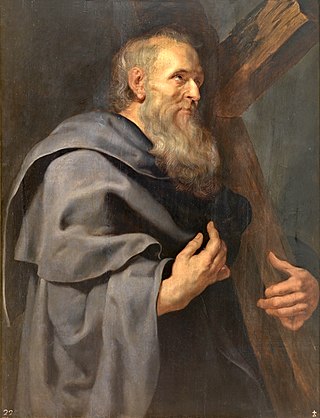 5
Philip the Apostle was one of the Twelve Apostles of Jesus according to the New Testament. Later Christian traditions describe Philip as the apostle who preached in Greece, Syria, and Asia-Minor.
5
Philip the Apostle was one of the Twelve Apostles of Jesus according to the New Testament. Later Christian traditions describe Philip as the apostle who preached in Greece, Syria, and Asia-Minor.
Prince Tommaso, Duke of Genoa
 5
Prince Tommaso of Savoy, 2nd Duke of Genoa, who is also known as Thomas Albert Victor of Savoy, was an Italian royal prince, nephew of Victor Emmanuel at the time the King of Sardinia, who on 18...
5
Prince Tommaso of Savoy, 2nd Duke of Genoa, who is also known as Thomas Albert Victor of Savoy, was an Italian royal prince, nephew of Victor Emmanuel at the time the King of Sardinia, who on 18...
Marcus Atilius Regulus (consul 267 BC)
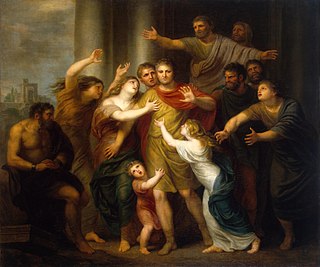 5
Marcus Atilius Regulus was a Roman statesman and general who was a consul of the Roman Republic in 267 BC and 256 BC. Much of his career was spent fighting the Carthaginians during the first Punic...
5
Marcus Atilius Regulus was a Roman statesman and general who was a consul of the Roman Republic in 267 BC and 256 BC. Much of his career was spent fighting the Carthaginians during the first Punic...
Francesco Albani
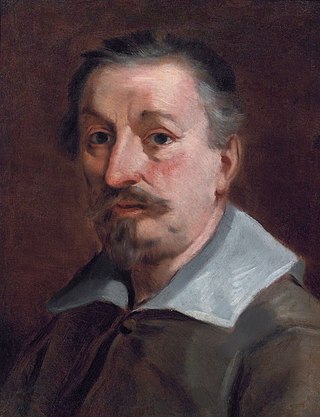 5
Francesco Albani or Albano was an Italian Baroque painter of Albanian origin who was active in Bologna (1591–1600), Rome (1600–1609), Bologna (1609), Viterbo (1609–1610), Bologna (1610), Rome...
5
Francesco Albani or Albano was an Italian Baroque painter of Albanian origin who was active in Bologna (1591–1600), Rome (1600–1609), Bologna (1609), Viterbo (1609–1610), Bologna (1610), Rome...
Franklin D. Roosevelt
 5
Franklin Delano Roosevelt, commonly known by his initials FDR, was an American statesman and politician who served as the 32nd president of the United States from 1933 until his death in 1945. He was...
5
Franklin Delano Roosevelt, commonly known by his initials FDR, was an American statesman and politician who served as the 32nd president of the United States from 1933 until his death in 1945. He was...
Felice Casorati
 5
Felice Casorati was an Italian painter, sculptor, and printmaker. The paintings for which he is most noted include figure compositions, portraits and still lifes, which are often distinguished by...
5
Felice Casorati was an Italian painter, sculptor, and printmaker. The paintings for which he is most noted include figure compositions, portraits and still lifes, which are often distinguished by...
Pellegrino Rossi
 5
Pellegrino Luigi Odoardo Rossi was an Italian economist, politician and jurist. He was an important figure of the July Monarchy in France, and the minister of justice in the government of the Papal...
5
Pellegrino Luigi Odoardo Rossi was an Italian economist, politician and jurist. He was an important figure of the July Monarchy in France, and the minister of justice in the government of the Papal...
John of Nepomuk
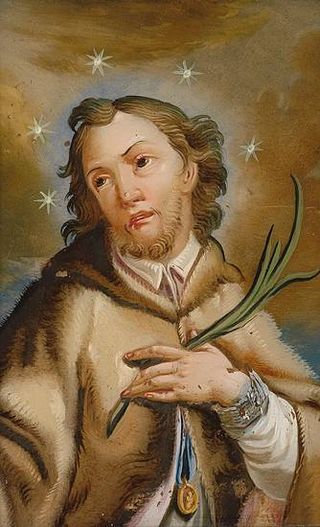 5
John of Nepomuk
was a saint of Bohemia who was drowned in the Vltava river at the behest of King Wenceslaus IV of Bohemia. Later accounts state that he was the confessor of the queen of Bohemia and...
5
John of Nepomuk
was a saint of Bohemia who was drowned in the Vltava river at the behest of King Wenceslaus IV of Bohemia. Later accounts state that he was the confessor of the queen of Bohemia and...
Giuseppe Montanelli
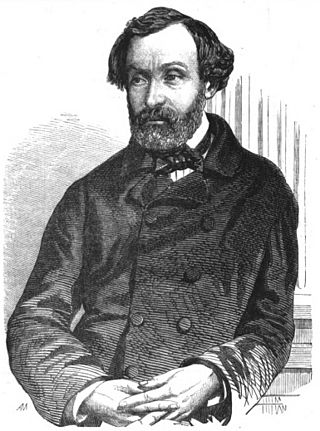 5
Giuseppe Montanelli was an Italian statesman and author.
5
Giuseppe Montanelli was an Italian statesman and author.
Vincenzo Viviani
 5
Vincenzo Viviani was an Italian mathematician and scientist. He was a pupil of Torricelli and a disciple of Galileo.
5
Vincenzo Viviani was an Italian mathematician and scientist. He was a pupil of Torricelli and a disciple of Galileo.
Giovanni Pacini
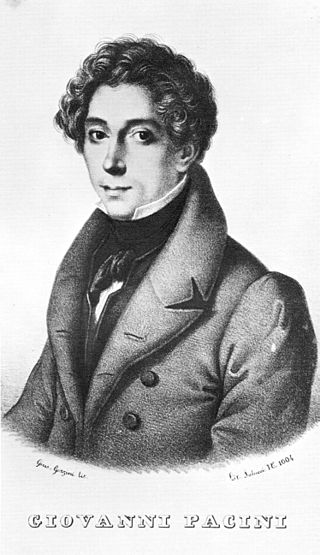 5
Giovanni Pacini was an Italian composer, best known for his operas. Pacini was born in Catania, Sicily, the son of the buffo Luigi Pacini, who was to appear in the premieres of many of Giovanni's...
5
Giovanni Pacini was an Italian composer, best known for his operas. Pacini was born in Catania, Sicily, the son of the buffo Luigi Pacini, who was to appear in the premieres of many of Giovanni's...
Luca Pacioli
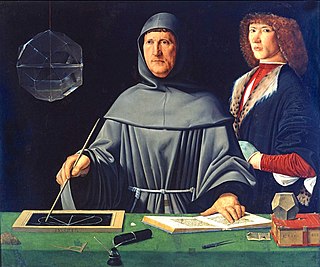 5
Fra. Luca Bartolomeo de Pacioli was an Italian mathematician, Franciscan friar, collaborator with Leonardo da Vinci, and an early contributor to the field now known as accounting. He is referred to...
5
Fra. Luca Bartolomeo de Pacioli was an Italian mathematician, Franciscan friar, collaborator with Leonardo da Vinci, and an early contributor to the field now known as accounting. He is referred to...
Luigi Alamanni
 5
Luigi Alamanni was an Italian poet and statesman. He was regarded as a prolific and versatile poet. He was credited with introducing the epigram into Italian poetry.
5
Luigi Alamanni was an Italian poet and statesman. He was regarded as a prolific and versatile poet. He was credited with introducing the epigram into Italian poetry.
Frédéric Ozanam
 5
Antoine-Frédéric Ozanam was a French Catholic literary scholar, lawyer, journalist and equal rights advocate. He founded with fellow students the Conference of Charity, later known as the Society of...
5
Antoine-Frédéric Ozanam was a French Catholic literary scholar, lawyer, journalist and equal rights advocate. He founded with fellow students the Conference of Charity, later known as the Society of...
Stendhal
 5
Marie-Henri Beyle, better known by his pen name Stendhal, was a 19th-century French writer. Best known for the novels Le Rouge et le Noir and La Chartreuse de Parme, he is highly regarded for the...
5
Marie-Henri Beyle, better known by his pen name Stendhal, was a 19th-century French writer. Best known for the novels Le Rouge et le Noir and La Chartreuse de Parme, he is highly regarded for the...
Paolo Frisi
 5
Paolo Frisi was an Italian mathematician and astronomer.
5
Paolo Frisi was an Italian mathematician and astronomer.
Ermete Novelli
 5
Ermete Novelli was an Italian actor and playwright.
5
Ermete Novelli was an Italian actor and playwright.
Dino Campana
 5
Dino Campana was an Italian visionary poet. His fame rests on his only published book of poetry, the Canti Orfici, as well as his wild and erratic personality, including his ill-fated love affair...
5
Dino Campana was an Italian visionary poet. His fame rests on his only published book of poetry, the Canti Orfici, as well as his wild and erratic personality, including his ill-fated love affair...
Francesco Todaro
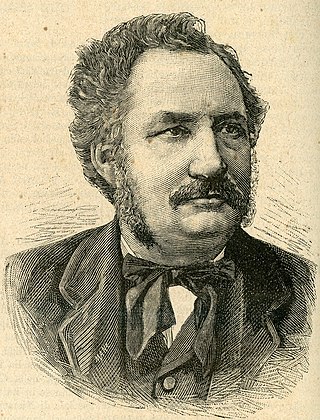 5
Francesco Todaro was an Italian anatomist born in Tripi, a village in the province of Messina.
5
Francesco Todaro was an Italian anatomist born in Tripi, a village in the province of Messina.
Quirico Filopanti
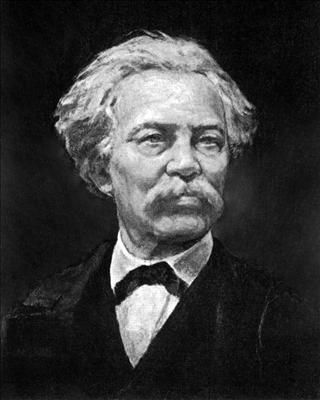 5
Giuseppe Barilli, also known by his pseudonym Quirico Filopanti, was an Italian mathematician and politician.
5
Giuseppe Barilli, also known by his pseudonym Quirico Filopanti, was an Italian mathematician and politician.
Antonio Fontanesi
 5
Antonio Fontanesi was an Italian painter who lived in Meiji period Japan between 1876 and 1878. He introduced European oil painting techniques to Japan, and exerted a significant role in the...
5
Antonio Fontanesi was an Italian painter who lived in Meiji period Japan between 1876 and 1878. He introduced European oil painting techniques to Japan, and exerted a significant role in the...
Benozzo Gozzoli
 5
Benozzo Gozzoli was an Italian Renaissance painter from Florence. A pupil of Fra Angelico, Gozzoli is best known for a series of murals in the Magi Chapel of the Palazzo Medici-Riccardi, depicting...
5
Benozzo Gozzoli was an Italian Renaissance painter from Florence. A pupil of Fra Angelico, Gozzoli is best known for a series of murals in the Magi Chapel of the Palazzo Medici-Riccardi, depicting...
Pasquale Villari
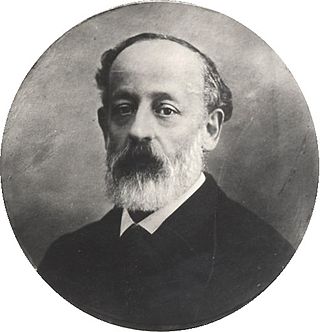 5
Pasquale Villari was an Italian historian and politician.
5
Pasquale Villari was an Italian historian and politician.
Giuseppe Bandi
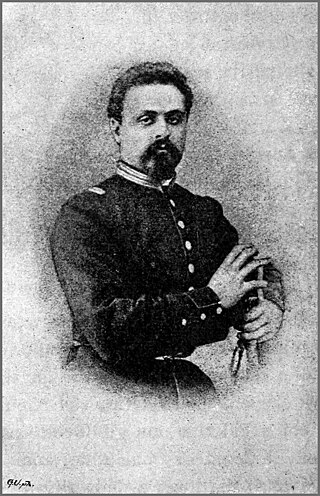 5
Giuseppe Bandi è stato un patriota, scrittore e giornalista italiano.
5
Giuseppe Bandi è stato un patriota, scrittore e giornalista italiano.
Carolus Sigonius
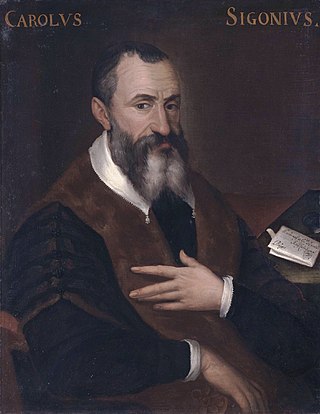 5
Carolus Sigonius was an Italian humanist, born in Modena.
5
Carolus Sigonius was an Italian humanist, born in Modena.
Luca Ghini
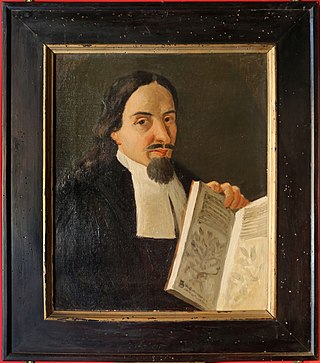 5
Luca Ghini was an Italian physician and botanist, notable as the creator of the first recorded herbarium, as well as the first botanical garden in Europe.
5
Luca Ghini was an Italian physician and botanist, notable as the creator of the first recorded herbarium, as well as the first botanical garden in Europe.
Alfredo Testoni
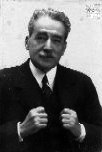 5
Alfredo Testoni (1856–1931) was an Italian playwright and poet known for his work in the Bolognese dialect. In 1888 he established his own company at the Teatro Contavalli in Bologna. Amongst his...
5
Alfredo Testoni (1856–1931) was an Italian playwright and poet known for his work in the Bolognese dialect. In 1888 he established his own company at the Teatro Contavalli in Bologna. Amongst his...
Pope Marcellinus
 5
Pope Marcellinus was the bishop of Rome from 30 June 296 to his death in 304. A historical accusation was levelled at him by some sources to the effect that he might have renounced Christianity...
5
Pope Marcellinus was the bishop of Rome from 30 June 296 to his death in 304. A historical accusation was levelled at him by some sources to the effect that he might have renounced Christianity...
Francesco Paolo Michetti
 5
Francesco Paolo Michetti was an Italian painter known especially for his genre works.
5
Francesco Paolo Michetti was an Italian painter known especially for his genre works.
Theodore Tiron
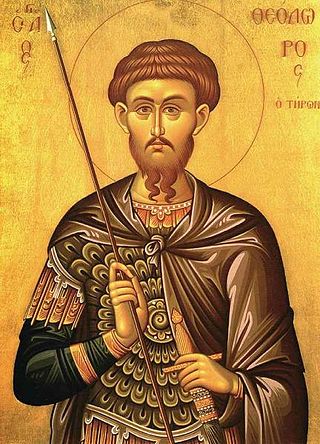 5
Saint Theodore, distinguished as Theodore of Amasea, Theodore the Recruit, and by other names, is a Christian saint and Great Martyr, particularly revered in the Eastern Orthodox Churches but also...
5
Saint Theodore, distinguished as Theodore of Amasea, Theodore the Recruit, and by other names, is a Christian saint and Great Martyr, particularly revered in the Eastern Orthodox Churches but also...
Arturo Graf
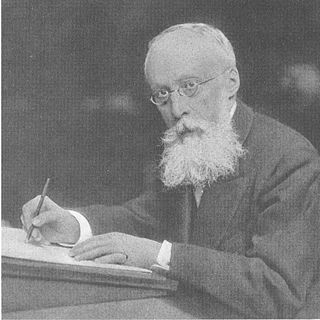 5
Arturo Graf, was an Italian poet and literary critic.
5
Arturo Graf, was an Italian poet and literary critic.
Emilio Estevez
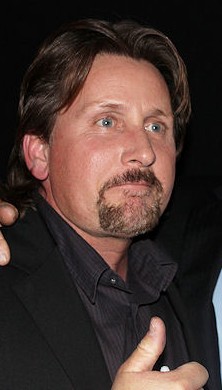 5
Emilio Estevez is an American actor and filmmaker.
5
Emilio Estevez is an American actor and filmmaker.
Edoardo Bassini
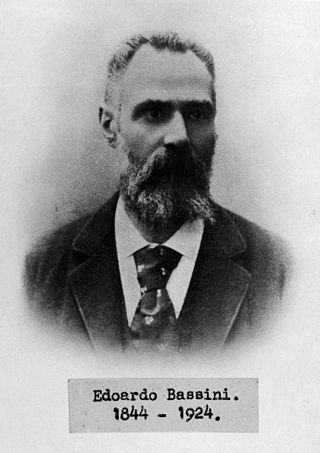 5
Edoardo Bassini was an Italian surgeon born in Pavia.
5
Edoardo Bassini was an Italian surgeon born in Pavia.
Giovanni Antonio Pilacorte
 5
Giovanni Antonio Pilacorte è stato uno scultore italiano di origine ticinese.
5
Giovanni Antonio Pilacorte è stato uno scultore italiano di origine ticinese.
Mario Angeloni
 5
Mario Angeloni è stato un politico, antifascista e avvocato italiano che combatté nella guerra civile spagnola, perdendovi la vita.
5
Mario Angeloni è stato un politico, antifascista e avvocato italiano che combatté nella guerra civile spagnola, perdendovi la vita.
Adeodato Malatesta
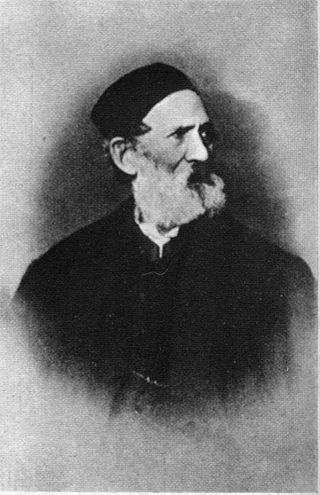 5
Adeodato Malatesta was an Italian painter, trained in a grand Neoclassical style, depicting mostly of sacred and historic subjects.
5
Adeodato Malatesta was an Italian painter, trained in a grand Neoclassical style, depicting mostly of sacred and historic subjects.
Maximus of Turin
 5
Maximus of Turin was a Roman Christian prelate known as the first Bishop of Turin. He was a theological writer who "made a great contribution to the spread and consolidation of Christianity in...
5
Maximus of Turin was a Roman Christian prelate known as the first Bishop of Turin. He was a theological writer who "made a great contribution to the spread and consolidation of Christianity in...
Antonio Bajamonti
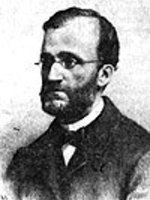 5
Antonio Bajamonti was an Austrian and Dalmatian Italian politician and longtime mayor of Split. He is remembered as one of the most successful mayors of the city, occupying the post almost...
5
Antonio Bajamonti was an Austrian and Dalmatian Italian politician and longtime mayor of Split. He is remembered as one of the most successful mayors of the city, occupying the post almost...
John Hawkwood
 5
Sir John Hawkwood was an English soldier who served as a mercenary leader or condottiero in Italy. As his name was difficult to pronounce for non-English-speaking contemporaries, there are many...
5
Sir John Hawkwood was an English soldier who served as a mercenary leader or condottiero in Italy. As his name was difficult to pronounce for non-English-speaking contemporaries, there are many...
Dante Gabriel Rossetti
 5
Gabriel Charles Dante Rossetti, generally known as Dante Gabriel Rossetti, was an English poet, illustrator, painter, translator, and member of the Rossetti family. He founded the Pre-Raphaelite...
5
Gabriel Charles Dante Rossetti, generally known as Dante Gabriel Rossetti, was an English poet, illustrator, painter, translator, and member of the Rossetti family. He founded the Pre-Raphaelite...
Juliana of Nicomedia
 5
Juliana of Nicomedia is an Anatolian Christian saint, said to have suffered martyrdom during the Diocletianic persecution in 304. She was popular as a patron saint of the sick during the Middle Ages,...
5
Juliana of Nicomedia is an Anatolian Christian saint, said to have suffered martyrdom during the Diocletianic persecution in 304. She was popular as a patron saint of the sick during the Middle Ages,...
Gian Rinaldo Carli
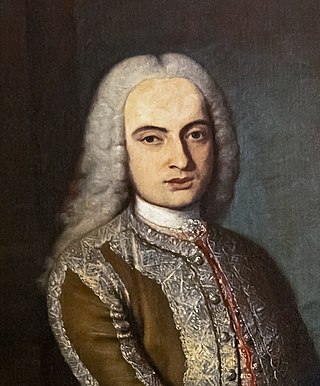 5
Gian Rinaldo Carli (1720–1795), also known by other names, was an Italian economist, historian, and antiquarian.
5
Gian Rinaldo Carli (1720–1795), also known by other names, was an Italian economist, historian, and antiquarian.
Bernardino Lanini
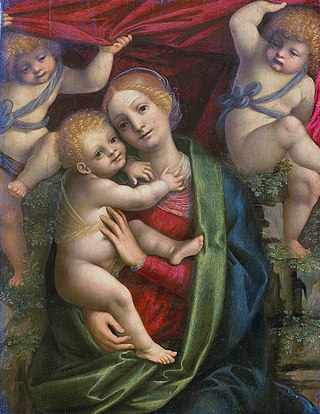 5
Bernardino Lanini or Lanino was an Italian painter of the Renaissance period, active mainly in Milan.
5
Bernardino Lanini or Lanino was an Italian painter of the Renaissance period, active mainly in Milan.
Vitaliano Brancati
 5
Vitaliano Brancati was an Italian novelist, dramatist, poet and screenwriter.
5
Vitaliano Brancati was an Italian novelist, dramatist, poet and screenwriter.
Eugenio Chiesa
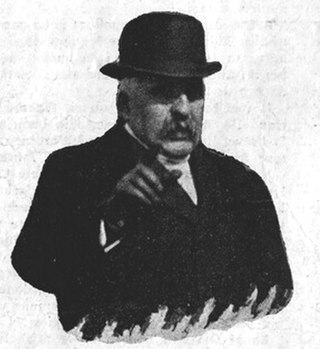 5
Eugenio Chiesa was an Italian accountant who found a job with a toy factory. He worked his way up through the ranks and, when the opportunity arose, acquired the business and became very rich. By...
5
Eugenio Chiesa was an Italian accountant who found a job with a toy factory. He worked his way up through the ranks and, when the opportunity arose, acquired the business and became very rich. By...
Giuseppe Piermarini
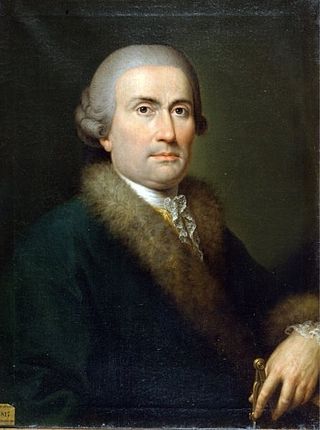 5
Giuseppe Piermarini was an Italian architect who trained with Luigi Vanvitelli in Naples and designed the Teatro alla Scala in Milan (1776–78), which remains the work by which he is remembered....
5
Giuseppe Piermarini was an Italian architect who trained with Luigi Vanvitelli in Naples and designed the Teatro alla Scala in Milan (1776–78), which remains the work by which he is remembered....
Renata Viganò
 5
Renata Viganò (1900–1976) was an Italian writer best known for her neo-realist novel L'Agnese va a morire, published in 1949. She was an active participant in the Italian Resistance movement during...
5
Renata Viganò (1900–1976) was an Italian writer best known for her neo-realist novel L'Agnese va a morire, published in 1949. She was an active participant in the Italian Resistance movement during...
Ubaldo Comandini
 5
Ubaldo Comandini was an Italian lawyer, publicist and politician, several times a parliamentary deputy and minister for the Italian Republican Party.
5
Ubaldo Comandini was an Italian lawyer, publicist and politician, several times a parliamentary deputy and minister for the Italian Republican Party.
Alberto Ascari
 5
Alberto Ascari was an Italian racing driver and a two-time Formula One World Champion. Noted for careful precision and finely-judged accuracy, Ascari was a multitalented racer who competed in...
5
Alberto Ascari was an Italian racing driver and a two-time Formula One World Champion. Noted for careful precision and finely-judged accuracy, Ascari was a multitalented racer who competed in...
Carlo Urbani
 5
Carlo Urbani was an Italian physician and microbiologist and the first to identify severe acute respiratory syndrome (SARS) as probably a new and dangerously contagious viral disease, and his early...
5
Carlo Urbani was an Italian physician and microbiologist and the first to identify severe acute respiratory syndrome (SARS) as probably a new and dangerously contagious viral disease, and his early...
Carlo Emilio Gadda
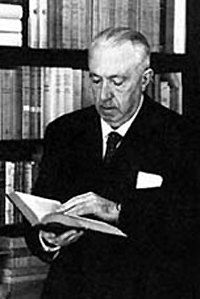 5
Carlo Emilio Gadda was an Italian writer and poet. He belongs to the tradition of the language innovators, writers who played with the somewhat stiff standard pre-war Italian language, and added...
5
Carlo Emilio Gadda was an Italian writer and poet. He belongs to the tradition of the language innovators, writers who played with the somewhat stiff standard pre-war Italian language, and added...
Carlo Cafiero
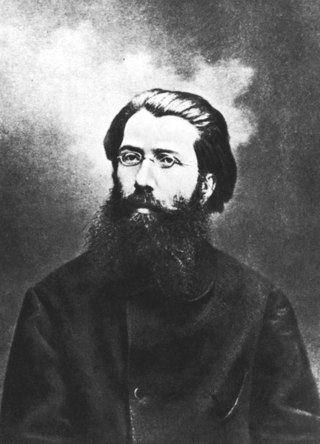 5
Carlo Cafiero was an Italian anarchist that led the Italian section of the International Workingmen's Association (IWA). An early leader of the Marxist and anarchist communist movements in Italy, he...
5
Carlo Cafiero was an Italian anarchist that led the Italian section of the International Workingmen's Association (IWA). An early leader of the Marxist and anarchist communist movements in Italy, he...
Pasquale Galluppi
 5
Pasquale Galluppi was an Italian philosopher.
5
Pasquale Galluppi was an Italian philosopher.
Ezio Tarantelli
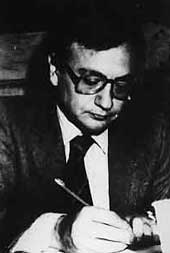 5
Ezio Tarantelli è stato un economista italiano, ucciso dalle Brigate Rosse in seguito ad un attentato.
5
Ezio Tarantelli è stato un economista italiano, ucciso dalle Brigate Rosse in seguito ad un attentato.
Henry Morselli
 5
Enrico "Henry" Agostino Morselli was an Italian physician and psychical researcher.
5
Enrico "Henry" Agostino Morselli was an Italian physician and psychical researcher.
Charles III, Duke of Bourbon
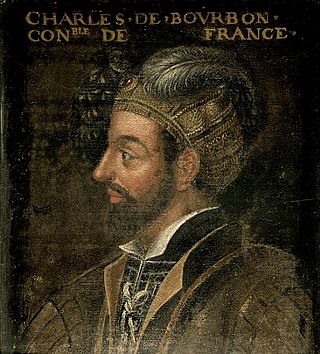 5
Charles III, Duke of Bourbon was a French military leader, the count of Montpensier, Clermont and Auvergne, and dauphin of Auvergne from 1501 to 1523, then duke of Bourbon and Auvergne, count of...
5
Charles III, Duke of Bourbon was a French military leader, the count of Montpensier, Clermont and Auvergne, and dauphin of Auvergne from 1501 to 1523, then duke of Bourbon and Auvergne, count of...
Dino Compagni
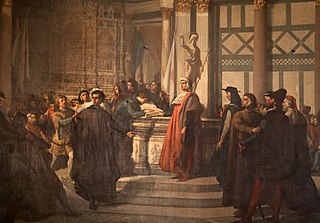 5
Dino Compagni was an Italian historical writer and political figure.
5
Dino Compagni was an Italian historical writer and political figure.
Domenico Cirillo
 5
Domenico Maria Leone Cirillo was an Italian physician, entomologist, botanist and patriot of the Neapolitan Republic of 1799.
5
Domenico Maria Leone Cirillo was an Italian physician, entomologist, botanist and patriot of the Neapolitan Republic of 1799.
Gabrio Casati
 5
Gabrio Casati was an Italian politician who served as the Prime Minister of the Kingdom of Sardinia from 28 July to 15 August 1848.
5
Gabrio Casati was an Italian politician who served as the Prime Minister of the Kingdom of Sardinia from 28 July to 15 August 1848.
Ottone Rosai
 5
Ottone Rosai was an Italian painter born in Florence, Italy.
5
Ottone Rosai was an Italian painter born in Florence, Italy.
Curzio Malaparte
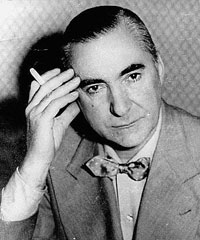 5
Curzio Malaparte, born Kurt Erich Suckert, was an Italian writer, filmmaker, war correspondent and diplomat. Malaparte is best known outside Italy due to his works Kaputt (1944) and The Skin (1949)....
5
Curzio Malaparte, born Kurt Erich Suckert, was an Italian writer, filmmaker, war correspondent and diplomat. Malaparte is best known outside Italy due to his works Kaputt (1944) and The Skin (1949)....
Angelo Secchi
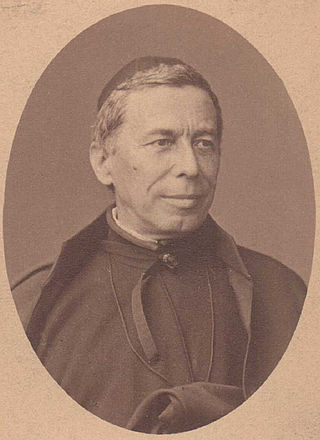 5
Angelo Secchi was an Italian Catholic priest, astronomer from the Italian region of Emilia. He was director of the observatory at the Pontifical Gregorian University for 28 years. He was a pioneer in...
5
Angelo Secchi was an Italian Catholic priest, astronomer from the Italian region of Emilia. He was director of the observatory at the Pontifical Gregorian University for 28 years. He was a pioneer in...
Leopoldo Gasparotto
 5
Leopoldo Gasparotto, better known as Poldo Gasparotto was an Italian mountaineer and Resistance leader during World War II.
5
Leopoldo Gasparotto, better known as Poldo Gasparotto was an Italian mountaineer and Resistance leader during World War II.
Domenico Ricci
 5
Domenico Ricci è stato un carabiniere italiano, appuntato dell'Arma dei Carabinieri, insignito di Medaglia d'oro al valor civile alla memoria; fu ucciso nell'agguato di via Fani a Roma in occasione...
5
Domenico Ricci è stato un carabiniere italiano, appuntato dell'Arma dei Carabinieri, insignito di Medaglia d'oro al valor civile alla memoria; fu ucciso nell'agguato di via Fani a Roma in occasione...
Enrico Cosenz
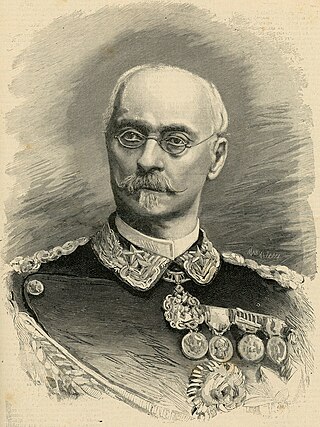 5
Enrico Cosenz was an Italian soldier born at Gaeta.
5
Enrico Cosenz was an Italian soldier born at Gaeta.
Nicolo Tartaglia
 5
Nicolo, known as Tartaglia, was an Italian mathematician, engineer, a surveyor and a bookkeeper from the then Republic of Venice. He published many books, including the first Italian translations of...
5
Nicolo, known as Tartaglia, was an Italian mathematician, engineer, a surveyor and a bookkeeper from the then Republic of Venice. He published many books, including the first Italian translations of...
Boethius
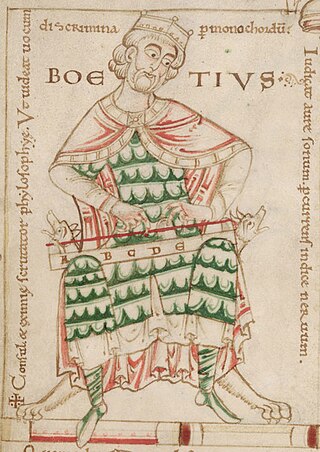 5
Anicius Manlius Severinus Boethius, commonly known simply as Boethius, was a Roman senator, consul, magister officiorum, polymath, historian, and philosopher of the Early Middle Ages. He was a...
5
Anicius Manlius Severinus Boethius, commonly known simply as Boethius, was a Roman senator, consul, magister officiorum, polymath, historian, and philosopher of the Early Middle Ages. He was a...
Giovanni Bertacchi
 5
Giovanni Bertacchi was a poet, teacher and Italian literary critic.
5
Giovanni Bertacchi was a poet, teacher and Italian literary critic.
Gaius Duilius
 5
Gaius Duilius was a Roman general and statesman. As consul in 260 BC, during the First Punic War, he won Rome's first ever victory at sea by defeating the Carthaginians at the Battle of Mylae. He...
5
Gaius Duilius was a Roman general and statesman. As consul in 260 BC, during the First Punic War, he won Rome's first ever victory at sea by defeating the Carthaginians at the Battle of Mylae. He...
Elio Morpurgo
 5
Elio Morpurgo was an Italian politician, member of the Italian Senate and of the Chamber of Deputies, and mayor of Udine.
5
Elio Morpurgo was an Italian politician, member of the Italian Senate and of the Chamber of Deputies, and mayor of Udine.
L. L. Zamenhof
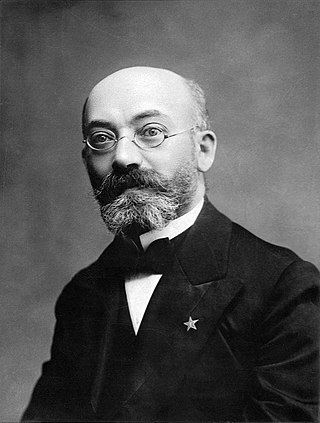 5
L. L. Zamenhof was the creator of Esperanto, the most widely used constructed international auxiliary language.
5
L. L. Zamenhof was the creator of Esperanto, the most widely used constructed international auxiliary language.
Francis Bacon
 5
Francis Bacon, 1st Viscount St Alban PC, known as Lord Verulam between 1618 and 1621, was an English philosopher and statesman who served as Attorney General and Lord Chancellor of England under King...
5
Francis Bacon, 1st Viscount St Alban PC, known as Lord Verulam between 1618 and 1621, was an English philosopher and statesman who served as Attorney General and Lord Chancellor of England under King...
Raimondo Franchetti
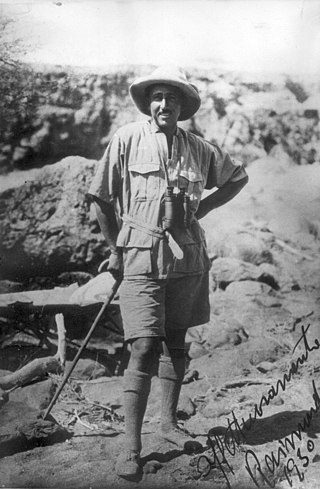 5
Baron Raimondo Franchetti has been the name of more than one Italian Baron, of the noble Franchetti family. The Franchettis were an Italian Jewish family who, from the 18th century onwards, were one...
5
Baron Raimondo Franchetti has been the name of more than one Italian Baron, of the noble Franchetti family. The Franchettis were an Italian Jewish family who, from the 18th century onwards, were one...
Giovanni Ruffini
 5
Giovanni Ruffini was an Italian writer and patriot of the early 19th century. He is chiefly known for having written the draft of the libretto of the opera Don Pasquale for its composer Gaetano...
5
Giovanni Ruffini was an Italian writer and patriot of the early 19th century. He is chiefly known for having written the draft of the libretto of the opera Don Pasquale for its composer Gaetano...
Roberto Bracco
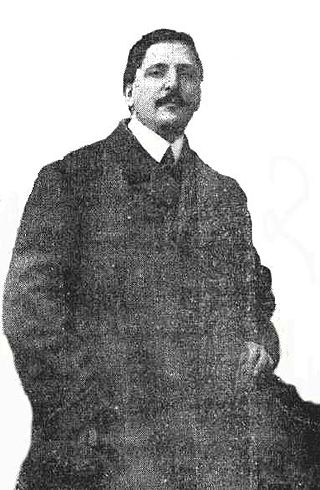 5
Roberto Bracco (1861–1943) was an Italian playwright, screenwriter and journalist. A number of his plays were turned into films, and he worked on the scripts of several of them including the 1914...
5
Roberto Bracco (1861–1943) was an Italian playwright, screenwriter and journalist. A number of his plays were turned into films, and he worked on the scripts of several of them including the 1914...
Giannina Milli
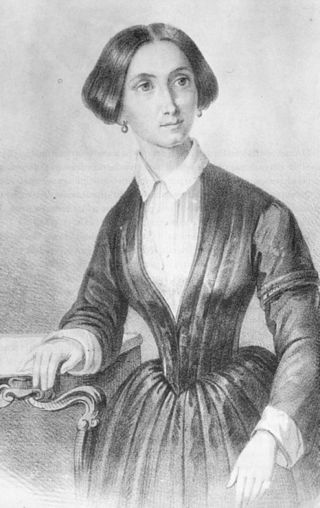 5
Giannina Milli, all'anagrafe Giovanna Milli, è stata una scrittrice, poetessa e educatrice italiana.
5
Giannina Milli, all'anagrafe Giovanna Milli, è stata una scrittrice, poetessa e educatrice italiana.
Giovanni Fantoni
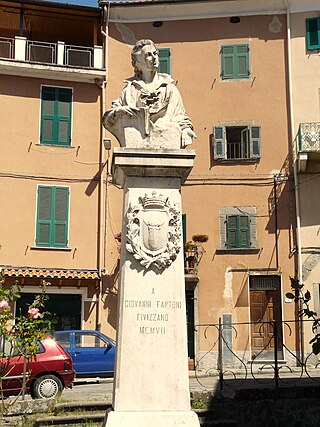 5
Giovanni Fantoni (1755—1807) was an Italian poet.
5
Giovanni Fantoni (1755—1807) was an Italian poet.
Luigi Rossi
 5
Luigi Rossi was an Italian Baroque composer. Born in Torremaggiore, a small town near Foggia, in the ancient kingdom of Naples, at an early age he went to Naples where he studied music with the...
5
Luigi Rossi was an Italian Baroque composer. Born in Torremaggiore, a small town near Foggia, in the ancient kingdom of Naples, at an early age he went to Naples where he studied music with the...
Davide Albertario
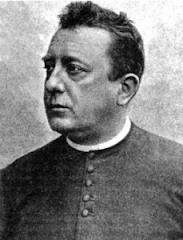 5
Davide Albertario è stato un presbitero e giornalista italiano, direttore dell'«Osservatore Cattolico», giornale che univa posizioni intransigenti in materia di fede e di rapporto tra la Chiesa e lo...
5
Davide Albertario è stato un presbitero e giornalista italiano, direttore dell'«Osservatore Cattolico», giornale che univa posizioni intransigenti in materia di fede e di rapporto tra la Chiesa e lo...
Eugenio Colorni
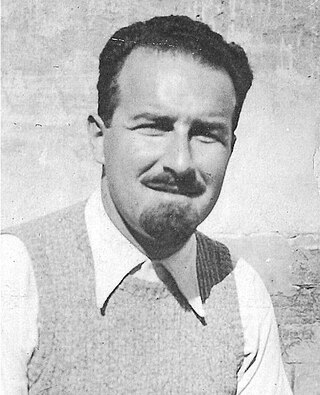 5
Eugenio Colorni was an Italian philosopher and anti-fascist activist.
5
Eugenio Colorni was an Italian philosopher and anti-fascist activist.
Teresio Olivelli
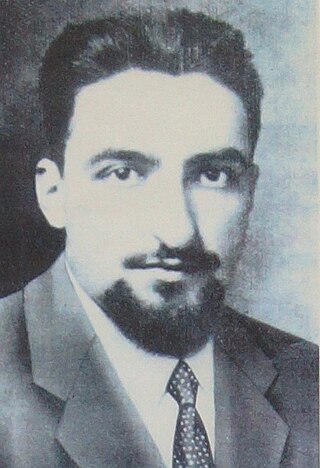 5
Teresio Olivelli was an Italian Roman Catholic soldier during World War II and part of the Italian Resistance movement to Fascism and the Nazi regime. Olivelli graduated in law in Pavia in 1938 and...
5
Teresio Olivelli was an Italian Roman Catholic soldier during World War II and part of the Italian Resistance movement to Fascism and the Nazi regime. Olivelli graduated in law in Pavia in 1938 and...
Jacopone da Todi
 5
Jacopone da Todi, O.F.M. was an Italian Franciscan friar from Umbria. He wrote several laude in the local vernacular. He was an early pioneer in Italian theatre, being one of the earliest scholars...
5
Jacopone da Todi, O.F.M. was an Italian Franciscan friar from Umbria. He wrote several laude in the local vernacular. He was an early pioneer in Italian theatre, being one of the earliest scholars...
Giuseppe Frua
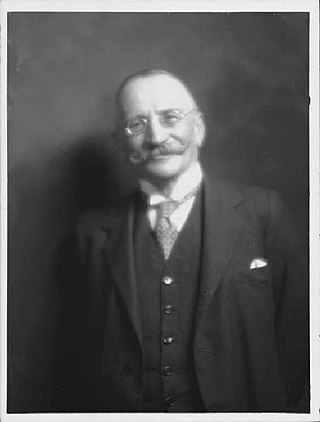 5
Giuseppe Frua è stato un imprenditore italiano dell'industria tessile.
5
Giuseppe Frua è stato un imprenditore italiano dell'industria tessile.
Maria Callas
 5
Maria Callas was an American-born Greek soprano who was one of the most renowned and influential opera singers of the 20th century. Many critics praised her bel canto technique, wide-ranging voice...
5
Maria Callas was an American-born Greek soprano who was one of the most renowned and influential opera singers of the 20th century. Many critics praised her bel canto technique, wide-ranging voice...
Nicola Calipari
 5
Nicola Calipari was an Italian major general and SISMI military intelligence officer. Calipari was accidentally killed by American soldiers while escorting a recently released Italian hostage,...
5
Nicola Calipari was an Italian major general and SISMI military intelligence officer. Calipari was accidentally killed by American soldiers while escorting a recently released Italian hostage,...
Emilio Longoni
 5
Emilio Longoni was an Italian painter.
5
Emilio Longoni was an Italian painter.
Amadeus VII, Count of Savoy
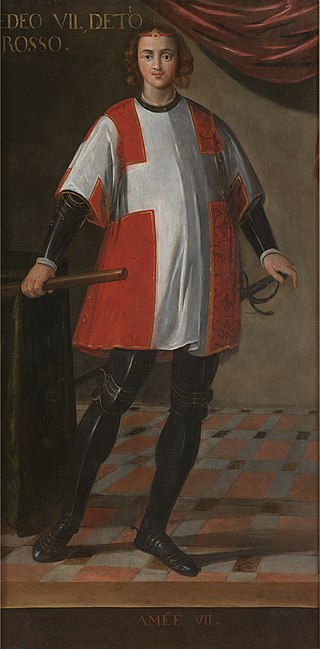 5
Amadeus VII, known as the Red Count, was Count of Savoy from 1383 to 1391.
5
Amadeus VII, known as the Red Count, was Count of Savoy from 1383 to 1391.
Federico Rosazza
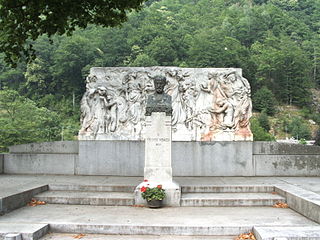 5
Federico Rosazza Pistolet è stato un politico italiano, famoso per avere realizzato numerose opere a favore della popolazione della Valle Cervo.
5
Federico Rosazza Pistolet è stato un politico italiano, famoso per avere realizzato numerose opere a favore della popolazione della Valle Cervo.
Filippo Lippi
 5
Filippo Lippi, also known as Lippo Lippi, was an Italian painter of the Quattrocento and a Carmelite priest. He was an early Renaissance master of a painting workshop, who taught many painters....
5
Filippo Lippi, also known as Lippo Lippi, was an Italian painter of the Quattrocento and a Carmelite priest. He was an early Renaissance master of a painting workshop, who taught many painters....
Adolfo Consolini
 5
Adolfo Consolini was an Italian discus thrower. He competed at the 1948, 1952, 1956 and 1960 Olympics and finished in 1st, 2nd, 6th and 17 place, respectively. While winning the gold medal in 1948 he...
5
Adolfo Consolini was an Italian discus thrower. He competed at the 1948, 1952, 1956 and 1960 Olympics and finished in 1st, 2nd, 6th and 17 place, respectively. While winning the gold medal in 1948 he...
Luigi Nono
 5
Luigi Nono was an Italian avant-garde composer of classical music.
5
Luigi Nono was an Italian avant-garde composer of classical music.
Genesius of Rome
 5
Genesius of Rome is a legendary Christian saint, once a comedian and actor who had performed in plays that mocked Christianity. According to legend, while performing in a play that made fun of...
5
Genesius of Rome is a legendary Christian saint, once a comedian and actor who had performed in plays that mocked Christianity. According to legend, while performing in a play that made fun of...
Alda Merini
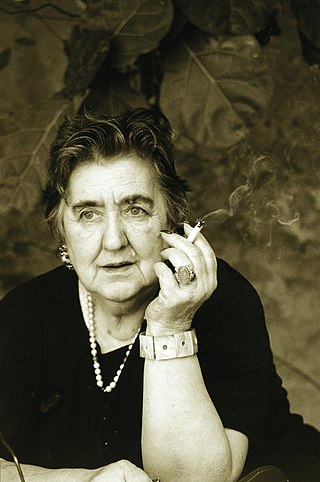 5
Alda Merini was an Italian writer and poet. Her work earned the attention and admiration of other Italian writers, such as Giorgio Manganelli, Salvatore Quasimodo, and Pier Paolo Pasolini.
5
Alda Merini was an Italian writer and poet. Her work earned the attention and admiration of other Italian writers, such as Giorgio Manganelli, Salvatore Quasimodo, and Pier Paolo Pasolini.
Jacopo Stellini
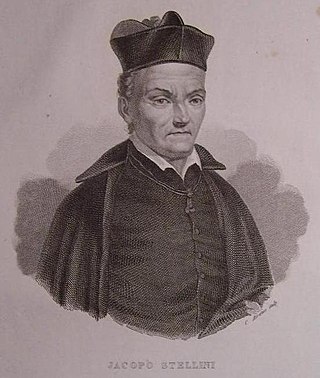 5
Jacopo Stellini was an Italian abbot, polymath writer and philosopher.
5
Jacopo Stellini was an Italian abbot, polymath writer and philosopher.
Antonio Smareglia
 5
Antonio Smareglia was an Italian opera composer.
5
Antonio Smareglia was an Italian opera composer.
Pelagia
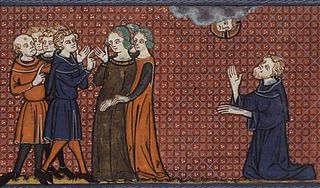 5
Pelagia, distinguished as Pelagia of Antioch, Pelagia the Penitent, and Pelagia the Harlot, was a Christian saint and hermit in the 4th or 5th century. Her feast day was celebrated on 8 October,...
5
Pelagia, distinguished as Pelagia of Antioch, Pelagia the Penitent, and Pelagia the Harlot, was a Christian saint and hermit in the 4th or 5th century. Her feast day was celebrated on 8 October,...
Giusto Fontanini
 5
Giusto Fontanini was a Roman Catholic archbishop and an Italian historian.
5
Giusto Fontanini was a Roman Catholic archbishop and an Italian historian.
Pier Silverio Leicht
 5
Pier Silverio Leicht war ein italienischer Jurist, Historiker und Bibliothekar.
5
Pier Silverio Leicht war ein italienischer Jurist, Historiker und Bibliothekar.
Pellegrino da San Daniele
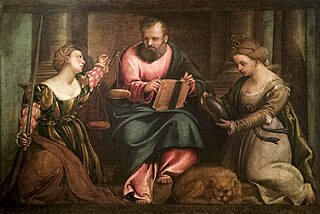 5
Pellegrino da San Daniele (1467–1547) was an Italian painter in the late-Quattrocento and Renaissance styles, active in the Friulian region.
5
Pellegrino da San Daniele (1467–1547) was an Italian painter in the late-Quattrocento and Renaissance styles, active in the Friulian region.
Giuseppe Marchi
 5
Giuseppe Marchi was an Italian Jesuit archæologist who worked on the Catacombs of Rome.
5
Giuseppe Marchi was an Italian Jesuit archæologist who worked on the Catacombs of Rome.
Nelson Rockefeller
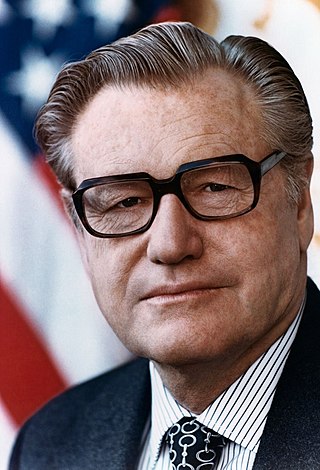 5
Nelson Aldrich Rockefeller, sometimes referred to by his nickname Rocky, was an American businessman and politician who served as the 41st vice president of the United States from 1974 to 1977 under...
5
Nelson Aldrich Rockefeller, sometimes referred to by his nickname Rocky, was an American businessman and politician who served as the 41st vice president of the United States from 1974 to 1977 under...
Maria Goretti
 5
Maria Teresa Goretti was an Italian virgin martyr of the Catholic Church, and one of the youngest saints to be canonized. She was born to a farming family. Her father died when she was nine, and the...
5
Maria Teresa Goretti was an Italian virgin martyr of the Catholic Church, and one of the youngest saints to be canonized. She was born to a farming family. Her father died when she was nine, and the...
Antonio Ballero
 5
Antonio Ballero è stato un pittore, scrittore e fotografo italiano.
Personalità creativa e poliedrica, a cavallo del 1900 fu uno dei protagonisti, insieme a Francesco Ciusa, Grazia Deledda,...
5
Antonio Ballero è stato un pittore, scrittore e fotografo italiano.
Personalità creativa e poliedrica, a cavallo del 1900 fu uno dei protagonisti, insieme a Francesco Ciusa, Grazia Deledda,...
Aligi Sassu
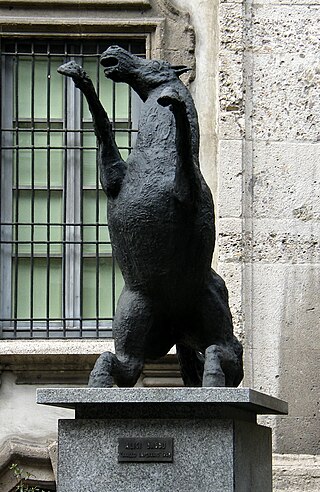 5
Aligi Sassu was an Italian painter and sculptor.
5
Aligi Sassu was an Italian painter and sculptor.
Melchiorre Murenu
 5
Melchiorre Murenu was a blind Sardinian poet.
Melchiorre Murenu is known as the "Homer of Sardinia" because he was blind and lived his entire life for poetry.
5
Melchiorre Murenu was a blind Sardinian poet.
Melchiorre Murenu is known as the "Homer of Sardinia" because he was blind and lived his entire life for poetry.
Gavino Gabriel
 5
Gavino Gabriel was an Italian composer, ethnomusicologist scholar of Sardinian music, especially that of Gallura, and has written and published many essays on the subject.
5
Gavino Gabriel was an Italian composer, ethnomusicologist scholar of Sardinian music, especially that of Gallura, and has written and published many essays on the subject.
Girolamo Tiraboschi
 5
Girolamo Tiraboschi S.J. was an Italian literary critic, the first historian of Italian literature.
5
Girolamo Tiraboschi S.J. was an Italian literary critic, the first historian of Italian literature.
Andrea Fantoni
 5
Andrea Fantoni (1659–1734) was an Italian sculptor and woodcarver of the late-Baroque period, active in the region near Bergamo.
5
Andrea Fantoni (1659–1734) was an Italian sculptor and woodcarver of the late-Baroque period, active in the region near Bergamo.
Baldassare Longhena
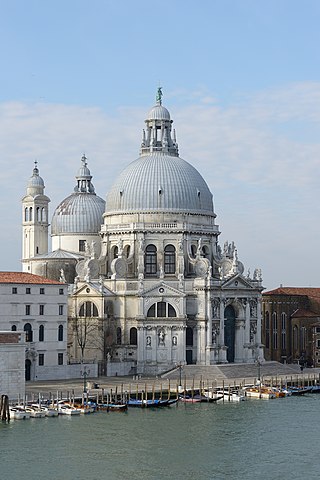 5
Baldassare Longhena was an Italian architect, who worked mainly in Venice, where he was one of the greatest exponents of Baroque architecture of the period.
5
Baldassare Longhena was an Italian architect, who worked mainly in Venice, where he was one of the greatest exponents of Baroque architecture of the period.
Biagio Rossetti
 5
Biagio Rossetti was an Italian architect and urbanist from Ferrara. A military engineer since 1483, and the ducal architect of Ercole I d'Este, in 1492 Rossetti was assigned the project of enlarging...
5
Biagio Rossetti was an Italian architect and urbanist from Ferrara. A military engineer since 1483, and the ducal architect of Ercole I d'Este, in 1492 Rossetti was assigned the project of enlarging...
Federico García Lorca
 5
Federico del Sagrado Corazón de Jesús García Lorca, known as Federico García Lorca, was a Spanish poet, playwright, and theatre director. García Lorca achieved international recognition as an...
5
Federico del Sagrado Corazón de Jesús García Lorca, known as Federico García Lorca, was a Spanish poet, playwright, and theatre director. García Lorca achieved international recognition as an...
Paolo Dettori
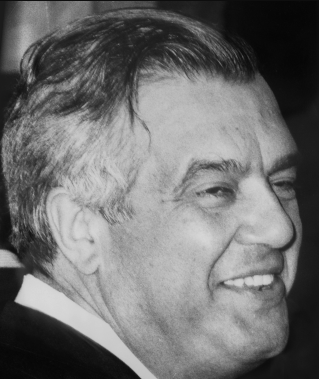 5
Paolo Dettori è stato un politico italiano.
5
Paolo Dettori è stato un politico italiano.
Georges Bizet
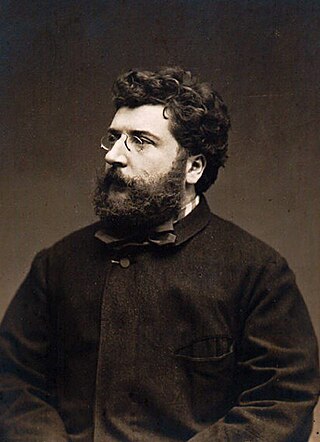 5
Georges Bizet was a French composer of the Romantic era. Best known for his operas in a career cut short by his early death, Bizet achieved few successes before his final work, Carmen, which has...
5
Georges Bizet was a French composer of the Romantic era. Best known for his operas in a career cut short by his early death, Bizet achieved few successes before his final work, Carmen, which has...
Benjamin Franklin
 5
Benjamin Franklin was an American polymath, a leading writer, scientist, inventor, statesman, diplomat, printer, publisher, and political philosopher. Among the most influential intellectuals of his...
5
Benjamin Franklin was an American polymath, a leading writer, scientist, inventor, statesman, diplomat, printer, publisher, and political philosopher. Among the most influential intellectuals of his...
Luigi Illica
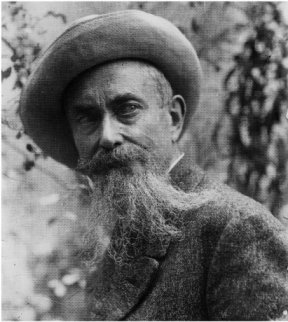 5
Luigi Illica was an Italian librettist who wrote for Giacomo Puccini, Pietro Mascagni, Alfredo Catalani, Umberto Giordano, Baron Alberto Franchetti and other important Italian composers. His most...
5
Luigi Illica was an Italian librettist who wrote for Giacomo Puccini, Pietro Mascagni, Alfredo Catalani, Umberto Giordano, Baron Alberto Franchetti and other important Italian composers. His most...
Nelson Mandela
 5
Nelson Rolihlahla Mandela was a South African anti-apartheid activist, politician, and statesman who served as the first president of South Africa from 1994 to 1999. He was the country's first black...
5
Nelson Rolihlahla Mandela was a South African anti-apartheid activist, politician, and statesman who served as the first president of South Africa from 1994 to 1999. He was the country's first black...
Magdalene of Canossa
 5
Magdalena di Canossa was an Italian professed religious and foundress of the two Canossian congregations. Magdalena was a leading advocate for the poor in her region after she witnessed first hand...
5
Magdalena di Canossa was an Italian professed religious and foundress of the two Canossian congregations. Magdalena was a leading advocate for the poor in her region after she witnessed first hand...
Giuseppe Peano
 5
Giuseppe Peano was an Italian mathematician and glottologist. The author of over 200 books and papers, he was a founder of mathematical logic and set theory, to which he contributed much notation....
5
Giuseppe Peano was an Italian mathematician and glottologist. The author of over 200 books and papers, he was a founder of mathematical logic and set theory, to which he contributed much notation....
Giuseppe Massari
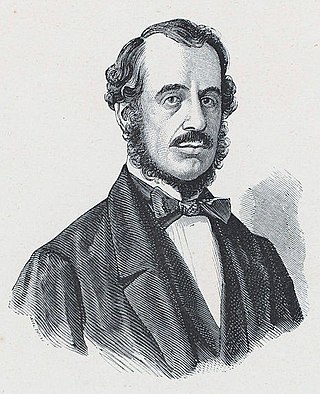 5
Giuseppe Massari è stato un patriota, giornalista e politico italiano.
5
Giuseppe Massari è stato un patriota, giornalista e politico italiano.
Flavio Biondo
Oreste Leonardi
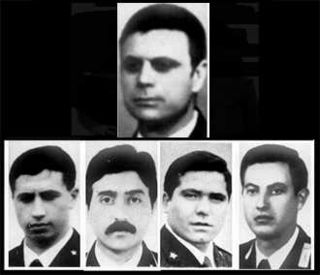 5
Oreste Leonardi è stato un carabiniere italiano, capo della scorta di Aldo Moro; fu ucciso nell'agguato di via Fani.
5
Oreste Leonardi è stato un carabiniere italiano, capo della scorta di Aldo Moro; fu ucciso nell'agguato di via Fani.
Adolfo Vigorelli
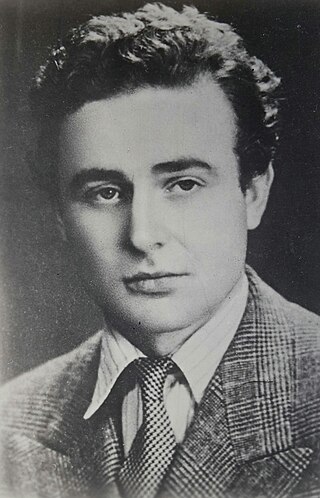 5
Adolfo Vigorelli was an Italian Resistance fighter during World War II.
5
Adolfo Vigorelli was an Italian Resistance fighter during World War II.
Bartolo Longo
 5
Bartolo Longo was an Italian lawyer who has been beatified by the Catholic Church. He presented himself as a former "Satanic priest" who returned to the Catholic faith and became a Dominican...
5
Bartolo Longo was an Italian lawyer who has been beatified by the Catholic Church. He presented himself as a former "Satanic priest" who returned to the Catholic faith and became a Dominican...
Abundius
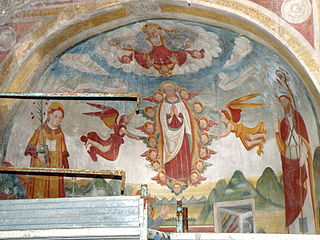 5
Abundius, venerated in the Catholic Church as Saint Abundius, was a bishop of Como, Northern Italy.
5
Abundius, venerated in the Catholic Church as Saint Abundius, was a bishop of Como, Northern Italy.
Corrado Alvaro
 5
Corrado Alvaro was an Italian journalist and writer of novels, short stories, screenplays and plays. He often used the verismo style to describe the hopeless poverty in his native Calabria. His first...
5
Corrado Alvaro was an Italian journalist and writer of novels, short stories, screenplays and plays. He often used the verismo style to describe the hopeless poverty in his native Calabria. His first...
Sigmund Freud
 4
Sigmund Freud was an Austrian neurologist and the founder of psychoanalysis, a clinical method for evaluating and treating pathologies seen as originating from conflicts in the psyche, through...
4
Sigmund Freud was an Austrian neurologist and the founder of psychoanalysis, a clinical method for evaluating and treating pathologies seen as originating from conflicts in the psyche, through...
Erasmo Piaggio
Andrea Sansovino
 4
Andrea dal Monte Sansovino or Andrea Contucci del Monte San Savino was an Italian sculptor active during the High Renaissance. His pupils include Jacopo Sansovino.
4
Andrea dal Monte Sansovino or Andrea Contucci del Monte San Savino was an Italian sculptor active during the High Renaissance. His pupils include Jacopo Sansovino.
Domenico Cucchiari
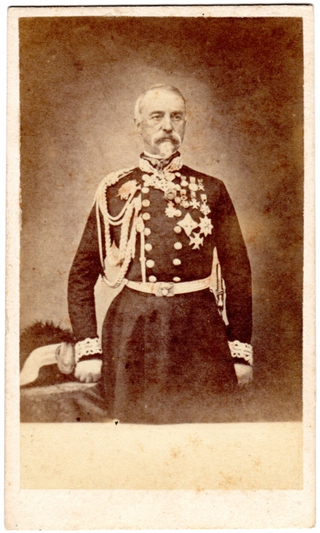 4
Domenico Cucchiari è stato un generale e politico italiano.
4
Domenico Cucchiari è stato un generale e politico italiano.
Edoardo Porro
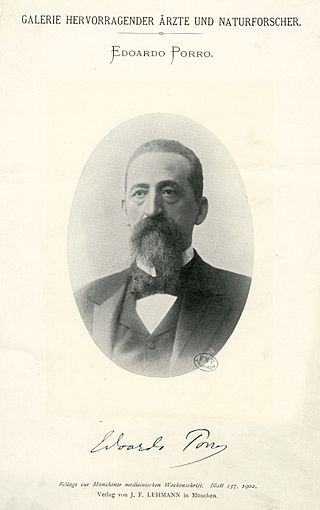 4
Edoardo Porro (1842–1902) was an Italian obstetrician and gynaecologist, mainly known for developing Porro’s operation, surgical procedure precursor of the modern Caesarean section.
4
Edoardo Porro (1842–1902) was an Italian obstetrician and gynaecologist, mainly known for developing Porro’s operation, surgical procedure precursor of the modern Caesarean section.
Pietro Borsieri
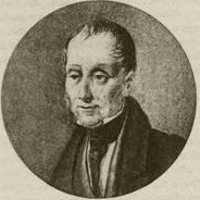 4
Pietro Borsieri è stato uno scrittore e patriota italiano.
Figura centrale nell'esperienza del periodico Il Conciliatore, fu intellettuale romantico poi condannato alla prigione e all'esilio.
4
Pietro Borsieri è stato uno scrittore e patriota italiano.
Figura centrale nell'esperienza del periodico Il Conciliatore, fu intellettuale romantico poi condannato alla prigione e all'esilio.
Mario Musolesi
 4
Mario Musolesi was an Italian soldier and Resistance leader during World War II.
4
Mario Musolesi was an Italian soldier and Resistance leader during World War II.
Paolo Gorini
 4
Paolo Gorini was an Italian mathematician, professor, scientist, and politician renowned as a pioneer of cremation in Europe, primarily in the United Kingdom.
4
Paolo Gorini was an Italian mathematician, professor, scientist, and politician renowned as a pioneer of cremation in Europe, primarily in the United Kingdom.
Emilio Comici
 4
Leonardo Emilio Comici was an Italian mountain climber and caver. He made numerous ascents in the Eastern Alps, particularly in the Dolomites and in the Julian Alps. Comici was nicknamed the "Angel...
4
Leonardo Emilio Comici was an Italian mountain climber and caver. He made numerous ascents in the Eastern Alps, particularly in the Dolomites and in the Julian Alps. Comici was nicknamed the "Angel...
Henri Cernuschi
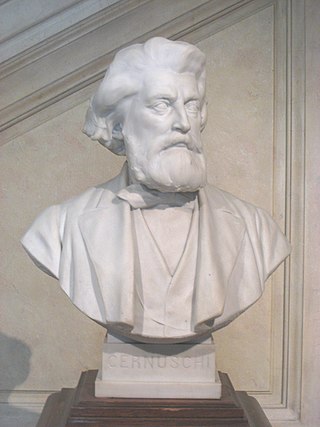 4
Henri Cernuschi was a major French-Italian banker, economist and Asian art collector, who began public life as a politician in Italy in 1848–1850.
4
Henri Cernuschi was a major French-Italian banker, economist and Asian art collector, who began public life as a politician in Italy in 1848–1850.
Carlo Tenca
 4
Carlo Tenca was an Italian man of letters, journalist, deputy and supporter of the Risorgimento. He was the central figure in the salon of Countess Clara Maffei, to whom he was romantically linked.
4
Carlo Tenca was an Italian man of letters, journalist, deputy and supporter of the Risorgimento. He was the central figure in the salon of Countess Clara Maffei, to whom he was romantically linked.
Silvio Trentin
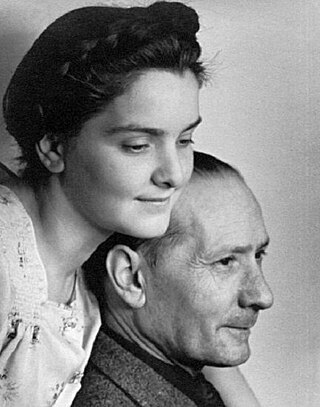 4
Silvio Trentin è stato un partigiano e giurista italiano, docente universitario di diritto amministrativo.
4
Silvio Trentin è stato un partigiano e giurista italiano, docente universitario di diritto amministrativo.
Cesare Maccari
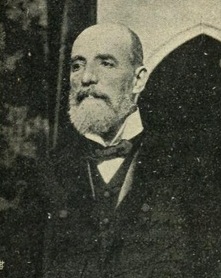 4
Cesare Maccari was an Italian painter and sculptor, most famous for his 1888 painting Cicerone denuncia Catilina.
4
Cesare Maccari was an Italian painter and sculptor, most famous for his 1888 painting Cicerone denuncia Catilina.
Pietro Andrea Mattioli
 4
Pietro Andrea Gregorio Mattioli was a doctor and naturalist born in Siena.
4
Pietro Andrea Gregorio Mattioli was a doctor and naturalist born in Siena.
Vamba
 4
Luigi Bertelli, best known as Vamba, was an Italian writer, illustrator and journalist.
4
Luigi Bertelli, best known as Vamba, was an Italian writer, illustrator and journalist.
Giuseppe Arimondi
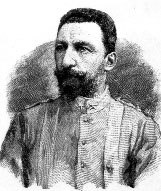 4
Giuseppe Edoardo Arimondi, OSML, OMS, OCI was an Italian general, mostly known for his role during the First Italo-Ethiopian War. He was one of the few European commanders who gained a victory over...
4
Giuseppe Edoardo Arimondi, OSML, OMS, OCI was an Italian general, mostly known for his role during the First Italo-Ethiopian War. He was one of the few European commanders who gained a victory over...
Antonio Gazzoletti
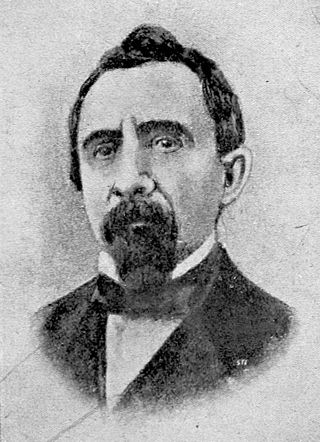 4
Antonio Gazzoletti è stato un giurista e poeta italiano.
4
Antonio Gazzoletti è stato un giurista e poeta italiano.
Giovanni Botero
 4
Giovanni Botero was an Italian thinker, priest, poet, and diplomat, author of Della Ragion di Stato , in ten chapters, printed in Venice in 1589, and of Universal Relations,, addressing the world...
4
Giovanni Botero was an Italian thinker, priest, poet, and diplomat, author of Della Ragion di Stato , in ten chapters, printed in Venice in 1589, and of Universal Relations,, addressing the world...
Raphael (archangel)
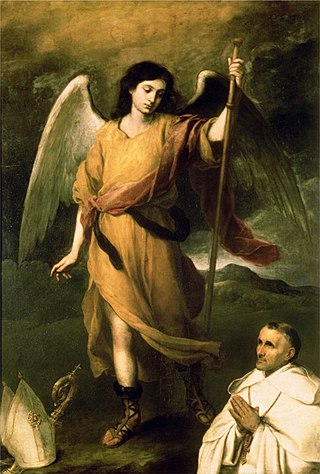 4
Raphael is an archangel first mentioned in the Book of Tobit and in 1 Enoch, both estimated to date from between the 3rd and 2nd century BCE. In later Jewish tradition, he became identified as one of...
4
Raphael is an archangel first mentioned in the Book of Tobit and in 1 Enoch, both estimated to date from between the 3rd and 2nd century BCE. In later Jewish tradition, he became identified as one of...
Ugo Betti
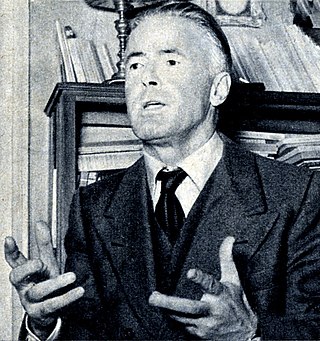 4
Ugo Betti was an Italian judge, better known as an author, who is considered by many the greatest Italian playwright next to Pirandello.
4
Ugo Betti was an Italian judge, better known as an author, who is considered by many the greatest Italian playwright next to Pirandello.
Nicola Pisano
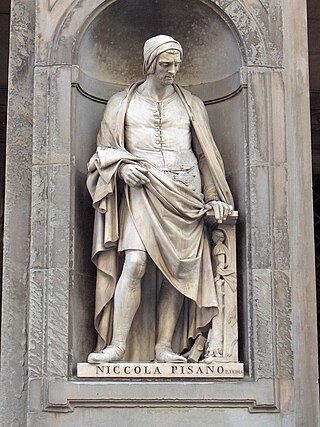 4
Nicola Pisano was an Italian sculptor whose work is noted for its classical Roman sculptural style. Pisano is sometimes considered to be the founder of modern sculpture.
4
Nicola Pisano was an Italian sculptor whose work is noted for its classical Roman sculptural style. Pisano is sometimes considered to be the founder of modern sculpture.
Giovanni della Casa
 4
Giovanni della Casa was an Italian poet, diplomat, clergyman and inquisitor, and writer on etiquette and society. He is celebrated for his famous treatise on polite behavior, Il Galateo overo de’...
4
Giovanni della Casa was an Italian poet, diplomat, clergyman and inquisitor, and writer on etiquette and society. He is celebrated for his famous treatise on polite behavior, Il Galateo overo de’...
Giovanni Pico della Mirandola
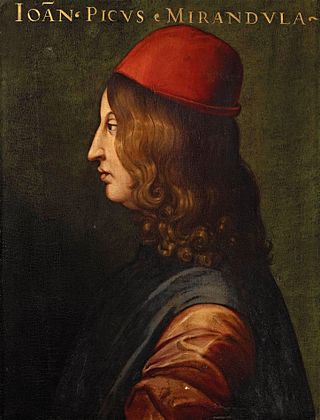 4
Giovanni Pico dei conti della Mirandola e della Concordia, known as Pico della Mirandola, was an Italian Renaissance nobleman and philosopher. He is famed for the events of 1486, when, at the age of...
4
Giovanni Pico dei conti della Mirandola e della Concordia, known as Pico della Mirandola, was an Italian Renaissance nobleman and philosopher. He is famed for the events of 1486, when, at the age of...
Pisanello
 4
Pisanello, born Antonio di Puccio Pisano or Antonio di Puccio da Cereto, also erroneously called Vittore Pisano by Giorgio Vasari, was one of the most distinguished painters of the early Italian...
4
Pisanello, born Antonio di Puccio Pisano or Antonio di Puccio da Cereto, also erroneously called Vittore Pisano by Giorgio Vasari, was one of the most distinguished painters of the early Italian...
Giovanni delle Bande Nere
 4
Ludovico de' Medici, also known as Giovanni delle Bande Nere was an Italian condottiero. He is known for leading the Black Bands and serving valiantly in military combat under his third cousins, Pope...
4
Ludovico de' Medici, also known as Giovanni delle Bande Nere was an Italian condottiero. He is known for leading the Black Bands and serving valiantly in military combat under his third cousins, Pope...
Giuseppe Graziosi
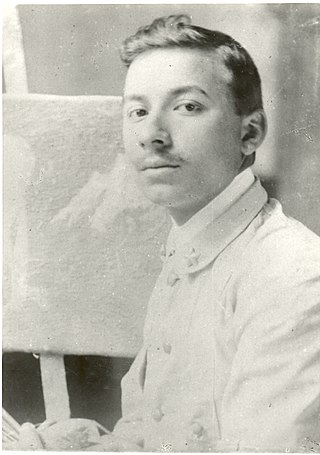 4
Giuseppe Graziosi was an Italian sculptor, painter and graphic designer.
4
Giuseppe Graziosi was an Italian sculptor, painter and graphic designer.
Carlo Fadda
 4
Carlo Fadda (1853–1931) was an Italian jurist and politician.
4
Carlo Fadda (1853–1931) was an Italian jurist and politician.
Federico Delpino
 4
Giacomo Giuseppe Federico Delpino was an Italian botanist who made early observations on floral biology, particularly the pollination of flowers by insects. Delpino introduced a very broad view of...
4
Giacomo Giuseppe Federico Delpino was an Italian botanist who made early observations on floral biology, particularly the pollination of flowers by insects. Delpino introduced a very broad view of...
Mauro Venegoni
 4
Mauro Venegoni è stato un politico e partigiano italiano, comunista rivoluzionario.
4
Mauro Venegoni è stato un politico e partigiano italiano, comunista rivoluzionario.
Caesarius of Terracina
Policarpo Petrocchi
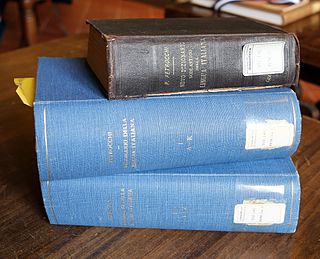 4
Policarpo Petrocchi è stato uno scrittore, filologo e lessicografo italiano.
4
Policarpo Petrocchi è stato uno scrittore, filologo e lessicografo italiano.
Tommaso Fiore
 4
Tommaso Fiore was an Italian meridionalist writer and a socialist intellectual and politician. He is known for his attention and his descriptions and studies on the inhumane conditions of Southern...
4
Tommaso Fiore was an Italian meridionalist writer and a socialist intellectual and politician. He is known for his attention and his descriptions and studies on the inhumane conditions of Southern...
Pietro Frattini
 4
Pietro Domenico Frattini was a supporter of Italian unification and one of the Belfiore martyrs.
4
Pietro Domenico Frattini was a supporter of Italian unification and one of the Belfiore martyrs.
Giuseppe Maggiolini
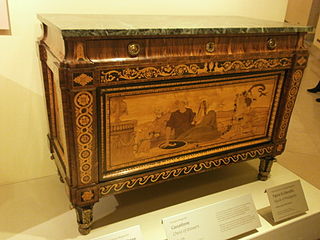 4
Giuseppe Maggiolini, himself a marquetry-maker (intarsiatore), was the pre-eminent cabinet-maker (ebanista) in Milan in the later 18th century. Though some of his early work is Late Baroque in...
4
Giuseppe Maggiolini, himself a marquetry-maker (intarsiatore), was the pre-eminent cabinet-maker (ebanista) in Milan in the later 18th century. Though some of his early work is Late Baroque in...
Tommaso Salvini
 4
Tommaso Salvini was an Italian actor.
4
Tommaso Salvini was an Italian actor.
Bartolo da San Gimignano
 4
Bartolo da San Gimignano – born Bartolo Buonpedoni – was an Italian Roman Catholic priest and a member of the Third Order of Saint Francis. Bartolo was born to nobles near Siena and fled home to...
4
Bartolo da San Gimignano – born Bartolo Buonpedoni – was an Italian Roman Catholic priest and a member of the Third Order of Saint Francis. Bartolo was born to nobles near Siena and fled home to...
Marcello Prestinari
 4
Marcello Prestinari è stato un militare italiano.
4
Marcello Prestinari è stato un militare italiano.
Giulio Tarra
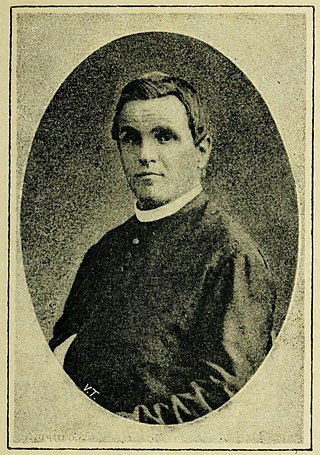 4
Giulio Tarra è stato un presbitero e educatore italiano.
Fu il primo rettore dell'allora Pio Istituto per Sordomuti poveri di campagna, oggi Pio Istituto dei Sordi, fondato nel 1854 e che resse per...
4
Giulio Tarra è stato un presbitero e educatore italiano.
Fu il primo rettore dell'allora Pio Istituto per Sordomuti poveri di campagna, oggi Pio Istituto dei Sordi, fondato nel 1854 e che resse per...
Pope Pius V
 4
Pope Pius V, OP, born Antonio Ghislieri, was head of the Catholic Church and ruler of the Papal States from 7 January 1566 to his death, in May 1572. He is venerated as a saint of the Catholic...
4
Pope Pius V, OP, born Antonio Ghislieri, was head of the Catholic Church and ruler of the Papal States from 7 January 1566 to his death, in May 1572. He is venerated as a saint of the Catholic...
Giovanni Battista Pirelli
 4
Giovanni Battista Alberto Pirelli è stato un imprenditore, ingegnere e politico italiano, fondatore dell'azienda omonima con sede a Milano.
4
Giovanni Battista Alberto Pirelli è stato un imprenditore, ingegnere e politico italiano, fondatore dell'azienda omonima con sede a Milano.
Salvatore Di Giacomo
 4
Salvatore Di Giacomo was an Italian poet, songwriter, playwright and fascist, one of the signatories to the Manifesto of the Fascist Intellectuals.
4
Salvatore Di Giacomo was an Italian poet, songwriter, playwright and fascist, one of the signatories to the Manifesto of the Fascist Intellectuals.
Appius Claudius Caecus
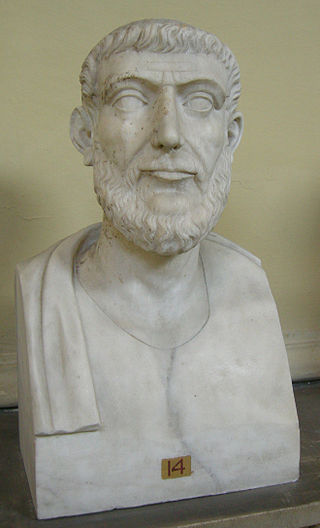 4
Appius Claudius Caecus was a statesman and writer from the Roman Republic. He is best known for two major building projects: the Appian Way, the first major Roman road, and the first aqueduct in...
4
Appius Claudius Caecus was a statesman and writer from the Roman Republic. He is best known for two major building projects: the Appian Way, the first major Roman road, and the first aqueduct in...
Maxim Gorky
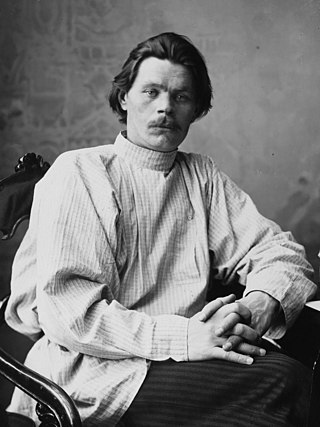 4
Alexei Maximovich Peshkov, popularly known as Maxim Gorky, was a Russian and Soviet writer and socialism proponent. He was nominated five times for the Nobel Prize in Literature. Before his success...
4
Alexei Maximovich Peshkov, popularly known as Maxim Gorky, was a Russian and Soviet writer and socialism proponent. He was nominated five times for the Nobel Prize in Literature. Before his success...
Salvatore Barzilai
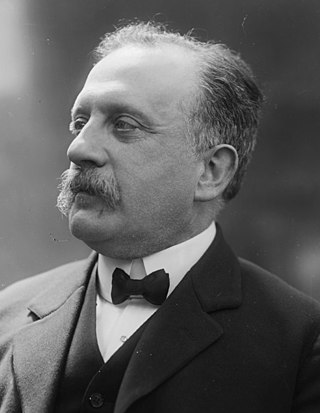 4
Salvatore Barzilai was an Italian jurist, journalist and politician who was one of the leaders of the Republican Party. He served as the minister for the lands freed by the enemy for one year between...
4
Salvatore Barzilai was an Italian jurist, journalist and politician who was one of the leaders of the Republican Party. He served as the minister for the lands freed by the enemy for one year between...
Bruno Tosarelli
 4
Bruno Tosarelli è stato un partigiano italiano.
Medaglia d'oro al valor militare alla memoria.
4
Bruno Tosarelli è stato un partigiano italiano.
Medaglia d'oro al valor militare alla memoria.
Alberto Manzi
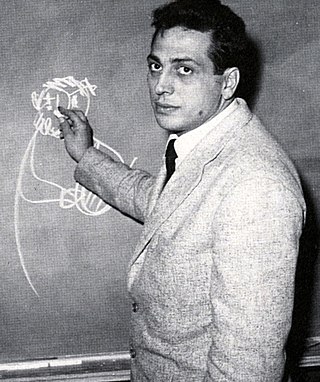 4
Alberto Manzi was an Italian school teacher, writer and television host, best known for being the art director of Non è mai troppo tardi, an educational TV programme broadcast between 1959 and 1968.
4
Alberto Manzi was an Italian school teacher, writer and television host, best known for being the art director of Non è mai troppo tardi, an educational TV programme broadcast between 1959 and 1968.
Francesco Flora
Corrado Ricci
 4
Corrado Ricci è stato un archeologo e storico dell'arte italiano.
Fu nominato senatore del Regno d'Italia nella XXVI legislatura.
4
Corrado Ricci è stato un archeologo e storico dell'arte italiano.
Fu nominato senatore del Regno d'Italia nella XXVI legislatura.
Maria Melato
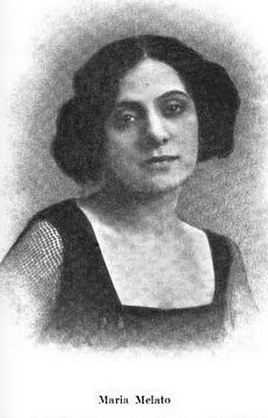 4
Maria Melato was an Italian actress of the stage, screen, and radio.
4
Maria Melato was an Italian actress of the stage, screen, and radio.
Giuseppe Bentivogli
 4
Giuseppe Bentivogli è stato un politico, sindacalista e partigiano italiano, Medaglia d'oro al valor militare alla memoria.
4
Giuseppe Bentivogli è stato un politico, sindacalista e partigiano italiano, Medaglia d'oro al valor militare alla memoria.
Alberto Franchetti
 4
Alberto Franchetti was an Italian composer and racing driver, best known for the 1902 opera Germania.
4
Alberto Franchetti was an Italian composer and racing driver, best known for the 1902 opera Germania.
Antonio Maria Valsalva
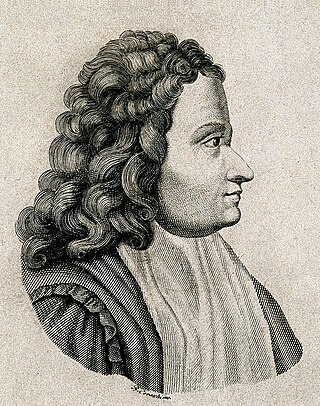 4
Antonio Maria Valsalva, was an Italian anatomist born in Imola. His research focused on the anatomy of the ears. He coined the term Eustachian tube and he described the aortic sinuses of Valsalva in...
4
Antonio Maria Valsalva, was an Italian anatomist born in Imola. His research focused on the anatomy of the ears. He coined the term Eustachian tube and he described the aortic sinuses of Valsalva in...
Luca Marenzio
 4
Luca Marenzio was an Italian composer and singer of the late Renaissance.
4
Luca Marenzio was an Italian composer and singer of the late Renaissance.
Giuseppe Martucci
 4
Giuseppe Martucci was an Italian composer, conductor, pianist and teacher. Sometimes called "the Italian Brahms", Martucci was notable among Italian composers of the era in that he dedicated his...
4
Giuseppe Martucci was an Italian composer, conductor, pianist and teacher. Sometimes called "the Italian Brahms", Martucci was notable among Italian composers of the era in that he dedicated his...
Argentina Altobelli
 4
Argentina Altobelli was an Italian trade unionist, the first woman to lead a trade union in the country.
4
Argentina Altobelli was an Italian trade unionist, the first woman to lead a trade union in the country.
Armando Spadini
 4
Armando Spadini was an Italian painter and one of the representatives of the so-called Scuola Romana.
4
Armando Spadini was an Italian painter and one of the representatives of the so-called Scuola Romana.
Anselmo Marabini
 4
Anselmo Marabini è stato un politico italiano.
4
Anselmo Marabini è stato un politico italiano.
Bruno Pontecorvo
 4
Bruno Pontecorvo was an Italian and Soviet nuclear physicist, an early assistant of Enrico Fermi and the author of numerous studies in high energy physics, especially on neutrinos. A convinced...
4
Bruno Pontecorvo was an Italian and Soviet nuclear physicist, an early assistant of Enrico Fermi and the author of numerous studies in high energy physics, especially on neutrinos. A convinced...
Jean Monnet
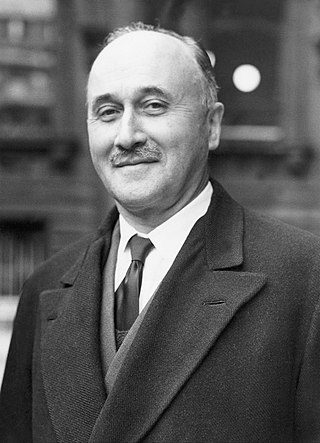 4
Jean Omer Marie Gabriel Monnet was a French civil servant, entrepreneur, diplomat, financier, administrator, and political visionary. An influential supporter of European unity, he is considered one...
4
Jean Omer Marie Gabriel Monnet was a French civil servant, entrepreneur, diplomat, financier, administrator, and political visionary. An influential supporter of European unity, he is considered one...
Leonardo Andervolti
 4
Leonardo Andervolti è stato un patriota italiano.
4
Leonardo Andervolti è stato un patriota italiano.
Émile Chanoux
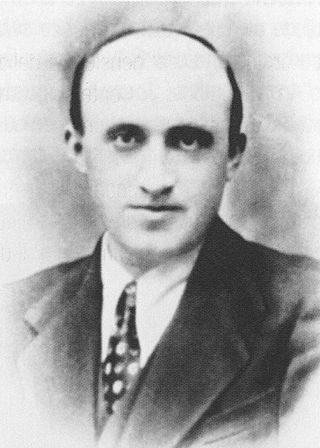 4
Émile Chanoux è stato un notaio e politico italiano, martire dell'Azione Cattolica nella Resistenza nella Valle d'Aosta, Croce d'argento al merito dell'Esercito della Repubblica Italiana.
4
Émile Chanoux è stato un notaio e politico italiano, martire dell'Azione Cattolica nella Resistenza nella Valle d'Aosta, Croce d'argento al merito dell'Esercito della Repubblica Italiana.
Andrea del Sarto
 4
Andrea del Sarto was an Italian painter from Florence, whose career flourished during the High Renaissance and early Mannerism. He was known as an outstanding fresco decorator, painter of...
4
Andrea del Sarto was an Italian painter from Florence, whose career flourished during the High Renaissance and early Mannerism. He was known as an outstanding fresco decorator, painter of...
Andrea Vochieri
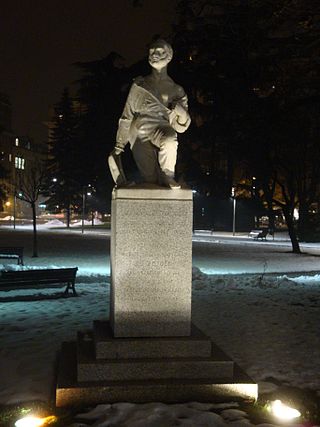 4
Andrea Vochieri è stato un patriota italiano.
4
Andrea Vochieri è stato un patriota italiano.
Francesco Filelfo
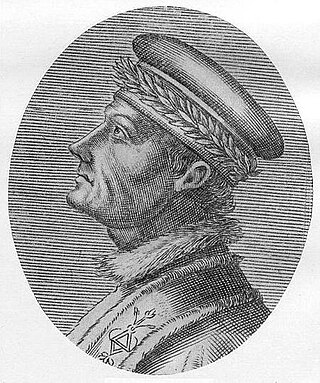 4
Francesco Filelfo was an Italian Renaissance humanist and author of the philosophic dialogue On Exile.
4
Francesco Filelfo was an Italian Renaissance humanist and author of the philosophic dialogue On Exile.
Diego Fabbri
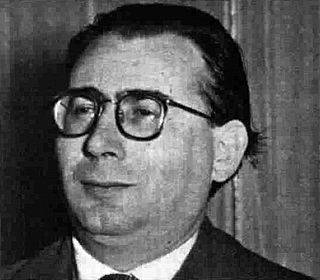 4
Diego Fabbri was an Italian playwright whose plays centered on religious (Catholic) themes.
4
Diego Fabbri was an Italian playwright whose plays centered on religious (Catholic) themes.
Corrado Gex
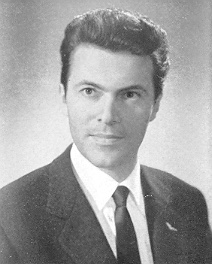 4
Corrado Gex è stato un politico e aviatore italiano. Già deputato regionale in Valle d'Aosta, fu deputato della IV legislatura della Repubblica Italiana.
4
Corrado Gex è stato un politico e aviatore italiano. Già deputato regionale in Valle d'Aosta, fu deputato della IV legislatura della Repubblica Italiana.
Antonio Bazzini
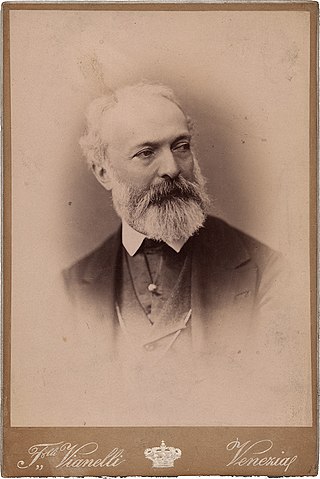 4
Antonio Bazzini was an Italian violinist, composer and teacher. As a composer, his most enduring work is his chamber music, which earned him a central place in the Italian instrumental renaissance of...
4
Antonio Bazzini was an Italian violinist, composer and teacher. As a composer, his most enduring work is his chamber music, which earned him a central place in the Italian instrumental renaissance of...
Braccio da Montone
 4
Braccio da Montone, born Andrea Fortebraccio, was an Italian condottiero.
4
Braccio da Montone, born Andrea Fortebraccio, was an Italian condottiero.
Emilio Morosini
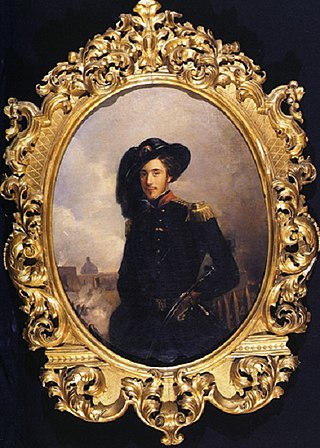 4
Emilio Morosini was an Italian patriot who participated in the Risorgimento.
4
Emilio Morosini was an Italian patriot who participated in the Risorgimento.
Beatrice d'Este
 4
Beatrice d'Este was Duchess of Bari and Milan by marriage to Ludovico Sforza. She was one of the most important personalities of the time and, despite her short life, she was a major player in...
4
Beatrice d'Este was Duchess of Bari and Milan by marriage to Ludovico Sforza. She was one of the most important personalities of the time and, despite her short life, she was a major player in...
Enrico Pessina
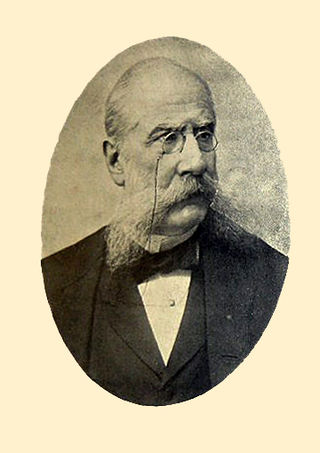 4
Enrico Pessina è stato un giurista, filosofo e politico italiano.
Fu senatore del Regno d'Italia nella XIII legislatura.
4
Enrico Pessina è stato un giurista, filosofo e politico italiano.
Fu senatore del Regno d'Italia nella XIII legislatura.
Gaetano Negri
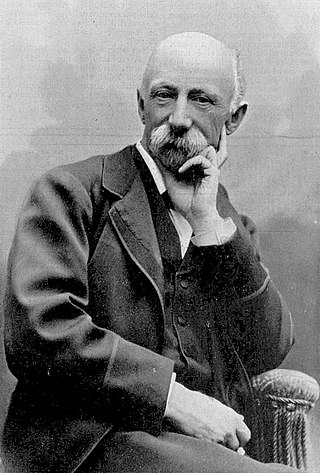 4
Gaetano Negri was an Italian geologist, writer and politician who served as the 3rd Mayor of Milan from 1884 to 1889. He also served in the Chamber of Deputies of the Kingdom of Italy.
4
Gaetano Negri was an Italian geologist, writer and politician who served as the 3rd Mayor of Milan from 1884 to 1889. He also served in the Chamber of Deputies of the Kingdom of Italy.
Antonio Genovesi
 4
Antonio Genovesi was an Italian writer on philosophy and political economy.
4
Antonio Genovesi was an Italian writer on philosophy and political economy.
Saint Quentin
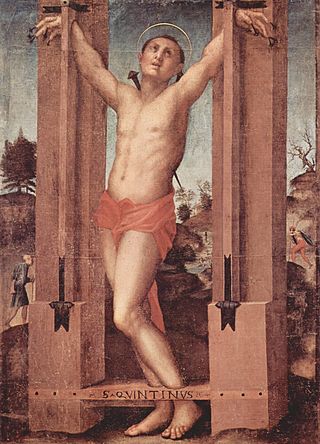 4
Quentin also known as Quentin of Amiens, was an early Christian saint.
4
Quentin also known as Quentin of Amiens, was an early Christian saint.
Oreste Salomone
 4
Oreste Salomone è stato un aviatore e militare italiano, che come pilota fu dapprima decorato di Medaglia d'argento al valor militare nella guerra di Libia, e poi di Medaglia d'oro a vivente nel...
4
Oreste Salomone è stato un aviatore e militare italiano, che come pilota fu dapprima decorato di Medaglia d'argento al valor militare nella guerra di Libia, e poi di Medaglia d'oro a vivente nel...
Lauro De Bosis
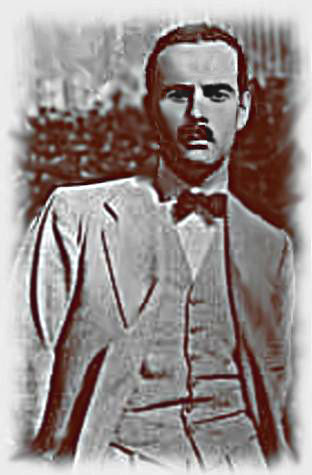 4
Lauro Adolfo De Bosis was an Italian poet, aviator, and anti-fascist.
4
Lauro Adolfo De Bosis was an Italian poet, aviator, and anti-fascist.
Francesca Morvillo
 4
Francesca Laura Morvillo was an Italian magistrate, wife of Giovanni Falcone and victim of the Sicilian Mafia. On May 23, 1992, she and her husband were killed in the Capaci bombing.
4
Francesca Laura Morvillo was an Italian magistrate, wife of Giovanni Falcone and victim of the Sicilian Mafia. On May 23, 1992, she and her husband were killed in the Capaci bombing.
Clemente Rebora
 4
Clemente Rebora was a poet from Milan, Italy. He received a degree in Italian literature in Milan. In the early 1900s he worked for the magazines La Voce, Rivista d’Italia and La Riviera Ligure.
4
Clemente Rebora was a poet from Milan, Italy. He received a degree in Italian literature in Milan. In the early 1900s he worked for the magazines La Voce, Rivista d’Italia and La Riviera Ligure.
Mammes of Caesarea
 4
Saint Mammes of Caesarea was a child-martyr of the 3rd century, who was martyred at Caesarea. His parents, Theodotus and Rufina, were also martyred.
4
Saint Mammes of Caesarea was a child-martyr of the 3rd century, who was martyred at Caesarea. His parents, Theodotus and Rufina, were also martyred.
Camilla Ravera
 4
Camilla Ravera was an Italian politician and the first female lifetime senator. She was also among the driving forces behind Italian feminism.
4
Camilla Ravera was an Italian politician and the first female lifetime senator. She was also among the driving forces behind Italian feminism.
Lando Conti
 4
Lando Conti was an Italian politician and past Mayor of Florence, Italy, who was assassinated by the terrorist group the Red Brigades.
4
Lando Conti was an Italian politician and past Mayor of Florence, Italy, who was assassinated by the terrorist group the Red Brigades.
Adone Zoli
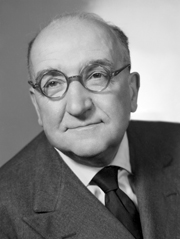 4
Adone Alvaro Ugo Natale Camillo Zoli was an Italian politician who served as the 35th prime minister of Italy from May 1957 to July 1958; he was the first senator to have ever held the office.
4
Adone Alvaro Ugo Natale Camillo Zoli was an Italian politician who served as the 35th prime minister of Italy from May 1957 to July 1958; he was the first senator to have ever held the office.
Pietro Zangheri
 4
Pietro Zangheri è stato un naturalista e scrittore italiano.
4
Pietro Zangheri è stato un naturalista e scrittore italiano.
Costante Girardengo
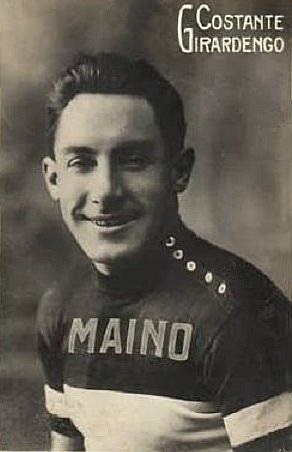 4
Costante Girardengo was an Italian professional road bicycle racer, considered by many to be one of the finest riders in the history of the sport. He was the first rider to be declared a...
4
Costante Girardengo was an Italian professional road bicycle racer, considered by many to be one of the finest riders in the history of the sport. He was the first rider to be declared a...
Tiberio Deciani
 4
Tiberio Deciani or Decianus (1509–1582) was an Italian jurist working in the tradition of Renaissance humanism.
4
Tiberio Deciani or Decianus (1509–1582) was an Italian jurist working in the tradition of Renaissance humanism.
Andrea Verga
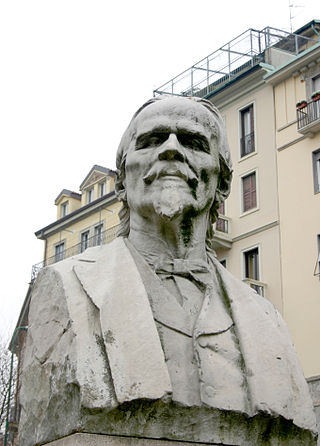 4
Andrea Verga was an Italian psychiatrist and neurologist. Verga is remembered for his pioneer work done in the study of the criminally insane, as well as his early research of acrophobia, a condition...
4
Andrea Verga was an Italian psychiatrist and neurologist. Verga is remembered for his pioneer work done in the study of the criminally insane, as well as his early research of acrophobia, a condition...
Leopoldo Nobili
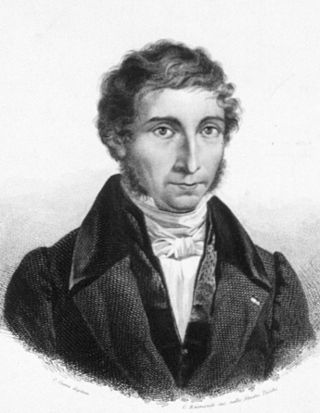 4
Leopoldo Nobili, born on 5 July 1784 in Trassilico (Toscana) and died on 22 August 1835 in Florence, was an Italian physicist who invented a number of instruments critical to investigating...
4
Leopoldo Nobili, born on 5 July 1784 in Trassilico (Toscana) and died on 22 August 1835 in Florence, was an Italian physicist who invented a number of instruments critical to investigating...
Cosimo Ridolfi
 4
Il marchese Cosimo Pietro Gaetano Gregorio Melchiorre Ridolfi è stato un agronomo e politico italiano.
4
Il marchese Cosimo Pietro Gaetano Gregorio Melchiorre Ridolfi è stato un agronomo e politico italiano.
Franco Sacchetti
 4
Franco Sacchetti, was an Italian poet and novelist.
4
Franco Sacchetti, was an Italian poet and novelist.
Luisa Sanfelice
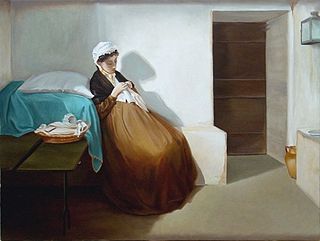 4
Luisa or Luigia Sanfelice (1764–1800) was an Italian aristocrat who was executed by Ferdinand I of the Two Sicilies because of her involvement with the French-backed Parthenopean Republic during the...
4
Luisa or Luigia Sanfelice (1764–1800) was an Italian aristocrat who was executed by Ferdinand I of the Two Sicilies because of her involvement with the French-backed Parthenopean Republic during the...
Paolo Uccello
 4
Paolo Uccello, born Paolo di Dono, was an Italian painter and mathematician who was notable for his pioneering work on visual perspective in art. In his book Lives of the Most Excellent Painters,...
4
Paolo Uccello, born Paolo di Dono, was an Italian painter and mathematician who was notable for his pioneering work on visual perspective in art. In his book Lives of the Most Excellent Painters,...
Leopold II, Holy Roman Emperor
 4
Leopold II was the 44th Holy Roman Emperor, King of Hungary, Croatia and Bohemia, and Archduke of Austria from 1790 to 1792, and Grand Duke of Tuscany from 1765 to 1790. He was a son of Empress Maria...
4
Leopold II was the 44th Holy Roman Emperor, King of Hungary, Croatia and Bohemia, and Archduke of Austria from 1790 to 1792, and Grand Duke of Tuscany from 1765 to 1790. He was a son of Empress Maria...
Adriano Cecioni
 4
Adriano Cecioni was an Italian artist, caricaturist, and critic associated with the Macchiaioli group.
4
Adriano Cecioni was an Italian artist, caricaturist, and critic associated with the Macchiaioli group.
Aligi Barducci
 4
Aligi Barducci was an Italian soldier and Resistance leader during World War II.
4
Aligi Barducci was an Italian soldier and Resistance leader during World War II.
Anna Maria Enriques Agnoletti
 4
Anna Maria Enriques Agnoletti was an Italian partisan, shot by the Nazis on 12 June 1944. For her actions in support of the Italian partisan movement she was honored post-mortem with the Gold Medal...
4
Anna Maria Enriques Agnoletti was an Italian partisan, shot by the Nazis on 12 June 1944. For her actions in support of the Italian partisan movement she was honored post-mortem with the Gold Medal...
Antonio Mordini
 4
Antonio Mordini was a longstanding Italian patriot and, after 1861, a member of the Parliament of the Kingdom of Italy. In 1869 he served as Minister of Public Works of the Kingdom of Italy, a member...
4
Antonio Mordini was a longstanding Italian patriot and, after 1861, a member of the Parliament of the Kingdom of Italy. In 1869 he served as Minister of Public Works of the Kingdom of Italy, a member...
Giulio Facibeni
 4
Giulio Facibeni è stato un presbitero e antifascista italiano, fondatore dell'Opera della Divina Provvidenza Madonnina del Grappa, annoverato tra i giusti tra le nazioni per la sua opera a favore...
4
Giulio Facibeni è stato un presbitero e antifascista italiano, fondatore dell'Opera della Divina Provvidenza Madonnina del Grappa, annoverato tra i giusti tra le nazioni per la sua opera a favore...
Leon Pancaldo
 4
Leon Pancaldo, also called Leone Pancaldo was a Genoese explorer.
4
Leon Pancaldo, also called Leone Pancaldo was a Genoese explorer.
Lorenzo de' Medici
 4
Lorenzo di Piero de' Medici, known as Lorenzo the Magnificent, was an Italian statesman, the de facto ruler of the Florentine Republic, and the most powerful patron of Renaissance culture in Italy....
4
Lorenzo di Piero de' Medici, known as Lorenzo the Magnificent, was an Italian statesman, the de facto ruler of the Florentine Republic, and the most powerful patron of Renaissance culture in Italy....
Muzio Clementi
 4
Muzio Filippo Vincenzo Francesco Saverio Clementi was an Italian-British composer, virtuoso pianist, pedagogue, conductor, music publisher, editor, and piano manufacturer, who was mostly active in...
4
Muzio Filippo Vincenzo Francesco Saverio Clementi was an Italian-British composer, virtuoso pianist, pedagogue, conductor, music publisher, editor, and piano manufacturer, who was mostly active in...
Scipio Sighele
 4
Scipio Sighele è stato uno psicologo, sociologo e criminologo italiano.
4
Scipio Sighele è stato uno psicologo, sociologo e criminologo italiano.
Vincenzo Salvagnoli
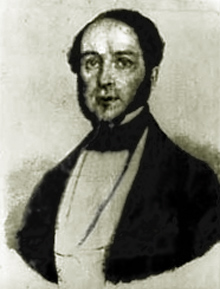 4
Vincenzo Salvagnoli è stato un giurista e politico italiano.
4
Vincenzo Salvagnoli è stato un giurista e politico italiano.
Giovanni Lorenzoni
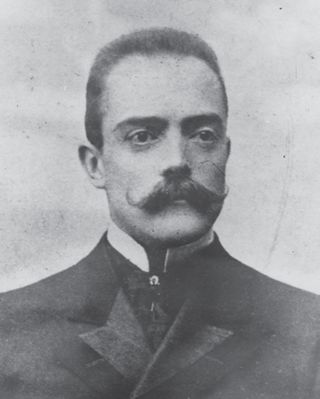 4
Giovanni Lorenzoni è stato un economista e sociologo italiano.
4
Giovanni Lorenzoni è stato un economista e sociologo italiano.
Artemisia Gentileschi
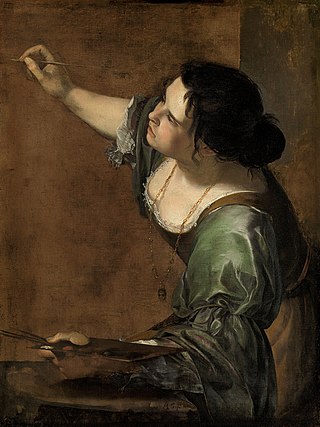 4
Artemisia Lomi or Artemisia Gentileschi was an Italian Baroque painter. Gentileschi is considered among the most accomplished 17th-century artists, initially working in the style of Caravaggio. She...
4
Artemisia Lomi or Artemisia Gentileschi was an Italian Baroque painter. Gentileschi is considered among the most accomplished 17th-century artists, initially working in the style of Caravaggio. She...
Felice Matteucci
 4
Felice Matteucci was an Italian hydraulic engineer who co-invented an internal combustion engine with Eugenio Barsanti. Their patent request was granted in London on June 12, 1854, and published in...
4
Felice Matteucci was an Italian hydraulic engineer who co-invented an internal combustion engine with Eugenio Barsanti. Their patent request was granted in London on June 12, 1854, and published in...
Theodelinda
 4
Theodelinda also spelled Theudelinde, was a queen of the Lombards by marriage to two consecutive Lombard rulers, Autari and then Agilulf, and regent of Lombardia during the minority of her son...
4
Theodelinda also spelled Theudelinde, was a queen of the Lombards by marriage to two consecutive Lombard rulers, Autari and then Agilulf, and regent of Lombardia during the minority of her son...
Rita Levi-Montalcini
 4
Rita Levi-Montalcini was an Italian neurobiologist. She was awarded the 1986 Nobel Prize in Physiology or Medicine jointly with colleague Stanley Cohen for the discovery of nerve growth factor (NGF).
4
Rita Levi-Montalcini was an Italian neurobiologist. She was awarded the 1986 Nobel Prize in Physiology or Medicine jointly with colleague Stanley Cohen for the discovery of nerve growth factor (NGF).
Lodovico Pavoni
 4
Lodovico Pavoni was an Italian Roman Catholic priest who administered in Brescia where he lived. He paid close attention to the needs of males and was concerned with their education. He was to...
4
Lodovico Pavoni was an Italian Roman Catholic priest who administered in Brescia where he lived. He paid close attention to the needs of males and was concerned with their education. He was to...
Giuseppe Grassi (politician)
 4
Giuseppe Grassi was a 20th-century Italian politician. Member of the Italian Liberal Party, he served as Minister of Justice in Alcide De Gasperi's fourth and fifth cabinets between 1947 and 1950. He...
4
Giuseppe Grassi was a 20th-century Italian politician. Member of the Italian Liberal Party, he served as Minister of Justice in Alcide De Gasperi's fourth and fifth cabinets between 1947 and 1950. He...
Giovanni Ancillotto
 4
Lieutenant Giovanni 'Giannino' Ancillotto was an Italian World War I flying ace credited with 11 confirmed aerial victories. Rather unusually, he served solely with aviation while he was in the...
4
Lieutenant Giovanni 'Giannino' Ancillotto was an Italian World War I flying ace credited with 11 confirmed aerial victories. Rather unusually, he served solely with aviation while he was in the...
Angelo Battelli
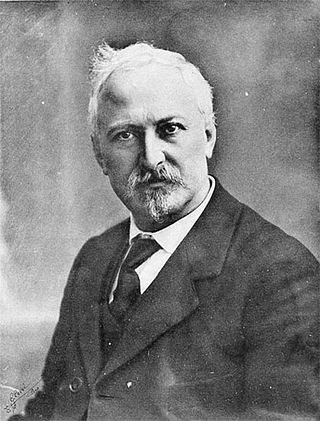 4
Angelo Battelli (28 March 1862 – 11 December 1916) was an Italian scientist, notable for having measured temperatures and heats of fusion of non-metallic substances, metallic conductivities and...
4
Angelo Battelli (28 March 1862 – 11 December 1916) was an Italian scientist, notable for having measured temperatures and heats of fusion of non-metallic substances, metallic conductivities and...
Giorgio Giulini
 4
Giorgio Giulini è stato uno storico e storiografo italiano.
4
Giorgio Giulini è stato uno storico e storiografo italiano.
Carlo Carrà
 4
Carlo Carrà was an Italian painter and a leading figure of the Futurist movement that flourished in Italy during the beginning of the 20th century. In addition to his many paintings, he wrote a...
4
Carlo Carrà was an Italian painter and a leading figure of the Futurist movement that flourished in Italy during the beginning of the 20th century. In addition to his many paintings, he wrote a...
Luigi Pastro
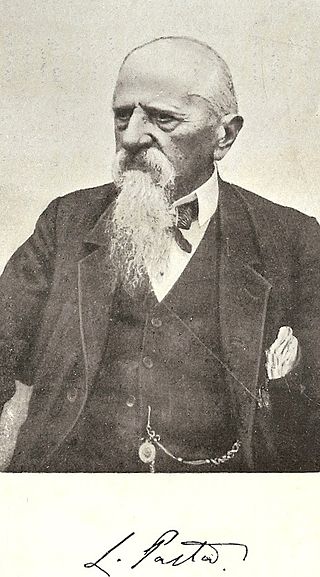 4
Luigi Pastro è stato un patriota e politico italiano.
4
Luigi Pastro è stato un patriota e politico italiano.
Gaetano Casati
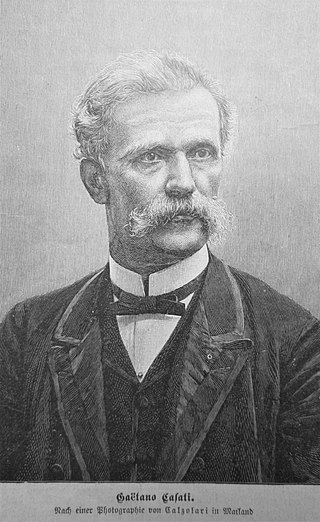 4
Gaetano Casati was an Italian explorer of Africa, born in Lesmo, at that time in the Austrian Empire.
4
Gaetano Casati was an Italian explorer of Africa, born in Lesmo, at that time in the Austrian Empire.
Vittorio Podrecca
 4
Vittorio Podrecca è stato un impresario e regista italiano del teatro delle marionette.
4
Vittorio Podrecca è stato un impresario e regista italiano del teatro delle marionette.
Pio Donati
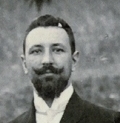 4
Pio Donati è stato un politico e avvocato italiano.
4
Pio Donati è stato un politico e avvocato italiano.
Antonio Banfi
 4
Antonio Banfi was an Italian philosopher and senator. He is also noted for founding the Italian philosophical school called critical rationalism.
4
Antonio Banfi was an Italian philosopher and senator. He is also noted for founding the Italian philosophical school called critical rationalism.
Matteo Bandello
 4
Matteo Bandello was an Italian writer, soldier, Dominican friar and bishop, known mostly for his novellas. His collection of 214 novellas made him the most popular short-story writer of his day.
4
Matteo Bandello was an Italian writer, soldier, Dominican friar and bishop, known mostly for his novellas. His collection of 214 novellas made him the most popular short-story writer of his day.
Ferdinando Galiani
 4
Ferdinando Galiani was an Italian economist, a leading Italian figure of the Enlightenment. Friedrich Nietzsche referred to him as "a most fastidious and refined intelligence" and "the most profound,...
4
Ferdinando Galiani was an Italian economist, a leading Italian figure of the Enlightenment. Friedrich Nietzsche referred to him as "a most fastidious and refined intelligence" and "the most profound,...
Alberto Nota
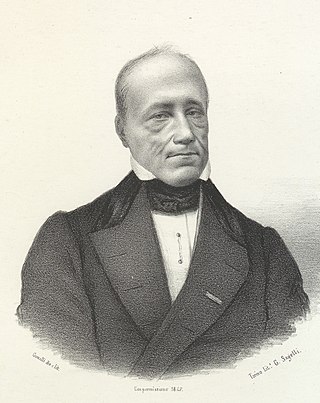 4
Alberto Nota è stato un commediografo, bibliotecario e magistrato italiano.
4
Alberto Nota è stato un commediografo, bibliotecario e magistrato italiano.
Antonio Abetti
 4
Antonio Abetti was an Italian astronomer.
4
Antonio Abetti was an Italian astronomer.
Carlo Bon Compagni di Mombello
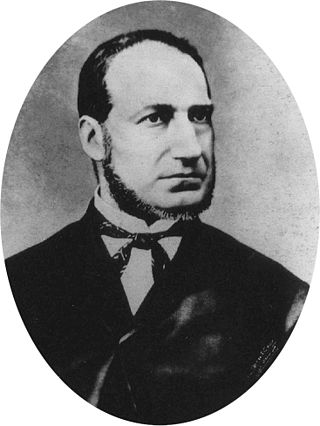 4
Carlo Bon Compagni, Count of Mombello was an Italian judge, educator and politician.
4
Carlo Bon Compagni, Count of Mombello was an Italian judge, educator and politician.
Michele Lessona
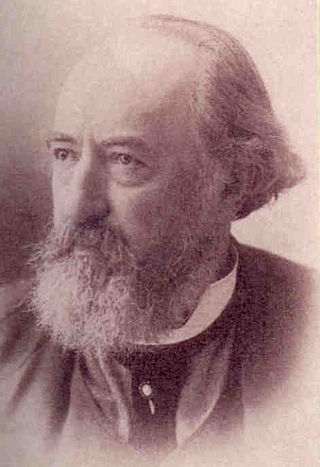 4
Michele Lessona was an Italian zoologist.
4
Michele Lessona was an Italian zoologist.
Carlo Amoretti
 4
Carlo Amoretti was an ecclesiastic, scholar, writer, and scientist.
He entered the Augustinian order in 1757. To further his studies, he went to Pavia and Parma where he also taught ecclesiastical...
4
Carlo Amoretti was an ecclesiastic, scholar, writer, and scientist.
He entered the Augustinian order in 1757. To further his studies, he went to Pavia and Parma where he also taught ecclesiastical...
Giovanni Battista Ramusio
 4
Giovanni Battista Ramusio was an Italian geographer and travel writer.
4
Giovanni Battista Ramusio was an Italian geographer and travel writer.
Ascanio Sobrero
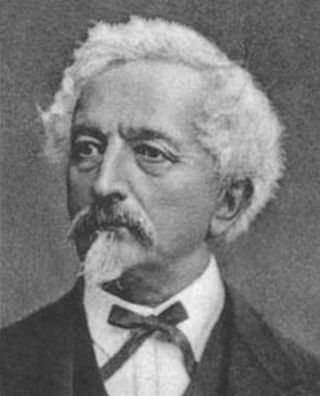 4
Ascanio Sobrero was an Italian chemist, born in Casale Monferrato. He studied under Théophile-Jules Pelouze at the University of Turin, who had worked with the explosive material guncotton.
4
Ascanio Sobrero was an Italian chemist, born in Casale Monferrato. He studied under Théophile-Jules Pelouze at the University of Turin, who had worked with the explosive material guncotton.
Cesare Pascarella
 4
Cesare Pascarella, was an Italian dialect poet and a painter. He was appointed to the Royal Academy of Italy in 1930.
4
Cesare Pascarella, was an Italian dialect poet and a painter. He was appointed to the Royal Academy of Italy in 1930.
Gino Vendemini
 4
Gino Vendemini, all'anagrafe Biagio Vendemini, è stato un poeta e politico italiano.
4
Gino Vendemini, all'anagrafe Biagio Vendemini, è stato un poeta e politico italiano.
Giuseppe Piazzi
 4
Giuseppe Piazzi was an Italian Catholic priest of the Theatine order, mathematician, and astronomer. He established an observatory at Palermo, now the Osservatorio Astronomico di Palermo – Giuseppe...
4
Giuseppe Piazzi was an Italian Catholic priest of the Theatine order, mathematician, and astronomer. He established an observatory at Palermo, now the Osservatorio Astronomico di Palermo – Giuseppe...
Paolo Giacometti
 4
Paolo Giacometti (1816–1882) was an Italian dramatist born at Novi Ligure. He was educated in law at Genoa, but at the age of twenty had some success with his play Rosilda and then devoted himself to...
4
Paolo Giacometti (1816–1882) was an Italian dramatist born at Novi Ligure. He was educated in law at Genoa, but at the age of twenty had some success with his play Rosilda and then devoted himself to...
Tommaso Gulli
 4
Tommaso Gulli è stato un militare italiano, decorato di medaglia d'oro al valor militare.
4
Tommaso Gulli è stato un militare italiano, decorato di medaglia d'oro al valor militare.
Vincenzo Coronelli
 4
Vincenzo Maria Coronelli was an Italian Franciscan friar, cosmographer, cartographer, publisher, and encyclopedist known in particular for his atlases and globes. He spent most of his life in Venice.
4
Vincenzo Maria Coronelli was an Italian Franciscan friar, cosmographer, cartographer, publisher, and encyclopedist known in particular for his atlases and globes. He spent most of his life in Venice.
Benigno Zaccagnini
 4
Benigno Zaccagnini was an Italian politician and physician.
4
Benigno Zaccagnini was an Italian politician and physician.
Carlo Dossi
 4
Carlo Alberto Pisani Dossi was an Italian writer, politician and diplomat. He belonged to the Scapigliati.
4
Carlo Alberto Pisani Dossi was an Italian writer, politician and diplomat. He belonged to the Scapigliati.
Vincenzo Muccioli
 4
Vincenzo Muccioli è stato un imprenditore italiano, fondatore della Comunità di San Patrignano, dedicata al recupero e alla riabilitazione dei tossicodipendenti.
4
Vincenzo Muccioli è stato un imprenditore italiano, fondatore della Comunità di San Patrignano, dedicata al recupero e alla riabilitazione dei tossicodipendenti.
Pietro Cossa
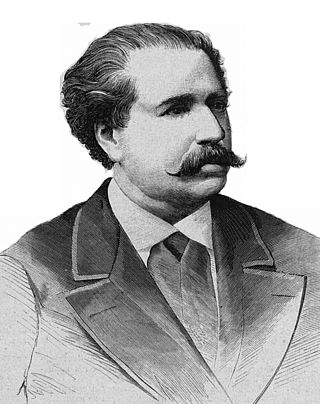 4
Pietro Cossa was an Italian dramatist.
4
Pietro Cossa was an Italian dramatist.
Giuseppe Avezzana
 4
Giuseppe Avezzana was an Italian soldier and businessman. He fought in wars in Europe and the Americas.
4
Giuseppe Avezzana was an Italian soldier and businessman. He fought in wars in Europe and the Americas.
Franchinus Gaffurius
 4
Franchinus Gaffurius was an Italian music theorist and composer of the Renaissance.
4
Franchinus Gaffurius was an Italian music theorist and composer of the Renaissance.
Giuseppe Giulietti (politician)
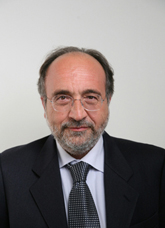 4
Giuseppe Giulietti is an Italian journalist, trade unionist and politician.
4
Giuseppe Giulietti is an Italian journalist, trade unionist and politician.
Cornelio Nepote
 4
Cornelio Nepóte è stato uno storico e biografo romano.
4
Cornelio Nepóte è stato uno storico e biografo romano.
Domenico Fontana
 4
Domenico Fontana was an Italian architect of the late Renaissance, born in today's Ticino. He worked primarily in Italy, at Rome and Naples.
4
Domenico Fontana was an Italian architect of the late Renaissance, born in today's Ticino. He worked primarily in Italy, at Rome and Naples.
Valentino Mazzola
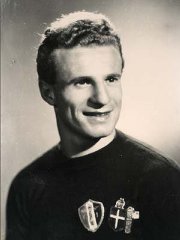 4
Valentino Mazzola was an Italian footballer who played as an attacking midfielder or forward.
4
Valentino Mazzola was an Italian footballer who played as an attacking midfielder or forward.
Nicolao Sottile
 4
Nicolao Sottile è stato un presbitero e scrittore italiano.
4
Nicolao Sottile è stato un presbitero e scrittore italiano.
Henry Dunant
 4
Henry Dunant, also known as Henri Dunant, was a Swiss humanitarian, businessman, social activist, and co-founder of the Red Cross. His humanitarian efforts won him the first Nobel Peace Prize in 1901.
4
Henry Dunant, also known as Henri Dunant, was a Swiss humanitarian, businessman, social activist, and co-founder of the Red Cross. His humanitarian efforts won him the first Nobel Peace Prize in 1901.
Salvatore Cottoni
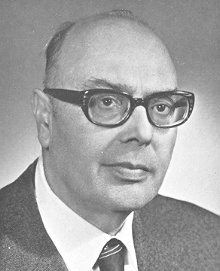 4
Salvatore Cottoni è stato un politico e avvocato italiano.
4
Salvatore Cottoni è stato un politico e avvocato italiano.
Mario Allegretti
 4
Mario Allegretti was an Italian soldier and Resistance leader during World War II.
4
Mario Allegretti was an Italian soldier and Resistance leader during World War II.
Dario Niccodemi
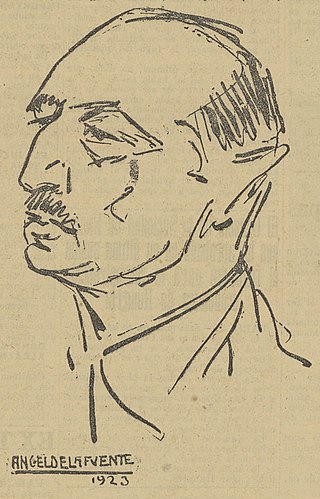 4
Dario Niccodemi was an Italian novelist and a playwright who was born in Italy.
4
Dario Niccodemi was an Italian novelist and a playwright who was born in Italy.
Bellinus of Padua
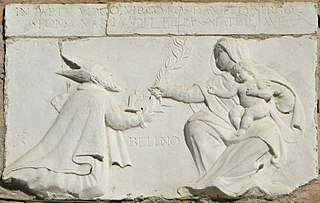 4
Bellino Bertaldo was an Italian Roman Catholic prelate who served as the Bishop of Padua from 1128 until his murder. Pope Eugene IV later canonized Bellino as a saint.
4
Bellino Bertaldo was an Italian Roman Catholic prelate who served as the Bishop of Padua from 1128 until his murder. Pope Eugene IV later canonized Bellino as a saint.
Lorenzo Delleani
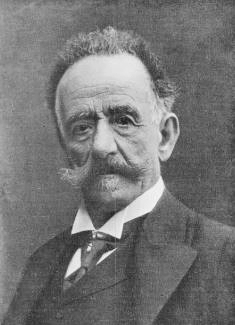 4
Lorenzo Delleani was an Italian painter, known primarily for landscapes and genre scenes.
4
Lorenzo Delleani was an Italian painter, known primarily for landscapes and genre scenes.
Giuseppe Pagano
 4
Giuseppe Pagano was an Italian architect, notable for his involvement in the movement of rationalist architecture in Italy up to the end of the Second World War. He designed exhibitions, furniture...
4
Giuseppe Pagano was an Italian architect, notable for his involvement in the movement of rationalist architecture in Italy up to the end of the Second World War. He designed exhibitions, furniture...
Ancus Marcius
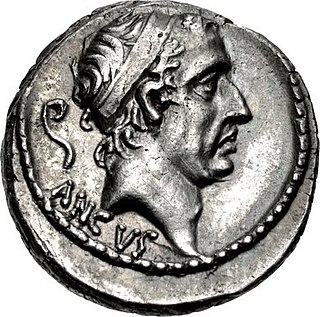 4
Ancus Marcius was the legendary fourth king of Rome, who traditionally reigned 24 years. Upon the death of the previous king, Tullus Hostilius, the Roman Senate appointed an interrex, who in turn...
4
Ancus Marcius was the legendary fourth king of Rome, who traditionally reigned 24 years. Upon the death of the previous king, Tullus Hostilius, the Roman Senate appointed an interrex, who in turn...
Salvator Angelo De Castro
 4
Salvator Angelo De Castro è stato un politico italiano.
4
Salvator Angelo De Castro è stato un politico italiano.
Ottone Bacaredda
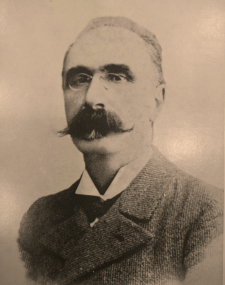 4
Ottone Bacaredda è stato un giurista, scrittore e politico italiano.
4
Ottone Bacaredda è stato un giurista, scrittore e politico italiano.
Sergio Atzeni
 4
Sergio Atzeni was an Italian writer.
4
Sergio Atzeni was an Italian writer.
Federico Borromeo
 4
Federico Borromeo was an Italian cardinal and Archbishop of Milan, a prominent figure of Counter-Reformation in Italy. Federico was a hero of the plague of 1630, described in Alessandro Manzoni's...
4
Federico Borromeo was an Italian cardinal and Archbishop of Milan, a prominent figure of Counter-Reformation in Italy. Federico was a hero of the plague of 1630, described in Alessandro Manzoni's...
Giovanni Cena
 4
Giovanni Cena è stato un poeta e scrittore italiano.
4
Giovanni Cena è stato un poeta e scrittore italiano.
Alberto Picco di Ulrico
 4
Alberto Picco è stato un militare e calciatore italiano.
Sottotenente di complemento del corpo degli Alpini, cadde durante la battaglia per la conquista del Monte Nero.
4
Alberto Picco è stato un militare e calciatore italiano.
Sottotenente di complemento del corpo degli Alpini, cadde durante la battaglia per la conquista del Monte Nero.
Dalmazio Birago
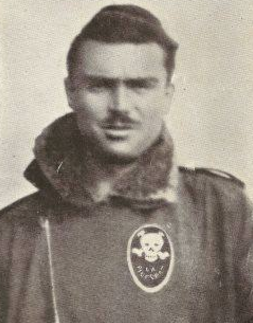 4
Dalmazio Birago è stato un aviatore italiano, decorato di Medaglia d'oro al valor militare alla memoria nel corso della guerra d'Etiopia.
4
Dalmazio Birago è stato un aviatore italiano, decorato di Medaglia d'oro al valor militare alla memoria nel corso della guerra d'Etiopia.
Francesco Dall'Ongaro
 4
Francesco Dall'Ongaro was an Italian writer, poet and dramatist.
4
Francesco Dall'Ongaro was an Italian writer, poet and dramatist.
Giuseppe Pisanelli
 4
Giuseppe Pisanelli è stato un giurista e politico italiano.
4
Giuseppe Pisanelli è stato un giurista e politico italiano.
Enrico Millo
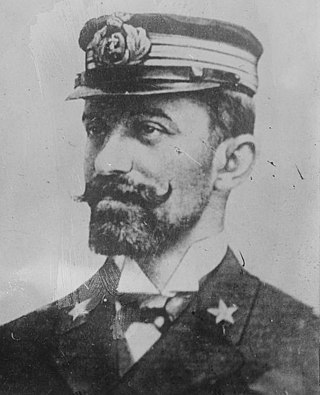 4
Enrico Millo was an Italian admiral and politician. As a naval commander, he led a raid against the Ottoman Navy in the Dardanelles in 1912.
4
Enrico Millo was an Italian admiral and politician. As a naval commander, he led a raid against the Ottoman Navy in the Dardanelles in 1912.
Agostino Barbarigo
 4
Agostino Barbarigo was Doge of Venice from 1486 until his death in 1501.
4
Agostino Barbarigo was Doge of Venice from 1486 until his death in 1501.
Prince Amedeo, Duke of Aosta (1943–2021)
 4
Prince Amedeo of Savoy-Aosta, 5th Duke of Aosta was a claimant to the headship of the House of Savoy, the family which ruled Italy from 1861 to 1946. Until 7 July 2006, Amedeo was styled Duke of...
4
Prince Amedeo of Savoy-Aosta, 5th Duke of Aosta was a claimant to the headship of the House of Savoy, the family which ruled Italy from 1861 to 1946. Until 7 July 2006, Amedeo was styled Duke of...
Giovanni Battista Marzuttini
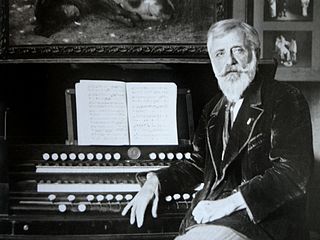 4
Giovanni Battista Marzuttini è stato un pittore e musicista italiano, il cui ingegno poliedrico lo portò a realizzare nel 1910 un proprio monoplano, che sfortunatamente non riuscì mai a volare.
4
Giovanni Battista Marzuttini è stato un pittore e musicista italiano, il cui ingegno poliedrico lo portò a realizzare nel 1910 un proprio monoplano, che sfortunatamente non riuscì mai a volare.
Giovanni Ferrari
 4
Giovanni Ferrari was an Italian footballer who played as an attacking midfielder/inside forward on the left. He is regarded as one of the best players of his generation, having won the Serie A 8...
4
Giovanni Ferrari was an Italian footballer who played as an attacking midfielder/inside forward on the left. He is regarded as one of the best players of his generation, having won the Serie A 8...
Guarino Guarini
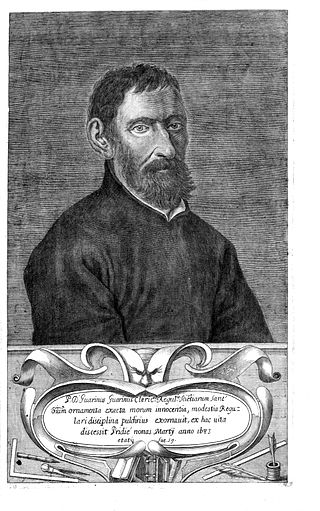 4
Camillo Guarino Guarini was an Italian architect of the Piedmontese Baroque, active in Turin as well as Sicily, France and Portugal. He was a Theatine priest, mathematician, and writer. His work...
4
Camillo Guarino Guarini was an Italian architect of the Piedmontese Baroque, active in Turin as well as Sicily, France and Portugal. He was a Theatine priest, mathematician, and writer. His work...
Fabio Asquini
 4
Count Fabio Asquini (1726–1818) was an Italian rural economist and agronomist who did much to promote silk culture in Italy.
4
Count Fabio Asquini (1726–1818) was an Italian rural economist and agronomist who did much to promote silk culture in Italy.
Marcello Mastroianni
 4
Marcello Vincenzo Domenico Mastroianni was an Italian film actor, regarded as one of his country's most iconic male performers of the 20th century. He played leading roles for many of Italy's top...
4
Marcello Vincenzo Domenico Mastroianni was an Italian film actor, regarded as one of his country's most iconic male performers of the 20th century. He played leading roles for many of Italy's top...
Felice Maritano
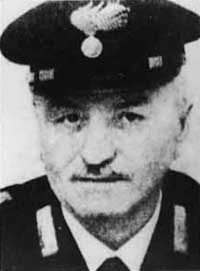 4
Felice Maritano è stato un carabiniere italiano ucciso in un conflitto a fuoco da uno dei capi storici delle Brigate Rosse, Roberto Ognibene durante una operazione riguardante il ritrovamento dei...
4
Felice Maritano è stato un carabiniere italiano ucciso in un conflitto a fuoco da uno dei capi storici delle Brigate Rosse, Roberto Ognibene durante una operazione riguardante il ritrovamento dei...
Silvio Benco
 4
Enea Silvio Benco è stato uno scrittore, giornalista e critico letterario italiano.
4
Enea Silvio Benco è stato uno scrittore, giornalista e critico letterario italiano.
Livia
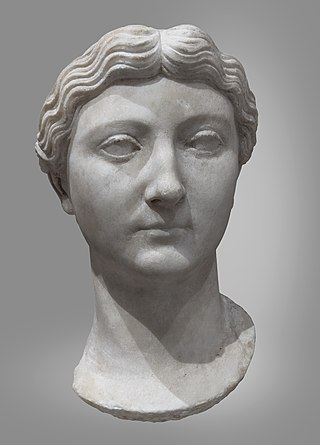 4
Livia Drusilla was Roman empress from 27 BC to AD 14 as the wife of emperor Augustus. She was known as Julia Augusta after her formal adoption into the Julian family in AD 14.
4
Livia Drusilla was Roman empress from 27 BC to AD 14 as the wife of emperor Augustus. She was known as Julia Augusta after her formal adoption into the Julian family in AD 14.
Odorico Politi
 4
Odorico Politi was an Italian painter.
4
Odorico Politi was an Italian painter.
Luigi Scrosoppi
 4
Luigi Scrosoppi was an Italian priest of the Catholic Church who founded the Sisters of Providence of Saint Cajetan of Thiene. He was canonized in 2001.
4
Luigi Scrosoppi was an Italian priest of the Catholic Church who founded the Sisters of Providence of Saint Cajetan of Thiene. He was canonized in 2001.
Bindo Chiurlo
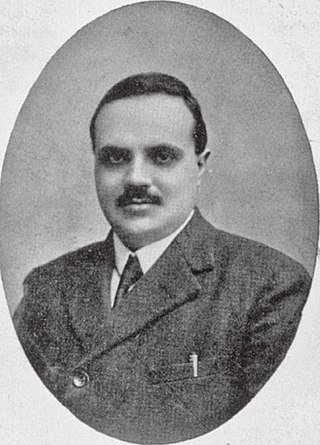 4
Bindo Chiurlo è stato un critico letterario e poeta italiano.
4
Bindo Chiurlo è stato un critico letterario e poeta italiano.
Pietro Blaserna
 4
Pietro Blaserna è stato un fisico e politico italiano.
4
Pietro Blaserna è stato un fisico e politico italiano.
Luigi Chiozza
 4
Luigi Chiozza è stato un chimico e imprenditore italiano.
4
Luigi Chiozza è stato un chimico e imprenditore italiano.
Gino Severini
 4
Gino Severini was an Italian painter and a leading member of the Futurist movement. For much of his life he divided his time between Paris and Rome. He was associated with neo-classicism and the...
4
Gino Severini was an Italian painter and a leading member of the Futurist movement. For much of his life he divided his time between Paris and Rome. He was associated with neo-classicism and the...
Cesare Cabras
 4
Cesare Cabras è stato un pittore italiano.
4
Cesare Cabras è stato un pittore italiano.
Olinto Marella
 4
Olinto Marella was an Italian Roman Catholic priest who exercised his pastoral service in the Archdiocese of Bologna. Marella was a classmate of Pope John XXIII in Rome and the pope held him in high...
4
Olinto Marella was an Italian Roman Catholic priest who exercised his pastoral service in the Archdiocese of Bologna. Marella was a classmate of Pope John XXIII in Rome and the pope held him in high...
Andreas Vesalius
 4
Andries van Wezel, latinised as Andreas Vesalius, was an anatomist and physician who wrote De Humani Corporis Fabrica Libri Septem, what is considered to be one of the most influential books on human...
4
Andries van Wezel, latinised as Andreas Vesalius, was an anatomist and physician who wrote De Humani Corporis Fabrica Libri Septem, what is considered to be one of the most influential books on human...
Angela Merici
 4
Angela Merici was an Italian Catholic religious educator who founded the Company of St. Ursula in 1535 in Brescia, in which women dedicated their lives to the service of the church through the...
4
Angela Merici was an Italian Catholic religious educator who founded the Company of St. Ursula in 1535 in Brescia, in which women dedicated their lives to the service of the church through the...
Nicostrato Castellini
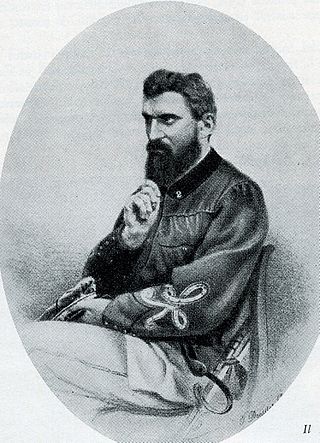 4
Nicostrato Castellini è stato un patriota italiano.
4
Nicostrato Castellini è stato un patriota italiano.
Luigi Calabresi
 4
Luigi Calabresi was an Italian Polizia di Stato officer in Milan. Responsible for investigating far-left political movements, Calabresi was assassinated in 1972 by members of Lotta Continua, who...
4
Luigi Calabresi was an Italian Polizia di Stato officer in Milan. Responsible for investigating far-left political movements, Calabresi was assassinated in 1972 by members of Lotta Continua, who...
Francis de Sales
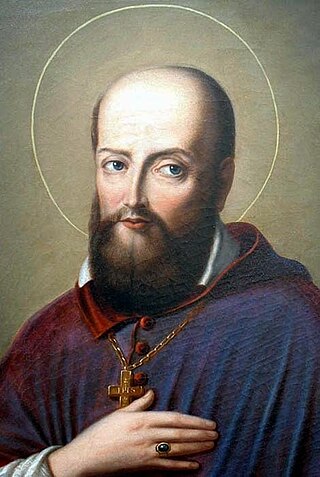 4
Francis de Sales, C.O., O.M. was a Savoyard Catholic prelate who served as Bishop of Geneva and is a saint of the Catholic Church. He became noted for his deep faith and his gentle approach to the...
4
Francis de Sales, C.O., O.M. was a Savoyard Catholic prelate who served as Bishop of Geneva and is a saint of the Catholic Church. He became noted for his deep faith and his gentle approach to the...
Hyacinth of Caesarea
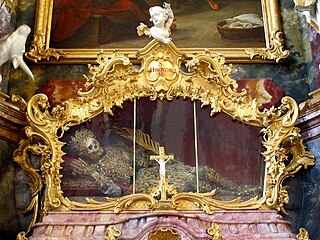 4
Hyacinth was a young Christian living at the start of the second century, who is honored as a martyr and a saint by both the Eastern Orthodox Church and the Roman Catholic Church. Hyacinth is...
4
Hyacinth was a young Christian living at the start of the second century, who is honored as a martyr and a saint by both the Eastern Orthodox Church and the Roman Catholic Church. Hyacinth is...
Luigi Russo
 4
Luigi Russo was an Italian Fascist politician and civil servant, who served as Undersecretary to the Presidency of the Council of the Kingdom of Italy from 1939 to 1943. He was also Chief of Staff of...
4
Luigi Russo was an Italian Fascist politician and civil servant, who served as Undersecretary to the Presidency of the Council of the Kingdom of Italy from 1939 to 1943. He was also Chief of Staff of...
Francesco I da Carrara
 4
Francesco I da Carrara, called il Vecchio, was Lord of Padua from 1350 to 1388.
4
Francesco I da Carrara, called il Vecchio, was Lord of Padua from 1350 to 1388.
Max Leopold Wagner
 4
Max Leopold Wagner was a German philologist and ethnologist, particularly known for his studies on the Sardinian language. He also carried out pioneering research on the Spanish language in Hispanic...
4
Max Leopold Wagner was a German philologist and ethnologist, particularly known for his studies on the Sardinian language. He also carried out pioneering research on the Spanish language in Hispanic...
Michelangelo Pira
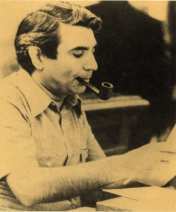 4
Michelangelo Pira, più conosciuto in sardo come Mialinu Pira, è stato un giornalista, antropologo e scrittore italiano, è stato uno studioso della lingua sarda e dei suoi problemi.
4
Michelangelo Pira, più conosciuto in sardo come Mialinu Pira, è stato un giornalista, antropologo e scrittore italiano, è stato uno studioso della lingua sarda e dei suoi problemi.
Salvatore Satta
 4
Salvatore Satta was an Italian jurist and writer.
He is famous for the novel The Day of Judgment (1975), and for several important studies on civil law.
4
Salvatore Satta was an Italian jurist and writer.
He is famous for the novel The Day of Judgment (1975), and for several important studies on civil law.
Francesco Alziator
 4
Francesco Alziator was an Italian writer and journalist. He was concerned for much of his career with the preservation of traditional Sardinian culture, mainly of is hometown Cagliari.
4
Francesco Alziator was an Italian writer and journalist. He was concerned for much of his career with the preservation of traditional Sardinian culture, mainly of is hometown Cagliari.
Ugo Tognazzi
 4
Ugo Tognazzi was an Italian actor, director, and screenwriter.
4
Ugo Tognazzi was an Italian actor, director, and screenwriter.
Tamburino sardo
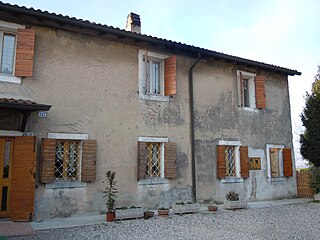 4
Il tamburino sardo è un personaggio del Risorgimento italiano raccontato in forma romanzata da Edmondo De Amicis nel libro Cuore, e di cui, a tutt'oggi, non si conosce la reale identità, né se sia...
4
Il tamburino sardo è un personaggio del Risorgimento italiano raccontato in forma romanzata da Edmondo De Amicis nel libro Cuore, e di cui, a tutt'oggi, non si conosce la reale identità, né se sia...
Giacomo Balla
 4
Giacomo Balla was an Italian painter, art teacher and poet best known as a key proponent of Futurism. In his paintings, he depicted light, movement and speed. He was concerned with expressing...
4
Giacomo Balla was an Italian painter, art teacher and poet best known as a key proponent of Futurism. In his paintings, he depicted light, movement and speed. He was concerned with expressing...
James Cook
 4
Captain James Cook was a British explorer, cartographer and naval officer famous for his three voyages between 1768 and 1779 in the Pacific Ocean and to New Zealand and Australia in particular. He...
4
Captain James Cook was a British explorer, cartographer and naval officer famous for his three voyages between 1768 and 1779 in the Pacific Ocean and to New Zealand and Australia in particular. He...
Giuseppe Berto
 4
Giuseppe Berto was an Italian writer and screenwriter. He is mostly known for his novels Il cielo è rosso and Il male oscuro.
4
Giuseppe Berto was an Italian writer and screenwriter. He is mostly known for his novels Il cielo è rosso and Il male oscuro.
Pompeo Marino Molmenti
 4
Pompeo Marino Molmenti was an Italian painter.
4
Pompeo Marino Molmenti was an Italian painter.
Marie-José of Belgium
 4
Marie-José of Belgium was the last Queen of Italy. Her 34-day tenure as queen consort earned her the nickname "the May Queen".
4
Marie-José of Belgium was the last Queen of Italy. Her 34-day tenure as queen consort earned her the nickname "the May Queen".
Francesco Cossiga
 4
Francesco Maurizio Cossiga was an Italian politician. A member of Christian Democracy, he was prime minister of Italy from 1979 to 1980 and the president of Italy from 1985 to 1992. Cossiga is widely...
4
Francesco Maurizio Cossiga was an Italian politician. A member of Christian Democracy, he was prime minister of Italy from 1979 to 1980 and the president of Italy from 1985 to 1992. Cossiga is widely...
Arturo Labriola
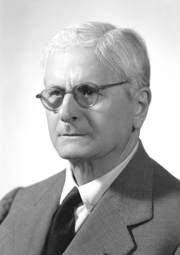 4
Arturo Labriola was an Italian revolutionary syndicalist and socialist politician and journalist.
4
Arturo Labriola was an Italian revolutionary syndicalist and socialist politician and journalist.
Mariano Rumor
 4
Mariano Rumor was an Italian politician and statesman. A member of the Christian Democracy (DC), he served as the 39th prime minister of Italy from December 1968 to August 1970 and again from July...
4
Mariano Rumor was an Italian politician and statesman. A member of the Christian Democracy (DC), he served as the 39th prime minister of Italy from December 1968 to August 1970 and again from July...
Maria Domenica Mazzarello
 4
Maria Domenica Mazzarello, FMA was the Roman Catholic Italian foundress of the Salesian Sisters.
4
Maria Domenica Mazzarello, FMA was the Roman Catholic Italian foundress of the Salesian Sisters.
Filippo Tommaso Marinetti
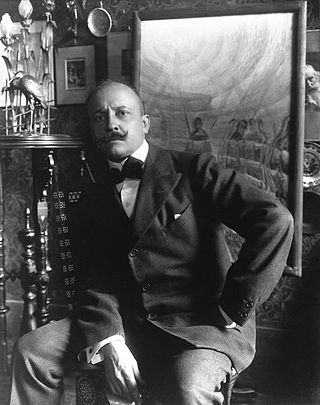 4
Filippo Tommaso Emilio Marinetti was an Italian poet, editor, art theorist, and founder of the Futurist movement. He was associated with the utopian and Symbolist artistic and literary community...
4
Filippo Tommaso Emilio Marinetti was an Italian poet, editor, art theorist, and founder of the Futurist movement. He was associated with the utopian and Symbolist artistic and literary community...
Antonio Begarelli
 4
Antonio Begarelli, also known as Begarino (1499–1565) was an Italian sculptor. In the 16th century, he was the dominant force in terracotta production in Modena.
4
Antonio Begarelli, also known as Begarino (1499–1565) was an Italian sculptor. In the 16th century, he was the dominant force in terracotta production in Modena.
Patrice Lumumba
 4
Patrice Émery Lumumba, born Isaïe Tasumbu Tawosa, was a Congolese politician and independence leader who served as the first prime minister of the Democratic Republic of the Congo from June until...
4
Patrice Émery Lumumba, born Isaïe Tasumbu Tawosa, was a Congolese politician and independence leader who served as the first prime minister of the Democratic Republic of the Congo from June until...
Sandro Cabassi
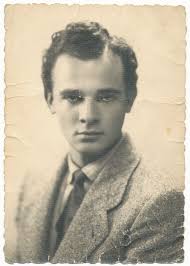 4
Alessandro Cabassi, nome di battaglia "Franco", è stato un partigiano italiano.
4
Alessandro Cabassi, nome di battaglia "Franco", è stato un partigiano italiano.
Romulus of Fiesole
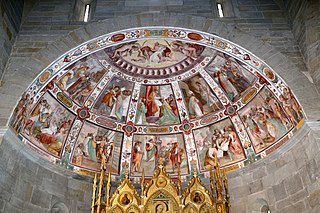 4
Saint Romulus of Fiesole was bishop of Fiesole during the 1st century. He is venerated as the patron saint of Fiesole, Italy. Romulus was probably a local deacon, priest, or bishop of the 1st century.
4
Saint Romulus of Fiesole was bishop of Fiesole during the 1st century. He is venerated as the patron saint of Fiesole, Italy. Romulus was probably a local deacon, priest, or bishop of the 1st century.
Giuseppe Compagnoni
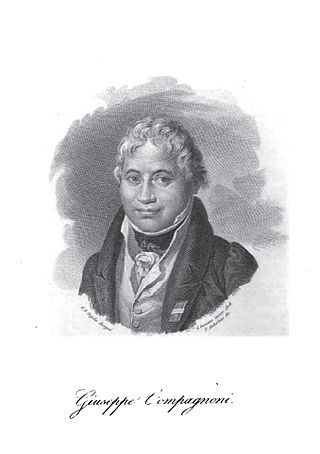 4
Marco Giuseppe Compagnoni was an Italian constitutionalist, writer and journalist, considered the "father of the Italian flag", since he was the first to propose the official use of the Italian...
4
Marco Giuseppe Compagnoni was an Italian constitutionalist, writer and journalist, considered the "father of the Italian flag", since he was the first to propose the official use of the Italian...
Bartolo Nigrisoli
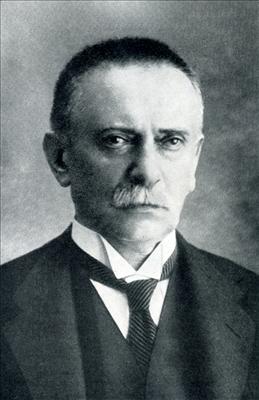 4
Bartolo Nigrisoli è stato un chirurgo italiano.
Fu uno dei docenti universitari che rifiutarono il giuramento di fedeltà al regime fascista.
4
Bartolo Nigrisoli è stato un chirurgo italiano.
Fu uno dei docenti universitari che rifiutarono il giuramento di fedeltà al regime fascista.
Giorgio Bassani
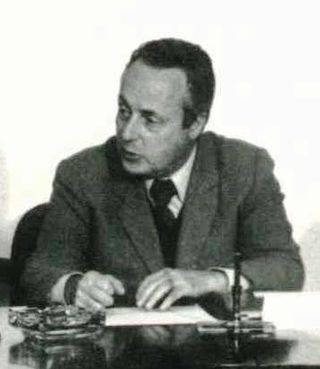 4
Giorgio Bassani was an Italian novelist, poet, essayist, editor, and international intellectual.
4
Giorgio Bassani was an Italian novelist, poet, essayist, editor, and international intellectual.
Venantius of Camerino
 4
Venantius of Camerino is the patron saint of Camerino, Italy and Raiano, Italy. Christian tradition holds that he was a 15-year-old who was tortured, and martyred by decapitation at Camerino during...
4
Venantius of Camerino is the patron saint of Camerino, Italy and Raiano, Italy. Christian tradition holds that he was a 15-year-old who was tortured, and martyred by decapitation at Camerino during...
Anna Maria Mozzoni
 4
Anna Maria Mozzoni is commonly held as the founder of the woman's movement in Italy. One of the roles she is most known for is her pivotal involvement in gaining woman's suffrage in Italy.
4
Anna Maria Mozzoni is commonly held as the founder of the woman's movement in Italy. One of the roles she is most known for is her pivotal involvement in gaining woman's suffrage in Italy.
Albertus Magnus
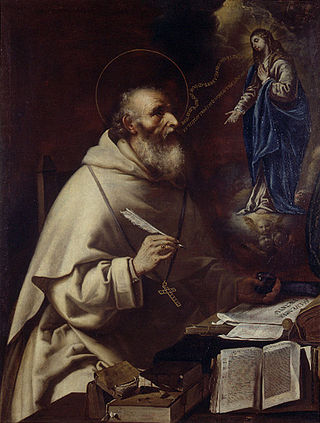 4
Albertus Magnus, also known as Saint Albert the Great, Albert of Swabia
or Albert of Cologne, was a German Dominican friar, philosopher, scientist, and bishop, considered one of the greatest medieval...
4
Albertus Magnus, also known as Saint Albert the Great, Albert of Swabia
or Albert of Cologne, was a German Dominican friar, philosopher, scientist, and bishop, considered one of the greatest medieval...
Gianfranco Miglio
 4
Gianfranco Miglio was an Italian jurist, political scientist, and politician. He was a founder of the Federalist Party. For thirty years, he presided over the political science faculty of Milan's...
4
Gianfranco Miglio was an Italian jurist, political scientist, and politician. He was a founder of the Federalist Party. For thirty years, he presided over the political science faculty of Milan's...
Vito Fornari
 4
Vito Fornari è stato un presbitero, scrittore, teologo e filosofo italiano.
4
Vito Fornari è stato un presbitero, scrittore, teologo e filosofo italiano.
Enzo Tortora
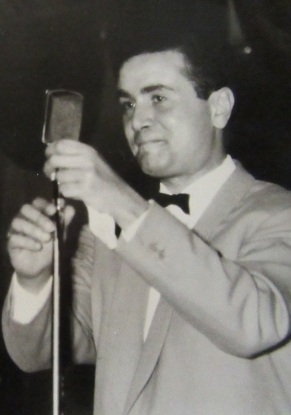 4
Enzo Tortora was an Italian television presenter on national RAI television, who was unjustly convicted of being a member of the Camorra and drug trafficking in 1985, and sentenced to 10 years in...
4
Enzo Tortora was an Italian television presenter on national RAI television, who was unjustly convicted of being a member of the Camorra and drug trafficking in 1985, and sentenced to 10 years in...
Johann Strauss II
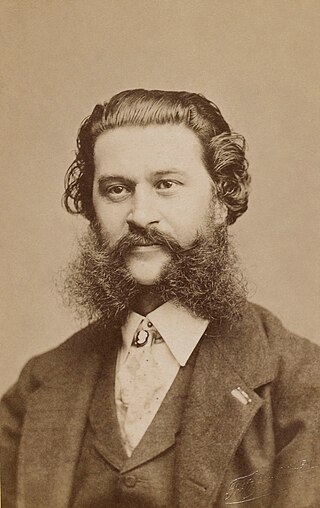 4
Johann Baptist Strauss II, also known as Johann Strauss Jr., the Younger or the Son, was an Austrian composer of light music, particularly dance music and operettas as well as a violinist. He...
4
Johann Baptist Strauss II, also known as Johann Strauss Jr., the Younger or the Son, was an Austrian composer of light music, particularly dance music and operettas as well as a violinist. He...
Giovanni Carnovali
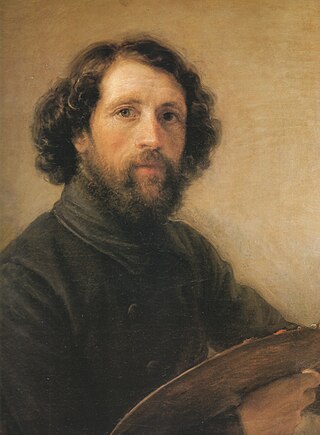 4
Giovanni Carnovali, known as Il Piccio, was an Italian painter.
4
Giovanni Carnovali, known as Il Piccio, was an Italian painter.
Edoardo Scarfoglio
 4
Edoardo Scarfoglio was an Italian author and journalist, one of the early practitioners in Italian fiction of realism, a style of writing that embraced direct, colloquial language and rejected the...
4
Edoardo Scarfoglio was an Italian author and journalist, one of the early practitioners in Italian fiction of realism, a style of writing that embraced direct, colloquial language and rejected the...
Emanuele Gianturco
 4
Emanuele Gianturco (1857–1907) was an Italian legal scholar and politician who held different cabinet posts, including minister of public works, minister of education and minister of justice. He was...
4
Emanuele Gianturco (1857–1907) was an Italian legal scholar and politician who held different cabinet posts, including minister of public works, minister of education and minister of justice. He was...
Luigi Polacchi
 4
Luigi Polacchi è stato un poeta e scrittore italiano.
4
Luigi Polacchi è stato un poeta e scrittore italiano.
Matteo Civitali
 3
Matteo Civitali (1436–1501) was an Italian Renaissance sculptor and architect, painter and engineer from Lucca. He was a leading artistic personality of the Early Renaissance in Lucca, where he was...
3
Matteo Civitali (1436–1501) was an Italian Renaissance sculptor and architect, painter and engineer from Lucca. He was a leading artistic personality of the Early Renaissance in Lucca, where he was...
Francesco Saverio Altamura
 3
Francesco Saverio Altamura was an Italian painter, known for Romantic style canvases depicting mainly historical events.
3
Francesco Saverio Altamura was an Italian painter, known for Romantic style canvases depicting mainly historical events.
Saint Eustace
 3
Saint Eustace is revered as a Christian martyr. According to legend, he was martyred in AD 118, at the command of emperor Hadrian. Eustace was a pagan Roman general, who converted to Christianity...
3
Saint Eustace is revered as a Christian martyr. According to legend, he was martyred in AD 118, at the command of emperor Hadrian. Eustace was a pagan Roman general, who converted to Christianity...
Giovanni Rasori
 3
Giovanni Rasori (1766–1837) was an Italian academic, physician and translator.
3
Giovanni Rasori (1766–1837) was an Italian academic, physician and translator.
Ignazio Ciaia
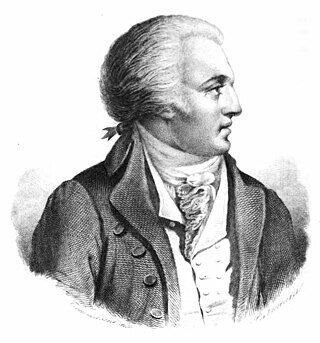 3
Ignazio Ciaia è stato uno scrittore italiano, tra i protagonisti della Repubblica Napoletana del 1799.
3
Ignazio Ciaia è stato uno scrittore italiano, tra i protagonisti della Repubblica Napoletana del 1799.
Francesco Cherubini
 3
Francesco Cherubini was a Catholic cardinal who served as Bishop of Senigallia.
3
Francesco Cherubini was a Catholic cardinal who served as Bishop of Senigallia.
Francesco Algarotti
 3
Count Francesco Algarotti was an Italian polymath, philosopher, poet, essayist, anglophile, art critic and art collector. He was a man of broad knowledge, an expert in Newtonianism, architecture and...
3
Count Francesco Algarotti was an Italian polymath, philosopher, poet, essayist, anglophile, art critic and art collector. He was a man of broad knowledge, an expert in Newtonianism, architecture and...
Ippolito Rosellini
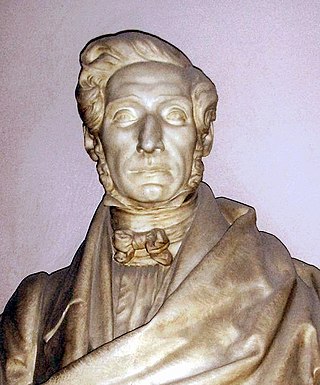 3
Niccola Francesco Ippolito Baldassarre Rosellini, known simply as Ippolito Rosellini was an Italian Egyptologist. A scholar and friend of Jean-François Champollion, he is regarded as the founder of...
3
Niccola Francesco Ippolito Baldassarre Rosellini, known simply as Ippolito Rosellini was an Italian Egyptologist. A scholar and friend of Jean-François Champollion, he is regarded as the founder of...
Domenico Rossetti
 3
Domenico Rossetti was an Italian painter and engraver active mainly in Verona. He was known for his wood engravings and etchings.
3
Domenico Rossetti was an Italian painter and engraver active mainly in Verona. He was known for his wood engravings and etchings.
Pope Anastasius I
 3
Pope Anastasius I was the bishop of Rome from 27 November 399 to his death on 19 December 401.
3
Pope Anastasius I was the bishop of Rome from 27 November 399 to his death on 19 December 401.
Gabrio Serbelloni
 3
Gabriele Serbelloni, better known as Gabrio Serbelloni, was an Italian condottiero and general. A noble by birth, he achieved an even higher status through his military accomplishments as well as his...
3
Gabriele Serbelloni, better known as Gabrio Serbelloni, was an Italian condottiero and general. A noble by birth, he achieved an even higher status through his military accomplishments as well as his...
Fillìa
 3
Fillìa was the name adopted by Luigi Colombo, an Italian artist associated with the second generation of Futurism. Aside from painting, his works included interior design, architecture, furniture...
3
Fillìa was the name adopted by Luigi Colombo, an Italian artist associated with the second generation of Futurism. Aside from painting, his works included interior design, architecture, furniture...
Nicola Porpora
 3
Nicola Antonio Giacinto Porpora was an Italian composer and teacher of singing of the Baroque era, whose most famous singing students were the castrati Farinelli and Caffarelli. Other students...
3
Nicola Antonio Giacinto Porpora was an Italian composer and teacher of singing of the Baroque era, whose most famous singing students were the castrati Farinelli and Caffarelli. Other students...
Andrea Pisano
 3
Andrea Pisano also known as Andrea da Pontedera, was an Italian sculptor and architect.
3
Andrea Pisano also known as Andrea da Pontedera, was an Italian sculptor and architect.
Giovanni Antonio Scopoli
 3
Giovanni Antonio Scopoli was an Italian physician and naturalist. His biographer Otto Guglia named him the "first anational European" and the "Linnaeus of the Austrian Empire".
3
Giovanni Antonio Scopoli was an Italian physician and naturalist. His biographer Otto Guglia named him the "first anational European" and the "Linnaeus of the Austrian Empire".
Eugenio Prati
 3
Eugenio Prati was a painter, active in the Trentino, Austria-Hungary, painting genre subjects.
3
Eugenio Prati was a painter, active in the Trentino, Austria-Hungary, painting genre subjects.
Genuzio Bentini
 3
Genuzio Bentini è stato un avvocato e politico italiano socialista.
3
Genuzio Bentini è stato un avvocato e politico italiano socialista.
Antonio Giuriolo
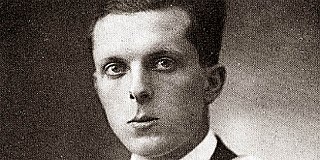 3
Antonio Giuriolo detto Capitan Toni è stato un partigiano italiano.
3
Antonio Giuriolo detto Capitan Toni è stato un partigiano italiano.
Gaspare Aselli
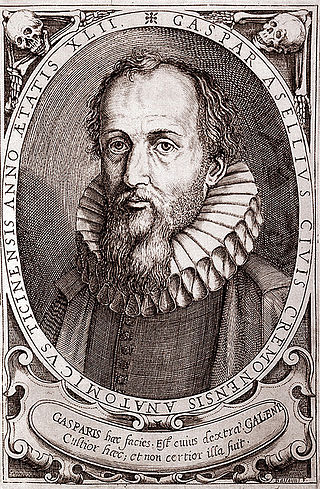 3
Gaspare Aselli was an Italian physician noted for the discovery of the lacteal vessels of the lymphatic system. Aselli discovered the chylous vessels, and studied systematically the significance of...
3
Gaspare Aselli was an Italian physician noted for the discovery of the lacteal vessels of the lymphatic system. Aselli discovered the chylous vessels, and studied systematically the significance of...
Josip Broz Tito
 3
Josip Broz, commonly known as Tito, was a Yugoslav communist revolutionary and politician who served in various positions of national leadership from 1943 until his death in 1980. During World War...
3
Josip Broz, commonly known as Tito, was a Yugoslav communist revolutionary and politician who served in various positions of national leadership from 1943 until his death in 1980. During World War...
Domenico Annibali
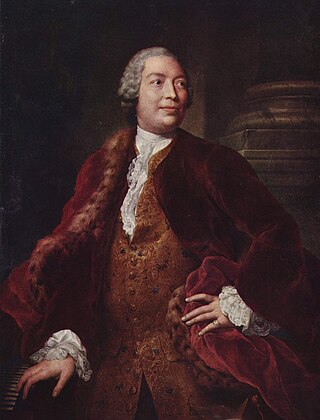 3
Domenico Annibali was an Italian castrato who had an active international career from 1725–1764. He began his career in his native country and was then committed to the Grosses Königliches Opernhaus...
3
Domenico Annibali was an Italian castrato who had an active international career from 1725–1764. He began his career in his native country and was then committed to the Grosses Königliches Opernhaus...
Katharina Lanz
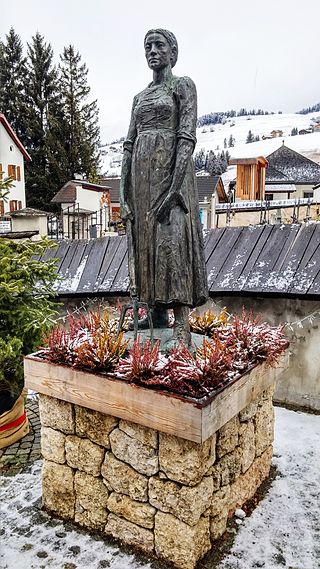 3
Katharina Lanz, anche nota come Caterina Lanz, fu una leggendaria eroina tirolese del XVIII secolo e la cui reale esistenza storica o la cui effettiva partecipazione agli eventi è oggetto di...
3
Katharina Lanz, anche nota come Caterina Lanz, fu una leggendaria eroina tirolese del XVIII secolo e la cui reale esistenza storica o la cui effettiva partecipazione agli eventi è oggetto di...
Sergio Cavina
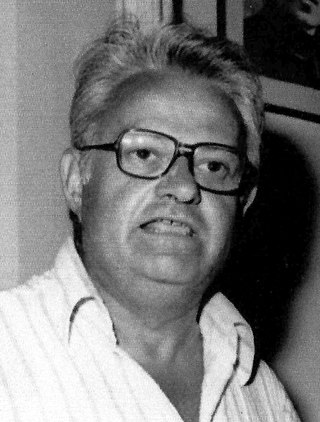 3
Sergio Cavina è stato un politico italiano.
3
Sergio Cavina è stato un politico italiano.
Antonio Bello
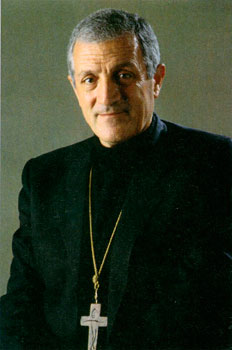 3
Antonio Bello was an Italian Catholic prelate who served as the Bishop of Molfetta-Ruvo-Giovinazzo-Terlizzi from 1982 until his death from cancer in 1993. Bello studied in various colleges and...
3
Antonio Bello was an Italian Catholic prelate who served as the Bishop of Molfetta-Ruvo-Giovinazzo-Terlizzi from 1982 until his death from cancer in 1993. Bello studied in various colleges and...
Tito Minniti
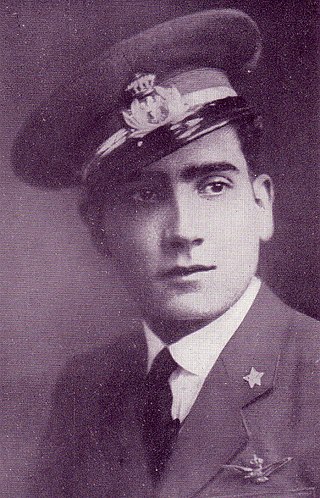 3
Tito Minniti was an Italian pilot who was killed during the Second Italo-Abyssinian War in 1935 near Degehabur. It is unknown whether he died in combat or after being captured by Ethiopian forces....
3
Tito Minniti was an Italian pilot who was killed during the Second Italo-Abyssinian War in 1935 near Degehabur. It is unknown whether he died in combat or after being captured by Ethiopian forces....
Carlo Maratta
 3
Carlo Maratta or Maratti was an Italian painter, active mostly in Rome, and known principally for his classicizing paintings executed in a Late Baroque Classical manner. Although he is part of the...
3
Carlo Maratta or Maratti was an Italian painter, active mostly in Rome, and known principally for his classicizing paintings executed in a Late Baroque Classical manner. Although he is part of the...
Barnaba Oriani
 3
Barnaba Oriani was an Italian priest, geodesist, astronomer and scientist.
3
Barnaba Oriani was an Italian priest, geodesist, astronomer and scientist.
Vilfredo Pareto
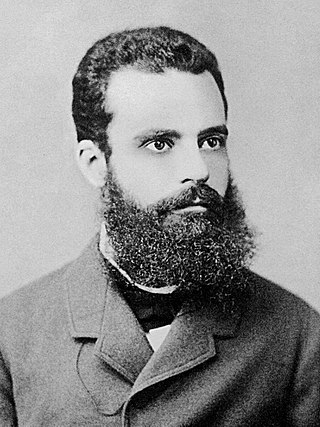 3
Vilfredo Federico Damaso Pareto was an Italian polymath, whose areas of interest included sociology, civil engineering, economics, political science, and philosophy. He made several important...
3
Vilfredo Federico Damaso Pareto was an Italian polymath, whose areas of interest included sociology, civil engineering, economics, political science, and philosophy. He made several important...
Federico Faruffini
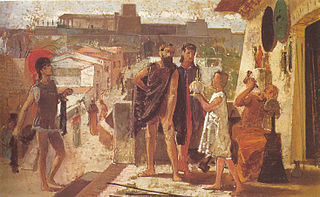 3
Federico Faruffini (1833–1869) was an Italian painter and engraver of historical subjects, in a style that combines the styles and themes of Realism with the diffuse outlines and lively colors of...
3
Federico Faruffini (1833–1869) was an Italian painter and engraver of historical subjects, in a style that combines the styles and themes of Realism with the diffuse outlines and lively colors of...
Giovanni Migliara
 3
Giovanni Migliara (October 15, 1785 in Alessandria – April 18, 1837 in Milan), was a nobleman and Italian painter active at the beginning of the 19th century, painting vedute and history paintings.
3
Giovanni Migliara (October 15, 1785 in Alessandria – April 18, 1837 in Milan), was a nobleman and Italian painter active at the beginning of the 19th century, painting vedute and history paintings.
Camillo Olivetti
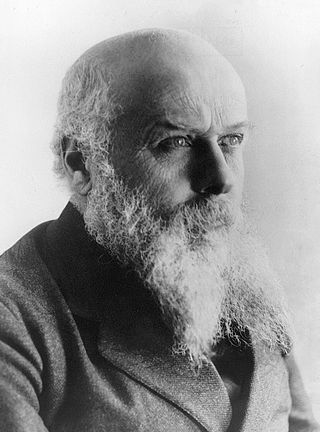 3
Samuel David Camillo Olivetti was an Italian electrical engineer and founder of Olivetti & Co., SpA., the Italian manufacturer of computers, printers and other business machines. The company was...
3
Samuel David Camillo Olivetti was an Italian electrical engineer and founder of Olivetti & Co., SpA., the Italian manufacturer of computers, printers and other business machines. The company was...
Gioacchino Toma
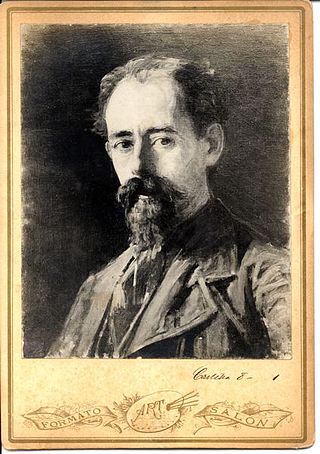 3
Gioacchino Toma was an Italian art instructor and painter, noted primarily for historic, realistic and genre subjects in a Romantic style.
3
Gioacchino Toma was an Italian art instructor and painter, noted primarily for historic, realistic and genre subjects in a Romantic style.
Marco d'Agrate
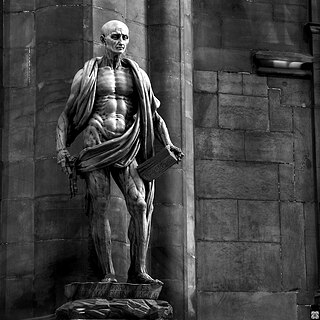 3
Marco d'Agrate was an Italian sculptor of the Renaissance period, active mainly in Lombardy, Italy.
3
Marco d'Agrate was an Italian sculptor of the Renaissance period, active mainly in Lombardy, Italy.
Giorgio Strehler
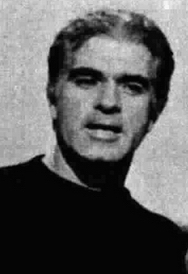 3
Giorgio Strehler was an Italian stage director, theatre practitioner, actor and politician.
3
Giorgio Strehler was an Italian stage director, theatre practitioner, actor and politician.
Giuseppe Saredo
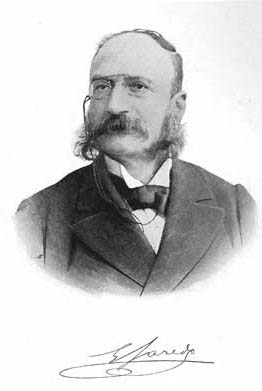 3
Giuseppe Saredo è stato un giurista e politico italiano.
3
Giuseppe Saredo è stato un giurista e politico italiano.
Giuseppe Rensi
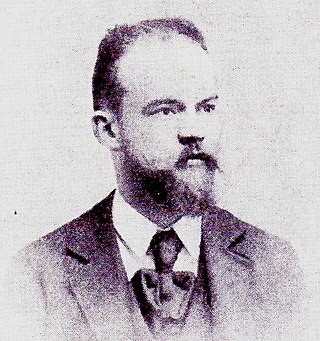 3
Giuseppe Rensi was an Italian philosopher.
3
Giuseppe Rensi was an Italian philosopher.
Monaldo Calari
 3
Monaldo Calari è stato un partigiano italiano.
Medaglia d'oro al valor militare alla memoria.
3
Monaldo Calari è stato un partigiano italiano.
Medaglia d'oro al valor militare alla memoria.
Giacomo Chilesotti
 3
Giacomo Chilesotti, nome di battaglia "Loris" o "Nettuno", è stato un partigiano e antifascista italiano, medaglia d'oro al valor militare alla memoria.
3
Giacomo Chilesotti, nome di battaglia "Loris" o "Nettuno", è stato un partigiano e antifascista italiano, medaglia d'oro al valor militare alla memoria.
Renato Simoni
 3
Renato Simoni was an Italian journalist, playwright, writer and theatrical critic noted for his collaboration work with Giuseppe Adami for Giacomo Puccini's Turandot.
3
Renato Simoni was an Italian journalist, playwright, writer and theatrical critic noted for his collaboration work with Giuseppe Adami for Giacomo Puccini's Turandot.
Giovanni Bettolo
 3
Giovanni Bettolo è stato un politico e ammiraglio italiano e deputato del Regno d'Italia. Fu presidente del CNGEI.
3
Giovanni Bettolo è stato un politico e ammiraglio italiano e deputato del Regno d'Italia. Fu presidente del CNGEI.
Francesco Negri (travel writer)
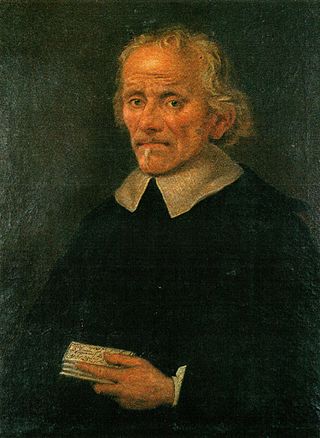 3
Francesco Negri was an Italian Catholic priest who, during 1663–1666, travelled in Scandinavia. In 1670, he published an account of his travels entitled Viaggio settentrionale.
3
Francesco Negri was an Italian Catholic priest who, during 1663–1666, travelled in Scandinavia. In 1670, he published an account of his travels entitled Viaggio settentrionale.
Valeria of Milan
 3
Valeria of Milan, or Valérie, according to Christian tradition, was the wife of Vitalis of Milan and the mother of Gervasius and Protasius.
3
Valeria of Milan, or Valérie, according to Christian tradition, was the wife of Vitalis of Milan and the mother of Gervasius and Protasius.
Alfonso Casati
 3
Alfonso Casati è stato un militare italiano, insignito della medaglia d'oro al valor militare per la sua attività durante la Resistenza.
3
Alfonso Casati è stato un militare italiano, insignito della medaglia d'oro al valor militare per la sua attività durante la Resistenza.
Fabio Massimo Castaldo
 3
Fabio Massimo Castaldo is an Italian politician who has served in the European Parliament since 2014. On 15 November 2017, he was elected Vice-President of the European Parliament; in doing so, he...
3
Fabio Massimo Castaldo is an Italian politician who has served in the European Parliament since 2014. On 15 November 2017, he was elected Vice-President of the European Parliament; in doing so, he...
Bernardino Varisco
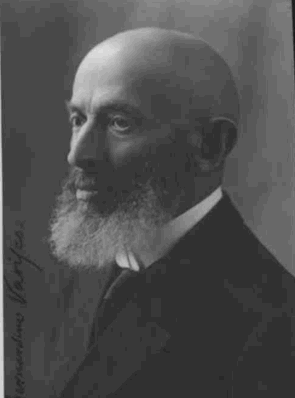 3
Bernardino Varisco, was an Italian philosopher and a professor of Theoretical Philosophy at the University of Rome La Sapienza from 1905 to 1925.
3
Bernardino Varisco, was an Italian philosopher and a professor of Theoretical Philosophy at the University of Rome La Sapienza from 1905 to 1925.
Alfeo Corassori
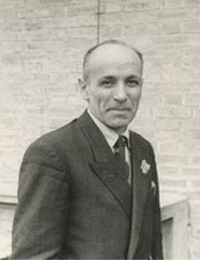 3
Alfeo Corassori è stato un politico italiano.
3
Alfeo Corassori è stato un politico italiano.
Isabella di Morra
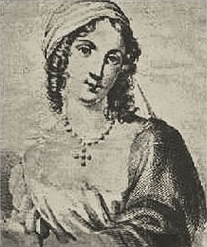 3
Isabella di Morra was an Italian poet of the Renaissance. An unknown figure in her lifetime, she was forced by her brothers to live in isolation, which estranged her from courts and literary salons....
3
Isabella di Morra was an Italian poet of the Renaissance. An unknown figure in her lifetime, she was forced by her brothers to live in isolation, which estranged her from courts and literary salons....
Francesco Anzani
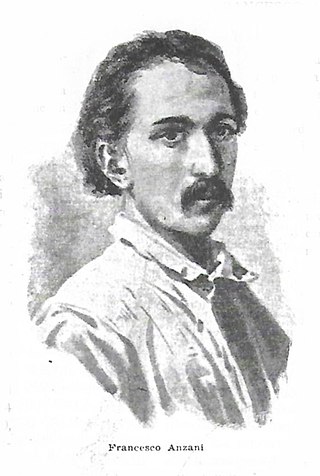 3
Francesco Anzani è stato un patriota e militare italiano.
3
Francesco Anzani è stato un patriota e militare italiano.
Severus Alexander
 3
Marcus Aurelius Severus Alexander, also known as Alexander Severus, was Roman emperor from 222 until 235. The last emperor from the Severan dynasty, he succeeded his slain cousin Elagabalus in 222,...
3
Marcus Aurelius Severus Alexander, also known as Alexander Severus, was Roman emperor from 222 until 235. The last emperor from the Severan dynasty, he succeeded his slain cousin Elagabalus in 222,...
Giacomo Mancini
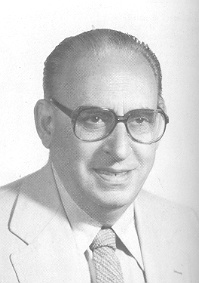 3
Giacomo Mancini was an Italian politician and lawyer.
3
Giacomo Mancini was an Italian politician and lawyer.
Tommaso Dal Molin
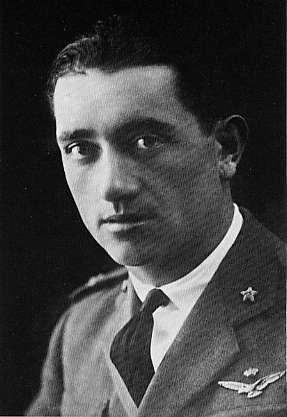 3
Tommaso Dal Molin was an Italian fighter pilot and internationally prominent seaplane air racer and aerobatic pilot of the 1920s.
3
Tommaso Dal Molin was an Italian fighter pilot and internationally prominent seaplane air racer and aerobatic pilot of the 1920s.
Paolo Braccini
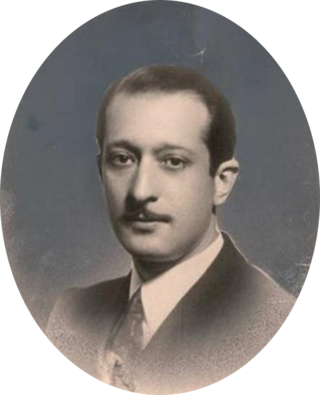 3
Paolo Braccini "Verdi" è stato un partigiano e antifascista italiano, insignito con la Medaglia d'oro al valor militare alla memoria.
3
Paolo Braccini "Verdi" è stato un partigiano e antifascista italiano, insignito con la Medaglia d'oro al valor militare alla memoria.
Goffredo Casalis
 3
Goffredo Casalis è stato un abate e storico italiano.
3
Goffredo Casalis è stato un abate e storico italiano.
Gregorio Barbarigo
 3
Gregorio Giovanni Gaspare Barbarigo was an Italian Roman Catholic cardinal who served as the Bishop of Bergamo and later as the Bishop of Padua. He was a frontrunner in both the 1689 and 1691 papal...
3
Gregorio Giovanni Gaspare Barbarigo was an Italian Roman Catholic cardinal who served as the Bishop of Bergamo and later as the Bishop of Padua. He was a frontrunner in both the 1689 and 1691 papal...
Simón Bolívar
 3
Simón José Antonio de la Santísima Trinidad Bolívar Palacios Ponte y Blanco was a Venezuelan military and political leader who led what are currently the countries of Colombia, Venezuela, Ecuador,...
3
Simón José Antonio de la Santísima Trinidad Bolívar Palacios Ponte y Blanco was a Venezuelan military and political leader who led what are currently the countries of Colombia, Venezuela, Ecuador,...
Melchiorre Cesarotti
 3
Melchiorre Cesarotti was an Italian poet, translator and theorist.
3
Melchiorre Cesarotti was an Italian poet, translator and theorist.
Giuseppe Moruzzi
 3
Giuseppe Moruzzi was an Italian neurophysiologist. He was one of three scientists who connected wakefulness to a series of brain structures known as the reticular activating system, and his work...
3
Giuseppe Moruzzi was an Italian neurophysiologist. He was one of three scientists who connected wakefulness to a series of brain structures known as the reticular activating system, and his work...
Joseph-Louis Lagrange
 3
Joseph-Louis Lagrange, also reported as Giuseppe Luigi Lagrange or Lagrangia, was an Italian mathematician, physicist and astronomer, later naturalized French. He made significant contributions to...
3
Joseph-Louis Lagrange, also reported as Giuseppe Luigi Lagrange or Lagrangia, was an Italian mathematician, physicist and astronomer, later naturalized French. He made significant contributions to...
Antonio Cesari
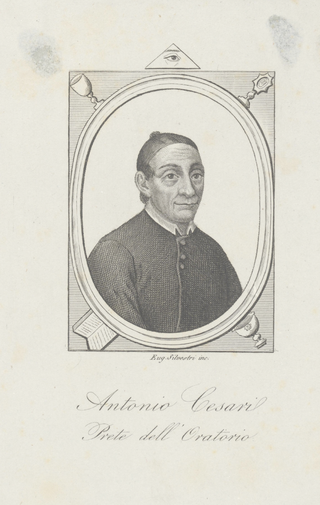 3
Antonio Cesari è stato un linguista, scrittore e letterato italiano.
3
Antonio Cesari è stato un linguista, scrittore e letterato italiano.
Francisco Ferrer
 3
Francesc Ferrer i Guàrdia, widely known as Francisco Ferrer, was a Spanish radical freethinker, anarchist, and educationist behind a network of secular, private, libertarian schools in and around...
3
Francesc Ferrer i Guàrdia, widely known as Francisco Ferrer, was a Spanish radical freethinker, anarchist, and educationist behind a network of secular, private, libertarian schools in and around...
Arnoldo Mondadori
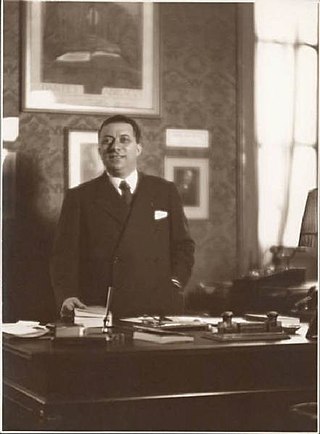 3
Arnoldo Mondadori was a noted Italian publisher.
3
Arnoldo Mondadori was a noted Italian publisher.
Guido Gonella
 3
Guido Gonella was an Italian politician from the Christian Democracy, former Minister of Public Education and Minister of Justice.
3
Guido Gonella was an Italian politician from the Christian Democracy, former Minister of Public Education and Minister of Justice.
Luigi Vittorio Bertarelli
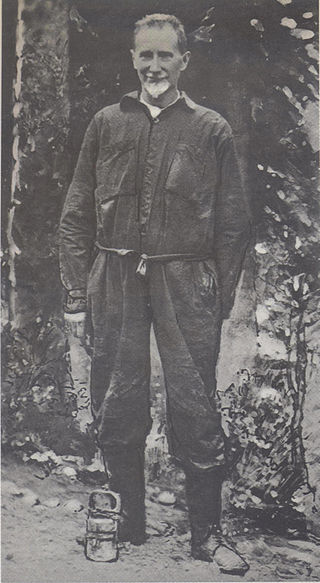 3
Luigi Vittorio Bertarelli è stato un geografo e speleologo italiano.
3
Luigi Vittorio Bertarelli è stato un geografo e speleologo italiano.
Francesco Selmi
 3
Francesco Selmi was an Italian chemist and patriot, one of the founders of colloid chemistry.
3
Francesco Selmi was an Italian chemist and patriot, one of the founders of colloid chemistry.
Ferruccio Garavaglia
 3
Ferruccio Garavaglia è stato un attore italiano di teatro e cinema muto.
3
Ferruccio Garavaglia è stato un attore italiano di teatro e cinema muto.
Dino Buzzati
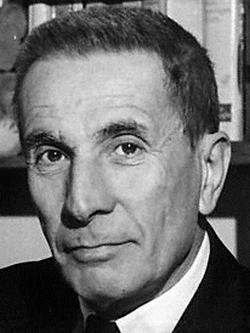 3
Dino Buzzati-Traverso was an Italian novelist, short story writer, painter and poet, as well as a journalist for Corriere della Sera. His worldwide fame is mostly due to his novel The Tartar Steppe,...
3
Dino Buzzati-Traverso was an Italian novelist, short story writer, painter and poet, as well as a journalist for Corriere della Sera. His worldwide fame is mostly due to his novel The Tartar Steppe,...
Gino Cervi
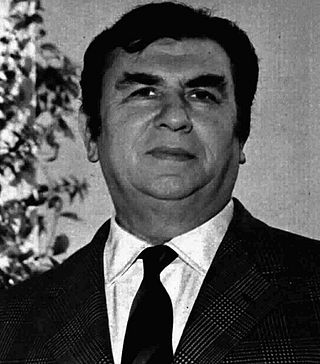 3
Luigi Cervi, better known as Gino Cervi, was an Italian actor. He was best known for portraying Peppone in a series of comedies based on the character Don Camillo (1952–1965), and police detective...
3
Luigi Cervi, better known as Gino Cervi, was an Italian actor. He was best known for portraying Peppone in a series of comedies based on the character Don Camillo (1952–1965), and police detective...
Alessandro Stoppato
 3
Alessandro Francesco Luigi Stoppato è stato un avvocato e politico italiano.
3
Alessandro Francesco Luigi Stoppato è stato un avvocato e politico italiano.
Carlo Cignani
 3
Carlo Cignani was an Italian painter. His innovative style referred to as his 'new manner' introduced a reflective, intimate mood of painting and presaged the later pictures of Guido Reni and...
3
Carlo Cignani was an Italian painter. His innovative style referred to as his 'new manner' introduced a reflective, intimate mood of painting and presaged the later pictures of Guido Reni and...
Elisabetta Sirani
 3
Elisabetta Sirani was an Italian Baroque painter and printmaker who died in unexplained circumstances at the age of 27. She was one of the first women artists in early modern Bologna, who established...
3
Elisabetta Sirani was an Italian Baroque painter and printmaker who died in unexplained circumstances at the age of 27. She was one of the first women artists in early modern Bologna, who established...
Francesco Arcangeli
 3
Francesco Arcangeli was an Italian cook and criminal, the murderer of the famous art historian Johann Joachim Winckelmann (1717–1768).
3
Francesco Arcangeli was an Italian cook and criminal, the murderer of the famous art historian Johann Joachim Winckelmann (1717–1768).
Gaetano Pilati
 3
Gaetano Pilati è stato un politico italiano.
3
Gaetano Pilati è stato un politico italiano.
Molière
 3
Jean-Baptiste Poquelin, known by his stage name Molière, was a French playwright, actor, and poet, widely regarded as one of the great writers in the French language and world literature. His extant...
3
Jean-Baptiste Poquelin, known by his stage name Molière, was a French playwright, actor, and poet, widely regarded as one of the great writers in the French language and world literature. His extant...
Edoardo Ferravilla
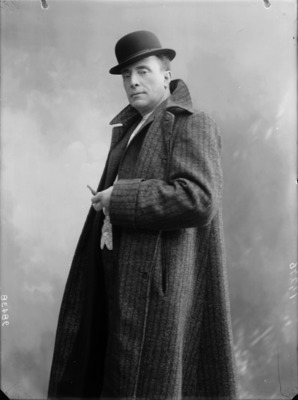 3
Edoardo Ferravilla è stato un attore e commediografo italiano del teatro e del cinema muto.
3
Edoardo Ferravilla è stato un attore e commediografo italiano del teatro e del cinema muto.
Giovanni Bertini
 3
Giovanni "Giovannone" Bertini was an Italian professional footballer who played as a defender.
3
Giovanni "Giovannone" Bertini was an Italian professional footballer who played as a defender.
Serafino Calindri
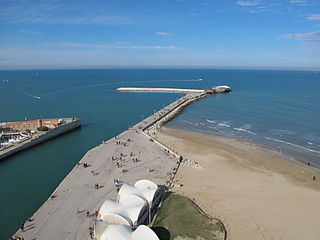 3
Serafino Calindri è stato uno storico, presbitero e ingegnere idraulico italiano.
3
Serafino Calindri è stato uno storico, presbitero e ingegnere idraulico italiano.
Angelo Venturoli
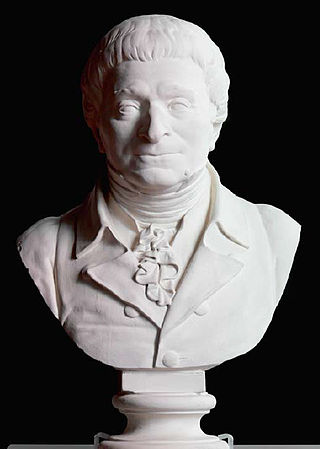 3
Angelo Venturoli was an Italian architect.
3
Angelo Venturoli was an Italian architect.
Eustachio Manfredi
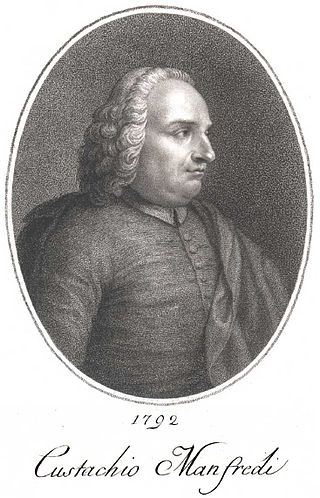 3
Eustachio Manfredi was an Italian mathematician, astronomer and poet.
3
Eustachio Manfredi was an Italian mathematician, astronomer and poet.
Giulio Cesare Croce
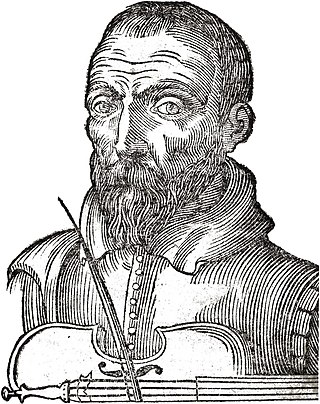 3
Giulio Cesare Croce (1550–1609) was an Italian writer, actor/producer of cantastoria and enigma writer.
3
Giulio Cesare Croce (1550–1609) was an Italian writer, actor/producer of cantastoria and enigma writer.
Francesco Rizzoli
Angelo Mariani (chemist)
 3
Angelo Mariani or Ange-François Mariani was a French chemist and entrepreneur from the island of Corsica. He was born in Pero-Casevecchie, Haute-Corse.
3
Angelo Mariani or Ange-François Mariani was a French chemist and entrepreneur from the island of Corsica. He was born in Pero-Casevecchie, Haute-Corse.
Vincenzo Gemito
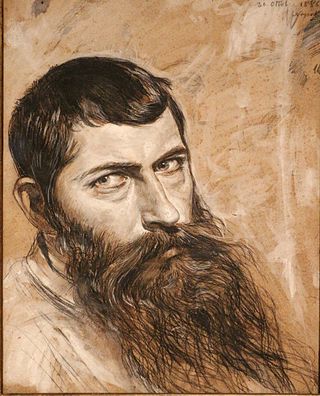 3
Vincenzo Gemito was an Italian sculptor and artist.
3
Vincenzo Gemito was an Italian sculptor and artist.
Alessandro Bonci
 3
Alessandro Bonci was an Italian lyric tenor known internationally for his association with the bel canto repertoire. He sang at many famous theatres, including New York's Metropolitan Opera, Milan's...
3
Alessandro Bonci was an Italian lyric tenor known internationally for his association with the bel canto repertoire. He sang at many famous theatres, including New York's Metropolitan Opera, Milan's...
Alessandro Codivilla
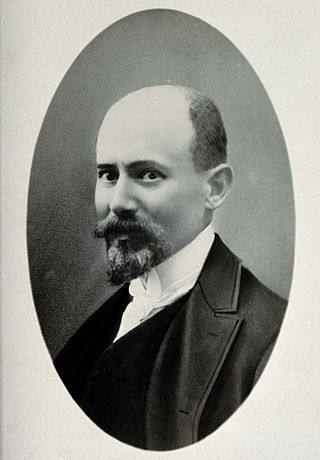 3
Alessandro Codivilla was an Italian surgeon from Bologna and head of the surgical department of the hospital of Castiglion Fiorentino, known for his work in orthopaedics and first describing the...
3
Alessandro Codivilla was an Italian surgeon from Bologna and head of the surgical department of the hospital of Castiglion Fiorentino, known for his work in orthopaedics and first describing the...
Giovanni Marchetti
 3
Giovanni Marchetti was a Roman Catholic archbishop of Italy. He was also Roman Catholic Titular Archbishop of Ancyra.
3
Giovanni Marchetti was a Roman Catholic archbishop of Italy. He was also Roman Catholic Titular Archbishop of Ancyra.
Severino Ferrari
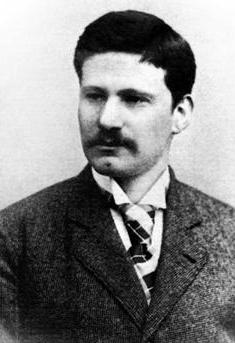 3
Severino Ferrari è stato un poeta e critico letterario italiano.
3
Severino Ferrari è stato un poeta e critico letterario italiano.
Giovanni Gozzadini
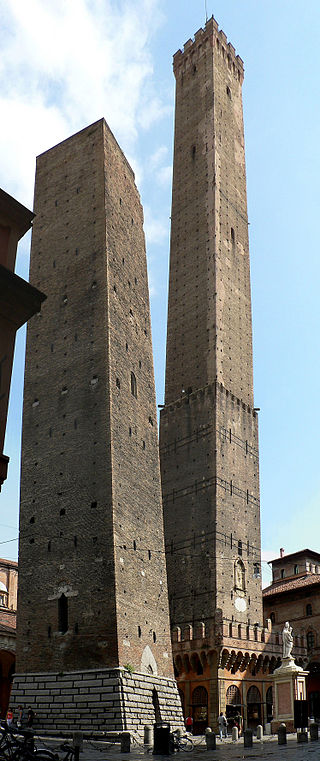 3
Giovanni Gozzadini was an Italian archaeologist.
3
Giovanni Gozzadini was an Italian archaeologist.
Francesco Albergati Capacelli
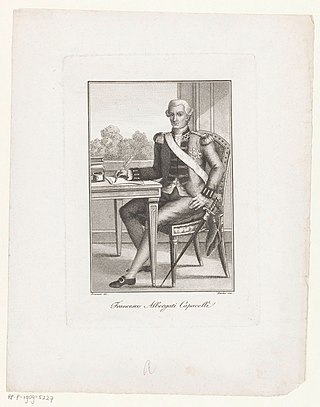 3
Francesco Albergati Capacelli was an Italian writer and playwright.
3
Francesco Albergati Capacelli was an Italian writer and playwright.
Ivo Lollini
 3
Ivo Lollini è stato un militare italiano, decorato con la medaglia d'oro al valor militare alla memoria nel corso della prima guerra mondiale.
3
Ivo Lollini è stato un militare italiano, decorato con la medaglia d'oro al valor militare alla memoria nel corso della prima guerra mondiale.
Livio Zambeccari
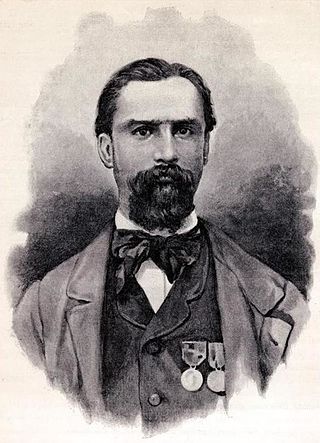 3
Livio Zambeccari was a risorgimento activist and, for his admirers, hero. He was involved, sometimes on the frontline, in various liberation wars and skirmishes that marked the Italian struggle for...
3
Livio Zambeccari was a risorgimento activist and, for his admirers, hero. He was involved, sometimes on the frontline, in various liberation wars and skirmishes that marked the Italian struggle for...
Alberto Bergamini
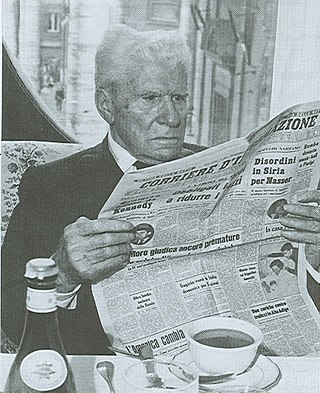 3
Alberto Bergamini è stato un giornalista e politico italiano.
3
Alberto Bergamini è stato un giornalista e politico italiano.
Errico Malatesta
 3
Errico Malatesta was an Italian anarchist propagandist and revolutionary socialist. He edited several radical newspapers and spent much of his life exiled and imprisoned, having been jailed and...
3
Errico Malatesta was an Italian anarchist propagandist and revolutionary socialist. He edited several radical newspapers and spent much of his life exiled and imprisoned, having been jailed and...
Rinaldo Rigola
 3
Rinaldo Rigola was an Italian socialist politician who served as the founding secretary general of the General Confederation of Labour in 1906.
3
Rinaldo Rigola was an Italian socialist politician who served as the founding secretary general of the General Confederation of Labour in 1906.
Septimius Severus
 3
Lucius Septimius Severus was a Roman politician who served as emperor from 193 to 211. He was born in Leptis Magna in the Roman province of Africa. As a young man he advanced through the customary...
3
Lucius Septimius Severus was a Roman politician who served as emperor from 193 to 211. He was born in Leptis Magna in the Roman province of Africa. As a young man he advanced through the customary...
Antonio Zanchi
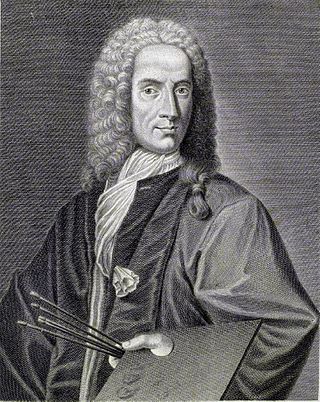 3
Antonio Zanchi was an Italian painter of the Baroque, active mainly in Venice, but his prolific works can also be seen in Padova, Treviso, Rovigo, Verona, Vicenza, Loreto, Brescia, Milano, and...
3
Antonio Zanchi was an Italian painter of the Baroque, active mainly in Venice, but his prolific works can also be seen in Padova, Treviso, Rovigo, Verona, Vicenza, Loreto, Brescia, Milano, and...
Vincenzo Manfredini
 3
Vincenzo Manfredini was an Italian composer, harpsichordist and a music theorist.
3
Vincenzo Manfredini was an Italian composer, harpsichordist and a music theorist.
Thecla
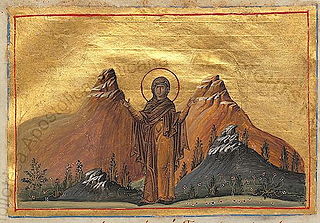 3
Thecla was a saint of the early Christian Church, and a reported follower of Paul the Apostle. The earliest record of her life comes from the ancient apocryphal Acts of Paul and Thecla.
3
Thecla was a saint of the early Christian Church, and a reported follower of Paul the Apostle. The earliest record of her life comes from the ancient apocryphal Acts of Paul and Thecla.
Enrico Mayer
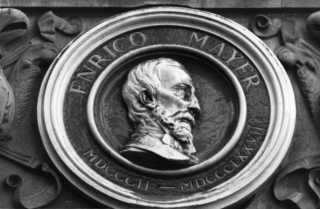 3
Enrico Mayer è stato un pedagogista e scrittore italiano, di origine franco-tedesca.
3
Enrico Mayer è stato un pedagogista e scrittore italiano, di origine franco-tedesca.
Giovanni Roveda
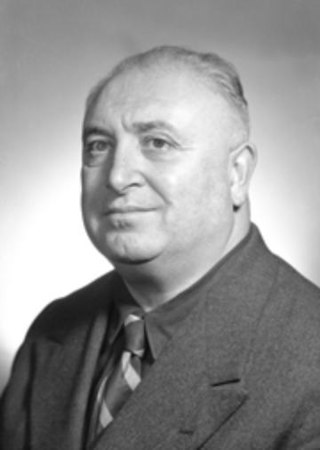 3
Giovanni Roveda was an Italian trade union leader, communist politician and anti-fascist activist.
3
Giovanni Roveda was an Italian trade union leader, communist politician and anti-fascist activist.
Barnabas
 3
Barnabas, born Joseph (Ἰωσήφ) or Joses (Ἰωσής), was according to tradition an early Christian, one of the prominent Christian disciples in Jerusalem. According to Acts 4:36, Barnabas was a Cypriot...
3
Barnabas, born Joseph (Ἰωσήφ) or Joses (Ἰωσής), was according to tradition an early Christian, one of the prominent Christian disciples in Jerusalem. According to Acts 4:36, Barnabas was a Cypriot...
Vincenzo Scamozzi
 3
Vincenzo Scamozzi was an Italian architect and a writer on architecture, active mainly in Vicenza and Republic of Venice area in the second half of the 16th century. He was perhaps the most important...
3
Vincenzo Scamozzi was an Italian architect and a writer on architecture, active mainly in Vicenza and Republic of Venice area in the second half of the 16th century. He was perhaps the most important...
Ignazio Danti
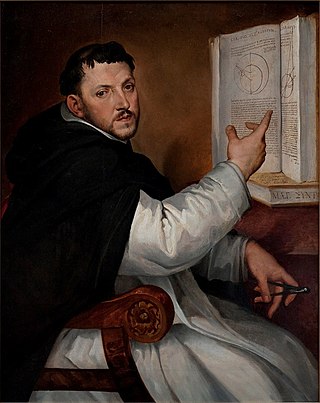 3
Ignazio Danti, O.P., born Pellegrino Rainaldi Danti, was an Italian Roman Catholic prelate, mathematician, astronomer, and cosmographer, who served as Bishop of Alatri (1583–1586).
3
Ignazio Danti, O.P., born Pellegrino Rainaldi Danti, was an Italian Roman Catholic prelate, mathematician, astronomer, and cosmographer, who served as Bishop of Alatri (1583–1586).
Giuseppina Strepponi
 3
Clelia Maria Giuseppa (Giuseppina) Strepponi was a nineteenth-century Italian operatic soprano of great renown and the second wife of composer Giuseppe Verdi.
3
Clelia Maria Giuseppa (Giuseppina) Strepponi was a nineteenth-century Italian operatic soprano of great renown and the second wife of composer Giuseppe Verdi.
Gaius Mucius Scaevola
 3
Gaius Mucius Cordus, better known with his later cognomen Scaevola, was an ancient Roman youth, possibly mythical, famous for his bravery.
3
Gaius Mucius Cordus, better known with his later cognomen Scaevola, was an ancient Roman youth, possibly mythical, famous for his bravery.
Gabriele Foschiatti
 3
Gabriele Foschiatti è stato un militare, partigiano e antifascista italiano.
Fu un irredentista mazziniano che legò il suo nome alle vicende storiche riguardanti l'impresa di Fiume, guidata da...
3
Gabriele Foschiatti è stato un militare, partigiano e antifascista italiano.
Fu un irredentista mazziniano che legò il suo nome alle vicende storiche riguardanti l'impresa di Fiume, guidata da...
Victor Hugo
 3
Victor-Marie Hugo, vicomte Hugo, sometimes nicknamed the Ocean Man, was a French Romantic writer and politician. During a literary career that spanned more than sixty years, he wrote in a variety of...
3
Victor-Marie Hugo, vicomte Hugo, sometimes nicknamed the Ocean Man, was a French Romantic writer and politician. During a literary career that spanned more than sixty years, he wrote in a variety of...
Jerome
 3
Jerome, also known as Jerome of Stridon, was an early Christian priest, confessor, theologian, translator, and historian; he is commonly known as Saint Jerome.
3
Jerome, also known as Jerome of Stridon, was an early Christian priest, confessor, theologian, translator, and historian; he is commonly known as Saint Jerome.
Cesare Rossi (politician)
 3
Cesare Rossi was an Italian fascist leader who later became estranged from the regime.
3
Cesare Rossi was an Italian fascist leader who later became estranged from the regime.
Óscar Romero
 3
Óscar Arnulfo Romero y Galdámez was a prelate of the Catholic Church in El Salvador. He served as Auxiliary Bishop of the Archdiocese of San Salvador, the Titular Bishop of Tambeae, as Bishop of...
3
Óscar Arnulfo Romero y Galdámez was a prelate of the Catholic Church in El Salvador. He served as Auxiliary Bishop of the Archdiocese of San Salvador, the Titular Bishop of Tambeae, as Bishop of...
Sigismondo Malatesta
 3
Sigismondo Malatesta was an Italian condottiero.
3
Sigismondo Malatesta was an Italian condottiero.
Baccio Bandinelli
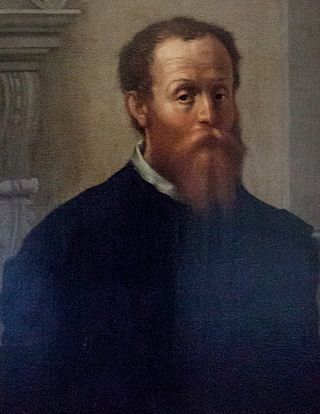 3
Baccio Bandinelli, was an Italian Renaissance sculptor, draughtsman, and painter.
3
Baccio Bandinelli, was an Italian Renaissance sculptor, draughtsman, and painter.
Ulrich of Augsburg
 3
Ulrich of Augsburg, sometimes spelled Uodalric or Odalrici, was Prince-Bishop of Augsburg in the Holy Roman Empire. He was the first saint to be canonized not by a local authority but by the pope.
3
Ulrich of Augsburg, sometimes spelled Uodalric or Odalrici, was Prince-Bishop of Augsburg in the Holy Roman Empire. He was the first saint to be canonized not by a local authority but by the pope.
Giuseppe Colombo
 3
Giuseppe "Bepi" Colombo was an Italian scientist, mathematician and engineer at the University of Padua, Italy.
3
Giuseppe "Bepi" Colombo was an Italian scientist, mathematician and engineer at the University of Padua, Italy.
Giuseppe Musio
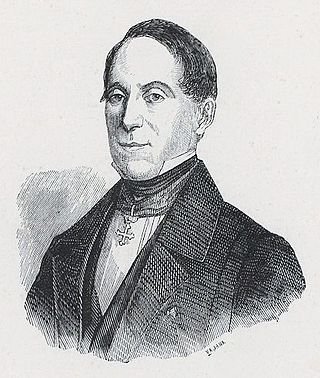 3
Giuseppe Musio è stato un magistrato e politico italiano.
3
Giuseppe Musio è stato un magistrato e politico italiano.
Enrico Bottini
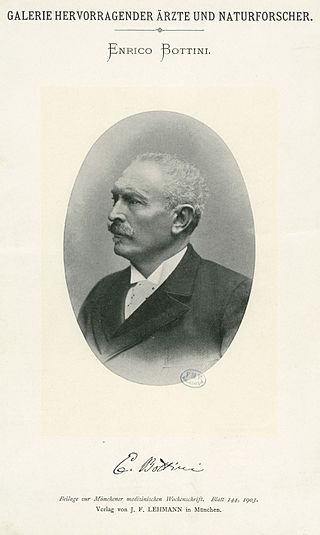 3
Enrico Bottini è stato un chirurgo e politico italiano.
3
Enrico Bottini è stato un chirurgo e politico italiano.
Felice Bellotti
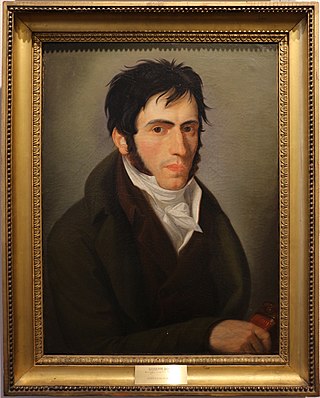 3
Felice Gaetano Maria Bellotti è stato uno scrittore, poeta e traduttore italiano, particolarmente noto per le versioni dal greco delle tragedie di Eschilo, Euripide e Sofocle.
3
Felice Gaetano Maria Bellotti è stato uno scrittore, poeta e traduttore italiano, particolarmente noto per le versioni dal greco delle tragedie di Eschilo, Euripide e Sofocle.
Gabriele Camozzi
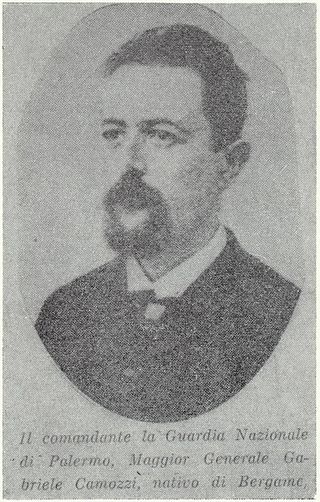 3
Gabriele Camozzi è stato un patriota e politico italiano.
3
Gabriele Camozzi è stato un patriota e politico italiano.
Bartolomeo Borghesi
 3
Bartolomeo Borghesi was an Italian antiquarian who was a key figure in establishing the science of numismatics.
3
Bartolomeo Borghesi was an Italian antiquarian who was a key figure in establishing the science of numismatics.
Luigi Federico Menabrea
 3
Luigi Federico Menabrea, later made 1st Count Menabrea and 1st Marquess of Valdora, was an Italian statesman, general, diplomat, and mathematician who served as the seventh prime minister of Italy...
3
Luigi Federico Menabrea, later made 1st Count Menabrea and 1st Marquess of Valdora, was an Italian statesman, general, diplomat, and mathematician who served as the seventh prime minister of Italy...
Bartolomeo Avanzini
 3
Bartolomeo Avanzini (1608–1658) was an Italian architect of the Baroque period, active mainly in Modena, Sassuolo and Reggio Emilia.
3
Bartolomeo Avanzini (1608–1658) was an Italian architect of the Baroque period, active mainly in Modena, Sassuolo and Reggio Emilia.
Jacopo Foroni
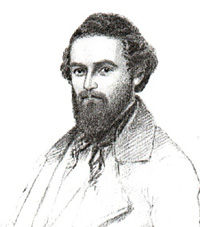 3
Jacopo Foroni was an Italian opera composer and conductor who spent most of his working life in Sweden.
3
Jacopo Foroni was an Italian opera composer and conductor who spent most of his working life in Sweden.
Emilio Caldara
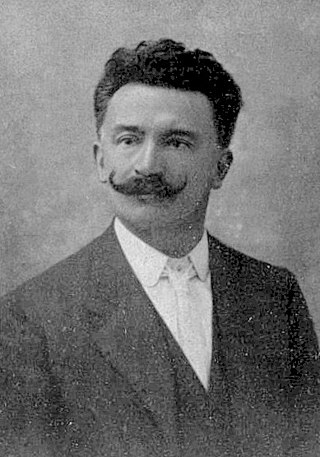 3
Emilio Caldara was an Italian Socialist Party politician. He was also a member of the Unitary Socialist Party. He was mayor of Milan.
3
Emilio Caldara was an Italian Socialist Party politician. He was also a member of the Unitary Socialist Party. He was mayor of Milan.
Alessandro Stradella
 3
Antonio Alessandro Boncompagno Stradella was an Italian composer of the middle Baroque period. He enjoyed a dazzling career as a freelance composer, writing on commission, and collaborating with...
3
Antonio Alessandro Boncompagno Stradella was an Italian composer of the middle Baroque period. He enjoyed a dazzling career as a freelance composer, writing on commission, and collaborating with...
Gerardus Mercator
 3
Gerardus Mercator was a Flemish geographer, cosmographer and cartographer. He is most renowned for creating the 1569 world map based on a new projection which represented sailing courses of constant...
3
Gerardus Mercator was a Flemish geographer, cosmographer and cartographer. He is most renowned for creating the 1569 world map based on a new projection which represented sailing courses of constant...
Girolamo Baruffaldi
 3
Girolamo Baruffaldi was an Italian historian who wrote a biography of artists active in Ferrara.
3
Girolamo Baruffaldi was an Italian historian who wrote a biography of artists active in Ferrara.
Olindo Malagodi
 3
Olindo Malagodi è stato uno scrittore, giornalista e politico italiano.
3
Olindo Malagodi è stato uno scrittore, giornalista e politico italiano.
Benedetto Castelli
 3
Benedetto Castelli, born Antonio Castelli, was an Italian mathematician. Benedetto was his name in religion on entering the Benedictine Order in 1595.
3
Benedetto Castelli, born Antonio Castelli, was an Italian mathematician. Benedetto was his name in religion on entering the Benedictine Order in 1595.
Giovanni Battista Amici
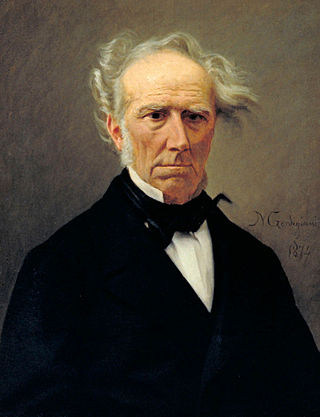 3
Giovanni Battista Amici was an Italian astronomer, microscopist, and botanist.
3
Giovanni Battista Amici was an Italian astronomer, microscopist, and botanist.
Italo Balbo
 3
Italo Balbo was an Italian fascist politician and Blackshirts' leader who served as Italy's Marshal of the Air Force, Governor-General of Italian Libya and Commander-in-Chief of Italian North Africa....
3
Italo Balbo was an Italian fascist politician and Blackshirts' leader who served as Italy's Marshal of the Air Force, Governor-General of Italian Libya and Commander-in-Chief of Italian North Africa....
Giovanni Battista Niccolini
 3
Giovanni Battista Niccolini was an Italian poet and playwright of the Italian unification movement or Risorgimento.
3
Giovanni Battista Niccolini was an Italian poet and playwright of the Italian unification movement or Risorgimento.
Paolo Monelli
 3
Paolo Monelli è stato un giornalista, scrittore e militare italiano.
3
Paolo Monelli è stato un giornalista, scrittore e militare italiano.
Gian Giorgio Trissino
 3
Gian Giorgio Trissino, also called Giovan Giorgio Trissino and self-styled as Giovan Giωrgio Trissino, was a Venetian Renaissance humanist, poet, dramatist, diplomat, grammarian, linguist, and...
3
Gian Giorgio Trissino, also called Giovan Giorgio Trissino and self-styled as Giovan Giωrgio Trissino, was a Venetian Renaissance humanist, poet, dramatist, diplomat, grammarian, linguist, and...
Victor Amadeus II
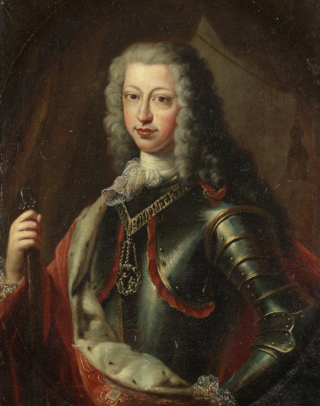 3
Victor Amadeus II was the head of the House of Savoy and ruler of the Savoyard states from 12 June 1675 until his abdication in 1730. He was the first of his house to acquire a royal crown, ruling...
3
Victor Amadeus II was the head of the House of Savoy and ruler of the Savoyard states from 12 June 1675 until his abdication in 1730. He was the first of his house to acquire a royal crown, ruling...
Fratelli Ruffini
 3
I fratelli Ruffini furono tre patrioti genovesi.Agostino Ruffini
Giovanni Ruffini
Jacopo Ruffini
3
I fratelli Ruffini furono tre patrioti genovesi.Agostino Ruffini
Giovanni Ruffini
Jacopo Ruffini
Antonio Beltramelli
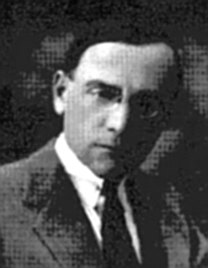 3
Antonio Beltramelli è stato uno scrittore e giornalista italiano.
3
Antonio Beltramelli è stato uno scrittore e giornalista italiano.
Gaspare Finali
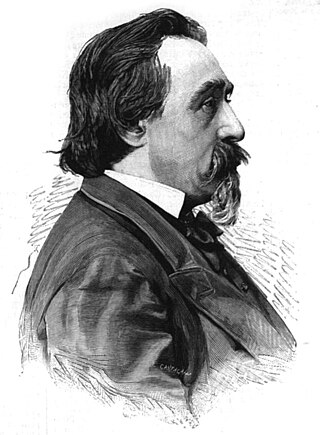 3
Gaspare Finali (1829–1914) was an Italian academic and politician who held various cabinet posts, including minister of agriculture and commerce. He was also a member of the Parliament.
3
Gaspare Finali (1829–1914) was an Italian academic and politician who held various cabinet posts, including minister of agriculture and commerce. He was also a member of the Parliament.
Ernesto Balducci
 3
Ernesto Balducci è stato un presbitero, editore, scrittore e intellettuale italiano.
3
Ernesto Balducci è stato un presbitero, editore, scrittore e intellettuale italiano.
Giovanni Collina
 3
Giovanni Collina è stato un artista italiano.
3
Giovanni Collina è stato un artista italiano.
Tito Maccio Plauto
 3
Tito Maccio Plauto è stato un commediografo romano.
3
Tito Maccio Plauto è stato un commediografo romano.
John the Good (bishop of Milan)
 3
John the Good was Archbishop of Milan from c. 641 to 669. He is honoured as a Saint in the Catholic Church and his feast day is on January 2.
3
John the Good was Archbishop of Milan from c. 641 to 669. He is honoured as a Saint in the Catholic Church and his feast day is on January 2.
Learco Guerra
 3
Learco Guerra was an Italian professional road racing cyclist. The highlight of his career was his overall win in the 1934 Giro d'Italia. He was born in San Nicolò Po, a frazione of Bagnolo San Vito...
3
Learco Guerra was an Italian professional road racing cyclist. The highlight of his career was his overall win in the 1934 Giro d'Italia. He was born in San Nicolò Po, a frazione of Bagnolo San Vito...
Antonino Scopelliti
 3
Antonino Scopelliti was an Italian prosecuting magistrate, murdered by the 'Ndrangheta on behalf of the Sicilian Mafia.
3
Antonino Scopelliti was an Italian prosecuting magistrate, murdered by the 'Ndrangheta on behalf of the Sicilian Mafia.
Ambrogio Contarini
 3
Ambrogio Contarini was a Venetian nobleman, merchant and diplomat known for an account of his travel to Iran.
3
Ambrogio Contarini was a Venetian nobleman, merchant and diplomat known for an account of his travel to Iran.
Anton Moro
 3
Anton Lazzaro Moro was an Italian abbot, geologist and naturalist. He was one of the leading advocates of plutonism in the early debate that confronted plutonism to neptunism, making him described by...
3
Anton Lazzaro Moro was an Italian abbot, geologist and naturalist. He was one of the leading advocates of plutonism in the early debate that confronted plutonism to neptunism, making him described by...
Taddeo Gaddi
 3
Taddeo Gaddi was a medieval Italian painter and architect.
3
Taddeo Gaddi was a medieval Italian painter and architect.
Perpetua and Felicity
 3
Perpetua and Felicity were Christian martyrs of the third century. Vibia Perpetua was a recently married, well-educated noblewoman, said to have been 22 years old at the time of her death, and mother...
3
Perpetua and Felicity were Christian martyrs of the third century. Vibia Perpetua was a recently married, well-educated noblewoman, said to have been 22 years old at the time of her death, and mother...
Andrea del Castagno
 3
Andrea del Castagno or Andrea di Bartolo di Bargilla was an Italian Renaissance painter in Florence, influenced chiefly by Masaccio and Giotto di Bondone. His works include frescoes in Sant'Apollonia...
3
Andrea del Castagno or Andrea di Bartolo di Bargilla was an Italian Renaissance painter in Florence, influenced chiefly by Masaccio and Giotto di Bondone. His works include frescoes in Sant'Apollonia...
Carlo Bini
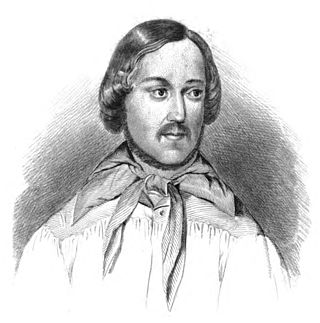 3
Carlo Bini è stato uno scrittore, patriota e traduttore italiano.
3
Carlo Bini è stato uno scrittore, patriota e traduttore italiano.
Cristoforo Landino
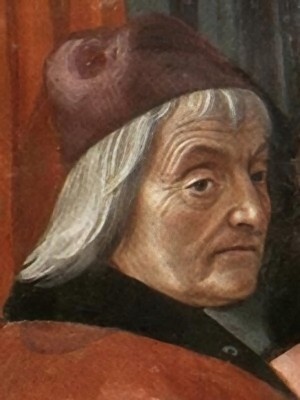 3
Cristoforo Landino was an Italian humanist and an important figure of the Florentine Renaissance.
3
Cristoforo Landino was an Italian humanist and an important figure of the Florentine Renaissance.
Gaspero Barbera
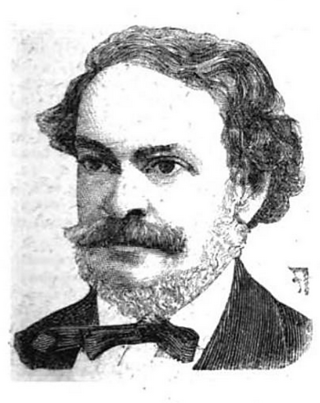 3
Gaspero Barbèra è stato un editore e tipografo italiano.
3
Gaspero Barbèra è stato un editore e tipografo italiano.
Giulio Bechi
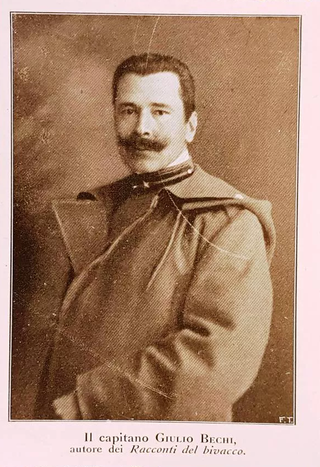 3
Giulio Bechi, noto anche con lo pseudonimo di Miles, è stato un ufficiale e scrittore italiano.
3
Giulio Bechi, noto anche con lo pseudonimo di Miles, è stato un ufficiale e scrittore italiano.
Lucilio Vanini
 3
Lucilio Vanini, who, in his works, styled himself Giulio Cesare Vanini, was an Italian philosopher, physician and free-thinker, who was one of the first significant representatives of intellectual...
3
Lucilio Vanini, who, in his works, styled himself Giulio Cesare Vanini, was an Italian philosopher, physician and free-thinker, who was one of the first significant representatives of intellectual...
Fibonacci
 3
Fibonacci, also known as Leonardo Bonacci, Leonardo of Pisa, or Leonardo Bigollo Pisano, was an Italian mathematician from the Republic of Pisa, considered to be "the most talented Western...
3
Fibonacci, also known as Leonardo Bonacci, Leonardo of Pisa, or Leonardo Bigollo Pisano, was an Italian mathematician from the Republic of Pisa, considered to be "the most talented Western...
Luigi Pulci
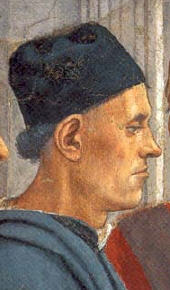 3
Luigi Pulci was an Italian diplomat and poet best known for his Morgante, an epic and parodistic poem about a giant who is converted to Christianity by Orlando and follows the knight in many...
3
Luigi Pulci was an Italian diplomat and poet best known for his Morgante, an epic and parodistic poem about a giant who is converted to Christianity by Orlando and follows the knight in many...
Paolo Mascagni
 3
Paolo Mascagni was an Italian physician and anatomist. He is most well known for publishing the first complete description of the lymphatic system.
3
Paolo Mascagni was an Italian physician and anatomist. He is most well known for publishing the first complete description of the lymphatic system.
Scipione Ammirato
 3
Scipione Ammirato was an Italian author, philosopher and historian who lived during the Renaissance. He is regarded as an important figure in the history of political thought.
3
Scipione Ammirato was an Italian author, philosopher and historian who lived during the Renaissance. He is regarded as an important figure in the history of political thought.
Spinello Aretino
 3
Spinello Aretino was an Italian painter from Arezzo, who was active in Tuscany at the end of the 14th and the first decennium of the 15th century. His style influenced the development of late 14th-...
3
Spinello Aretino was an Italian painter from Arezzo, who was active in Tuscany at the end of the 14th and the first decennium of the 15th century. His style influenced the development of late 14th-...
Pellegrino Artusi
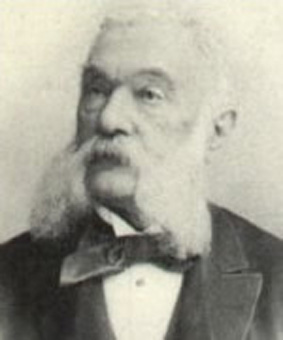 3
Pellegrino Artusi was an Italian businessman and writer, best known as the author of the 1891 cookbook La scienza in cucina e l'arte di mangiar bene.
3
Pellegrino Artusi was an Italian businessman and writer, best known as the author of the 1891 cookbook La scienza in cucina e l'arte di mangiar bene.
Pietro Annigoni
 3
Pietro Annigoni, OMRI was an Italian artist, portrait painter, fresco painter and medallist, best known for his painted portraits of Queen Elizabeth II. His work was in the Renaissance tradition,...
3
Pietro Annigoni, OMRI was an Italian artist, portrait painter, fresco painter and medallist, best known for his painted portraits of Queen Elizabeth II. His work was in the Renaissance tradition,...
Adelina Patti
 3
Adelina Patti was an Italian opera singer. At the height of her career, she was earning huge fees performing in the music capitals of Europe and America. She first sang in public as a child in 1851,...
3
Adelina Patti was an Italian opera singer. At the height of her career, she was earning huge fees performing in the music capitals of Europe and America. She first sang in public as a child in 1851,...
Agostino di Duccio
 3
Agostino di Duccio was an early Renaissance Italian sculptor.
3
Agostino di Duccio was an early Renaissance Italian sculptor.
Antonio Vallisneri
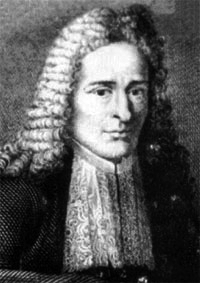 3
Antonio Vallisneri, also rendered as Antonio Vallisnieri, was an Italian medical scientist, physician and naturalist.
3
Antonio Vallisneri, also rendered as Antonio Vallisnieri, was an Italian medical scientist, physician and naturalist.
Ardengo Soffici
 3
Ardengo Soffici was an Italian writer, painter, poet, sculptor and intellectual.
3
Ardengo Soffici was an Italian writer, painter, poet, sculptor and intellectual.
Benedetto da Maiano
 3
Benedetto da Maiano was an Italian Early Renaissance sculptor.
3
Benedetto da Maiano was an Italian Early Renaissance sculptor.
Charles I of Anjou
 3
Charles I, commonly called Charles of Anjou or Charles d'Anjou, was a member of the royal Capetian dynasty and the founder of the second House of Anjou. He was Count of Provence (1246–1285) and...
3
Charles I, commonly called Charles of Anjou or Charles d'Anjou, was a member of the royal Capetian dynasty and the founder of the second House of Anjou. He was Count of Provence (1246–1285) and...
Ermanno Wolf-Ferrari
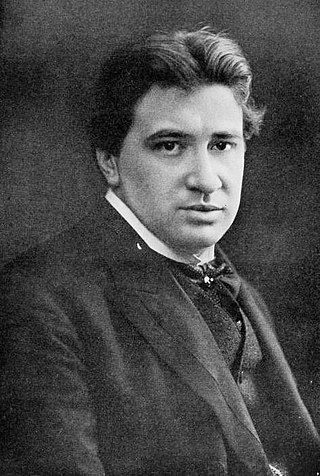 3
Ermanno Wolf-Ferrari was an Italian composer and teacher. He is best known for his comic operas such as Il segreto di Susanna (1909). A number of his works were based on plays by Carlo Goldoni,...
3
Ermanno Wolf-Ferrari was an Italian composer and teacher. He is best known for his comic operas such as Il segreto di Susanna (1909). A number of his works were based on plays by Carlo Goldoni,...
Ferdinando Paolieri
 3
Ferdinando Paolieri è stato uno scrittore, poeta e commediografo italiano.
3
Ferdinando Paolieri è stato uno scrittore, poeta e commediografo italiano.
Francesco Furini
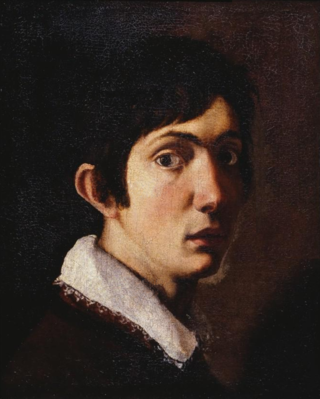 3
Francesco Furini was an Italian Baroque painter of Florence, noted for his sensual sfumato style in paintings of both secular and religious subjects.
3
Francesco Furini was an Italian Baroque painter of Florence, noted for his sensual sfumato style in paintings of both secular and religious subjects.
Francesco Geminiani
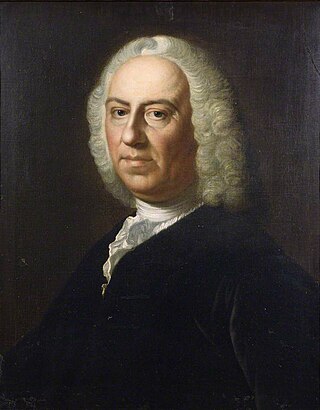 3
Francesco Xaverio Geminiani was an Italian violinist, composer, and music theorist. BBC Radio 3 once described him as "now largely forgotten, but in his time considered almost a musical god, deemed...
3
Francesco Xaverio Geminiani was an Italian violinist, composer, and music theorist. BBC Radio 3 once described him as "now largely forgotten, but in his time considered almost a musical god, deemed...
Giovanni Sgambati
 3
Giovanni Sgambati was an Italian pianist and composer.
3
Giovanni Sgambati was an Italian pianist and composer.
Girolamo Fracastoro
 3
Girolamo Fracastoro was an Italian physician, poet, and scholar in mathematics, geography and astronomy. Fracastoro subscribed to the philosophy of atomism, and rejected appeals to hidden causes in...
3
Girolamo Fracastoro was an Italian physician, poet, and scholar in mathematics, geography and astronomy. Fracastoro subscribed to the philosophy of atomism, and rejected appeals to hidden causes in...
Guido Guerra
 3
Guido Guerra V (1220-1272) was a politician from Florence, Italy. Aligned with the Guelph faction, Guerra had a prominent role in the political conflicts of mid-thirteenth century Tuscany. He was...
3
Guido Guerra V (1220-1272) was a politician from Florence, Italy. Aligned with the Guelph faction, Guerra had a prominent role in the political conflicts of mid-thirteenth century Tuscany. He was...
Lapo Gianni
 3
Lapo Gianni was an Italian poet who lived in Florence in the 13th-14th centuries. He was a member of the Florentine circle of the Italian movement called Dolce Stil Novo, and was probably a notary....
3
Lapo Gianni was an Italian poet who lived in Florence in the 13th-14th centuries. He was a member of the Florentine circle of the Italian movement called Dolce Stil Novo, and was probably a notary....
Libero Andreotti
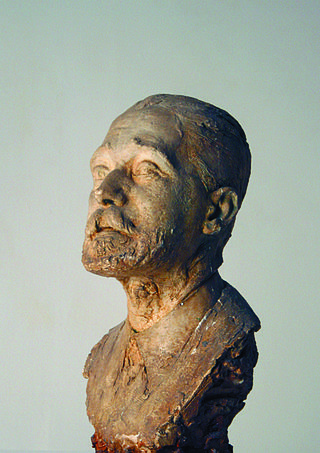 3
Libero Andreotti was an Italian artist and educator, known as a sculptor, illustrator, and ceramics artist. He is often referred to as, "one of the foremost artists and sculptors of the...
3
Libero Andreotti was an Italian artist and educator, known as a sculptor, illustrator, and ceramics artist. He is often referred to as, "one of the foremost artists and sculptors of the...
Luca Giordano
 3
Luca Giordano was an Italian late-Baroque painter and printmaker in etching. Fluent and decorative, he worked successfully in Naples, Rome, Florence, and Venice, before spending a decade in Spain.
3
Luca Giordano was an Italian late-Baroque painter and printmaker in etching. Fluent and decorative, he worked successfully in Naples, Rome, Florence, and Venice, before spending a decade in Spain.
Maria Malibran
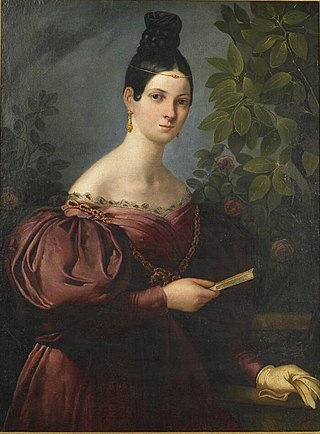 3
Maria Felicia Malibran was a Spanish singer who commonly sang both contralto and soprano parts, and was one of the best-known opera singers of the 19th century. Malibran was known for her stormy...
3
Maria Felicia Malibran was a Spanish singer who commonly sang both contralto and soprano parts, and was one of the best-known opera singers of the 19th century. Malibran was known for her stormy...
Mario Calderara
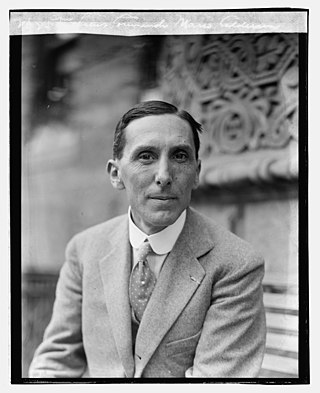 3
Mario Calderara è stato un inventore e aviatore italiano.
3
Mario Calderara è stato un inventore e aviatore italiano.
Nino Oxilia
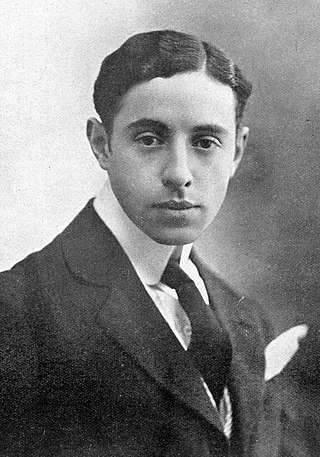 3
Nino Oxilia was an Italian playwright, screenwriter and film director. His 1911 play Goodbye Youth was turned into several films. He also wrote the first lyrics for the song "Giovinezza" in 1909. He...
3
Nino Oxilia was an Italian playwright, screenwriter and film director. His 1911 play Goodbye Youth was turned into several films. He also wrote the first lyrics for the song "Giovinezza" in 1909. He...
Ottaviano-Fabrizio Mossotti
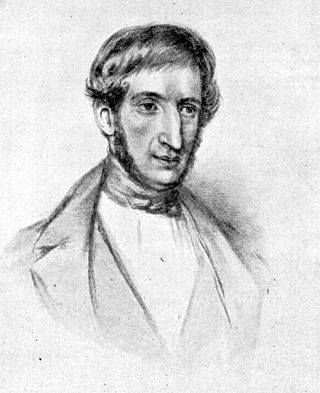 3
Ottaviano-Fabrizio Mossotti was an Italian physicist who was exiled from Italy for his liberal ideas. During the First Italian War of Independence he led a "battalion of students," part of a...
3
Ottaviano-Fabrizio Mossotti was an Italian physicist who was exiled from Italy for his liberal ideas. During the First Italian War of Independence he led a "battalion of students," part of a...
Raffaello Sernesi
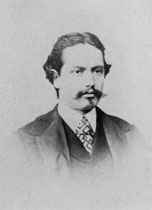 3
Raffaello Sernesi was an Italian painter and medallist associated with the Macchiaioli group.
3
Raffaello Sernesi was an Italian painter and medallist associated with the Macchiaioli group.
Ruggero Ruggeri
 3
Ruggero Ruggeri was an Italian stage and film actor. Ruggeri was a celebrated theatre actor, appearing alongside Lyda Borelli on stage in 1909. From 1914 onward he sporadically made films in both the...
3
Ruggero Ruggeri was an Italian stage and film actor. Ruggeri was a celebrated theatre actor, appearing alongside Lyda Borelli on stage in 1909. From 1914 onward he sporadically made films in both the...
Ferdinando Zannetti
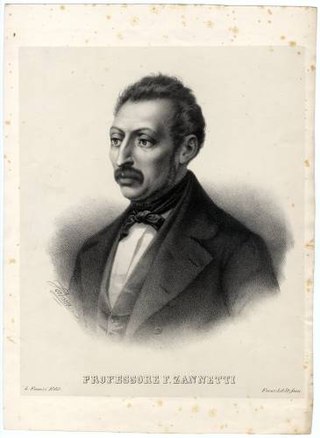 3
Ferdinando Zannetti è stato un medico e chirurgo italiano.
È soprattutto famoso per aver curato la gamba di Giuseppe Garibaldi.
3
Ferdinando Zannetti è stato un medico e chirurgo italiano.
È soprattutto famoso per aver curato la gamba di Giuseppe Garibaldi.
Pietro Grocco
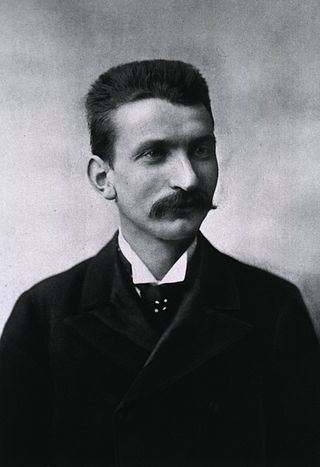 3
Pietro Grocco was an Italian physician.
3
Pietro Grocco was an Italian physician.
Francesco Carletti
 3
Francesco Carletti (1573–1636) was a Florentine merchant, explorer and writer.
3
Francesco Carletti (1573–1636) was a Florentine merchant, explorer and writer.
Piero Capponi
 3
Piero Capponi was an Italian statesman and military leader from Florence; he is celebrated for his bold defiance of the King of France in 1494.
3
Piero Capponi was an Italian statesman and military leader from Florence; he is celebrated for his bold defiance of the King of France in 1494.
Pietro Thouar
 3
Pietro Thouar è stato uno scrittore italiano.
3
Pietro Thouar è stato uno scrittore italiano.
Stefano Ussi
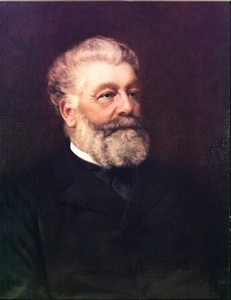 3
Stefano Ussi was an Italian painter, known first for his history paintings, and later for depicting Orientalist, mostly Arabian and Moroccan subjects.
3
Stefano Ussi was an Italian painter, known first for his history paintings, and later for depicting Orientalist, mostly Arabian and Moroccan subjects.
Odoardo Borrani
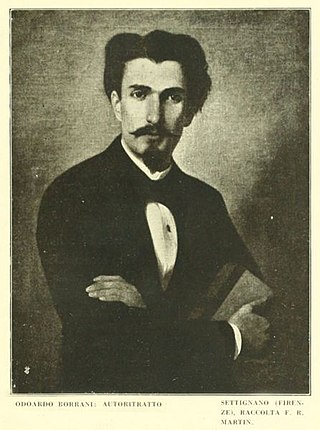 3
Odoardo Borrani was an Italian painter associated with the Macchiaioli group.
3
Odoardo Borrani was an Italian painter associated with the Macchiaioli group.
Niccolò Piccinni
 3
Niccolò Piccinni was an Italian composer of symphonies, sacred music, chamber music, and opera. Although he is somewhat obscure today, Piccinni was one of the most popular composers of...
3
Niccolò Piccinni was an Italian composer of symphonies, sacred music, chamber music, and opera. Although he is somewhat obscure today, Piccinni was one of the most popular composers of...
Francesco Zambeccari
 3
Count Francesco Zambeccari was an Italian aviation pioneer. He was killed in a ballooning accident.
3
Count Francesco Zambeccari was an Italian aviation pioneer. He was killed in a ballooning accident.
Mario de Bernardi
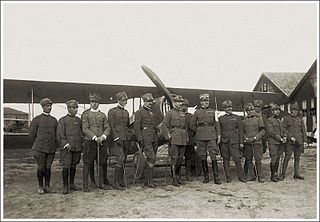 3
Mario de Bernardi (1893–1959) was an Italian World War I fighter pilot, seaplane air racer of the 1920s, and test pilot of early Italian experimental jets.
3
Mario de Bernardi (1893–1959) was an Italian World War I fighter pilot, seaplane air racer of the 1920s, and test pilot of early Italian experimental jets.
Liborio Romano
 3
Liborio Romano was an Italian politician.
3
Liborio Romano was an Italian politician.
Giuseppe Di Vagno
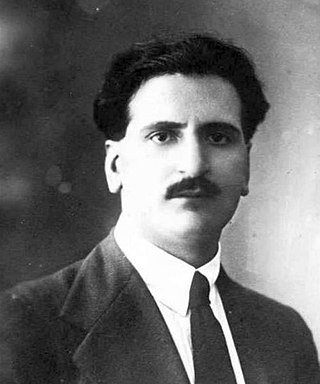 3
Giuseppe Di Vagno è stato un politico italiano, primo parlamentare italiano vittima del fascismo.
3
Giuseppe Di Vagno è stato un politico italiano, primo parlamentare italiano vittima del fascismo.
Konrad Adenauer
 3
Konrad Hermann Joseph Adenauer was a German statesman who served as the first chancellor of the Federal Republic of Germany from 1949 to 1963. From 1946 to 1966, he was the first leader of the...
3
Konrad Hermann Joseph Adenauer was a German statesman who served as the first chancellor of the Federal Republic of Germany from 1949 to 1963. From 1946 to 1966, he was the first leader of the...
Giuseppe Longhi
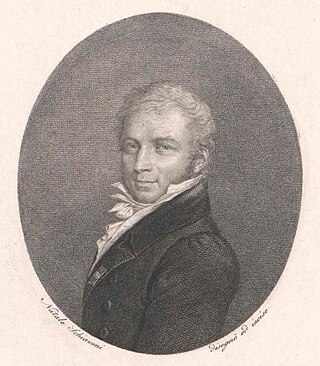 3
Giuseppe Maria Longhi was an Italian painter and engraver, in the Neo-Classical style.
3
Giuseppe Maria Longhi was an Italian painter and engraver, in the Neo-Classical style.
Antonio Cantore
 3
Antonio Tomaso Cantore è stato un generale italiano, comandante di battaglione durante la guerra italo-turca; divenne generale di divisione allo scoppio della prima guerra mondiale. Fu colpito a...
3
Antonio Tomaso Cantore è stato un generale italiano, comandante di battaglione durante la guerra italo-turca; divenne generale di divisione allo scoppio della prima guerra mondiale. Fu colpito a...
Giuseppe Palmieri
 3
Giuseppe Palmieri may refer to:Giuseppe Palmieri (athlete) (1902-1989), Italian high jumper and javelin thrower
Giuseppe Palmieri (economist) (1721–1793), Italian economist and politician of the 18th...
3
Giuseppe Palmieri may refer to:Giuseppe Palmieri (athlete) (1902-1989), Italian high jumper and javelin thrower
Giuseppe Palmieri (economist) (1721–1793), Italian economist and politician of the 18th...
Dante Di Nanni
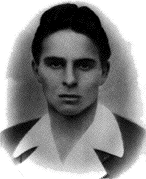 3
Dante Di Nanni è stato un partigiano italiano, insignito della Medaglia d'oro al valor militare.
3
Dante Di Nanni è stato un partigiano italiano, insignito della Medaglia d'oro al valor militare.
Giovanni Guidiccioni
 3
Giovanni Guidiccioni was an Italian poet and a Catholic bishop of Fossombrone.
3
Giovanni Guidiccioni was an Italian poet and a Catholic bishop of Fossombrone.
Raffaele Merelli
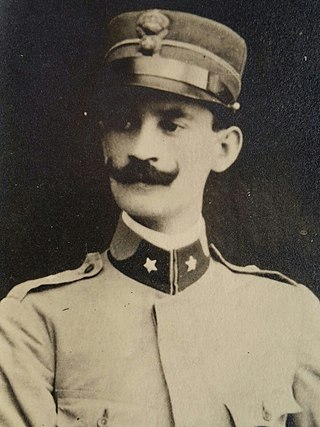 3
Raffaele Merelli è stato un militare italiano, insignito della Medaglia d'oro al valor militare alla memoria per il coraggio dimostrato in combattimento durante l'ottava battaglia dell'Isonzo.
3
Raffaele Merelli è stato un militare italiano, insignito della Medaglia d'oro al valor militare alla memoria per il coraggio dimostrato in combattimento durante l'ottava battaglia dell'Isonzo.
Benigno Crespi
 3
Benigno Crespi è stato un imprenditore italiano.
3
Benigno Crespi è stato un imprenditore italiano.
Giuseppe Castelli
 3
Giuseppe Castelli was an Italian athlete who competed mainly in the 100 metres.
3
Giuseppe Castelli was an Italian athlete who competed mainly in the 100 metres.
Luigi Gabelli
 3
Luigi Gabelli è stato un militare e aviatore italiano, decorato di Medaglia d'oro al valor militare alla memoria nel corso delle operazioni di stabilizzazione dell'Africa Orientale Italiana.
3
Luigi Gabelli è stato un militare e aviatore italiano, decorato di Medaglia d'oro al valor militare alla memoria nel corso delle operazioni di stabilizzazione dell'Africa Orientale Italiana.
Jacopo Durandi
 3
Jacopo Durandi è stato un giurista, drammaturgo e storico italiano.
3
Jacopo Durandi è stato un giurista, drammaturgo e storico italiano.
Egidio Meneghetti
 3
Egidio Meneghetti was an Italian pharmacologist, professor at the University of Padua, and a part of the anti-fascist resistance movement. He contributed to studies on the injection of colloidal...
3
Egidio Meneghetti was an Italian pharmacologist, professor at the University of Padua, and a part of the anti-fascist resistance movement. He contributed to studies on the injection of colloidal...
Diodorus Siculus
 3
Diodorus Siculus or Diodorus of Sicily was an ancient Greek historian. He is known for writing the monumental universal history Bibliotheca historica, in forty books, fifteen of which survive intact,...
3
Diodorus Siculus or Diodorus of Sicily was an ancient Greek historian. He is known for writing the monumental universal history Bibliotheca historica, in forty books, fifteen of which survive intact,...
Rita Atria
 3
Rita Atria was a witness and key collaborator in a major Mafia investigation in Sicily. She committed suicide in July 1992, a week after Cosa Nostra killed prosecutor Paolo Borsellino, with whom she...
3
Rita Atria was a witness and key collaborator in a major Mafia investigation in Sicily. She committed suicide in July 1992, a week after Cosa Nostra killed prosecutor Paolo Borsellino, with whom she...
Achille Bizzoni
 3
Achille Bizzoni è stato un giornalista, scrittore e patriota italiano.
3
Achille Bizzoni è stato un giornalista, scrittore e patriota italiano.
Achille Torelli
 3
Achille Torelli was an Italian playwright.
3
Achille Torelli was an Italian playwright.
Agostino Codazzi
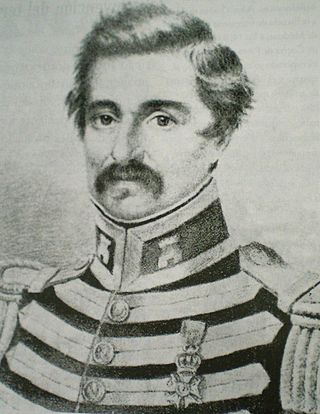 3
Giovanni Battista Agostino Codazzi was an Italo-Venezuelan soldier, scientist, geographer, cartographer, and governor of Barinas (1846–1847). He made his main investigations and cartographic work in...
3
Giovanni Battista Agostino Codazzi was an Italo-Venezuelan soldier, scientist, geographer, cartographer, and governor of Barinas (1846–1847). He made his main investigations and cartographic work in...
Alejandro Malaspina
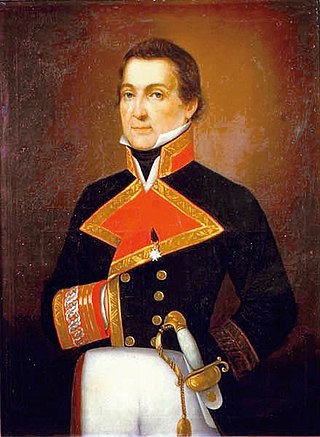 3
Alejandro Malaspina was a Tuscan explorer who spent most of his life as a Spanish naval officer. Under a Spanish royal commission, he undertook a voyage around the world from 1786 to 1788, then, from...
3
Alejandro Malaspina was a Tuscan explorer who spent most of his life as a Spanish naval officer. Under a Spanish royal commission, he undertook a voyage around the world from 1786 to 1788, then, from...
Ernesto Ragazzoni
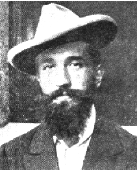 3
Ernesto Ragazzoni è stato un poeta, traduttore e giornalista italiano.
3
Ernesto Ragazzoni è stato un poeta, traduttore e giornalista italiano.
Felice Giani
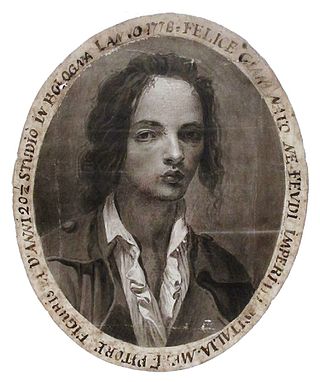 3
Felice Giani was an Italian painter of the Neoclassic style. His grand manner subjects often included Greco-Roman allusions or themes.
3
Felice Giani was an Italian painter of the Neoclassic style. His grand manner subjects often included Greco-Roman allusions or themes.
Giovanni Vincenzo Gravina
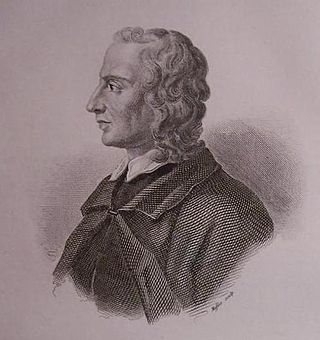 3
Giovanni Vincenzo Gravina was an Italian man of letters and jurist. He was born at Roggiano Gravina, a small town near Cosenza, in Calabria. He was the adoptive father of the poet Metastasio.
3
Giovanni Vincenzo Gravina was an Italian man of letters and jurist. He was born at Roggiano Gravina, a small town near Cosenza, in Calabria. He was the adoptive father of the poet Metastasio.
Giuseppe Guerzoni
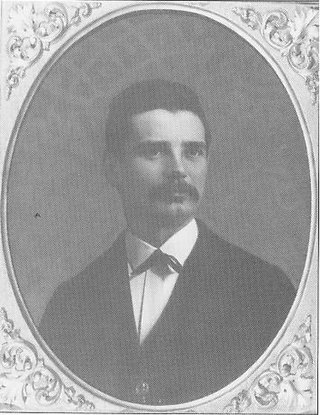 3
Giuseppe Guerzoni è stato un patriota, politico, storico, scrittore e drammaturgo italiano, il maggiore biografo di Giuseppe Garibaldi.
3
Giuseppe Guerzoni è stato un patriota, politico, storico, scrittore e drammaturgo italiano, il maggiore biografo di Giuseppe Garibaldi.
William Tell (opera)
 3
William Tell is a French-language opera in four acts by Italian composer Gioachino Rossini to a libretto by Victor-Joseph Étienne de Jouy and L. F. Bis, based on Friedrich Schiller's play Wilhelm...
3
William Tell is a French-language opera in four acts by Italian composer Gioachino Rossini to a libretto by Victor-Joseph Étienne de Jouy and L. F. Bis, based on Friedrich Schiller's play Wilhelm...
Muzio Attendolo Sforza
 3
Muzio Attendolo Sforza, was an Italian condottiero. Founder of the Sforza dynasty, he led a Bolognese-Florentine army at the Battle of Casalecchio.
3
Muzio Attendolo Sforza, was an Italian condottiero. Founder of the Sforza dynasty, he led a Bolognese-Florentine army at the Battle of Casalecchio.
Vincenzo Manzini
 3
Vincenzo Manzini è stato un giurista italiano.
3
Vincenzo Manzini è stato un giurista italiano.
Giulio Perticari
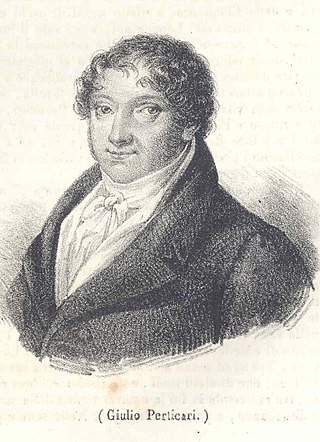 3
Giulio Perticari was an Italian poet and scholar.
3
Giulio Perticari was an Italian poet and scholar.
Baruch Spinoza
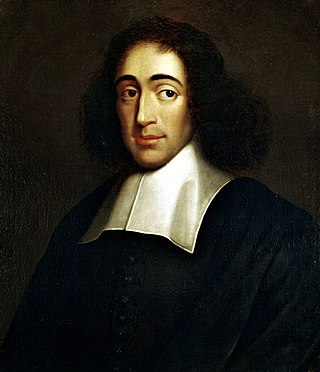 3
Baruch (de) Spinoza, also known under his Latinized pen name Benedictus de Spinoza, was a philosopher of Portuguese-Jewish origin. As a forerunner of the Age of Reason, Spinoza significantly...
3
Baruch (de) Spinoza, also known under his Latinized pen name Benedictus de Spinoza, was a philosopher of Portuguese-Jewish origin. As a forerunner of the Age of Reason, Spinoza significantly...
Guglielmo Calderini
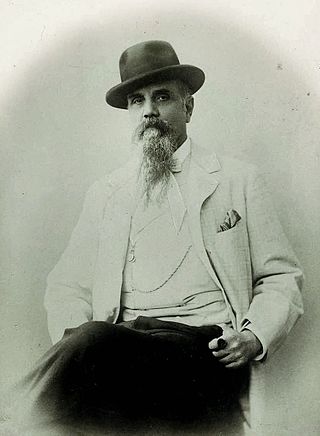 3
Guglielmo Calderini è stato un architetto italiano.
3
Guglielmo Calderini è stato un architetto italiano.
Lorenzo Valla
 3
Lorenzo Valla was an Italian Renaissance humanist, rhetorician, educator and scholar. He is best known for his historical-critical textual analysis that proved that the Donation of Constantine was a...
3
Lorenzo Valla was an Italian Renaissance humanist, rhetorician, educator and scholar. He is best known for his historical-critical textual analysis that proved that the Donation of Constantine was a...
Luigi Poletti (architect)
 3
Luigi Poletti was an Italian architect, active in a neoclassical style.
3
Luigi Poletti was an Italian architect, active in a neoclassical style.
Marco Palmezzano
Bertrando Spaventa
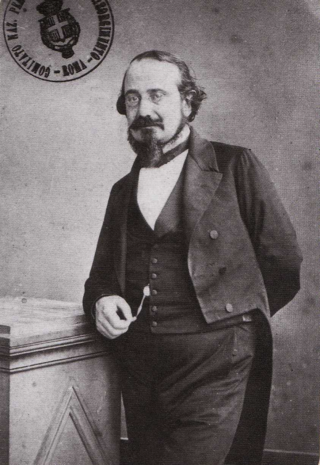 3
Bertrando Spaventa was a leading Italian philosopher of the 19th century whose ideas had an important influence on the changes that took place during the unification of Italy and on philosophical...
3
Bertrando Spaventa was a leading Italian philosopher of the 19th century whose ideas had an important influence on the changes that took place during the unification of Italy and on philosophical...
Francesco Rosi
 3
Francesco Rosi was an Italian film director. His film The Mattei Affair won the Palme d'Or at the 1972 Cannes Film Festival. Rosi's films, especially those of the 1960s and 1970s, often appeared to...
3
Francesco Rosi was an Italian film director. His film The Mattei Affair won the Palme d'Or at the 1972 Cannes Film Festival. Rosi's films, especially those of the 1960s and 1970s, often appeared to...
Giovanni Meli
 3
Giovanni Meli was an Italian poet.
3
Giovanni Meli was an Italian poet.
Trajano Boccalini
 3
Trajano Boccalini was an Italian satirist.
3
Trajano Boccalini was an Italian satirist.
Marcello Dudovich
André Masséna
 3
André Masséna, Prince of Essling, Duke of Rivoli, was a French military commander during the French Revolutionary Wars and the Napoleonic Wars. He was one of the original 18 Marshals of the Empire...
3
André Masséna, Prince of Essling, Duke of Rivoli, was a French military commander during the French Revolutionary Wars and the Napoleonic Wars. He was one of the original 18 Marshals of the Empire...
Bartolomeo Panizza
 3
Bartolomeo Panizza was an Italian anatomist born in Vicenza.
3
Bartolomeo Panizza was an Italian anatomist born in Vicenza.
Adeodato Ressi
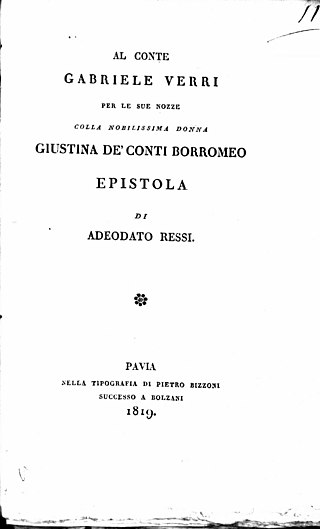 3
Il conte Adeodato Ressi è stato un economista e patriota italiano.
3
Il conte Adeodato Ressi è stato un economista e patriota italiano.
Pietro Tamburini
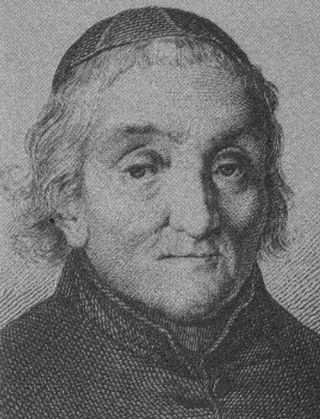 3
Pietro Tamburini was an Italian theologian and jurist. He openly espoused Jansenism as a university professor.
3
Pietro Tamburini was an Italian theologian and jurist. He openly espoused Jansenism as a university professor.
Agostino Bassi
 3
Agostino Bassi, sometimes called de Lodi, was an Italian entomologist. He preceded Louis Pasteur in the discovery that microorganisms can be the cause of disease. He discovered that the muscardine...
3
Agostino Bassi, sometimes called de Lodi, was an Italian entomologist. He preceded Louis Pasteur in the discovery that microorganisms can be the cause of disease. He discovered that the muscardine...
Caterina Sforza
 3
Caterina Sforza was an Italian noblewoman, the Countess of Forlì and Lady of Imola, firstly with her husband Girolamo Riario, and after his death as a regent of her son Ottaviano.
3
Caterina Sforza was an Italian noblewoman, the Countess of Forlì and Lady of Imola, firstly with her husband Girolamo Riario, and after his death as a regent of her son Ottaviano.
Placido Rizzotto
 3
Placido Rizzotto was an Italian partisan, socialist peasant and trade union leader from Corleone, who was kidnapped and murdered by Sicilian Mafia boss Luciano Leggio on 10 March 1948. Before he was...
3
Placido Rizzotto was an Italian partisan, socialist peasant and trade union leader from Corleone, who was kidnapped and murdered by Sicilian Mafia boss Luciano Leggio on 10 March 1948. Before he was...
Philomena
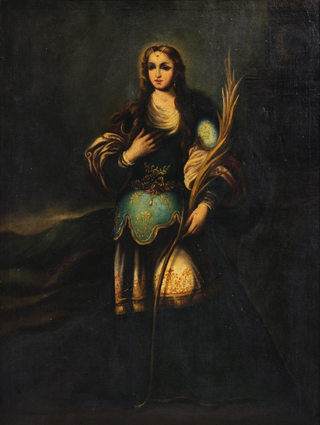 3
Philomena, also known as Saint Philomena or Philomena of Rome was a virgin martyr whose remains were discovered on May 24–25, 1802, in the Catacomb of Priscilla. Three tiles enclosing the tomb bore...
3
Philomena, also known as Saint Philomena or Philomena of Rome was a virgin martyr whose remains were discovered on May 24–25, 1802, in the Catacomb of Priscilla. Three tiles enclosing the tomb bore...
Paul Cézanne
 3
Paul Cézanne was a French Post-Impressionist painter whose work introduced new modes of representation and influenced avant-garde artistic movements of the early 20th century. Cézanne is said to have...
3
Paul Cézanne was a French Post-Impressionist painter whose work introduced new modes of representation and influenced avant-garde artistic movements of the early 20th century. Cézanne is said to have...
Joan Miró
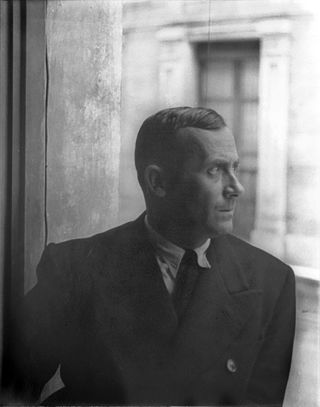 3
Joan Miró i Ferrà was a Catalan Spanish painter, sculptor and ceramist born in Barcelona. Professionally, he was simply known as Joan Miró. A museum dedicated to his work, the Fundació Joan Miró, was...
3
Joan Miró i Ferrà was a Catalan Spanish painter, sculptor and ceramist born in Barcelona. Professionally, he was simply known as Joan Miró. A museum dedicated to his work, the Fundació Joan Miró, was...
Meuccio Ruini
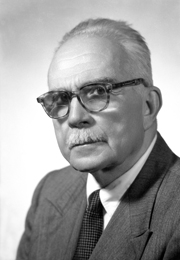 3
Meuccio Ruini was an Italian jurist and socialist politician who served as the president of the Italian Senate and the minister of the colonies.
3
Meuccio Ruini was an Italian jurist and socialist politician who served as the president of the Italian Senate and the minister of the colonies.
Giulio Douhet
 3
General Giulio Douhet was an Italian general and air power theorist. He was a key proponent of strategic bombing in aerial warfare. He was a contemporary of the air warfare advocates Walther Wever,...
3
General Giulio Douhet was an Italian general and air power theorist. He was a key proponent of strategic bombing in aerial warfare. He was a contemporary of the air warfare advocates Walther Wever,...
Giorgio Paglia
 3
Giorgio Paglia è stato un patriota, partigiano e antifascista italiano, Medaglia d'oro al valor militare alla memoria.
3
Giorgio Paglia è stato un patriota, partigiano e antifascista italiano, Medaglia d'oro al valor militare alla memoria.
Gabriele Falloppio
 3
Gabriele Falloppio was an Italian priest and anatomist often known by his Latin name Fallopius. He was one of the most important anatomists and physicians of the sixteenth century, giving his name to...
3
Gabriele Falloppio was an Italian priest and anatomist often known by his Latin name Fallopius. He was one of the most important anatomists and physicians of the sixteenth century, giving his name to...
Francesco Perotti
 3
Francesco Perotti è stato un pittore italiano.
3
Francesco Perotti è stato un pittore italiano.
Gioacchino Napoleone Pepoli
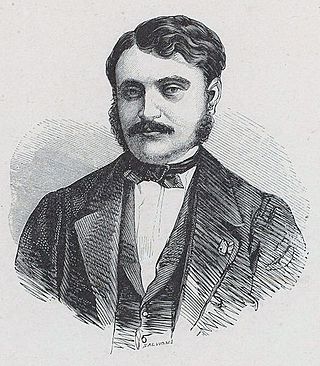 3
Gioacchino Napoleone Pepoli è stato un diplomatico, scrittore e politico italiano, senatore del Regno d'Italia e sindaco di Bologna.
3
Gioacchino Napoleone Pepoli è stato un diplomatico, scrittore e politico italiano, senatore del Regno d'Italia e sindaco di Bologna.
Paolo Ruffini
 3
Paolo Ruffini was an Italian mathematician and philosopher.
3
Paolo Ruffini was an Italian mathematician and philosopher.
Giuseppe Pella
 3
Giuseppe Pella was an Italian Christian Democratic politician who served as the 31st prime minister of Italy from 1953 to 1954. He was also Minister of Treasury, Budget and of Foreign Affairs during...
3
Giuseppe Pella was an Italian Christian Democratic politician who served as the 31st prime minister of Italy from 1953 to 1954. He was also Minister of Treasury, Budget and of Foreign Affairs during...
Carlo Felice Trossi
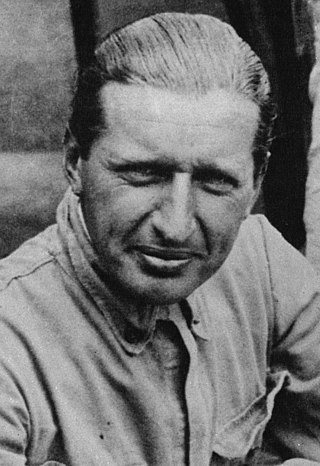 3
Count Carlo Felice Trossi di Pian Villar was an Italian racing driver and auto constructor.
3
Count Carlo Felice Trossi di Pian Villar was an Italian racing driver and auto constructor.
Ennio Carando
 3
Ennio Carando è stato un partigiano e filosofo italiano.
Medaglia d'Oro al Valor Militare alla memoria.
3
Ennio Carando è stato un partigiano e filosofo italiano.
Medaglia d'Oro al Valor Militare alla memoria.
Antioco Zucca
 3
Antioco Zucca è stato un filosofo italiano.
3
Antioco Zucca è stato un filosofo italiano.
Flavio Busonera
 3
Flavio Busonera è stato un partigiano italiano.
3
Flavio Busonera è stato un partigiano italiano.
Giuseppe Morosini
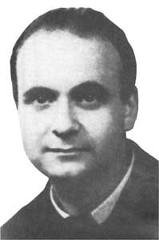 3
Giuseppe Morosini was an Italian priest and partisan. He was ordained to the sacred priesthood in 1937 at St. John Lateran's Basilica, becoming chaplain of the Royal Italian Army's 4th Artillery...
3
Giuseppe Morosini was an Italian priest and partisan. He was ordained to the sacred priesthood in 1937 at St. John Lateran's Basilica, becoming chaplain of the Royal Italian Army's 4th Artillery...
William I of Cagliari
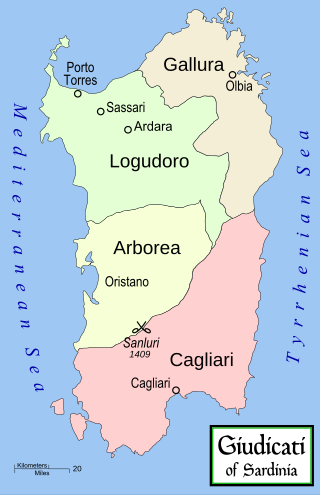 3
William I, royal name Salusio IV, was the judike of Cagliari, meaning "King", from 1188 to his death. His descendants and those of his immediate competitors intermarried to form the backbone of the...
3
William I, royal name Salusio IV, was the judike of Cagliari, meaning "King", from 1188 to his death. His descendants and those of his immediate competitors intermarried to form the backbone of the...
Francesco Verrotti
 3
Francesco Verrotti è stato un militare italiano, insignito della medaglia d'oro al valor militare alla memoria nel corso delle seconda guerra mondiale.
3
Francesco Verrotti è stato un militare italiano, insignito della medaglia d'oro al valor militare alla memoria nel corso delle seconda guerra mondiale.
Dario Chiaradia
 3
Dario Chiaradia è stato un militare italiano insignito della medaglia d'oro al valor militare alla memoria nel corso della seconda guerra mondiale.
3
Dario Chiaradia è stato un militare italiano insignito della medaglia d'oro al valor militare alla memoria nel corso della seconda guerra mondiale.
Angelo Scarsellini
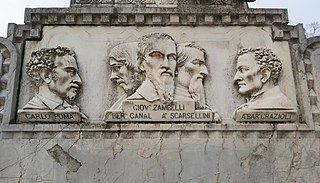 3
Angelo Scarsellini è stato un patriota italiano, uno dei famosi Martiri di Belfiore.
3
Angelo Scarsellini è stato un patriota italiano, uno dei famosi Martiri di Belfiore.
Santa Marcellina
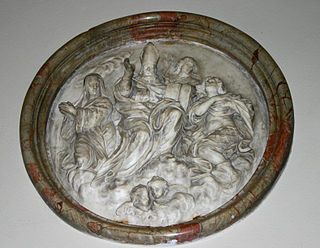 3
Santa Marcellina sorella maggiore di Ambrogio e di Satiro, si dedicò alla preghiera e alle opere di carità. È venerata come santa dalla Chiesa cattolica.
3
Santa Marcellina sorella maggiore di Ambrogio e di Satiro, si dedicò alla preghiera e alle opere di carità. È venerata come santa dalla Chiesa cattolica.
Pietro Cavaro
 3
Pietro Cavaro è stato un pittore italiano, considerato il massimo rappresentante della cosiddetta "Scuola Stampacina", importante bottega di pittura sarda che prende il nome dal quartiere storico di...
3
Pietro Cavaro è stato un pittore italiano, considerato il massimo rappresentante della cosiddetta "Scuola Stampacina", importante bottega di pittura sarda che prende il nome dal quartiere storico di...
Frances Xavier Cabrini
 3
Frances Xavier Cabrini, also known as Mother Cabrini, was an Italian-American Catholic religious sister. She founded the Missionary Sisters of the Sacred Heart of Jesus, a religious institute that...
3
Frances Xavier Cabrini, also known as Mother Cabrini, was an Italian-American Catholic religious sister. She founded the Missionary Sisters of the Sacred Heart of Jesus, a religious institute that...
Giovanni Polvani
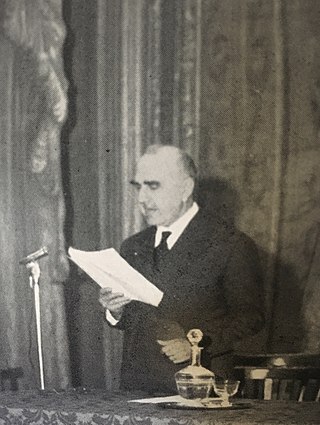 3
Giovanni Polvani è stato un fisico italiano.
3
Giovanni Polvani è stato un fisico italiano.
Ippolito Caffi
 3
Ippolito Caffi (1809–1866) was an Italian painter of architectural subjects and seascapes or urban vedute.
3
Ippolito Caffi (1809–1866) was an Italian painter of architectural subjects and seascapes or urban vedute.
Giuseppe Borsalino
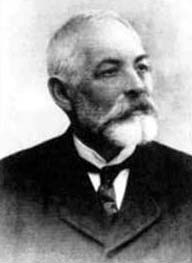 3
Giuseppe Borsalino è stato un artigiano e imprenditore italiano, il 4 aprile 1857 fondò ad Alessandria la manifattura Borsalino Giuseppe e Fratello. Oltre che grande e innovativo imprenditore,...
3
Giuseppe Borsalino è stato un artigiano e imprenditore italiano, il 4 aprile 1857 fondò ad Alessandria la manifattura Borsalino Giuseppe e Fratello. Oltre che grande e innovativo imprenditore,...
Luigi Devoto
 3
Luigi Devoto è stato un medico e politico italiano ed è considerato uno dei fondatori a livello mondiale della moderna medicina del lavoro. Era padre del linguista Giacomo Devoto (1897-1974), di...
3
Luigi Devoto è stato un medico e politico italiano ed è considerato uno dei fondatori a livello mondiale della moderna medicina del lavoro. Era padre del linguista Giacomo Devoto (1897-1974), di...
Cesare Tallone
 3
Cesare Tallone was an Italian painter.
3
Cesare Tallone was an Italian painter.
Ottavio Assarotti
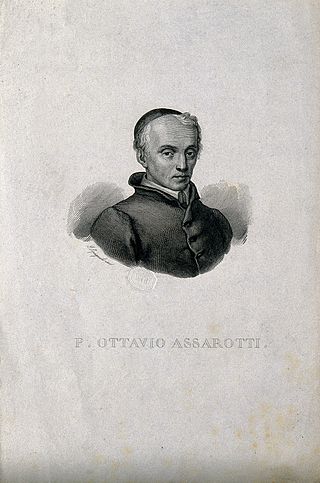 3
Ottavio Giovanni Battista Assarotti was an Italian philanthropist and founder of the first school for deaf people in Italy.
3
Ottavio Giovanni Battista Assarotti was an Italian philanthropist and founder of the first school for deaf people in Italy.
Pope Pius IX
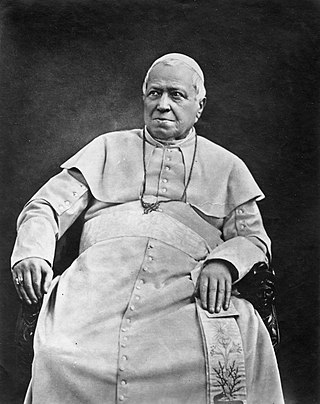 3
Pope Pius IX was head of the Catholic Church from 1846 to 1878. His reign of 32 years is the second longest of any pope in history, behind that of Saint Peter. He was notable for convoking the First...
3
Pope Pius IX was head of the Catholic Church from 1846 to 1878. His reign of 32 years is the second longest of any pope in history, behind that of Saint Peter. He was notable for convoking the First...
Ferdinando di Savoia-Genova (generale)
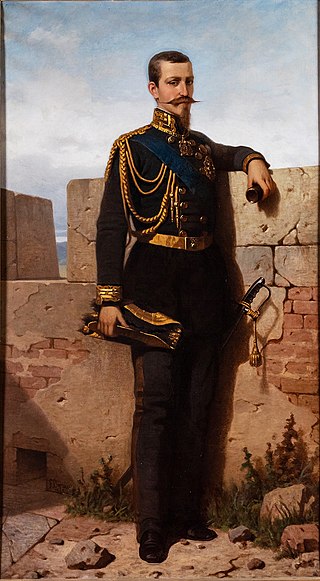 3
Ferdinando Maria Alberto Amedeo Filiberto Vincenzo di Savoia, I duca di Genova, è stato un nobile e militare italiano, capostipite del ramo cadetto dei Savoia-Genova.
3
Ferdinando Maria Alberto Amedeo Filiberto Vincenzo di Savoia, I duca di Genova, è stato un nobile e militare italiano, capostipite del ramo cadetto dei Savoia-Genova.
Sebastiano Bombelli
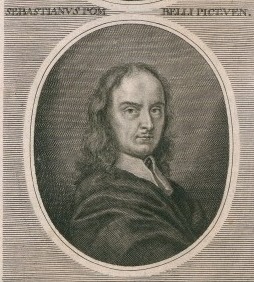 3
Sebastiano Bombelli was an Italian painter, mainly active in Venice, during the Baroque period.
3
Sebastiano Bombelli was an Italian painter, mainly active in Venice, during the Baroque period.
Aurelio Mistruzzi
 3
Aurelio Mistruzzi è stato uno scultore e medaglista italiano.
3
Aurelio Mistruzzi è stato uno scultore e medaglista italiano.
Giusto Gervasutti
 3
Giusto Gervasutti was an Italian mountain climber, Alpini officer and skier.
3
Giusto Gervasutti was an Italian mountain climber, Alpini officer and skier.
Paolo Rossi
 3
Paolo Rossi was an Italian professional footballer who played as a forward. He led Italy to the 1982 FIFA World Cup title, scoring six goals to win the Golden Boot as top goalscorer, and the Golden...
3
Paolo Rossi was an Italian professional footballer who played as a forward. He led Italy to the 1982 FIFA World Cup title, scoring six goals to win the Golden Boot as top goalscorer, and the Golden...
Cecilia Deganutti
Silvio Vardabasso
 3
Silvio Vardabasso è stato un geologo italiano.
3
Silvio Vardabasso è stato un geologo italiano.
Antonio Somma
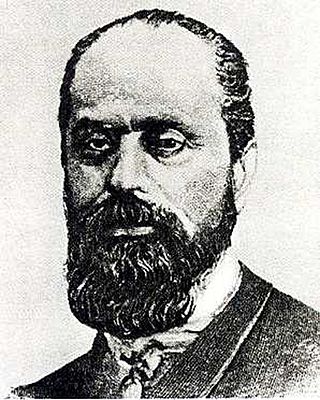 3
Antonio Somma was an Italian playwright who is most well known for writing the libretto of an opera which ultimately became Giuseppe Verdi's Un ballo in maschera in 1859. While a student, his...
3
Antonio Somma was an Italian playwright who is most well known for writing the libretto of an opera which ultimately became Giuseppe Verdi's Un ballo in maschera in 1859. While a student, his...
Giuseppe Bernardino Bison
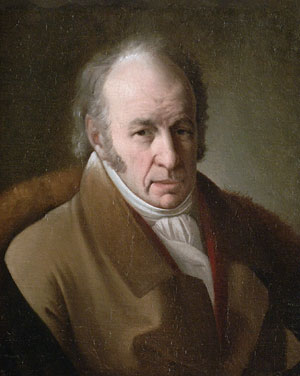 3
Giuseppe Bernardino Bison was an itinerant Italian painter of frescoes, landscapes, vedute, capriccios and some religious works.
3
Giuseppe Bernardino Bison was an itinerant Italian painter of frescoes, landscapes, vedute, capriccios and some religious works.
Pier Paolo Vergerio
 3
Pier Paolo Vergerio, the Younger, was an Italian papal nuncio and later Protestant reformer.
3
Pier Paolo Vergerio, the Younger, was an Italian papal nuncio and later Protestant reformer.
Vettor Pisani
 3
Vettor Pisani was a Venetian admiral.
3
Vettor Pisani was a Venetian admiral.
Julius Kugy
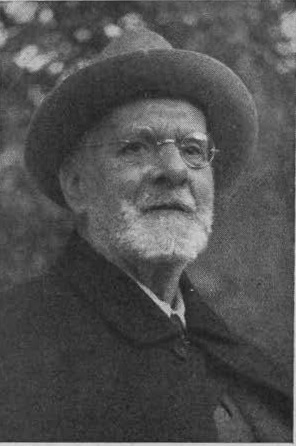 3
Julius Kugy, a volte italianizzato Giulio Kugy, è stato un alpinista, scrittore, botanico umanista, avvocato e ufficiale austriaco con cittadinanza austro-ungarica.
3
Julius Kugy, a volte italianizzato Giulio Kugy, è stato un alpinista, scrittore, botanico umanista, avvocato e ufficiale austriaco con cittadinanza austro-ungarica.
Riccardo Selvatico
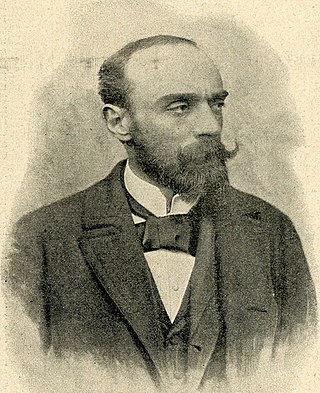 3
Riccardo Selvatico è stato un commediografo, poeta e politico italiano, sindaco di Venezia dal 1890 al 1895.
3
Riccardo Selvatico è stato un commediografo, poeta e politico italiano, sindaco di Venezia dal 1890 al 1895.
Robert Koch
 3
Heinrich Hermann Robert Koch was a German physician and microbiologist. As the discoverer of the specific causative agents of deadly infectious diseases including tuberculosis, cholera and anthrax,...
3
Heinrich Hermann Robert Koch was a German physician and microbiologist. As the discoverer of the specific causative agents of deadly infectious diseases including tuberculosis, cholera and anthrax,...
Luigi Visintin
 3
Luigi Visintin è stato un geografo italiano.
3
Luigi Visintin è stato un geografo italiano.
Guido Pellizzari
 3
Guido Pellizzari è stato un chimico italiano.
3
Guido Pellizzari è stato un chimico italiano.
Ercole Carletti
 3
Ercole Carletti è stato un poeta, drammaturgo e linguista italiano, autore di poesie e testi teatrali in lingua friulana.
3
Ercole Carletti è stato un poeta, drammaturgo e linguista italiano, autore di poesie e testi teatrali in lingua friulana.
Saint Sabina
 3
Saint Sabina was a saint and martyr of the early church. Her feast day is 29 August. She lived and suffered martyrdom at the beginning of the 2nd century in Rome.
3
Saint Sabina was a saint and martyr of the early church. Her feast day is 29 August. She lived and suffered martyrdom at the beginning of the 2nd century in Rome.
Gherardo Freschi
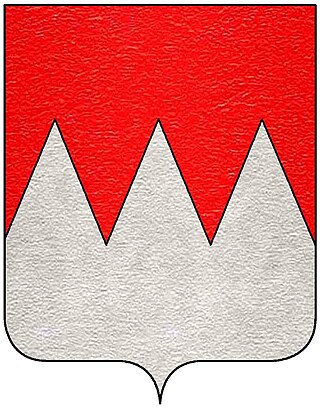 3
Gherardo Freschi di Cucagna è stato un agronomo e patriota italiano.
3
Gherardo Freschi di Cucagna è stato un agronomo e patriota italiano.
Mario Stoppani
 3
Mario Stoppani was an Italian World War I flying ace credited with six aerial victories. His valor earned him two Silver awards of the Medal for Military Valor and the Russian Cross of St. George...
3
Mario Stoppani was an Italian World War I flying ace credited with six aerial victories. His valor earned him two Silver awards of the Medal for Military Valor and the Russian Cross of St. George...
Biagio Marin
 3
Biagio Marin was a Venetian
and Italian poet, best known for his poems in the Venetian language. In his writings he never obeyed rhetoric or poetics. He only employed a few hundred words for his...
3
Biagio Marin was a Venetian
and Italian poet, best known for his poems in the Venetian language. In his writings he never obeyed rhetoric or poetics. He only employed a few hundred words for his...
Antonio Carneo
 3
Antonio Carneo (1637–1692) was an Italian painter, active in Friuli and Venice, and depicting both mythologic, allegoric, and religious canvases, as well as portraits.
3
Antonio Carneo (1637–1692) was an Italian painter, active in Friuli and Venice, and depicting both mythologic, allegoric, and religious canvases, as well as portraits.
Vittorio Gassman
 3
Vittorio Gassman, popularly known as Il Mattatore, was an Italian actor, director, and screenwriter.
3
Vittorio Gassman, popularly known as Il Mattatore, was an Italian actor, director, and screenwriter.
Giuditta Bellerio Sidoli
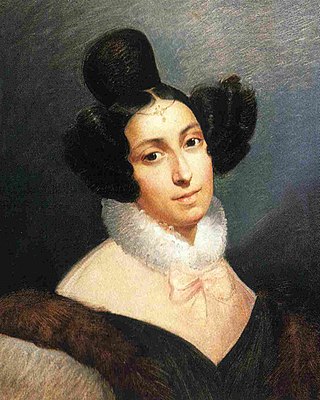 3
Giuditta Bellerio Sidoli was an Italian patriot and revolutionary protagonist in multiple efforts for Italian unification. She was also the lover of Giuseppe Mazzini for a period and operated a salon...
3
Giuditta Bellerio Sidoli was an Italian patriot and revolutionary protagonist in multiple efforts for Italian unification. She was also the lover of Giuseppe Mazzini for a period and operated a salon...
Marino Sanuto the Younger
 3
Marin Sanudo, italianised as Marino Sanuto or Sanuto the Younger, was a Venetian historian and diarist. His most significant work is his Diarii, which he had intended to write up into a history of...
3
Marin Sanudo, italianised as Marino Sanuto or Sanuto the Younger, was a Venetian historian and diarist. His most significant work is his Diarii, which he had intended to write up into a history of...
Sorelle Agazzi
 3
Rosa Agazzi e
Carolina Agazzi sono state due pedagogiste ed educatrici sperimentali conosciute come sorelle Agazzi.
3
Rosa Agazzi e
Carolina Agazzi sono state due pedagogiste ed educatrici sperimentali conosciute come sorelle Agazzi.
Gino Allegri
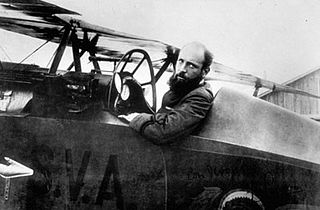 3
Gino Allegri, vero nome Girolamo Allegri, è stato un militare e aviatore italiano, tra i partecipanti al volo su Vienna di Gabriele D'Annunzio, decorato con la medaglia d'oro al valor militare...
3
Gino Allegri, vero nome Girolamo Allegri, è stato un militare e aviatore italiano, tra i partecipanti al volo su Vienna di Gabriele D'Annunzio, decorato con la medaglia d'oro al valor militare...
Virginia Tonelli
 3
Virginia Tonelli was an Italian partisan. She was burned alive by the fascists in the Risiera di San Sabba concentration camp, and was posthumously awarded the Gold Medal of Military Valour.
3
Virginia Tonelli was an Italian partisan. She was burned alive by the fascists in the Risiera di San Sabba concentration camp, and was posthumously awarded the Gold Medal of Military Valour.
Manlio Feruglio
 3
Manlio Feruglio è stato un militare italiano, decorato con la medaglia d'oro al valor militare alla memoria durante il corso della prima guerra mondiale.
3
Manlio Feruglio è stato un militare italiano, decorato con la medaglia d'oro al valor militare alla memoria durante il corso della prima guerra mondiale.
Ottavio Bottecchia
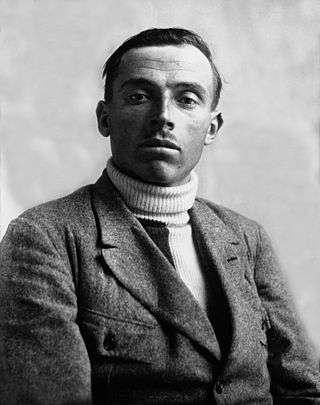 3
Ottavio Bottecchia was an Italian cyclist and the first Italian winner of the Tour de France.
3
Ottavio Bottecchia was an Italian cyclist and the first Italian winner of the Tour de France.
Pierre Savorgnan de Brazza
 3
Pierre Paul François Camille Savorgnan de Brazza was an Italian-French explorer. With his family's financial help, he explored the Ogooué region of Central Africa, and later with the backing of the...
3
Pierre Paul François Camille Savorgnan de Brazza was an Italian-French explorer. With his family's financial help, he explored the Ogooué region of Central Africa, and later with the backing of the...
Cima da Conegliano
 3
Giovanni Battista Cima, also called Cima da Conegliano, was an Italian Renaissance painter, who mostly worked in Venice. He can be considered part of the Venetian school, though he was also...
3
Giovanni Battista Cima, also called Cima da Conegliano, was an Italian Renaissance painter, who mostly worked in Venice. He can be considered part of the Venetian school, though he was also...
Domenico da Tolmezzo
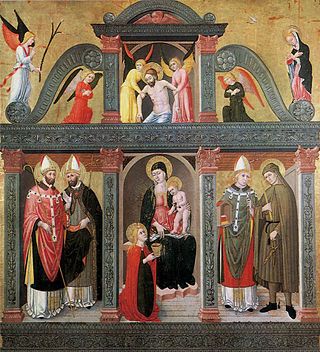 3
Domenico da Tolmezzo, talvolta citato come Domenico Mion o Domenico Mioni, oppure Domenico di Candido è stato un pittore e scultore italiano.
3
Domenico da Tolmezzo, talvolta citato come Domenico Mion o Domenico Mioni, oppure Domenico di Candido è stato un pittore e scultore italiano.
Antonio Berlese
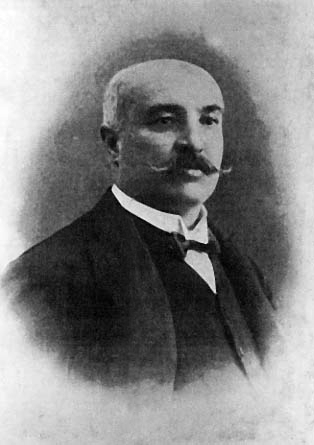 3
Antonio Berlese was an Italian entomologist.
3
Antonio Berlese was an Italian entomologist.
Saint Rosalia
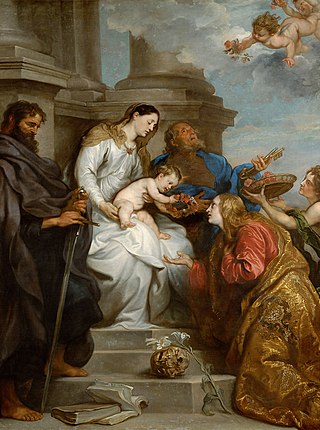 3
Rosalia, nicknamed la Santuzza, is the patron saint of Palermo in Italy, Camargo in Chihuahua, and three towns in Venezuela: El Hatillo, Zuata, and El Playón. She is especially important...
3
Rosalia, nicknamed la Santuzza, is the patron saint of Palermo in Italy, Camargo in Chihuahua, and three towns in Venezuela: El Hatillo, Zuata, and El Playón. She is especially important...
Robert Schuman
 3
Jean-Baptiste Nicolas Robert Schuman was a Luxembourg-born French statesman. Schuman was a Christian democratic political thinker and activist. Twice Prime Minister of France, a reformist Minister of...
3
Jean-Baptiste Nicolas Robert Schuman was a Luxembourg-born French statesman. Schuman was a Christian democratic political thinker and activist. Twice Prime Minister of France, a reformist Minister of...
Il Pordenone
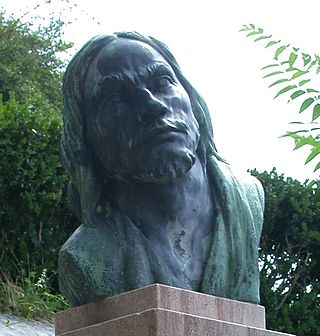 3
Pordenone, Il Pordenone in Italian, is the byname of Giovanni Antonio de’ Sacchis, an Italian Mannerist painter, loosely of the Venetian school. Vasari, his main biographer, wrongly identifies him as...
3
Pordenone, Il Pordenone in Italian, is the byname of Giovanni Antonio de’ Sacchis, an Italian Mannerist painter, loosely of the Venetian school. Vasari, his main biographer, wrongly identifies him as...
Gian Giacomo Marinoni
 3
Gian Giacomo Marinon (Marinoni), al fo filosof, matematic e topograf, archeolic e naturalist.
Daspò vê studiât a Udin e vê mostrât grande bravure in matematiche al fo mandât a Viene dulà che si...
3
Gian Giacomo Marinon (Marinoni), al fo filosof, matematic e topograf, archeolic e naturalist.
Daspò vê studiât a Udin e vê mostrât grande bravure in matematiche al fo mandât a Viene dulà che si...
Luigi Cadorna
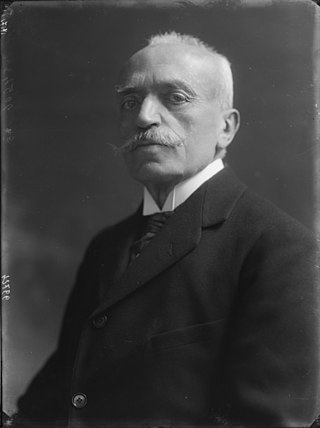 3
Luigi Cadorna è stato un generale e politico italiano.
Figlio del generale Raffaele Cadorna, divenne capo di Stato maggiore generale nel 1914, dopo l'improvvisa morte del generale Alberto Pollio, e...
3
Luigi Cadorna è stato un generale e politico italiano.
Figlio del generale Raffaele Cadorna, divenne capo di Stato maggiore generale nel 1914, dopo l'improvvisa morte del generale Alberto Pollio, e...
Antonino Cascino
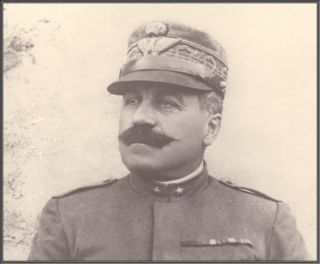 3
Antonino Cascino è stato un generale italiano.
3
Antonino Cascino è stato un generale italiano.
Giuseppe Costantini
 3
Giuseppe Costantini, detto Sciabolone, è stato un brigante italiano.
A capo degli insorgenti ascolani operò con azioni di brigantaggio e guerriglia contro le truppe francesi di Napoleone I presenti...
3
Giuseppe Costantini, detto Sciabolone, è stato un brigante italiano.
A capo degli insorgenti ascolani operò con azioni di brigantaggio e guerriglia contro le truppe francesi di Napoleone I presenti...
Cecilia Seghizzi
 3
Cecilia Seghizzi was an Italian composer, painter and teacher.
3
Cecilia Seghizzi was an Italian composer, painter and teacher.
Francesco Sulis
 3
Francesco Sulis è stato un politico italiano.
3
Francesco Sulis è stato un politico italiano.
Bruno Maderna
 3
Bruno Maderna was an Italian composer, conductor and academic teacher.
3
Bruno Maderna was an Italian composer, conductor and academic teacher.
Domenico Ghirlandaio
 3
Domenico di Tommaso Curradi di Doffo Bigordi, professionally known as Domenico Ghirlandaio, was an Italian Renaissance painter born in Florence. Ghirlandaio was part of the so-called "third...
3
Domenico di Tommaso Curradi di Doffo Bigordi, professionally known as Domenico Ghirlandaio, was an Italian Renaissance painter born in Florence. Ghirlandaio was part of the so-called "third...
Enrico Chiaradia
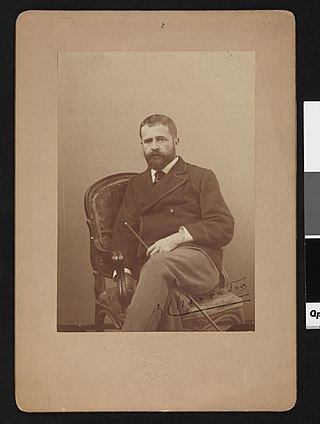 3
Enrico Chiaradia è stato uno scultore italiano.
3
Enrico Chiaradia è stato uno scultore italiano.
Giuseppe Luosi
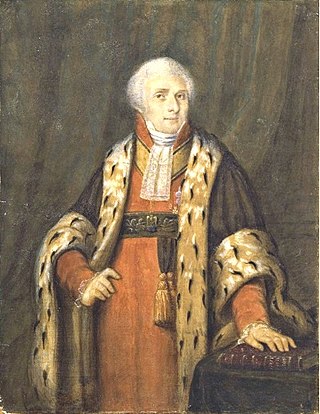 3
Giuseppe Romolo Melchiorre Luosi è stato un politico e giurista italiano.
Fu Ministro della Giustizia per un decennio nel napoleonico Regno d'Italia: in tale veste egli fu il primo promotore della...
3
Giuseppe Romolo Melchiorre Luosi è stato un politico e giurista italiano.
Fu Ministro della Giustizia per un decennio nel napoleonico Regno d'Italia: in tale veste egli fu il primo promotore della...
Nikola Tesla
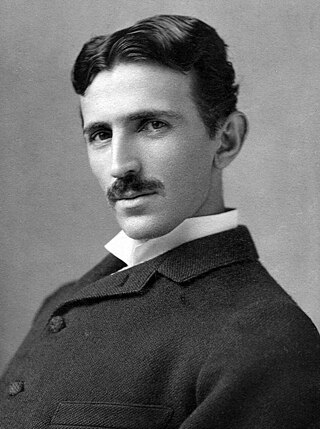 3
Nikola Tesla was a Serbian-American inventor, electrical engineer, mechanical engineer, and futurist. He is known for his contributions to the design of the modern alternating current (AC)...
3
Nikola Tesla was a Serbian-American inventor, electrical engineer, mechanical engineer, and futurist. He is known for his contributions to the design of the modern alternating current (AC)...
Carlo M. Cipolla
 3
Carlo M. Cipolla was an Italian economic historian. He was a member of both the American Academy of Arts and Sciences and the American Philosophical Society.
3
Carlo M. Cipolla was an Italian economic historian. He was a member of both the American Academy of Arts and Sciences and the American Philosophical Society.
Alfredo Comandini
 3
Antonio Alfredo Comandini è stato un giornalista e politico italiano, direttore politico del «Corriere della Sera» tra il settembre 1891 e il novembre 1892.
3
Antonio Alfredo Comandini è stato un giornalista e politico italiano, direttore politico del «Corriere della Sera» tra il settembre 1891 e il novembre 1892.
Alessandro Magnasco
 3
Alessandro Magnasco, also known as il Lissandrino, was an Italian late-Baroque painter active mostly in Milan and Genoa. He is best known for stylized, fantastic, often phantasmagoric genre or...
3
Alessandro Magnasco, also known as il Lissandrino, was an Italian late-Baroque painter active mostly in Milan and Genoa. He is best known for stylized, fantastic, often phantasmagoric genre or...
Virginia Woolf
 3
Adeline Virginia Woolf was an English writer. She is considered one of the most important modernist 20th-century authors. She pioneered the use of stream of consciousness as a narrative device.
3
Adeline Virginia Woolf was an English writer. She is considered one of the most important modernist 20th-century authors. She pioneered the use of stream of consciousness as a narrative device.
Domenico Cotugno
 3
Domenico Felice Antonio Cotugno was an Italian physician.
3
Domenico Felice Antonio Cotugno was an Italian physician.
Camillo Bellieni
 3
Camillo Bellieni è stato un politico e storico italiano, teorico del sardismo, principale ideologo e fondatore del Partito Sardo d'Azione, insieme ad Emilio Lussu e ad altri reduci della Brigata...
3
Camillo Bellieni è stato un politico e storico italiano, teorico del sardismo, principale ideologo e fondatore del Partito Sardo d'Azione, insieme ad Emilio Lussu e ad altri reduci della Brigata...
Luigi Crespellani
 3
Luigi Crespellani was an Italian lawyer and politician.
3
Luigi Crespellani was an Italian lawyer and politician.
Andrea Previtali
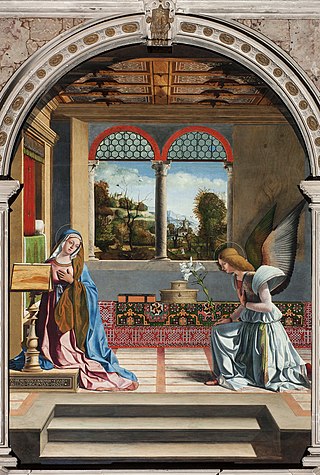 3
Andrea Previtali was an Italian painter of the Renaissance period, active mainly in Bergamo. He was also called Andrea Cordelliaghi.
3
Andrea Previtali was an Italian painter of the Renaissance period, active mainly in Bergamo. He was also called Andrea Cordelliaghi.
Giuseppe Siccardi
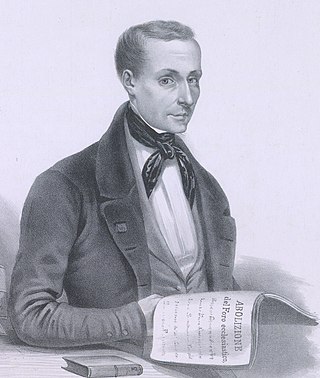 3
Giuseppe Siccardi è stato un giurista e politico italiano.
3
Giuseppe Siccardi è stato un giurista e politico italiano.
Pietro Mastino
 3
Pietro Mastino è stato un politico italiano.
3
Pietro Mastino è stato un politico italiano.
Filippo Figari
 3
Filippo Figari è stato un pittore italiano.
3
Filippo Figari è stato un pittore italiano.
Carmelo Floris
 3
Carmelo Floris è stato un pittore e incisore italiano.
3
Carmelo Floris è stato un pittore e incisore italiano.
Emilio Sereni
 3
Emilio Sereni was an Italian writer, politician and historian.
3
Emilio Sereni was an Italian writer, politician and historian.
Giacomo Manzù
 3
Giacomo Manzoni, known professionally as Giacomo Manzù, was an Italian sculptor.
3
Giacomo Manzoni, known professionally as Giacomo Manzù, was an Italian sculptor.
Amintore Fanfani
 3
Amintore Fanfani was an Italian politician and statesman, who served as 32nd prime minister of Italy for five separate terms. He was one of the best-known Italian politicians after the Second World...
3
Amintore Fanfani was an Italian politician and statesman, who served as 32nd prime minister of Italy for five separate terms. He was one of the best-known Italian politicians after the Second World...
Bernardo de Muro
 3
Bernardo De Muro was a Sardinian operatic tenor.
3
Bernardo De Muro was a Sardinian operatic tenor.
Annunzio Cervi
 3
Annunzio Cervi è stato un poeta e patriota italiano.
3
Annunzio Cervi è stato un poeta e patriota italiano.
Antonio Maxia
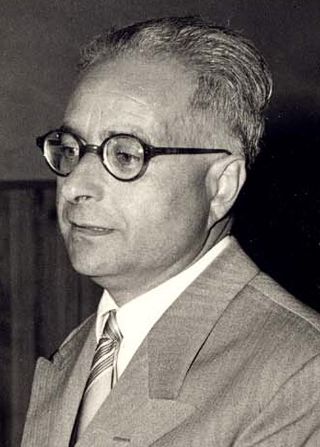 3
Antonio Maxia è stato un politico italiano.
3
Antonio Maxia è stato un politico italiano.
Antonio Scano
 3
Antonio Scano è stato un politico italiano.
3
Antonio Scano è stato un politico italiano.
Stanislao Caboni
 3
Stanislao Caboni è stato un politico italiano.
3
Stanislao Caboni è stato un politico italiano.
Enrico Besta
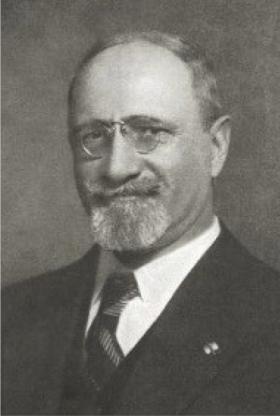 3
Enrico Besta è stato un giurista e storico italiano.
3
Enrico Besta è stato un giurista e storico italiano.
Giovanni Marghinotti
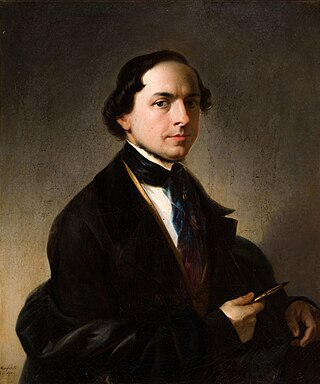 3
Giovanni Marghinotti was an Italian painter in the Neoclassical style.
3
Giovanni Marghinotti was an Italian painter in the Neoclassical style.
James Watt
 3
James Watt was a Scottish inventor, mechanical engineer, and chemist who improved on Thomas Newcomen's 1712 Newcomen steam engine with his Watt steam engine in 1776, which was fundamental to the...
3
James Watt was a Scottish inventor, mechanical engineer, and chemist who improved on Thomas Newcomen's 1712 Newcomen steam engine with his Watt steam engine in 1776, which was fundamental to the...
Vittorio Angius
 3
Vittorio Angius è stato uno scrittore, storico e politico italiano.
3
Vittorio Angius è stato uno scrittore, storico e politico italiano.
Bernadette Soubirous
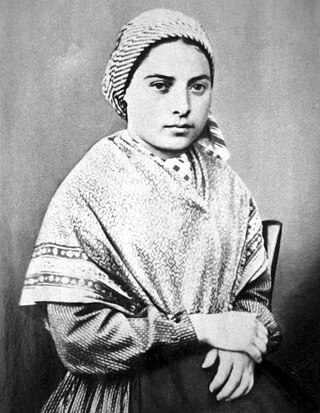 3
Bernadette Soubirous, also known as Bernadette of Lourdes, was the firstborn daughter of a miller from Lourdes, in the department of Hautes-Pyrénées in France, and is best known for experiencing...
3
Bernadette Soubirous, also known as Bernadette of Lourdes, was the firstborn daughter of a miller from Lourdes, in the department of Hautes-Pyrénées in France, and is best known for experiencing...
Gerolamo Araolla
 3
Gerolamo Araolla, also known as Hieronimu Araolla, was a Sardinian poet and priest.
3
Gerolamo Araolla, also known as Hieronimu Araolla, was a Sardinian poet and priest.
Antonio Ghislanzoni
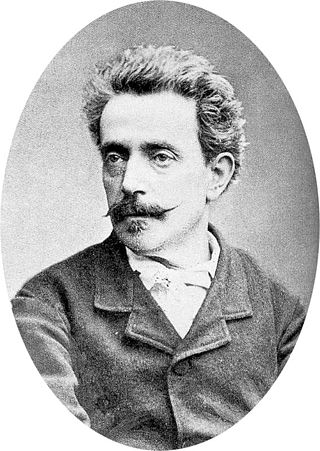 3
Antonio Ghislanzoni was an Italian journalist, poet, and novelist who wrote librettos for Verdi, among other composers, of which the best known are Aida and the revised version of La forza del...
3
Antonio Ghislanzoni was an Italian journalist, poet, and novelist who wrote librettos for Verdi, among other composers, of which the best known are Aida and the revised version of La forza del...
Arnolfo di Cambio
 3
Arnolfo di Cambio was an Italian architect and sculptor of the Duecento, who began as a lead assistant to Nicola Pisano. He is documented as being capomaestro or Head of Works for Florence Cathedral...
3
Arnolfo di Cambio was an Italian architect and sculptor of the Duecento, who began as a lead assistant to Nicola Pisano. He is documented as being capomaestro or Head of Works for Florence Cathedral...
Giuseppe Lazzati
 3
Giuseppe Lazzati was an Italian Roman Catholic rector of the Sacred Heart college in Milan and a former parliamentarian. He was also the founder of the Secular Institute of Christ the King. Lazzati...
3
Giuseppe Lazzati was an Italian Roman Catholic rector of the Sacred Heart college in Milan and a former parliamentarian. He was also the founder of the Secular Institute of Christ the King. Lazzati...
Wright brothers
 3
The Wright brothers, Orville Wright and Wilbur Wright, were American aviation pioneers generally credited with inventing, building, and flying the world's first successful airplane. They made the...
3
The Wright brothers, Orville Wright and Wilbur Wright, were American aviation pioneers generally credited with inventing, building, and flying the world's first successful airplane. They made the...
Tito Schipa
 3
Tito Schipa was an Italian lyric tenor, considered the greatest tenore di grazia and one of the most popular tenors of the century.
3
Tito Schipa was an Italian lyric tenor, considered the greatest tenore di grazia and one of the most popular tenors of the century.
Rembrandt
 3
Rembrandt Harmenszoon van Rijn, usually simply known as Rembrandt, was a Dutch Golden Age painter, printmaker, and draughtsman. He is generally considered one of the greatest visual artists in the...
3
Rembrandt Harmenszoon van Rijn, usually simply known as Rembrandt, was a Dutch Golden Age painter, printmaker, and draughtsman. He is generally considered one of the greatest visual artists in the...
Johann Wolfgang von Goethe
 3
Johann Wolfgang von Goethe was a German polymath and writer, who is widely regarded as the greatest and most influential writer in the German language. His work has had a profound and wide-ranging...
3
Johann Wolfgang von Goethe was a German polymath and writer, who is widely regarded as the greatest and most influential writer in the German language. His work has had a profound and wide-ranging...
Eusebio Kino
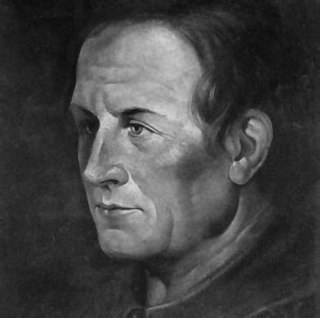 3
Eusebio Francisco Kino, SJ, often referred to as Father Kino, was an Italian Jesuit, missionary, geographer, explorer, cartographer, mathematician and astronomer born in the Bishopric of Trent, Holy...
3
Eusebio Francisco Kino, SJ, often referred to as Father Kino, was an Italian Jesuit, missionary, geographer, explorer, cartographer, mathematician and astronomer born in the Bishopric of Trent, Holy...
Saint Prisca
 3
Prisca was a young Roman woman allegedly tortured and executed for her Christian faith. The dates of her birth and death are unknown. She is revered as a saint and martyr in Eastern Orthodoxy, by the...
3
Prisca was a young Roman woman allegedly tortured and executed for her Christian faith. The dates of her birth and death are unknown. She is revered as a saint and martyr in Eastern Orthodoxy, by the...
Francesco Fancello
 3
Francesco Fancello è stato un politico e scrittore italiano.
3
Francesco Fancello è stato un politico e scrittore italiano.
Stefano Siglienti
 3
Stefano Siglienti was an Italian banker and politician who served as the minister of finance from 18 June until 12 December 1944. He held several banking posts until his death.
3
Stefano Siglienti was an Italian banker and politician who served as the minister of finance from 18 June until 12 December 1944. He held several banking posts until his death.
George Washington
 3
George Washington was an American Founding Father, military officer, and politician who served as the first president of the United States from 1789 to 1797. Appointed by the Second Continental...
3
George Washington was an American Founding Father, military officer, and politician who served as the first president of the United States from 1789 to 1797. Appointed by the Second Continental...
Paolo Mossa
 3
Paolo Mossa, detto Paulicu è stato un poeta italiano, famoso per il contributo dato alla poesia in lingua sarda.
3
Paolo Mossa, detto Paulicu è stato un poeta italiano, famoso per il contributo dato alla poesia in lingua sarda.
Gerolamo Emiliani
 3
Gerolamo Emiliani, CRS was an Italian humanitarian, founder of the Somaschi Fathers, and is considered a saint by the Catholic Church.
3
Gerolamo Emiliani, CRS was an Italian humanitarian, founder of the Somaschi Fathers, and is considered a saint by the Catholic Church.
Franz Liszt
 3
Franz Liszt was a Hungarian composer, virtuoso pianist, conductor and teacher of the Romantic period. With a diverse body of work spanning more than six decades, he is considered to be one of the...
3
Franz Liszt was a Hungarian composer, virtuoso pianist, conductor and teacher of the Romantic period. With a diverse body of work spanning more than six decades, he is considered to be one of the...
Prince Amedeo, Duke of Aosta
 3
Prince Amedeo, 3rd Duke of Aosta was the third Duke of Aosta and a first cousin once removed of the King of Italy, Victor Emmanuel III. During World War II, he was the Italian Viceroy of Italian East...
3
Prince Amedeo, 3rd Duke of Aosta was the third Duke of Aosta and a first cousin once removed of the King of Italy, Victor Emmanuel III. During World War II, he was the Italian Viceroy of Italian East...
Giorgio Almirante
 3
Giorgio Almirante was an Italian politician who founded the neo-fascist Italian Social Movement, which he led until his retirement in 1987.
3
Giorgio Almirante was an Italian politician who founded the neo-fascist Italian Social Movement, which he led until his retirement in 1987.
Pietro Platania
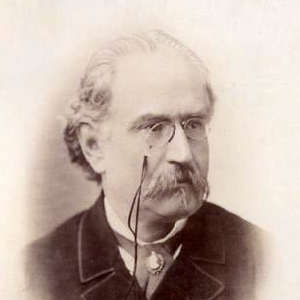 3
Pietro Platania was an Italian composer and music educator.
3
Pietro Platania was an Italian composer and music educator.
Antonio Baldissera
 3
Antonio Baldissera was an Italian general, active in the Ethiopian Empire (Abyssinia) and in Italian Eritrea during the late 19th and early 20th centuries.
3
Antonio Baldissera was an Italian general, active in the Ethiopian Empire (Abyssinia) and in Italian Eritrea during the late 19th and early 20th centuries.
Heraclitus
 3
Heraclitus was an ancient Greek pre-Socratic philosopher from the city of Ephesus, which was then part of the Persian Empire.
3
Heraclitus was an ancient Greek pre-Socratic philosopher from the city of Ephesus, which was then part of the Persian Empire.
Matteo Ricci
 3
Matteo Ricci was an Italian Jesuit priest and one of the founding figures of the Jesuit China missions. He created the Kunyu Wanguo Quantu, a 1602 map of the world written in Chinese characters. In...
3
Matteo Ricci was an Italian Jesuit priest and one of the founding figures of the Jesuit China missions. He created the Kunyu Wanguo Quantu, a 1602 map of the world written in Chinese characters. In...
Charlemagne
 3
Charlemagne was King of the Franks from 768, King of the Lombards from 774, and Emperor of the Carolingian Empire from 800, holding all these titles until his death in 814. Charlemagne succeeded in...
3
Charlemagne was King of the Franks from 768, King of the Lombards from 774, and Emperor of the Carolingian Empire from 800, holding all these titles until his death in 814. Charlemagne succeeded in...
Orazio Marinali
 3
Orazio Marinali (1643–1720) was an Italian late-Baroque sculptor, active mainly in the Veneto or Venetian mainland.
3
Orazio Marinali (1643–1720) was an Italian late-Baroque sculptor, active mainly in the Veneto or Venetian mainland.
Roald Amundsen
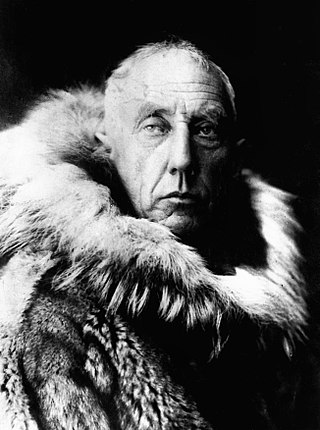 3
Roald Engelbregt Gravning Amundsen was a Norwegian explorer of polar regions. He was a key figure of the period known as the Heroic Age of Antarctic Exploration.
3
Roald Engelbregt Gravning Amundsen was a Norwegian explorer of polar regions. He was a key figure of the period known as the Heroic Age of Antarctic Exploration.
Francesco Cucchi
 3
Francesco Cucchi was an Italian patriot soldier who joined Giuseppe Garibaldi in his Expedition of the Thousand, and later in other wars for the unification of Italy. In 1892, he was named a Senator...
3
Francesco Cucchi was an Italian patriot soldier who joined Giuseppe Garibaldi in his Expedition of the Thousand, and later in other wars for the unification of Italy. In 1892, he was named a Senator...
Sebastiano Tecchio
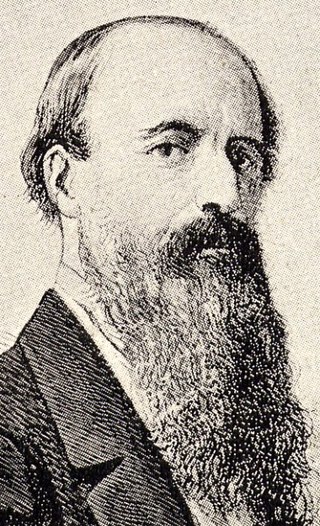 3
Sebastiano Tecchio, was an Italian lawyer and politician that was president of the Italian Senate from 1876 to 1884.
3
Sebastiano Tecchio, was an Italian lawyer and politician that was president of the Italian Senate from 1876 to 1884.
Ernesto Teodoro Moneta
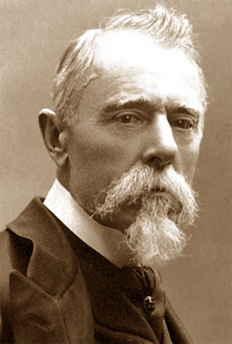 3
Ernesto Teodoro Moneta was an Italian journalist, nationalist, revolutionary soldier and later a pacifist and Nobel Peace Prize Laureate. He adopted the motto In varietate unitas! which later...
3
Ernesto Teodoro Moneta was an Italian journalist, nationalist, revolutionary soldier and later a pacifist and Nobel Peace Prize Laureate. He adopted the motto In varietate unitas! which later...
Giuseppe Terragni
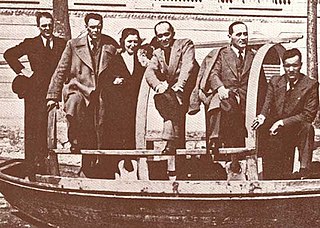 3
Giuseppe Terragni was an Italian architect who worked primarily under the fascist regime of Benito Mussolini and pioneered the Italian modern movement under the rubric of Rationalism. His most famous...
3
Giuseppe Terragni was an Italian architect who worked primarily under the fascist regime of Benito Mussolini and pioneered the Italian modern movement under the rubric of Rationalism. His most famous...
Giuseppe Perrucchetti
 3
Giuseppe Domenico Perrucchetti was an Italian general and politician, the creator of the Alpini corps.
3
Giuseppe Domenico Perrucchetti was an Italian general and politician, the creator of the Alpini corps.
Giovanni Miani
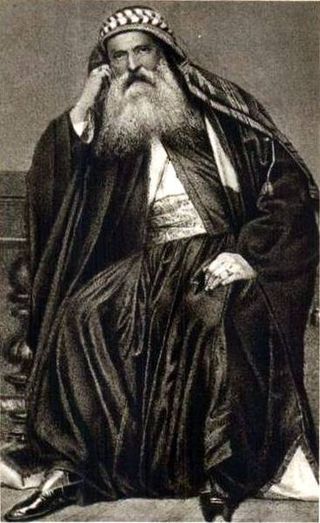 3
Giovanni Miani was an Italian explorer. He is known for his explorations of the Nile, where he came close to being the first European to reach its source in Lake Victoria, and for his exploration of...
3
Giovanni Miani was an Italian explorer. He is known for his explorations of the Nile, where he came close to being the first European to reach its source in Lake Victoria, and for his exploration of...
Andrea Gritti
 3
Andrea Gritti was the Doge of the Venetian Republic from 1523 to 1538, following a distinguished diplomatic and military career. He started out as a successful merchant in Constantinople and...
3
Andrea Gritti was the Doge of the Venetian Republic from 1523 to 1538, following a distinguished diplomatic and military career. He started out as a successful merchant in Constantinople and...
Guglielmo Ciardi
 3
Guglielmo Ciardi was an Italian painter.
3
Guglielmo Ciardi was an Italian painter.
Marcantonio Flaminio
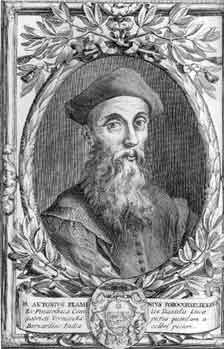 3
Marcantonio Flaminio, also known as Marcus Antonius Flaminius, was an Italian humanist poet, known for his Neo-Latin works. During his life, he toured the courts and literary centers of Italy. His...
3
Marcantonio Flaminio, also known as Marcus Antonius Flaminius, was an Italian humanist poet, known for his Neo-Latin works. During his life, he toured the courts and literary centers of Italy. His...
Flavio Andò
 3
Flavio Andò è stato un attore teatrale italiano.
3
Flavio Andò è stato un attore teatrale italiano.
Carlo Pedrotti
 3
Carlo Pedrotti was an Italian conductor, administrator and composer, principally of opera. An associate of Giuseppe Verdi's, he also taught two internationally renowned Italian operatic tenors,...
3
Carlo Pedrotti was an Italian conductor, administrator and composer, principally of opera. An associate of Giuseppe Verdi's, he also taught two internationally renowned Italian operatic tenors,...
Pietro Custodi
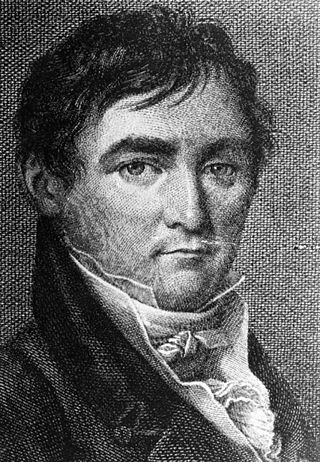 3
Pietro Custodi è stato uno storico, letterato e politico italiano.
3
Pietro Custodi è stato uno storico, letterato e politico italiano.
Luigi Credaro
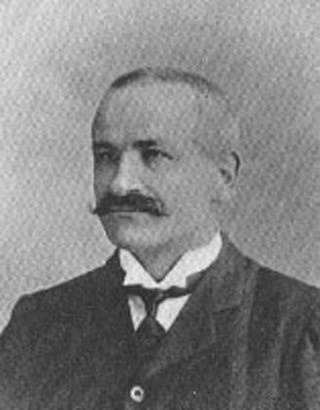 3
Luigi Credaro è stato un politico, storico della filosofia e pedagogista italiano.
3
Luigi Credaro è stato un politico, storico della filosofia e pedagogista italiano.
Benedetto Antelami
 3
Benedetto Antelami was an Italian architect and sculptor of the Romanesque school, whose "sculptural style sprang from local north Italian traditions that can be traced back to late antiquity". He is...
3
Benedetto Antelami was an Italian architect and sculptor of the Romanesque school, whose "sculptural style sprang from local north Italian traditions that can be traced back to late antiquity". He is...
Demos Malavasi (1926-1944)
 3
Demos Malavasi è stato un partigiano italiano.
3
Demos Malavasi è stato un partigiano italiano.
Adolfo Venturi
 3
Adolfo Venturi was an Italian art historian. His son, Lionello Venturi, was also an art historian.
3
Adolfo Venturi was an Italian art historian. His son, Lionello Venturi, was also an art historian.
Melvin Jones (Lions Club)
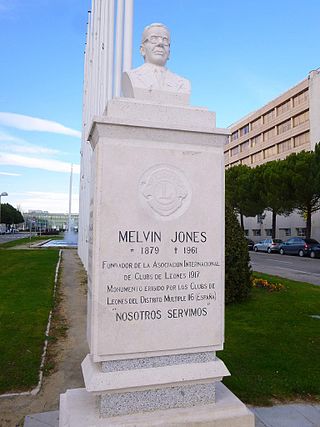 3
Melvin Jones was the founder and secretary-treasurer of Lions Clubs International.
3
Melvin Jones was the founder and secretary-treasurer of Lions Clubs International.
Ptolemy
 3
Claudius Ptolemy was an Alexandrian mathematician, astronomer, astrologer, geographer, and music theorist who wrote about a dozen scientific treatises, three of which were important to later...
3
Claudius Ptolemy was an Alexandrian mathematician, astronomer, astrologer, geographer, and music theorist who wrote about a dozen scientific treatises, three of which were important to later...
Ho Chi Minh
 3
Hồ Chí Minh, colloquially known as Uncle Ho or just Uncle (Bác), and by other aliases and sobriquets, was a Vietnamese communist revolutionary, nationalist, and politician. He served as prime...
3
Hồ Chí Minh, colloquially known as Uncle Ho or just Uncle (Bác), and by other aliases and sobriquets, was a Vietnamese communist revolutionary, nationalist, and politician. He served as prime...
Natale Bruni
 3
Natale Bruni è stato un arcivescovo cattolico italiano.
3
Natale Bruni è stato un arcivescovo cattolico italiano.
Jacopo Peri
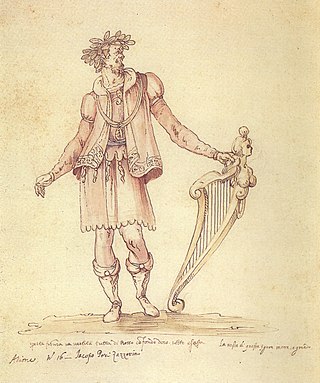 3
Jacopo Peri was an Italian composer, singer and instrumentalist of the late Renaissance and early Baroque periods. He wrote what is considered the first opera, the mostly lost Dafne, and also the...
3
Jacopo Peri was an Italian composer, singer and instrumentalist of the late Renaissance and early Baroque periods. He wrote what is considered the first opera, the mostly lost Dafne, and also the...
Maurice Ravel
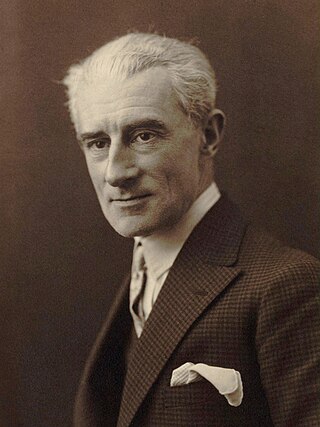 3
Joseph Maurice Ravel was a French composer, pianist and conductor. He is often associated with Impressionism along with his elder contemporary Claude Debussy, although both composers rejected the...
3
Joseph Maurice Ravel was a French composer, pianist and conductor. He is often associated with Impressionism along with his elder contemporary Claude Debussy, although both composers rejected the...
Giacomo Ulivi
 3
Giacomo Ulivi è stato un partigiano italiano.
3
Giacomo Ulivi è stato un partigiano italiano.
Pietro Tacchini
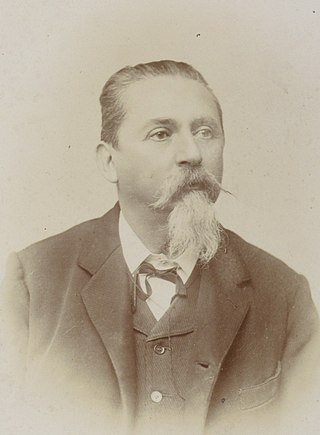 3
Pietro Tacchini was an Italian astronomer.
3
Pietro Tacchini was an Italian astronomer.
Agostino Paradisi
Vittoria Nenni
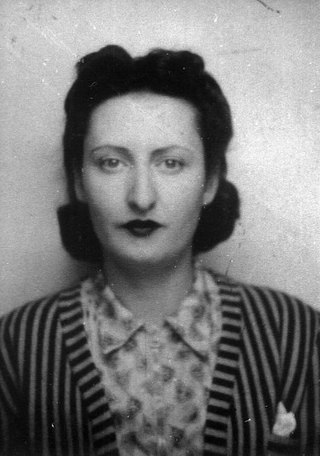 3
Vittoria Gorizia Nenni fu un'attivista e resistente antifascista italiana, figlia minore del leader socialista Pietro Nenni.
Morì a 28 anni, probabilmente di febbre tifoide, nel campo di...
3
Vittoria Gorizia Nenni fu un'attivista e resistente antifascista italiana, figlia minore del leader socialista Pietro Nenni.
Morì a 28 anni, probabilmente di febbre tifoide, nel campo di...
Bernardino Loschi
 3
Bernardino Loschi was an Italian painter of the Renaissance.
3
Bernardino Loschi was an Italian painter of the Renaissance.
Antonio Cardarelli
 3
Antonio Cardarelli was an Italian physician remembered for describing Cardarelli's sign.
3
Antonio Cardarelli was an Italian physician remembered for describing Cardarelli's sign.
Giovanni Bononcini
 3
Giovanni Bononcini was an Italian Baroque composer, cellist, singer and teacher, one of a family of string players and composers. He was a rival to George Frederic Handel.
3
Giovanni Bononcini was an Italian Baroque composer, cellist, singer and teacher, one of a family of string players and composers. He was a rival to George Frederic Handel.
Sem Benelli
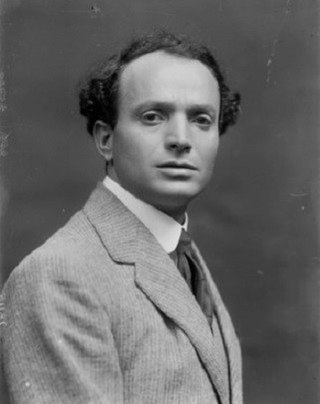 3
Sem Benelli was an Italian playwright, essayist and librettist. He provided the texts for several noted Italian operas, including Italo Montemezzi's L'amore dei tre re and L'incantesimo, and Umberto...
3
Sem Benelli was an Italian playwright, essayist and librettist. He provided the texts for several noted Italian operas, including Italo Montemezzi's L'amore dei tre re and L'incantesimo, and Umberto...
Giuseppe Acerbi
 3
Giuseppe Acerbi was an Italian naturalist, explorer and composer.
3
Giuseppe Acerbi was an Italian naturalist, explorer and composer.
Andrea Brustolon
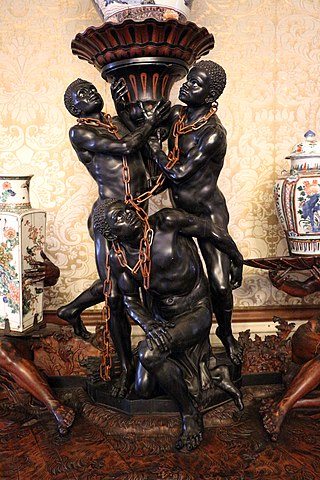 3
Andrea Brustolon was an Italian sculptor in wood. He is known for his furnishings in the Baroque style and devotional sculptures.
3
Andrea Brustolon was an Italian sculptor in wood. He is known for his furnishings in the Baroque style and devotional sculptures.
Gaetano Scirea
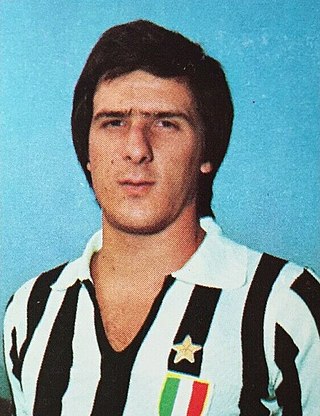 3
Gaetano Scirea was an Italian professional footballer who is considered one of the greatest defenders of his generation and one of the greatest defenders of all time. He spent most of his career with...
3
Gaetano Scirea was an Italian professional footballer who is considered one of the greatest defenders of his generation and one of the greatest defenders of all time. He spent most of his career with...
Clelia Barbieri
 3
Clelia Barbieri è stata una religiosa italiana, fondatrice della congregazione delle Suore Minime dell'Addolorata. È stata proclamata santa nel 1989 da papa Giovanni Paolo II. È la fondatrice più...
3
Clelia Barbieri è stata una religiosa italiana, fondatrice della congregazione delle Suore Minime dell'Addolorata. È stata proclamata santa nel 1989 da papa Giovanni Paolo II. È la fondatrice più...
Girolamo da Carpi
 3
Girolamo Da Carpi was an Italian painter and decorator who worked at the Court of the House of Este in Ferrara. He began painting in Ferrara, by report apprenticing to Benvenuto Tisi ; but by age 20,...
3
Girolamo Da Carpi was an Italian painter and decorator who worked at the Court of the House of Este in Ferrara. He began painting in Ferrara, by report apprenticing to Benvenuto Tisi ; but by age 20,...
Antonio Roiti
 3
Antonio Roiti è stato un fisico italiano.
3
Antonio Roiti è stato un fisico italiano.
Luigi Caroli
 3
Luigi Caroli è stato un patriota e militare italiano.
3
Luigi Caroli è stato un patriota e militare italiano.
Marino Ortolani
 3
Marino Ortolani was an Italian pediatrician who developed a clinical test for the recognition of hip dysplasia called the Ortolani test.
3
Marino Ortolani was an Italian pediatrician who developed a clinical test for the recognition of hip dysplasia called the Ortolani test.
Antonio Zara
 3
Antonio Zara was a Roman Catholic prelate who served as Bishop of Pedena (1601–1621).
3
Antonio Zara was a Roman Catholic prelate who served as Bishop of Pedena (1601–1621).
Giacomo Lercaro
 3
Giacomo Lercaro was an Italian cardinal of the Roman Catholic Church who served as Archbishop of Ravenna from 1947 to 1952, and Archbishop of Bologna from 1952 to 1968. Pope Pius XII made him a...
3
Giacomo Lercaro was an Italian cardinal of the Roman Catholic Church who served as Archbishop of Ravenna from 1947 to 1952, and Archbishop of Bologna from 1952 to 1968. Pope Pius XII made him a...
Giuseppe Gaudenzi
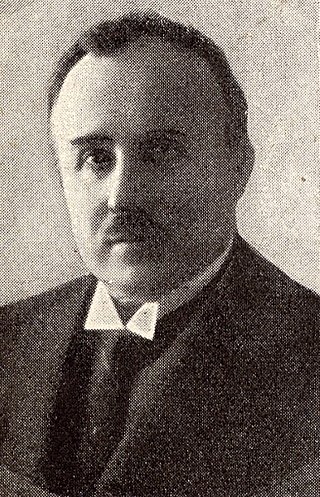 3
Giuseppe Gaudenzi è stato un politico italiano.
3
Giuseppe Gaudenzi è stato un politico italiano.
Macchiaioli
 3
The Macchiaioli were a group of Italian painters active in Tuscany in the second half of the nineteenth century. They strayed from antiquated conventions taught by the Italian art academies, and did...
3
The Macchiaioli were a group of Italian painters active in Tuscany in the second half of the nineteenth century. They strayed from antiquated conventions taught by the Italian art academies, and did...
Leonardo Bistolfi
 3
Leonardo Bistolfi was an Italian sculptor and an important exponent of Italian Symbolism.
3
Leonardo Bistolfi was an Italian sculptor and an important exponent of Italian Symbolism.
Veronica Gambara
 3
Veronica Gambara was an Italian poet and politician. She was the ruler of the County of Correggio from 1518 until 1550.
3
Veronica Gambara was an Italian poet and politician. She was the ruler of the County of Correggio from 1518 until 1550.
Marie Louise, Duchess of Parma
 3
Marie Louise was an Austrian archduchess who reigned as Duchess of Parma from 11 April 1814 until her death in 1847. She was Napoleon's second wife and as such Empress of the French and Queen of...
3
Marie Louise was an Austrian archduchess who reigned as Duchess of Parma from 11 April 1814 until her death in 1847. She was Napoleon's second wife and as such Empress of the French and Queen of...
Giovanni Lanfranco
 3
Giovanni Lanfranco was an Italian painter of the Baroque period.
3
Giovanni Lanfranco was an Italian painter of the Baroque period.
Luigi Mascherpa
 3
Luigi Mascherpa was an Italian admiral during World War II. He led the Italian defense during the Battle of Leros and was later executed by the Italian Social Republic.
3
Luigi Mascherpa was an Italian admiral during World War II. He led the Italian defense during the Battle of Leros and was later executed by the Italian Social Republic.
Edoardo Amaldi
 3
Edoardo Amaldi was an Italian physicist. He coined the term "neutrino" in conversations with Enrico Fermi distinguishing it from the heavier "neutron". He has been described as "one of the leading...
3
Edoardo Amaldi was an Italian physicist. He coined the term "neutrino" in conversations with Enrico Fermi distinguishing it from the heavier "neutron". He has been described as "one of the leading...
Salvator Rosa
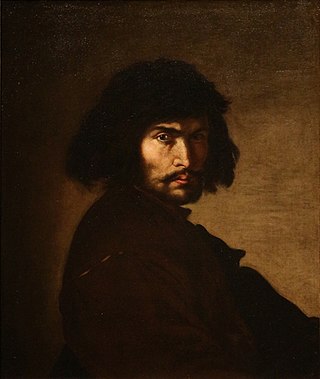 3
Salvator Rosa (1615–1673) is best known today as an Italian Baroque painter, whose romanticized landscapes and history paintings, often set in dark and untamed nature, exerted considerable influence...
3
Salvator Rosa (1615–1673) is best known today as an Italian Baroque painter, whose romanticized landscapes and history paintings, often set in dark and untamed nature, exerted considerable influence...
Odoardo Focherini
 3
Odoardo Focherini was an Italian Roman Catholic journalist. He issued false documents to Jews during World War II in order for them to escape the Nazi regime but was arrested and sent to a...
3
Odoardo Focherini was an Italian Roman Catholic journalist. He issued false documents to Jews during World War II in order for them to escape the Nazi regime but was arrested and sent to a...
Filippo Montesi
 3
Filippo Montesi è stato un militare italiano.
3
Filippo Montesi è stato un militare italiano.
Guido Cantelli
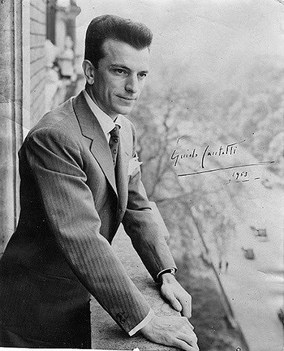 3
Guido Cantelli was an Italian orchestral conductor. Toscanini elected him his "spiritual heir" since the beginnings of his career. He was named Musical Director of La Scala, Milan in November 1956,...
3
Guido Cantelli was an Italian orchestral conductor. Toscanini elected him his "spiritual heir" since the beginnings of his career. He was named Musical Director of La Scala, Milan in November 1956,...
Giulio Romano
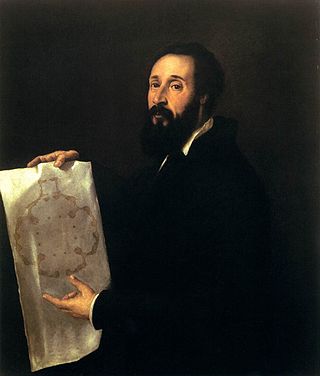 3
Giulio Pippi, known as Giulio Romano, was an Italian painter and architect. He was a pupil of Raphael, and his stylistic deviations from High Renaissance classicism help define the sixteenth-century...
3
Giulio Pippi, known as Giulio Romano, was an Italian painter and architect. He was a pupil of Raphael, and his stylistic deviations from High Renaissance classicism help define the sixteenth-century...
Mario Cermenati
 3
Mario Cermenati è stato un naturalista e politico italiano.
3
Mario Cermenati è stato un naturalista e politico italiano.
Fra Dolcino
 3
Fra Dolcino was the second leader of the Dulcinian reformist movement who was burned at the stake in Northern Italy in 1307. He had taken over the movement after its founder, Gerard Segarelli, had...
3
Fra Dolcino was the second leader of the Dulcinian reformist movement who was burned at the stake in Northern Italy in 1307. He had taken over the movement after its founder, Gerard Segarelli, had...
Giacomo Bresadola
 3
Giacomo Bresadola 14 February 1847 – Trento 9 June 1929) was an eminent Italian mycologist. Fungi he named include the deadly Lepiota helveola and Inocybe patouillardii, though the latter is now...
3
Giacomo Bresadola 14 February 1847 – Trento 9 June 1929) was an eminent Italian mycologist. Fungi he named include the deadly Lepiota helveola and Inocybe patouillardii, though the latter is now...
Tommaso Agudio
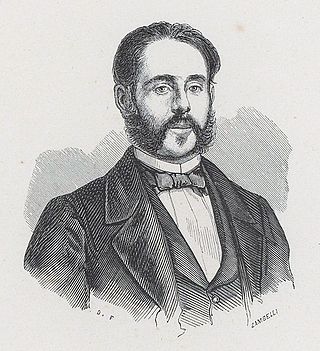 3
Tommaso Agudio, o Tomaso Agudio, è stato un ingegnere, imprenditore e politico italiano, progettista e costruttore di ferrovie e di funicolari.
3
Tommaso Agudio, o Tomaso Agudio, è stato un ingegnere, imprenditore e politico italiano, progettista e costruttore di ferrovie e di funicolari.
Salvatore Vitale
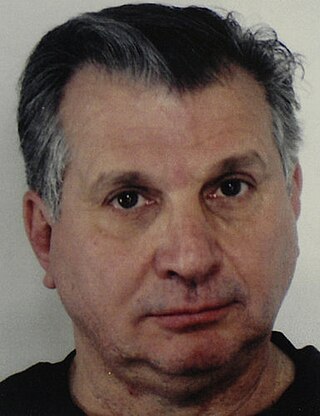 3
Salvatore "Good Looking Sal" Vitale is an American former underboss of the Bonanno crime family before he became a government informant. After his arrest in 2003, Vitale agreed to cooperate with the...
3
Salvatore "Good Looking Sal" Vitale is an American former underboss of the Bonanno crime family before he became a government informant. After his arrest in 2003, Vitale agreed to cooperate with the...
Mario Capuani
 3
Mario Capuani è stato un partigiano e medico italiano.
Medaglia d'Oro al Valor Militare alla memoria.
3
Mario Capuani è stato un partigiano e medico italiano.
Medaglia d'Oro al Valor Militare alla memoria.
Nino Martoglio
 3
Nino Martoglio was an Italian writer, publisher, journalist and producer of theatrical works. He wrote mostly in Sicilian and likewise, his theatrical works were mostly in Sicilian. He founded a...
3
Nino Martoglio was an Italian writer, publisher, journalist and producer of theatrical works. He wrote mostly in Sicilian and likewise, his theatrical works were mostly in Sicilian. He founded a...
Francesco Melzi d'Eril
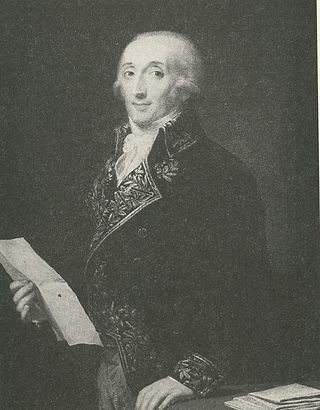 3
Francesco Melzi d'Eril, Duke of Lodi, Count of Magenta was an Italian politician and patriot, serving as vice-president of the Napoleonic Italian Republic (1802–1805). He was a consistent supporter...
3
Francesco Melzi d'Eril, Duke of Lodi, Count of Magenta was an Italian politician and patriot, serving as vice-president of the Napoleonic Italian Republic (1802–1805). He was a consistent supporter...
Giuseppe Ravizza
 3
Giuseppe Ravizza was a prolific typewriter inventor. He spent nearly 40 years of his life obsessively grappling with the complexities of inventing a usable writing machine. He called his invention...
3
Giuseppe Ravizza was a prolific typewriter inventor. He spent nearly 40 years of his life obsessively grappling with the complexities of inventing a usable writing machine. He called his invention...
Salvatore Tommasi
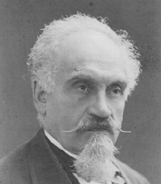 3
Salvatore Tommasi è stato un patologo italiano, importante rappresentante della ricerca medica nella seconda metà dell'Ottocento in Italia e uno dei maggiori esponenti del Positivismo italiano.
3
Salvatore Tommasi è stato un patologo italiano, importante rappresentante della ricerca medica nella seconda metà dell'Ottocento in Italia e uno dei maggiori esponenti del Positivismo italiano.
Pope Pius II
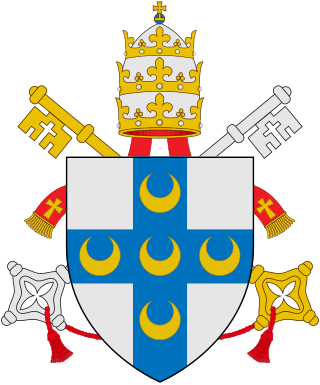 3
Pope Pius II, born Enea Silvio Bartolomeo Piccolomini, was head of the Catholic Church and ruler of the Papal States from 19 August 1458 to his death.
3
Pope Pius II, born Enea Silvio Bartolomeo Piccolomini, was head of the Catholic Church and ruler of the Papal States from 19 August 1458 to his death.
Salvatore Aldisio
 3
Salvatore Aldisio was an Italian Christian Democratic politician.
3
Salvatore Aldisio was an Italian Christian Democratic politician.
Francesco Colzi
 3
Francesco Alfonso Faustino Colzi è stato un medico e chirurgo italiano.
3
Francesco Alfonso Faustino Colzi è stato un medico e chirurgo italiano.
Pacuvius
 3
Marcus Pacuvius was an ancient Roman tragic poet. He is regarded as the greatest of their tragedians prior to Lucius Accius.
3
Marcus Pacuvius was an ancient Roman tragic poet. He is regarded as the greatest of their tragedians prior to Lucius Accius.
Luigi Pierobon
 3
Luigi Pierobon è stato un partigiano e antifascista italiano, studente cattolico, medaglia d'oro al valor militare.
3
Luigi Pierobon è stato un partigiano e antifascista italiano, studente cattolico, medaglia d'oro al valor militare.
Nunzio Sulprizio
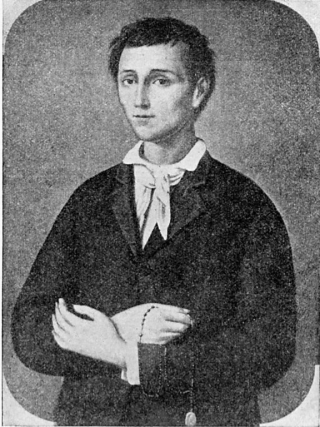 3
Nunzio Sulprizio was an Italian Roman Catholic from Pescara who worked as an apprentice blacksmith. He suffered from poor health during his brief life and was considered to those who knew him to be a...
3
Nunzio Sulprizio was an Italian Roman Catholic from Pescara who worked as an apprentice blacksmith. He suffered from poor health during his brief life and was considered to those who knew him to be a...
Corradino D'Ascanio
 3
General Corradino D'Ascanio was an Italian aeronautical engineer. D'Ascanio designed the first production helicopter, for Agusta, and designed the first motor scooter for Ferdinando Innocenti. After...
3
General Corradino D'Ascanio was an Italian aeronautical engineer. D'Ascanio designed the first production helicopter, for Agusta, and designed the first motor scooter for Ferdinando Innocenti. After...
Cipriano Facchinetti
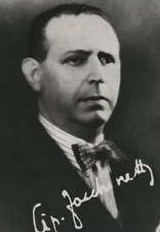 3
Cipriano Facchinetti was an Italian politician.
3
Cipriano Facchinetti was an Italian politician.
Rinaldo Piaggio
 3
Rinaldo Piaggio (1864-1938) was an Italian entrepreneur, senator, and founder of Piaggio.
3
Rinaldo Piaggio (1864-1938) was an Italian entrepreneur, senator, and founder of Piaggio.